Until the bitter end - A German Third Reich Mod AAR
- Thread starter Mr_B0narpte
- Start date
-
We have updated our Community Code of Conduct. Please read through the new rules for the forum that are an integral part of Paradox Interactive’s User Agreement.
You are using an out of date browser. It may not display this or other websites correctly.
You should upgrade or use an alternative browser.
You should upgrade or use an alternative browser.
By second part do you mean "I am currently in March 1944.." If yes, my entire reply is linked to that, so you were very clear with your questionAh, thanks - by "how much do you play in advance" I actually meant what you wrote in the second part of your reply - sorry for the not very clear question.
As am I, I should really be able to go on the offensive in the summer if all the fronts stay relatively quiet. Or, I should say, so long as another front is not created for the Axis.So you're in March 1944 already? Interesting, looking forward to know what future updates will bring and whether a German or Soviet great summer offensive will take place in 1944!
My own, mainly because of the de-motorisation that may culminate in me disbanding all of my motorised forces in order to conserve oil.Also, it was a decision of yours to put AH as Chief of the Army or did it happen by event?
Yeah sure, although I can only start doing that from mid-March 1944 onwards.Last little request: could you post from time to time a screen which shows the actual shape of the entire Eastern Front? I.e. at max zoom level. Thanks!
Thankyou, that means a lot. Your AAR was a great read too.Great AAR!
Got me hooked to the pc screen for hours
Thankyou to everyone who has been reading my AAR
This mod really is a massive challenge for Germany compared to 'vanilla' AoD. And I might be able to break the Red Army as you did, only time will tell.And I that thought I had a hard time against the Soviets
I hope it can. But if I do achieve such a victory, logistics will then become a major issue.I wonder if a decisive victory can be achieved?
Last edited:
January 1944
With the dawn of the new year a new hope of a decisive victory entered the mindset of the German leadership. The pattern of reduced Soviet attacks continued throughout this month, further encouraging this new hope.
Losses charts
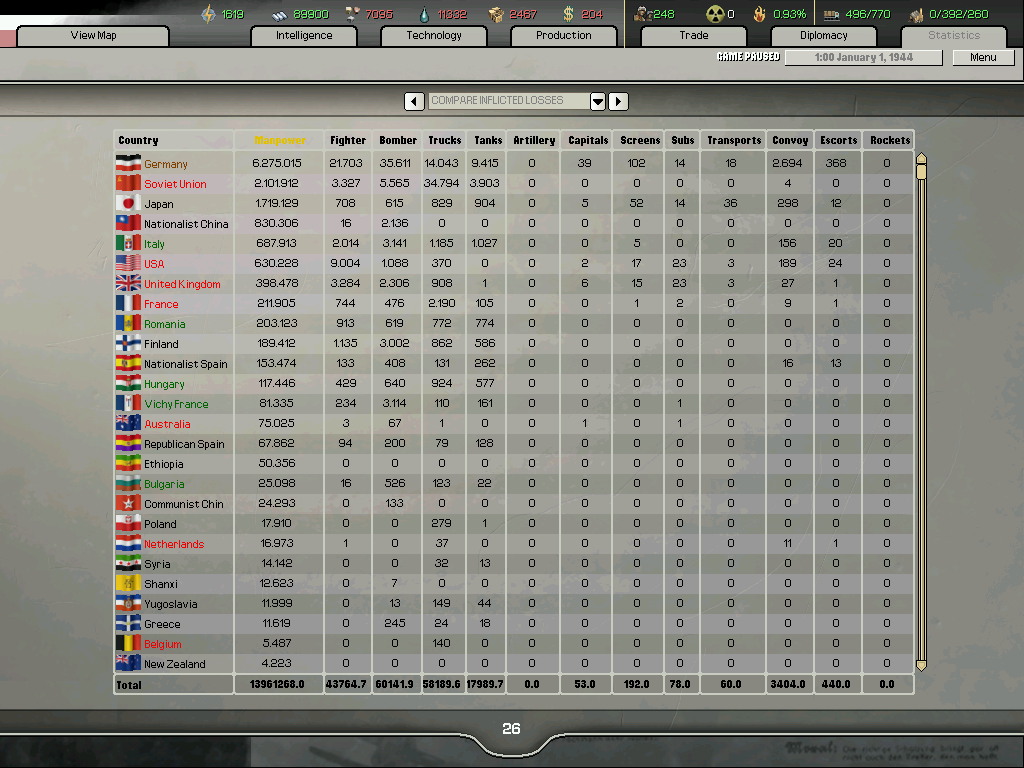

Eastern front
The Luftwaffe managed to maintain air superiority over Orsha in the face of significant opposition by the Red Air Force. Other then that, not much happened on the front. Possibly showing the weakness of the Red Army, incapable of launching offensives.
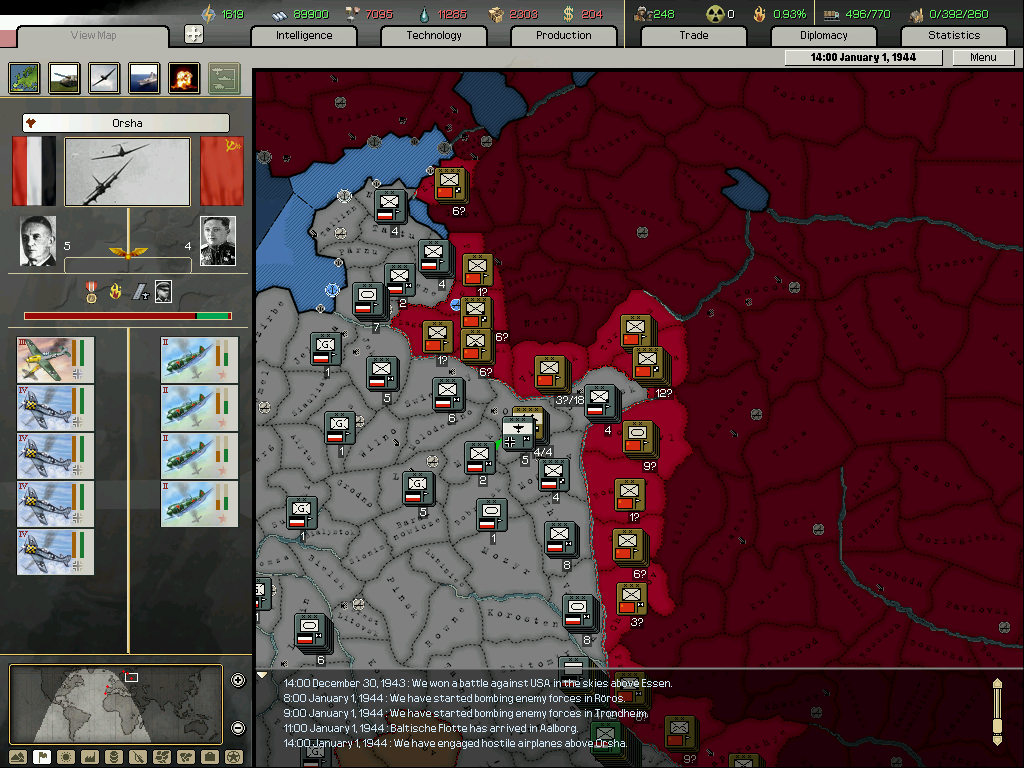
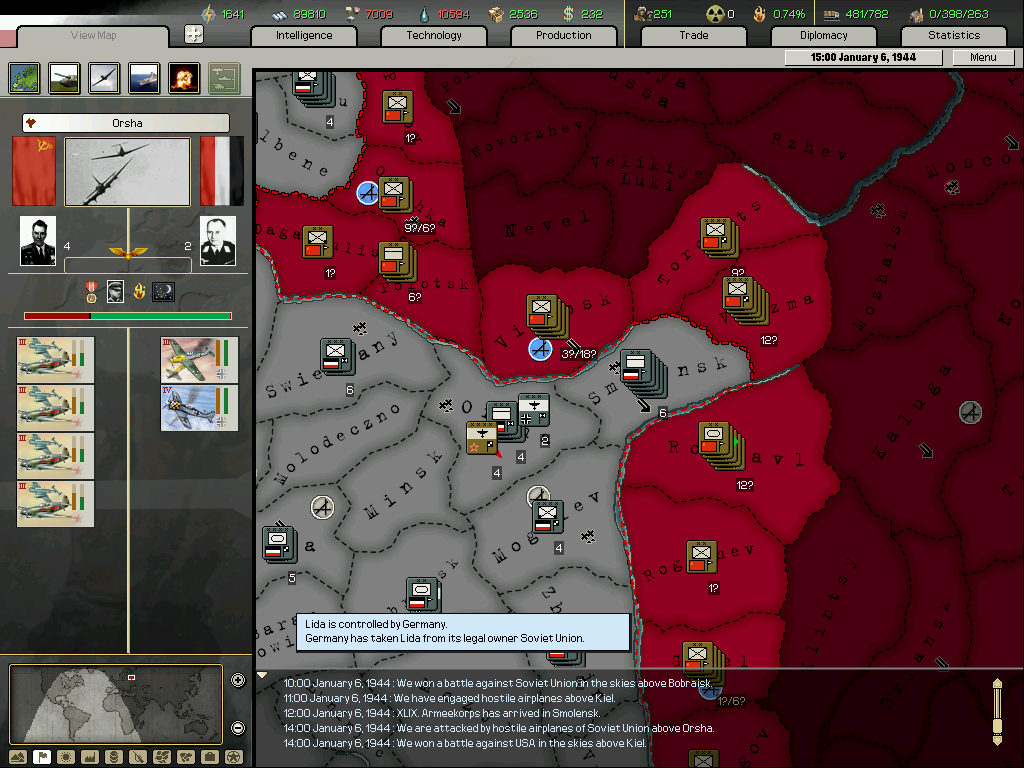
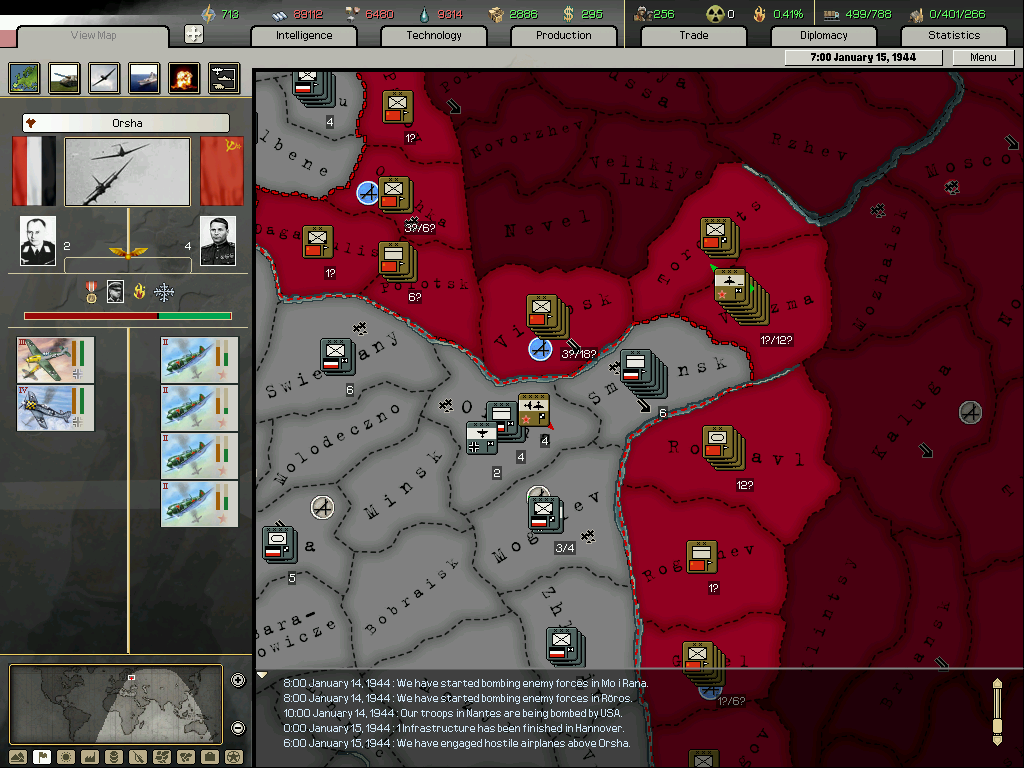
Second Norwegian Campaign
An attempt of an amphibious invasion of Oslo is repulsed thanks to the Kriegsmarine while the British armoured forces in the region are encircled. Norway will now be completely back in German hands unless the British send even more units.
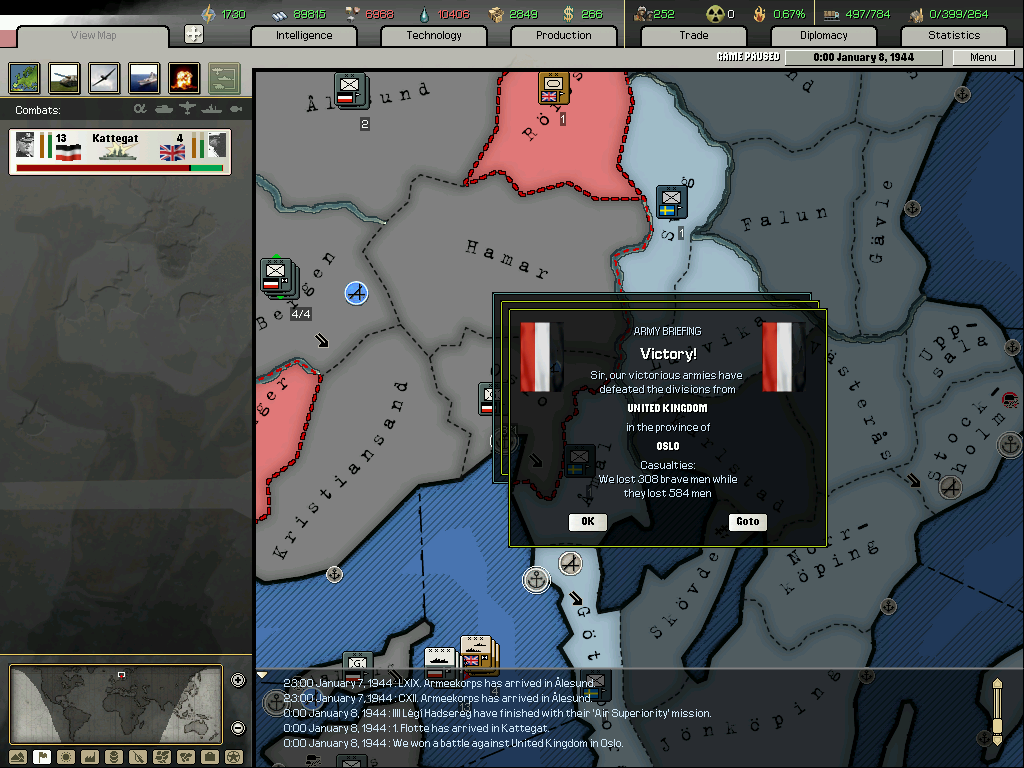
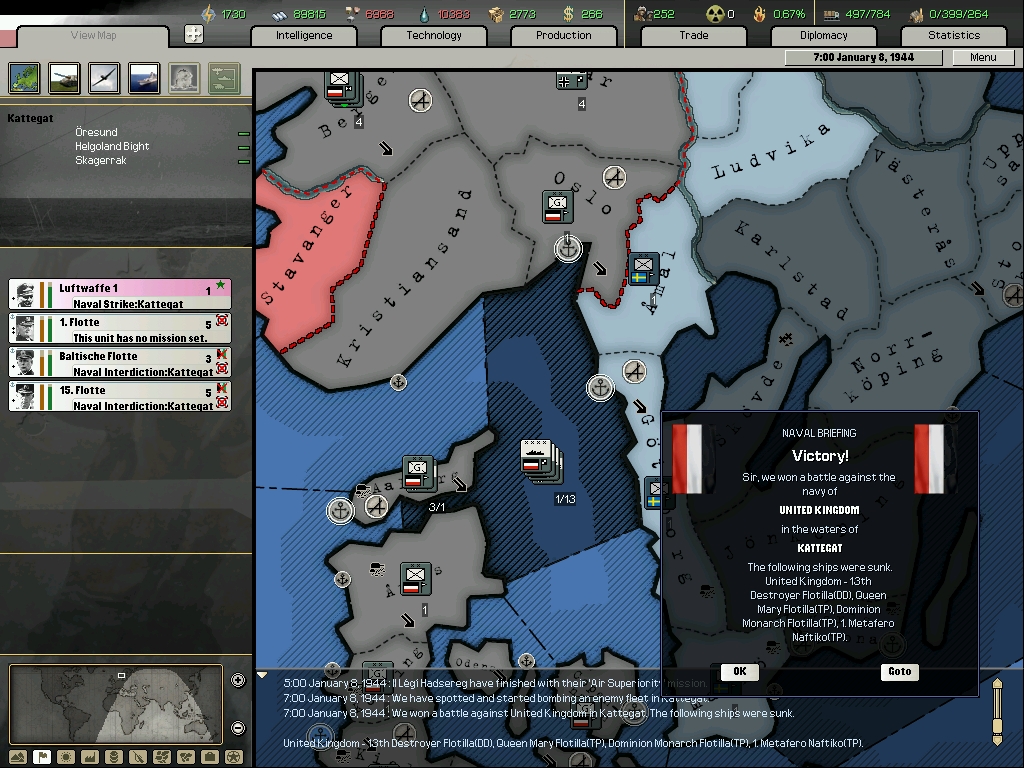

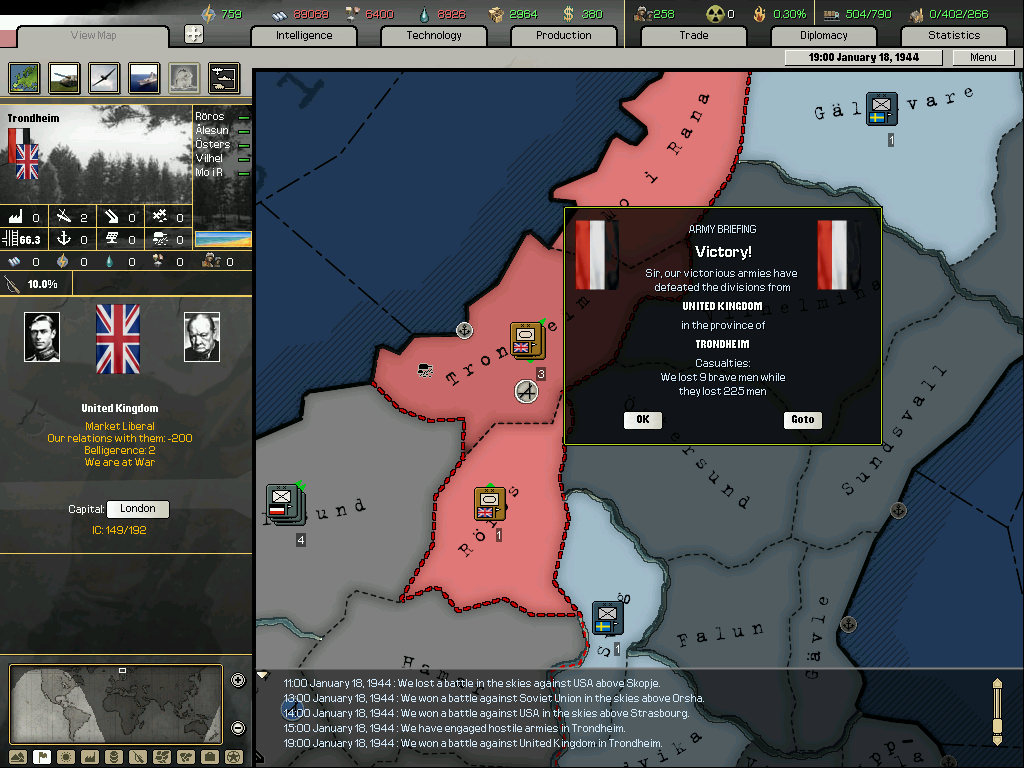
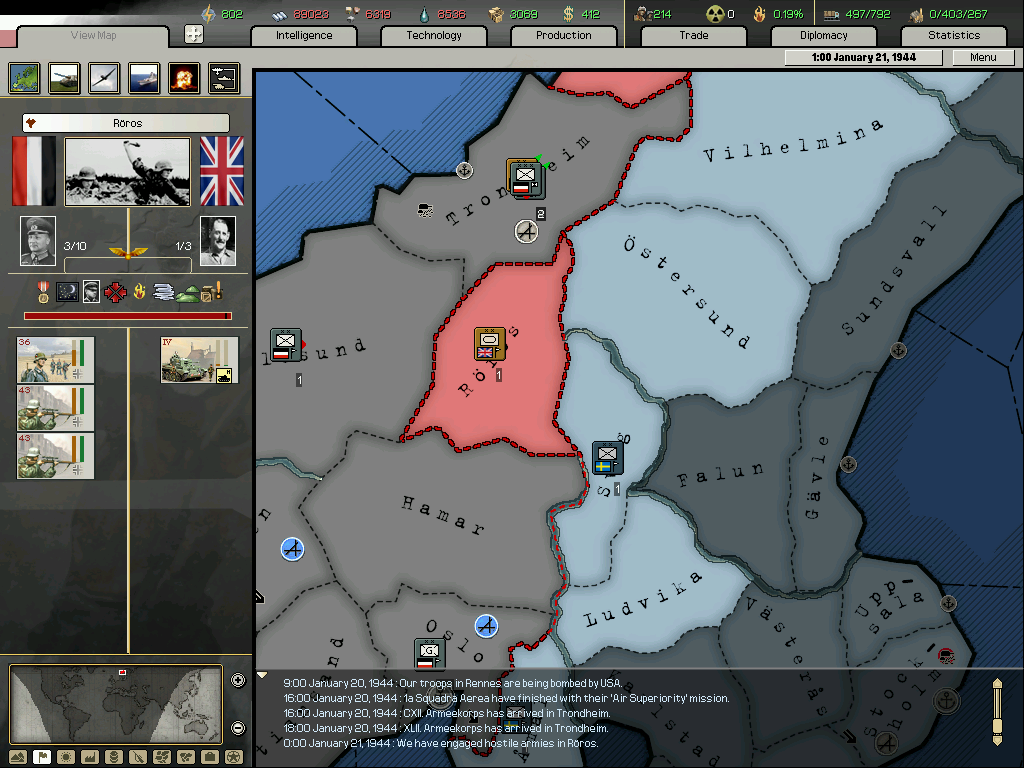
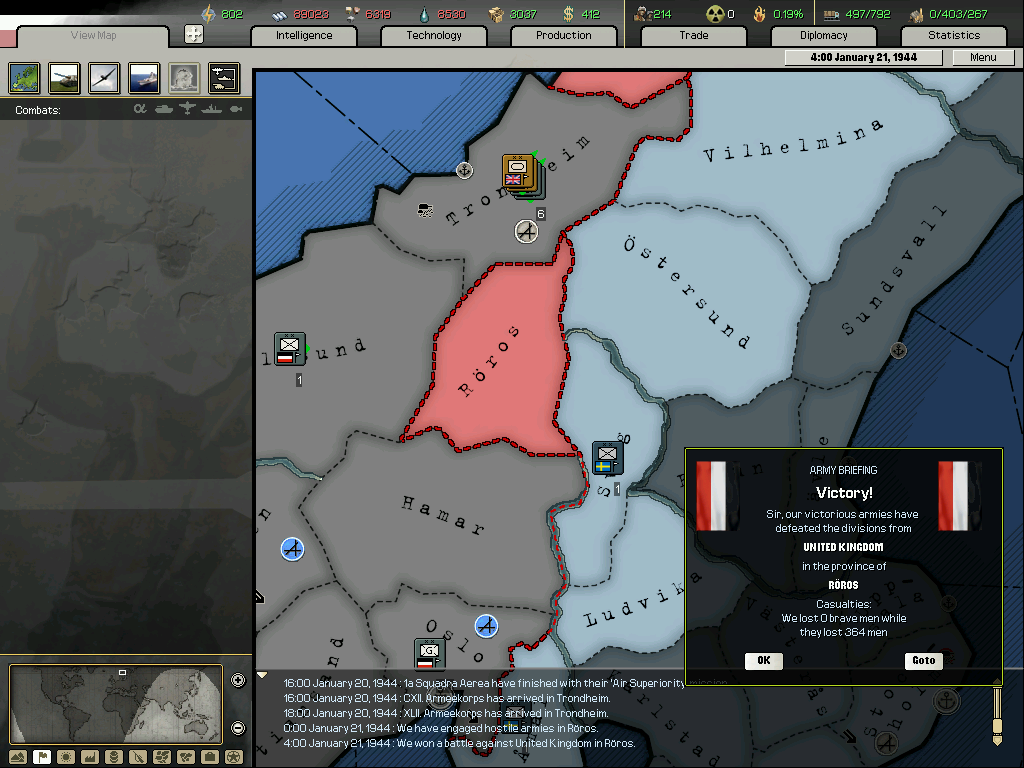
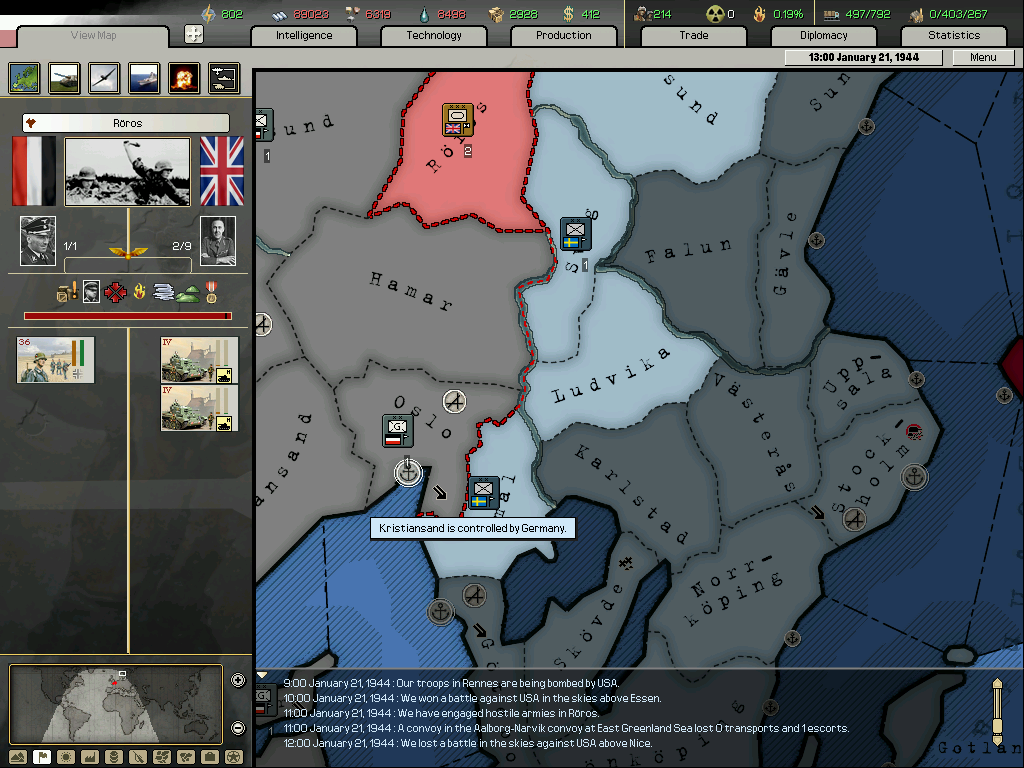


Air war against the Allies
The German Air Force sends 3 interceptors to Athens in order to repulse the Allied bombers in the area. The Romanian Air Force protects Bulgarian air space.
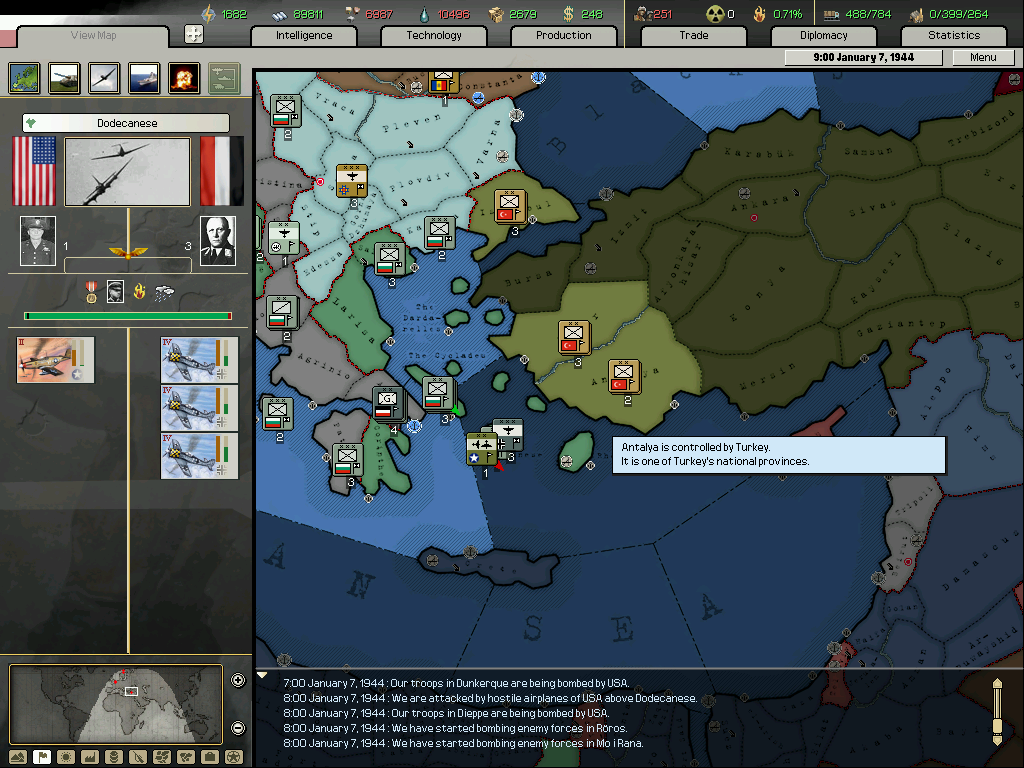
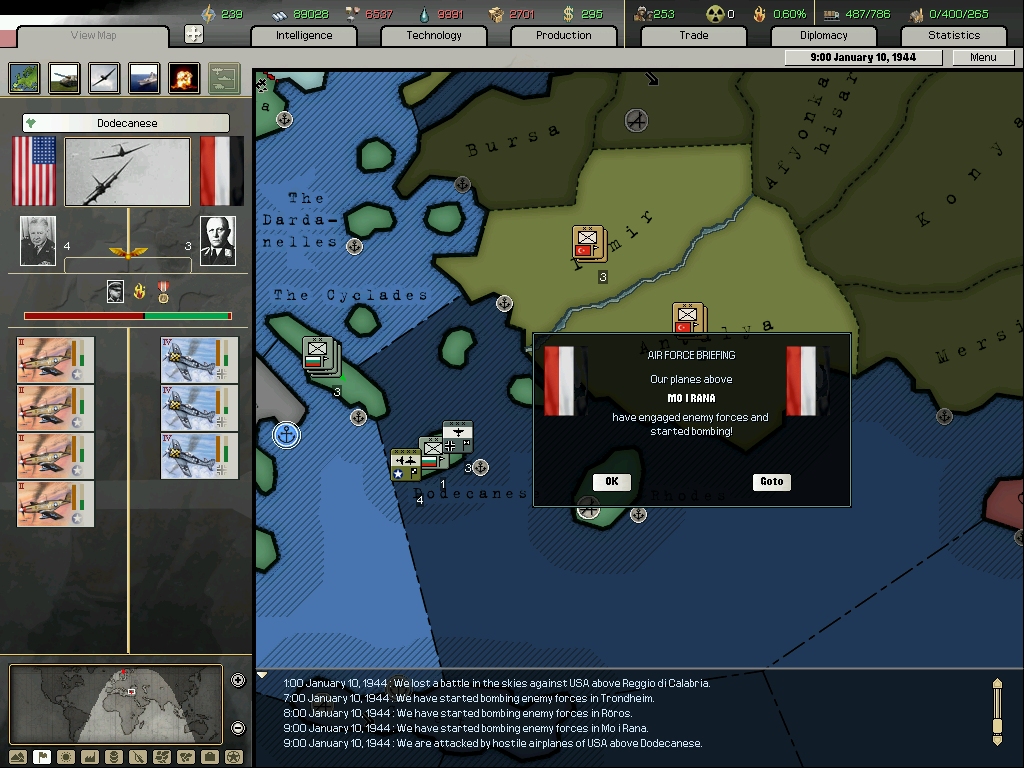
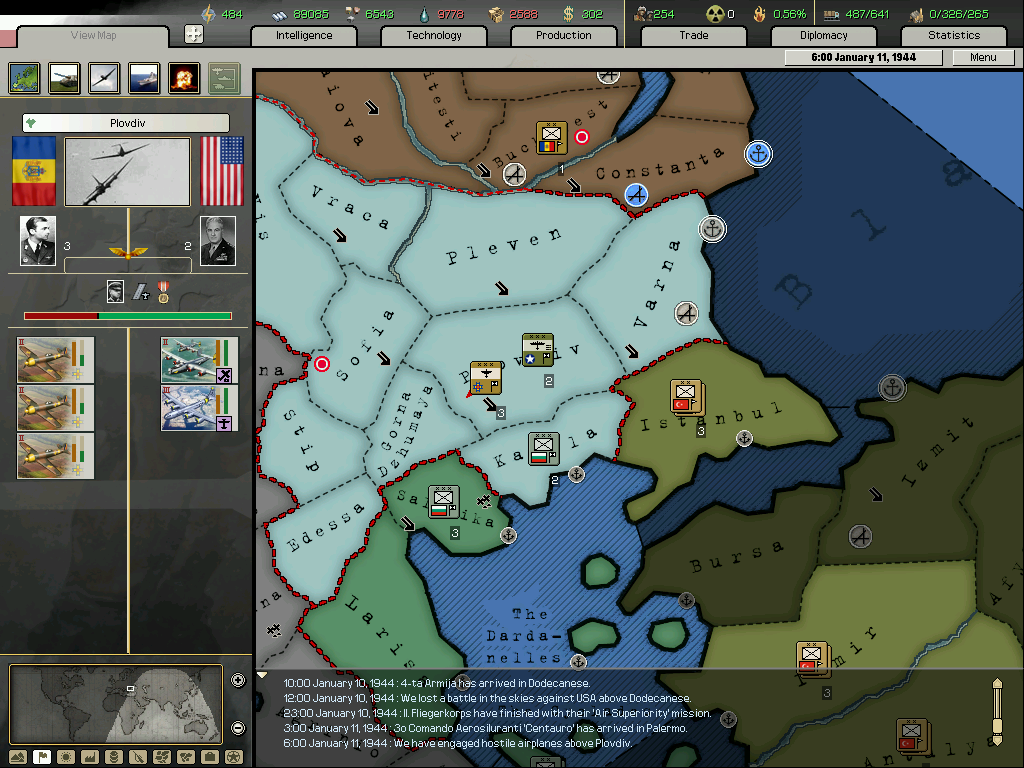
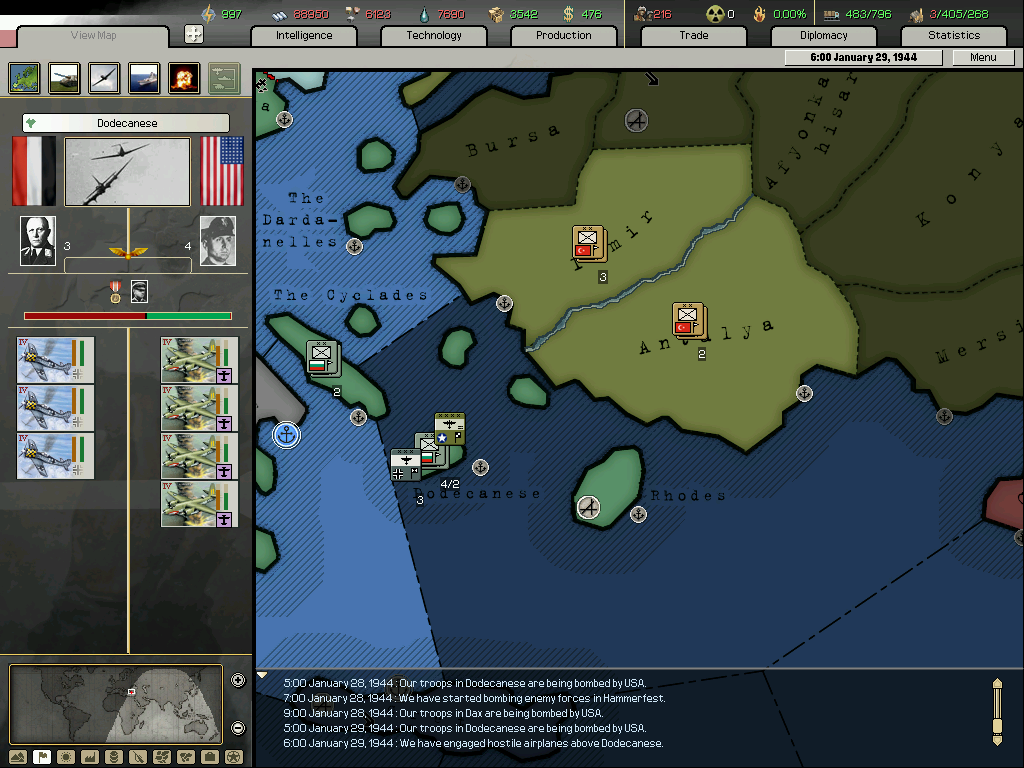
German air space is also continually being successfully defended, with its effective IC increasing to 405.
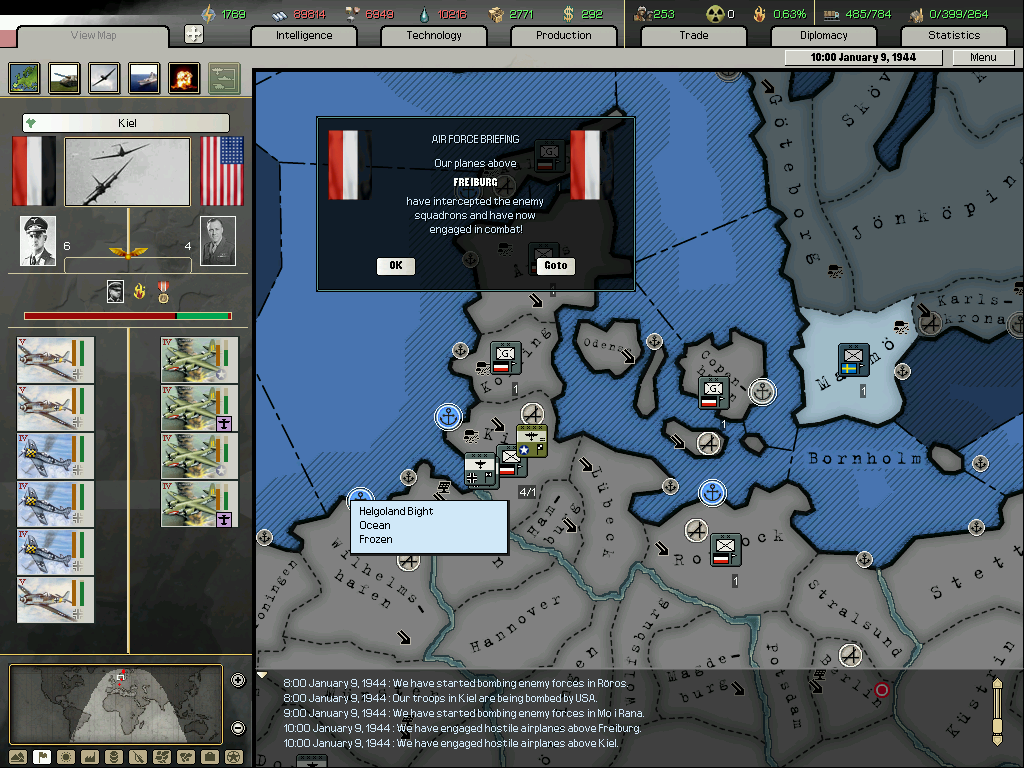
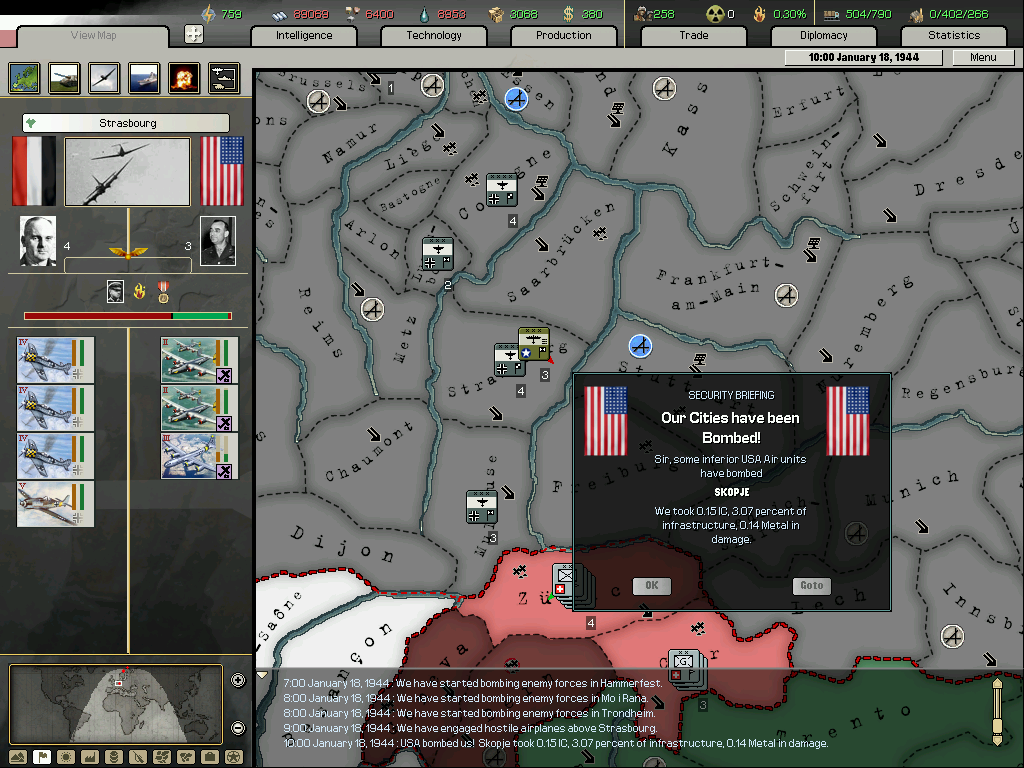
Italy has trouble with US fighters, but no significant damage is done either militarily or economically.
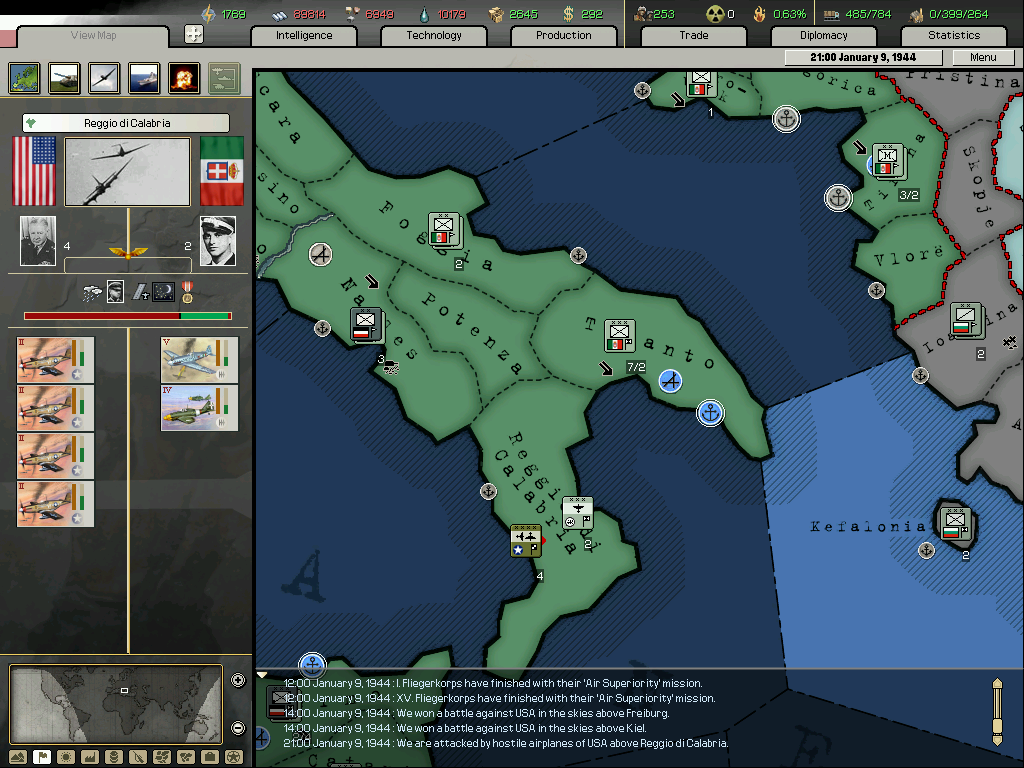
Vichy also suffers defeats at the hands, or wings, of US fighter squadrons but with little change in the air war.

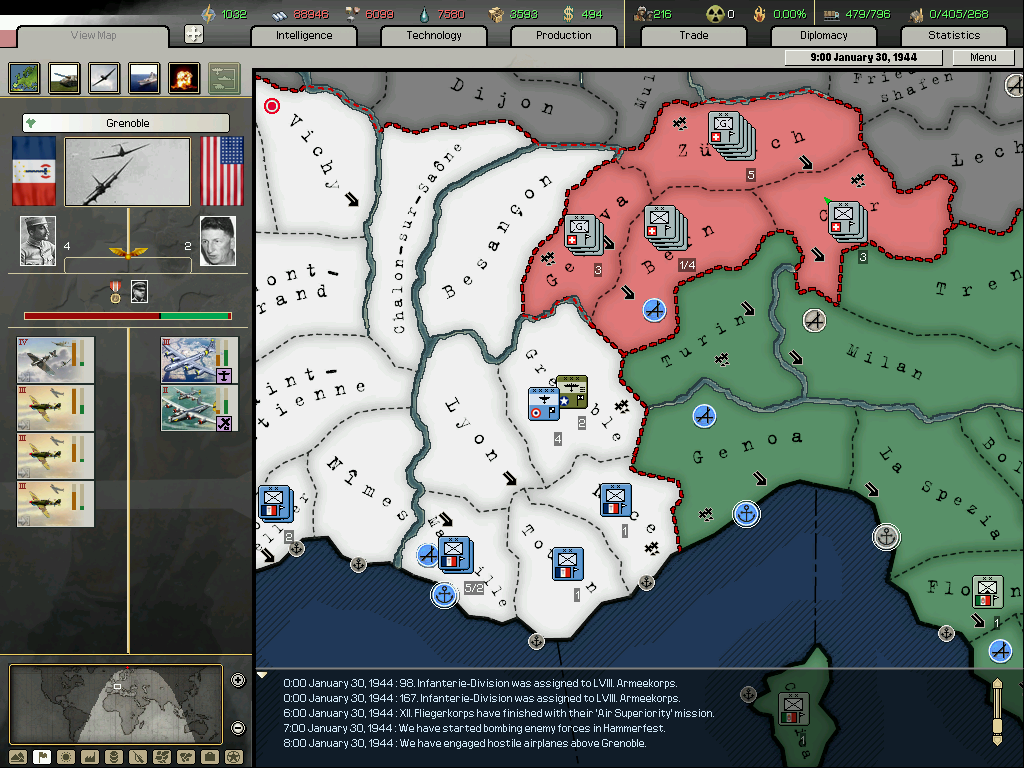
Japan's situation
It is not looking good for Japan, with little progress in China coupled with an Australian landing in Korea potentially saving US forces in the region. The island of Saipan is lost to American forces.
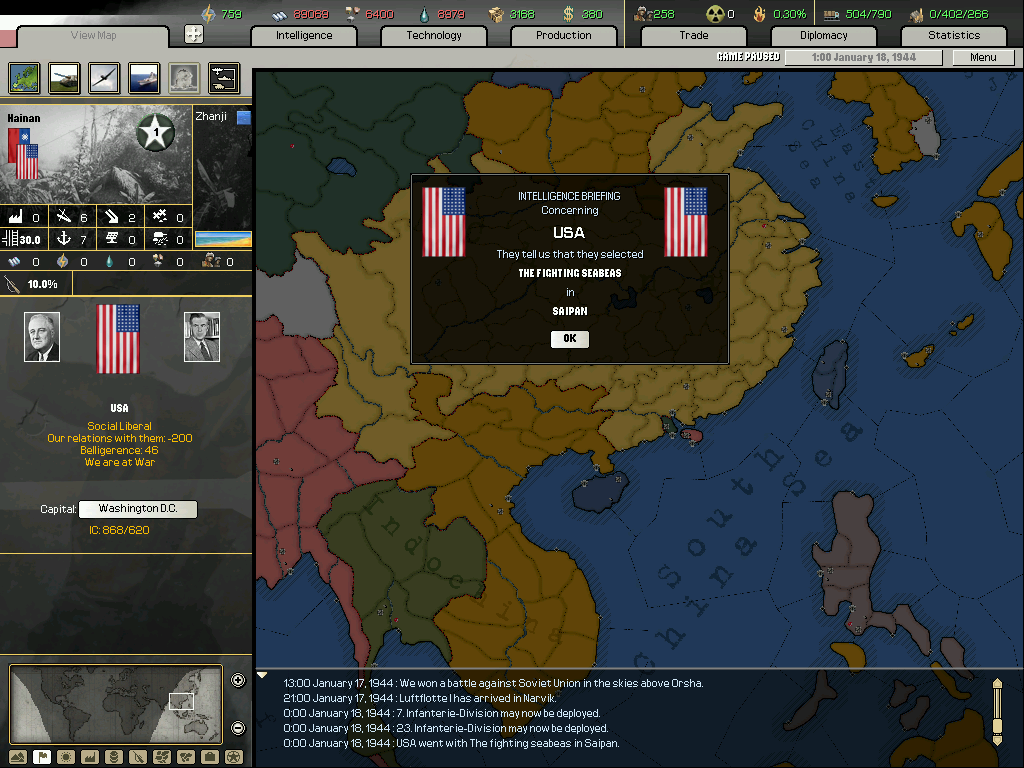

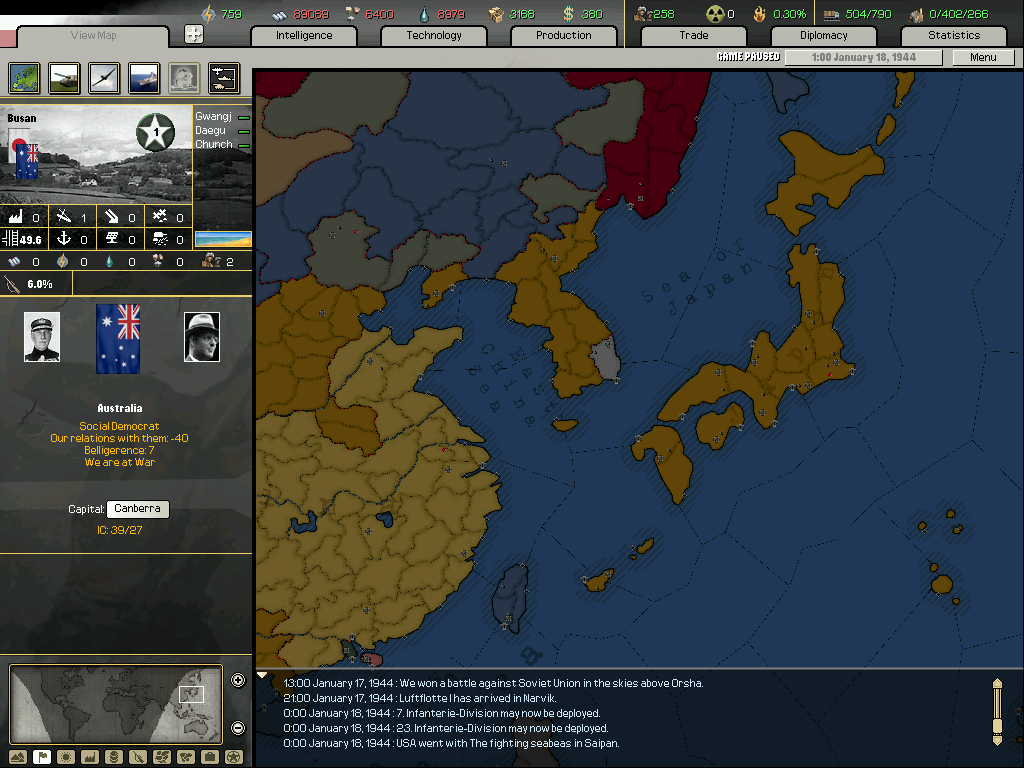
With the dawn of the new year a new hope of a decisive victory entered the mindset of the German leadership. The pattern of reduced Soviet attacks continued throughout this month, further encouraging this new hope.
Losses charts


Eastern front
The Luftwaffe managed to maintain air superiority over Orsha in the face of significant opposition by the Red Air Force. Other then that, not much happened on the front. Possibly showing the weakness of the Red Army, incapable of launching offensives.



Second Norwegian Campaign
An attempt of an amphibious invasion of Oslo is repulsed thanks to the Kriegsmarine while the British armoured forces in the region are encircled. Norway will now be completely back in German hands unless the British send even more units.









Air war against the Allies
The German Air Force sends 3 interceptors to Athens in order to repulse the Allied bombers in the area. The Romanian Air Force protects Bulgarian air space.




German air space is also continually being successfully defended, with its effective IC increasing to 405.


Italy has trouble with US fighters, but no significant damage is done either militarily or economically.

Vichy also suffers defeats at the hands, or wings, of US fighter squadrons but with little change in the air war.


Japan's situation
It is not looking good for Japan, with little progress in China coupled with an Australian landing in Korea potentially saving US forces in the region. The island of Saipan is lost to American forces.



February 1944
Losses charts
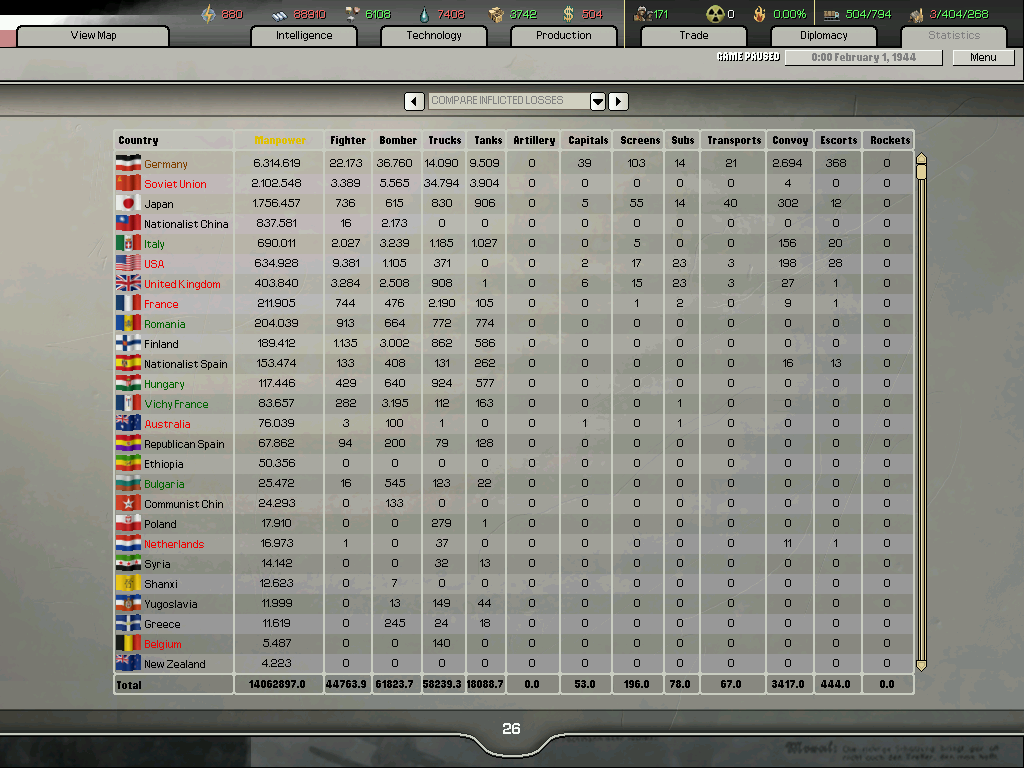

Eastern front
This month followed on with the quietness of the previous month, until the Soviet bear awakened with an attack in Krivoy Rog, outnumbering the Axis divisions in the area 2 to 1, with Red Army equipment and training being far superior to the predominantly Hungarian and Romanian divisions defending the territory. The infrastructure construction project in the province had to be abandoned as it looked to be captured by the Soviets. However with the significant land fortifications in place, the battle for Krivoy will last into March. In addition, this one attack only masks the prevalent quietness all across the rest of the front, enabling German forces to continue their resting and re-covering of their best units in preparation for an attack in the summer.
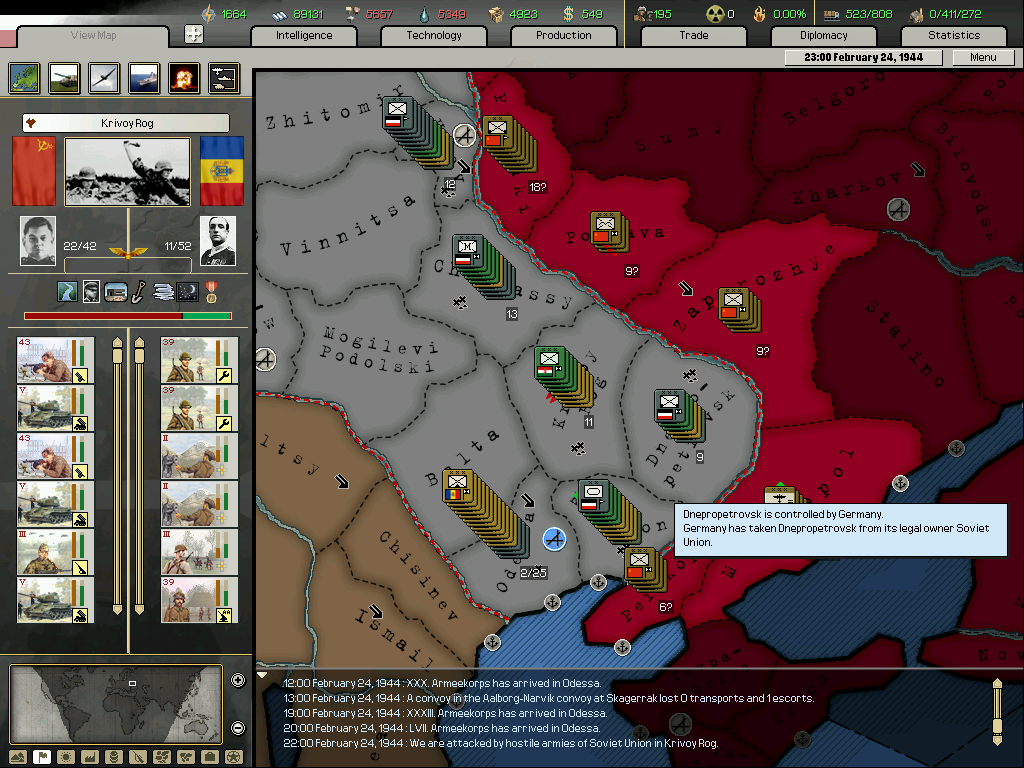
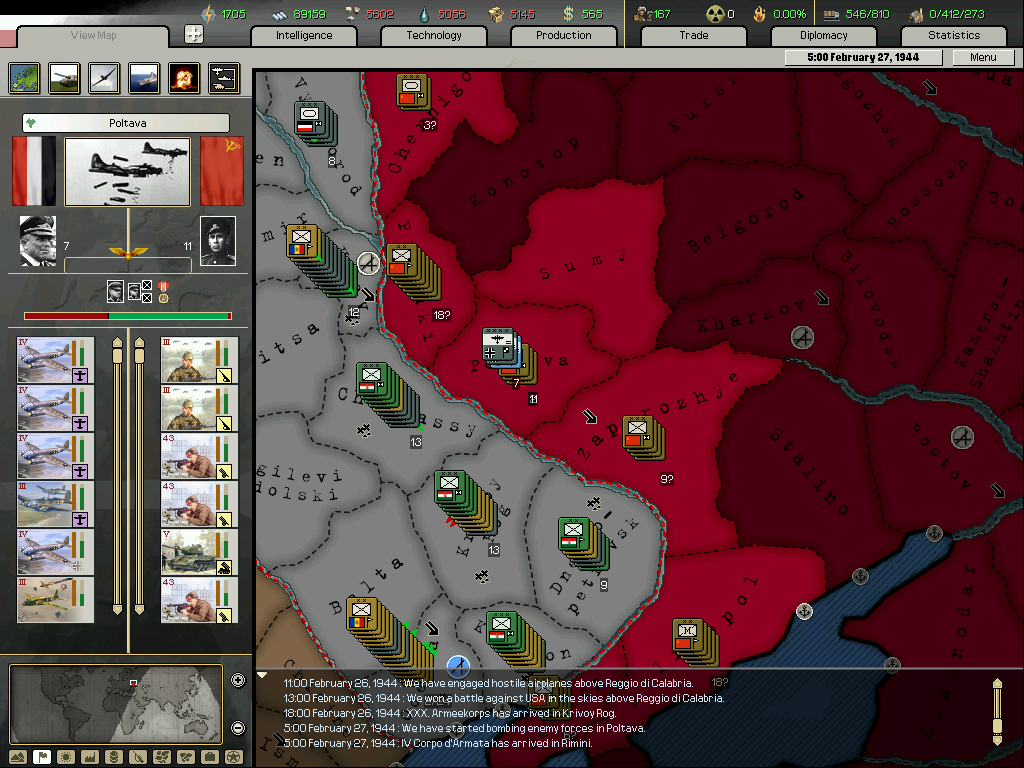
Second Norwegian Campaign
British forces in the north experienced the same results as their fellow forces in the south: complete retreat before their ultimate destruction.
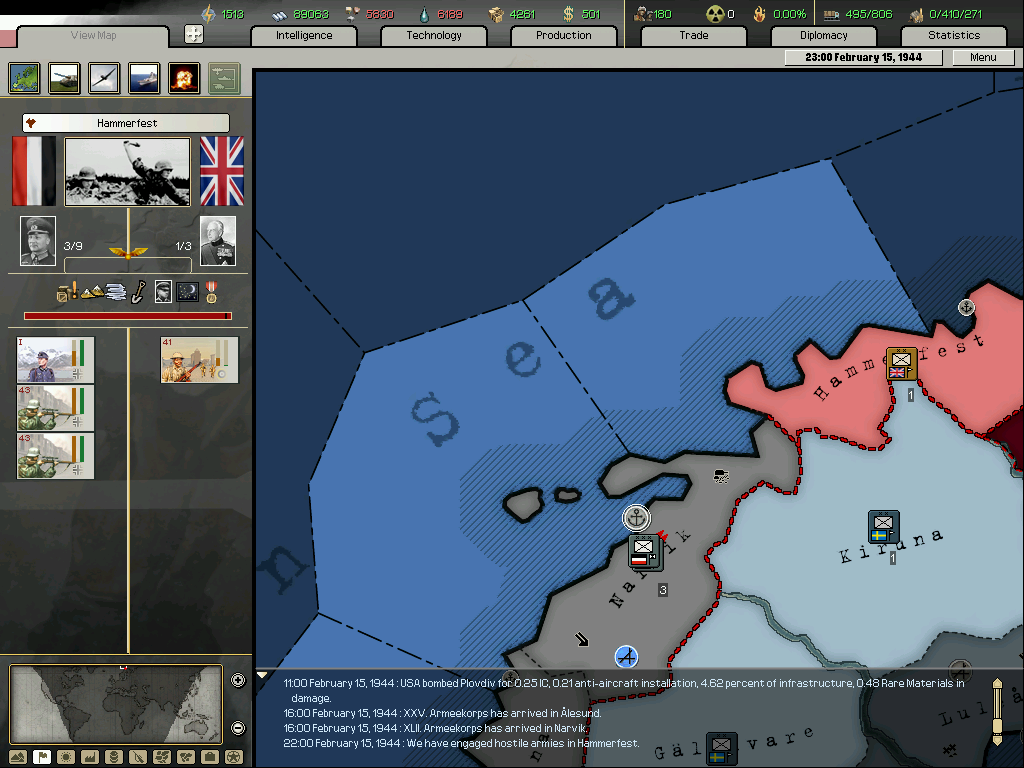
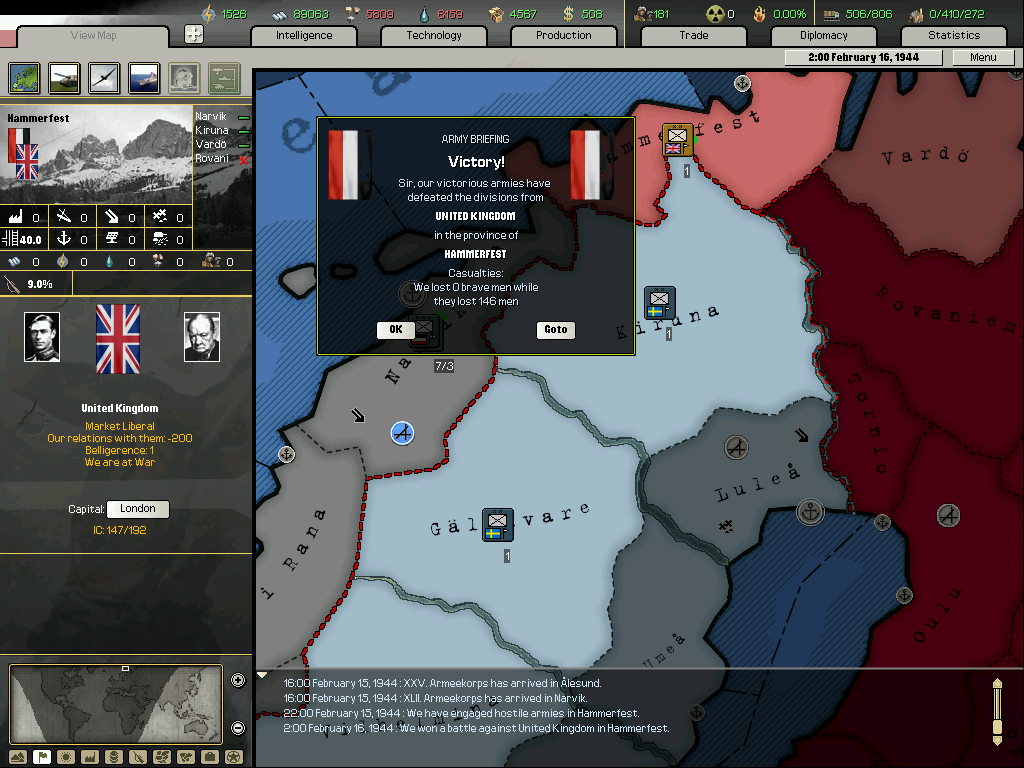
Air war against the Allies
The Luftwaffe and other Axis air forces continued to repulse Allied bombers. US attempts to penetrate the southern regions of the German Reich are successfully defeated by the German Air Force.
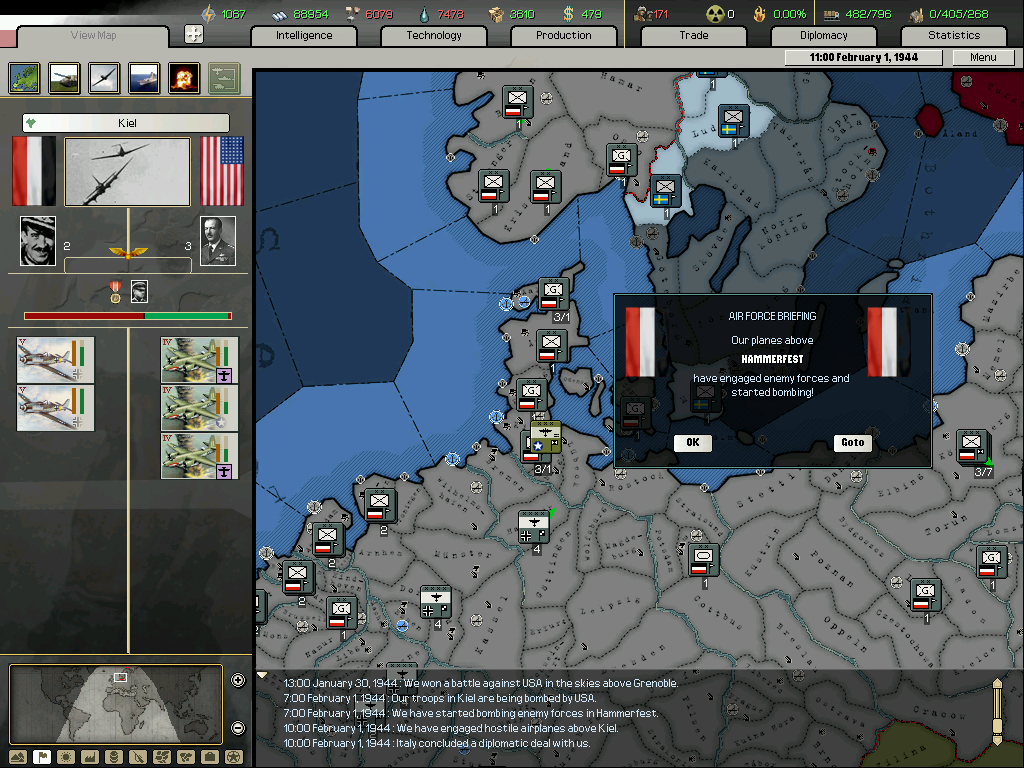
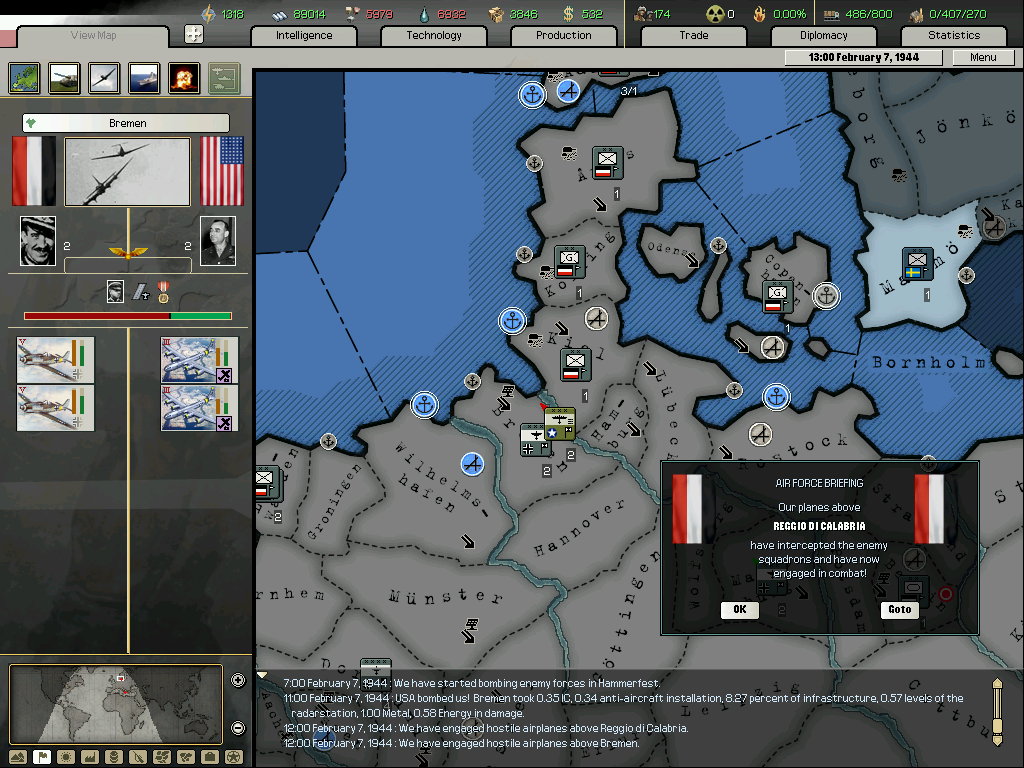
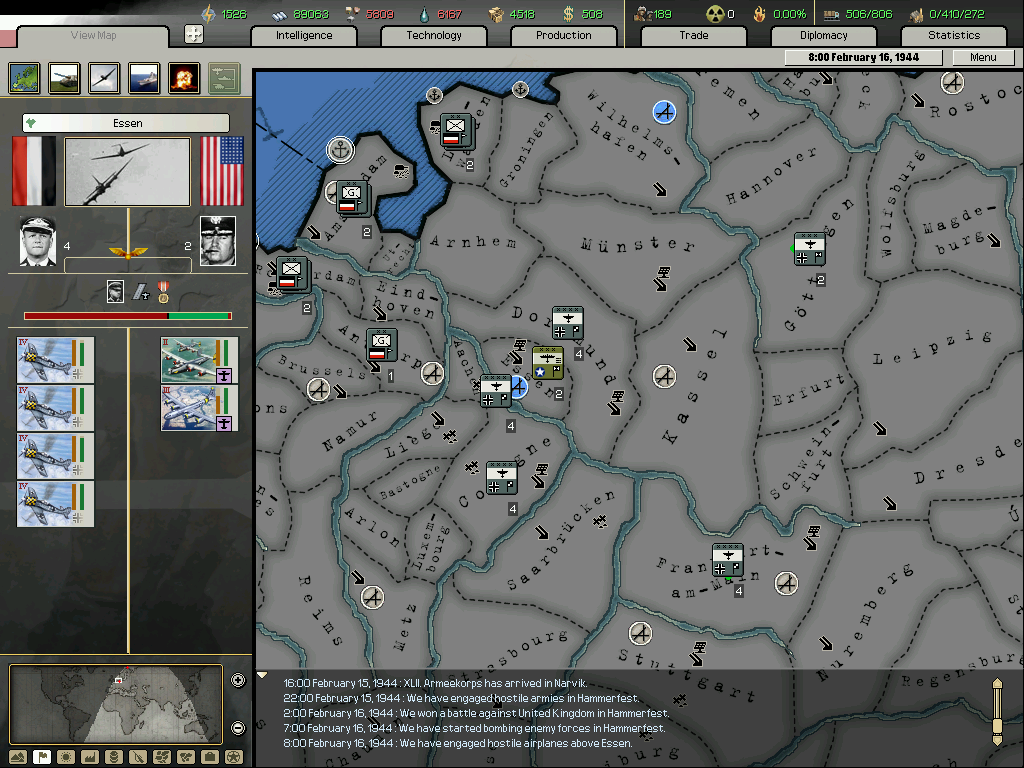


German units became so over-confident with their success they moved forward into north-eastern France. This was met with initial success before the US Air Force showed its over-whelming numbers of fighters just days after this success.
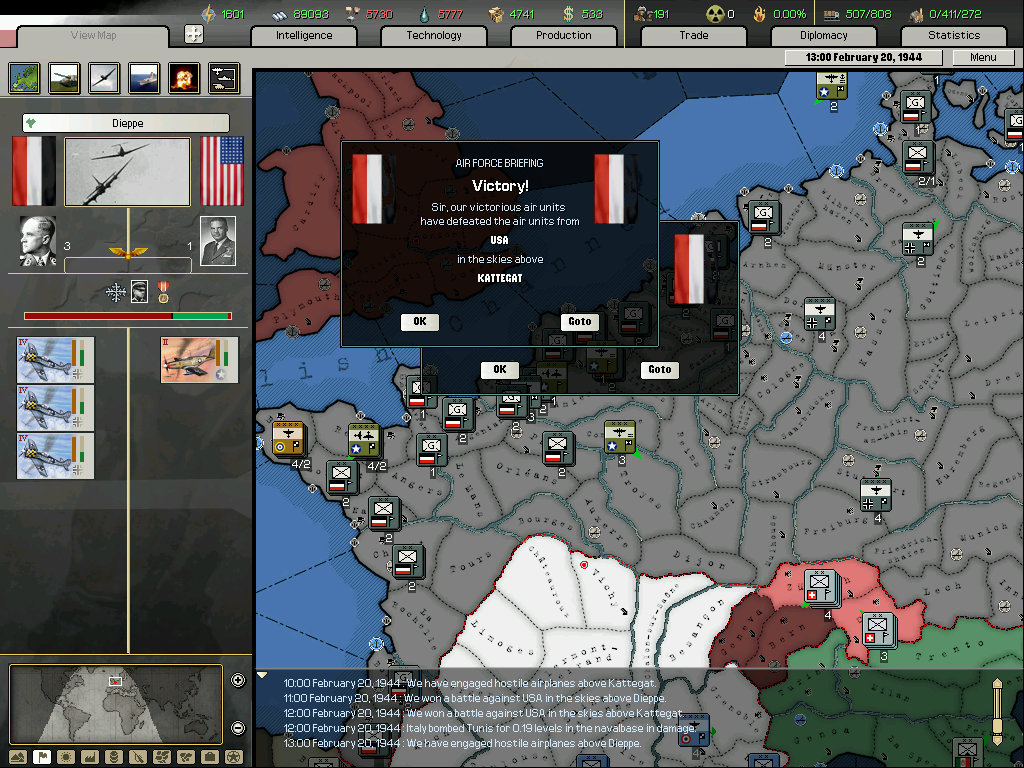

The rebasing of several interceptors to Bulgaria had good results.
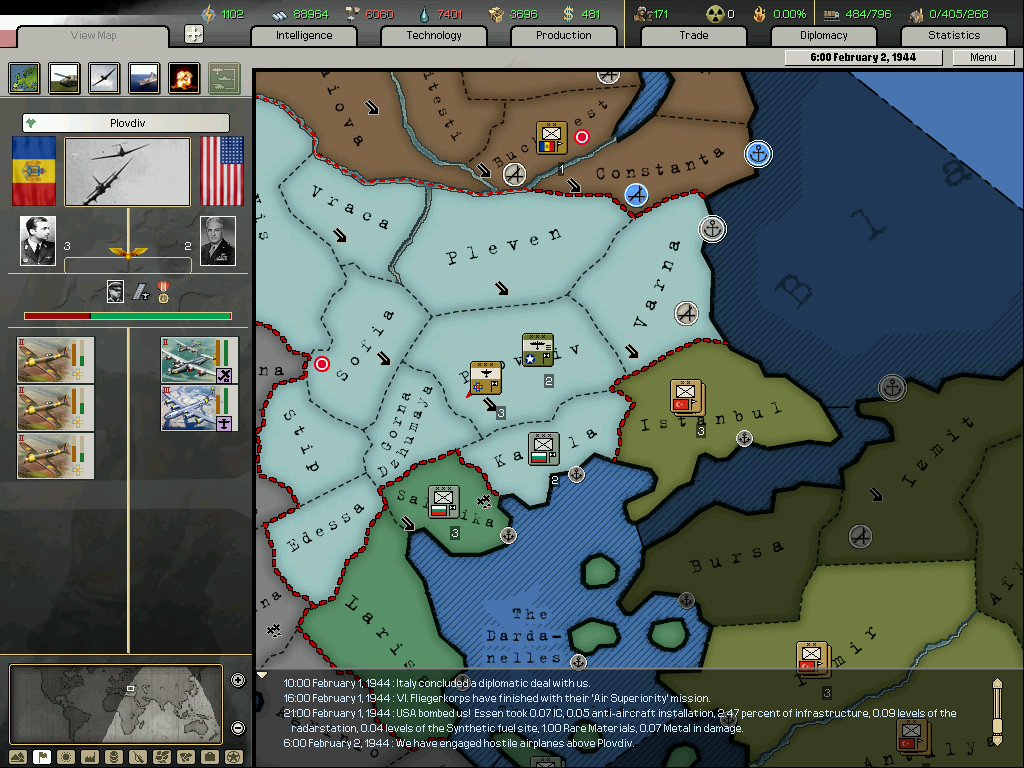
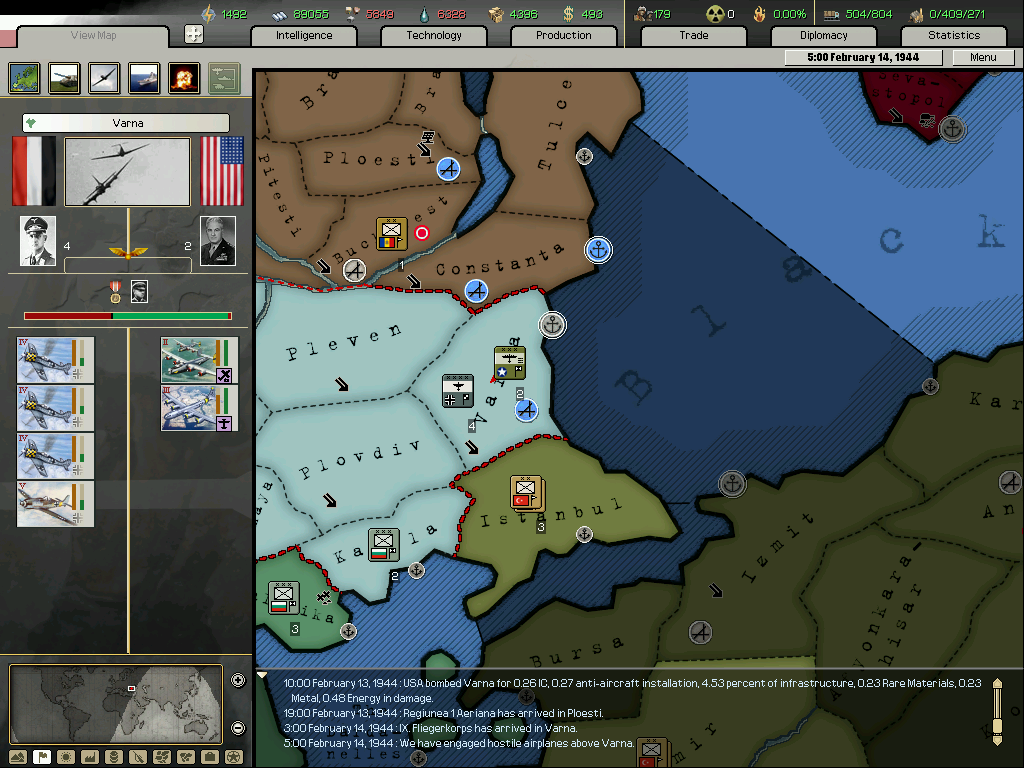
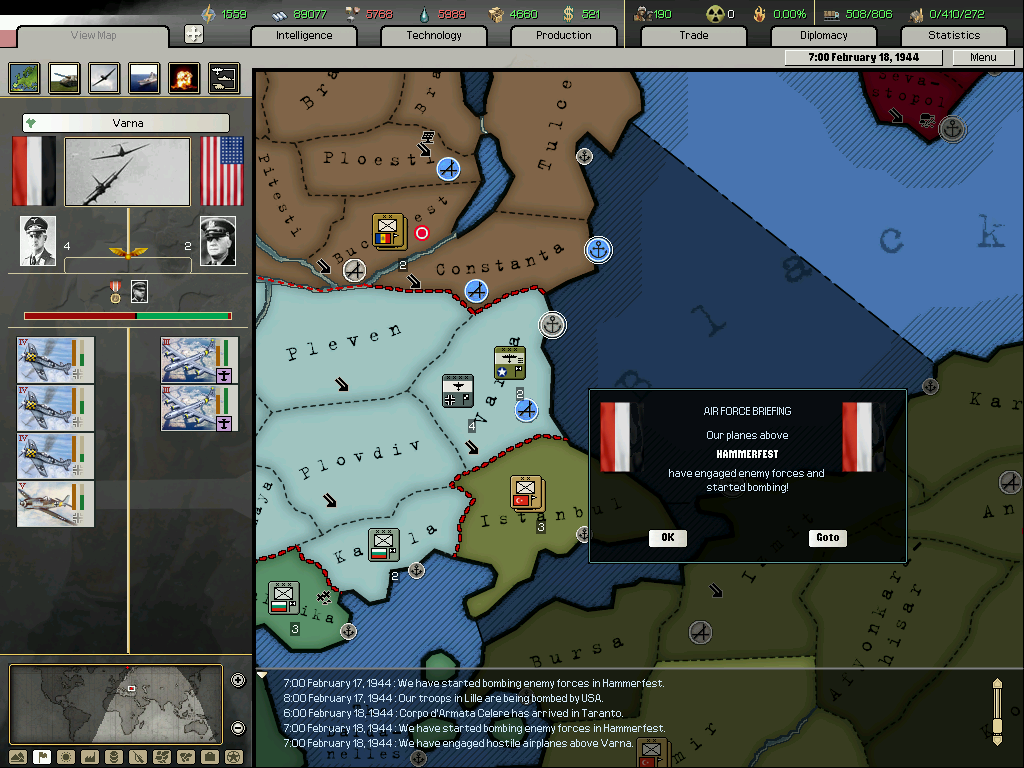
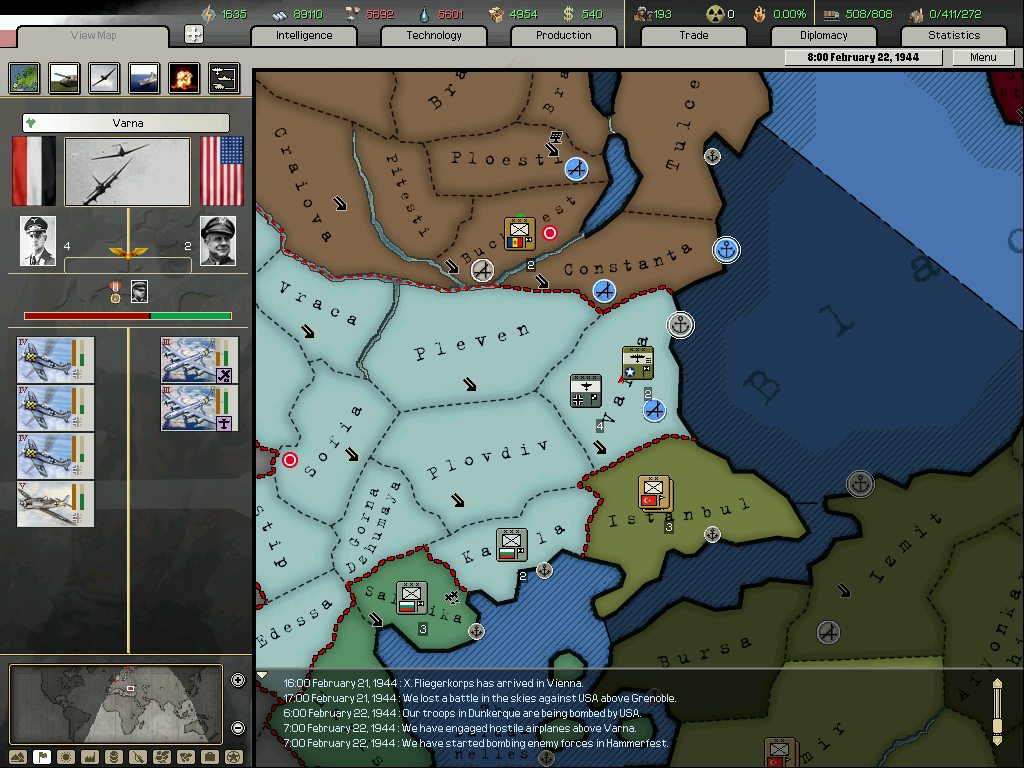
The same can be said for the Luftwaffe units that were moved to defend southern Italy.
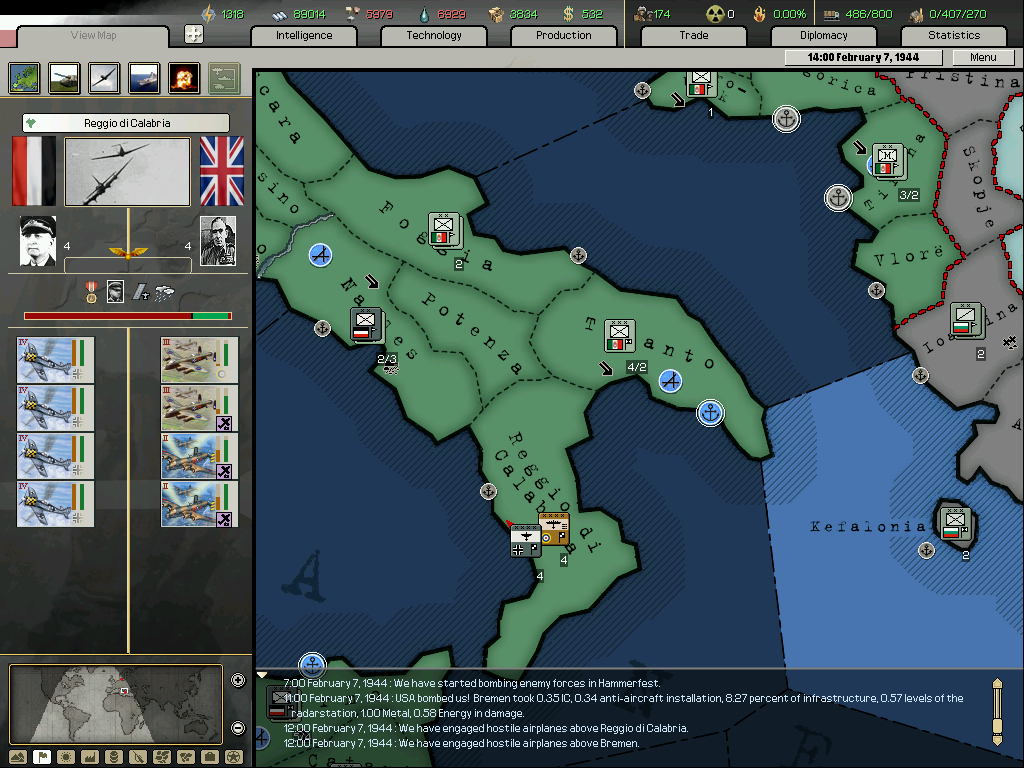
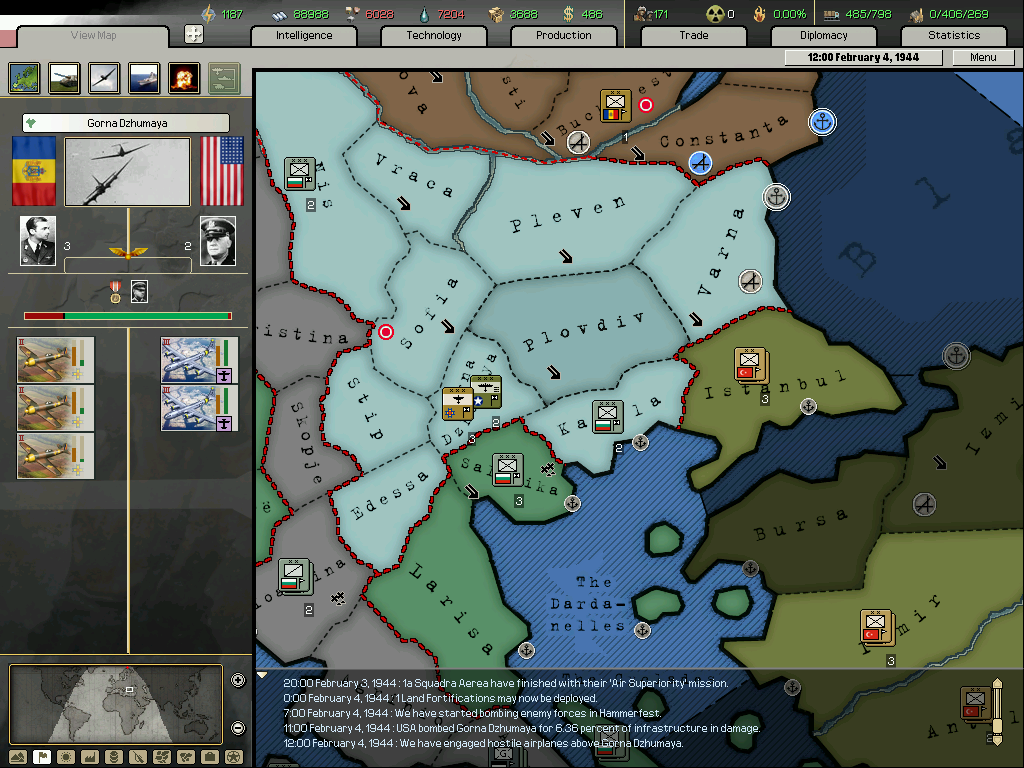
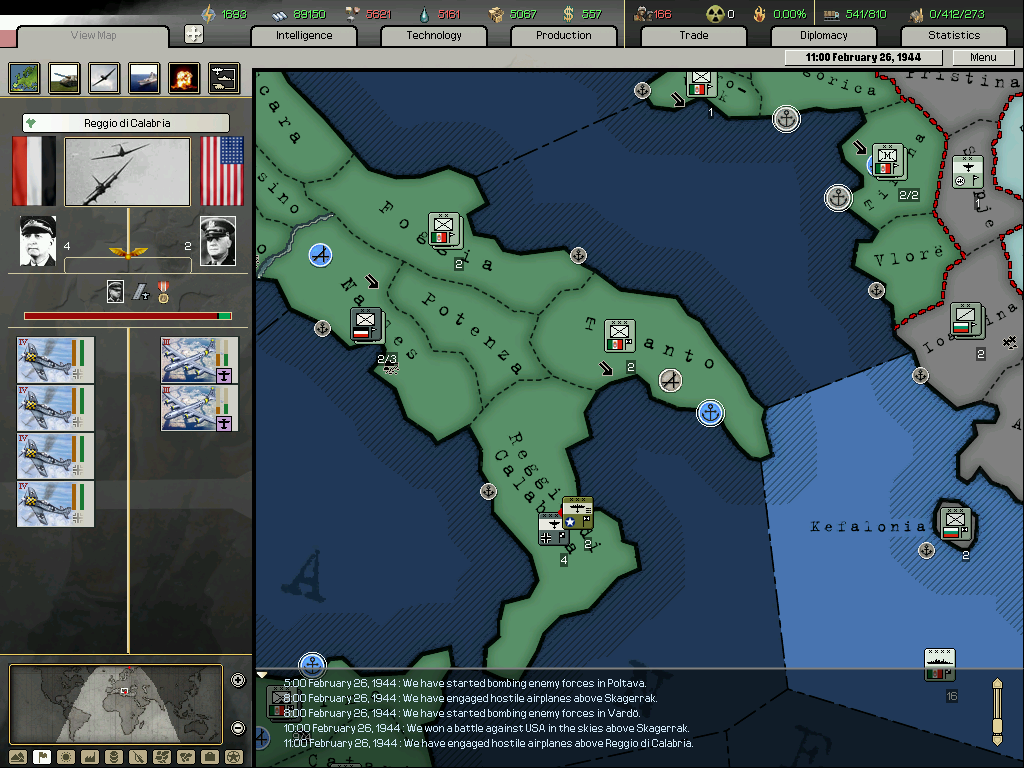
Italian naval bombers were ordered to bomb the naval base of Tunis in order to get a picture of what the German and Italian navies would be up against in a potential invasion of Italy. 24 naval units, made up predominantly by screens, are of little threat. But the Axis does not know what potential Allied ships are stationed elsewhere in the region.
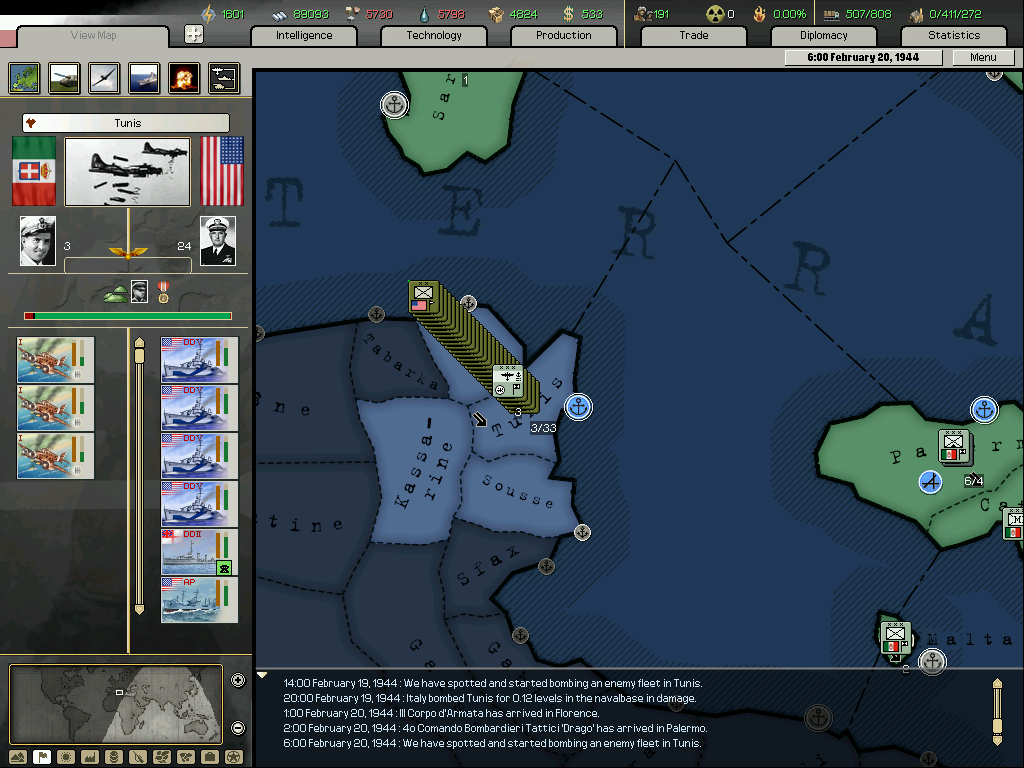
Crete is taken due to Allied forces being removed from the island, potentially destroying some undefended Allied air units in the province.
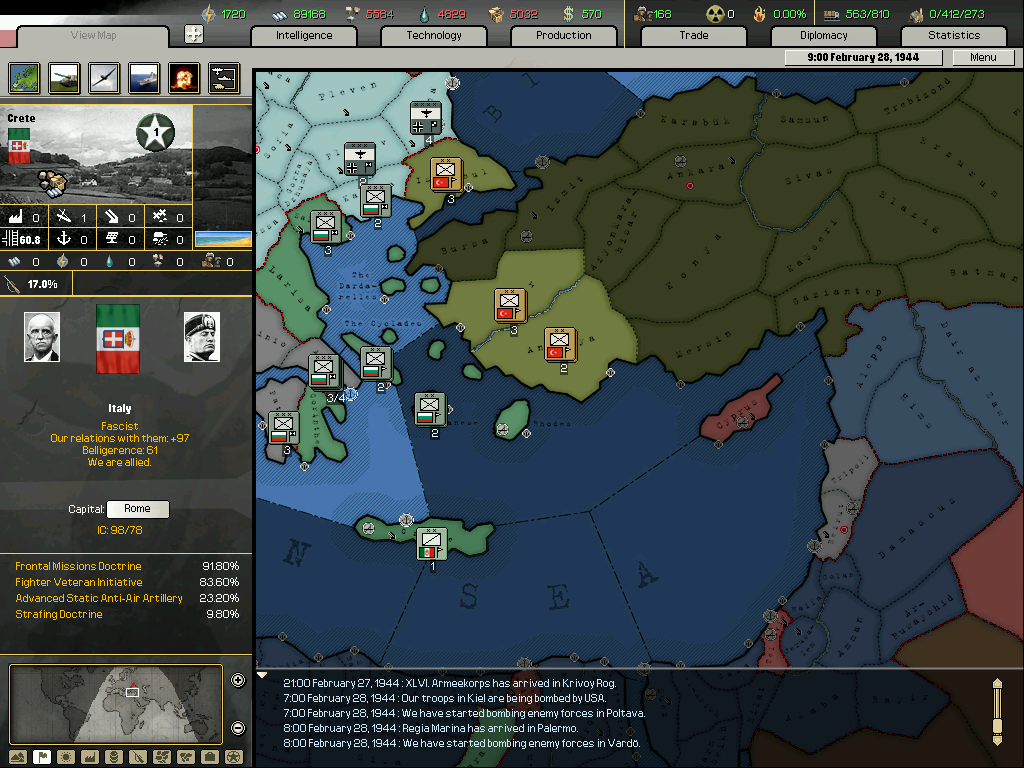
Losses charts


Eastern front
This month followed on with the quietness of the previous month, until the Soviet bear awakened with an attack in Krivoy Rog, outnumbering the Axis divisions in the area 2 to 1, with Red Army equipment and training being far superior to the predominantly Hungarian and Romanian divisions defending the territory. The infrastructure construction project in the province had to be abandoned as it looked to be captured by the Soviets. However with the significant land fortifications in place, the battle for Krivoy will last into March. In addition, this one attack only masks the prevalent quietness all across the rest of the front, enabling German forces to continue their resting and re-covering of their best units in preparation for an attack in the summer.


Second Norwegian Campaign
British forces in the north experienced the same results as their fellow forces in the south: complete retreat before their ultimate destruction.


Air war against the Allies
The Luftwaffe and other Axis air forces continued to repulse Allied bombers. US attempts to penetrate the southern regions of the German Reich are successfully defeated by the German Air Force.





German units became so over-confident with their success they moved forward into north-eastern France. This was met with initial success before the US Air Force showed its over-whelming numbers of fighters just days after this success.


The rebasing of several interceptors to Bulgaria had good results.




The same can be said for the Luftwaffe units that were moved to defend southern Italy.



Italian naval bombers were ordered to bomb the naval base of Tunis in order to get a picture of what the German and Italian navies would be up against in a potential invasion of Italy. 24 naval units, made up predominantly by screens, are of little threat. But the Axis does not know what potential Allied ships are stationed elsewhere in the region.

Crete is taken due to Allied forces being removed from the island, potentially destroying some undefended Allied air units in the province.

Yeah, I think 33 divisions is bigger then the entire Italian army! My main defence against this is to destroy as many US transport ships as possible, 28 so far.
EDIT: Actually this 28 figure is mainly thanks to Japan. I have sunk many UK transport ships though.
EDIT: Actually this 28 figure is mainly thanks to Japan. I have sunk many UK transport ships though.
Last edited:
Heh, that's exactly what I was aiming for! Things are looking relatively good in the East right now... but what if you had to divert several divisions from that front to counter a major Allied landing in Italy or France? I know, I know: wait and see...(...) I should really be able to go on the offensive in the summer if all the fronts stay relatively quiet. Or, I should say, so long as another front is not created for the Axis.
Nice work you're doing with the Luftwaffe - the best proof of your good leadership being the significant recovery in your effective IC, which means that the Allies are managing to drop very few bombs on the Reich. Could you, however, provide a screen (or at least just write) what's the current size of your airforce (Fig/Int but also bombers)? Thanks!
Took the words right out of my mouth. I still haven't advanced from mid-March, so I have no idea what will happen. I hope the US does try an invasion or two, it certainly has the forces at its disposal. Just not sure if it has enough naval forces to defend its amphibious forces.Heh, that's exactly what I was aiming for! Things are looking relatively good in the East right now... but what if you had to divert several divisions from that front to counter a major Allied landing in Italy or France? I know, I know: wait and see...
Thankyou, I think the cooling period has been due to the Allies rebasing some of their bombers in northern Africa, but I am happy with my Luftwaffe nonetheless!Nice work you're doing with the Luftwaffe - the best proof of your good leadership being the significant recovery in your effective IC, which means that the Allies are managing to drop very few bombs on the Reich. Could you, however, provide a screen (or at least just write) what's the current size of your airforce (Fig/Int but also bombers)? Thanks!
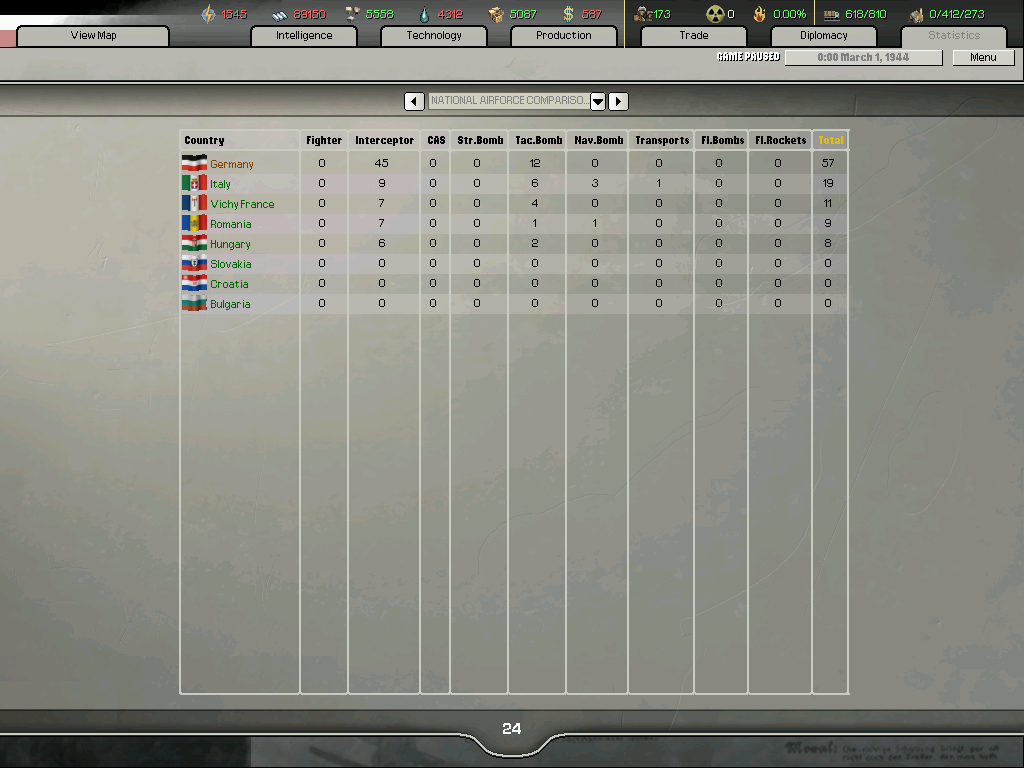
March 1944
Losses charts
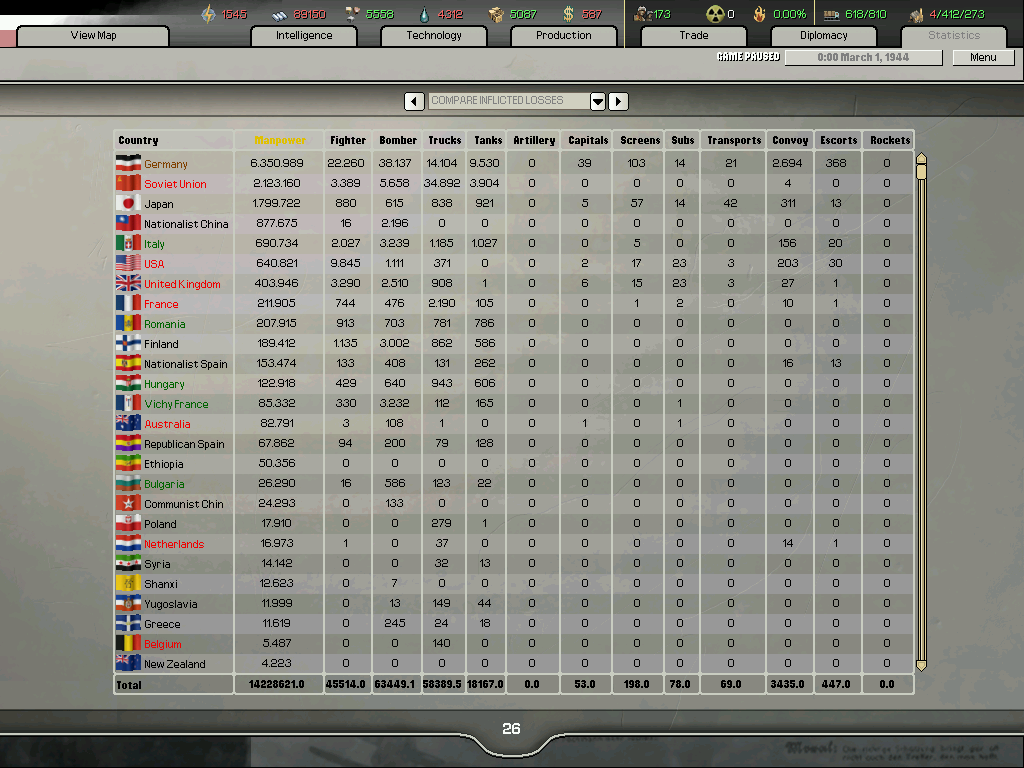

Eastern front
The battle for Krivoy Rog that had started last month eventually ended in an Axis defeat. The Dnieper has been crossed with Dnepropetrovsk falling soon after, although this unprecedented situation turned into an opportunity for the Wehrmacht as the Luftwaffe bombers and Heer combined their efforts to through the Red Army in the south into disarray.

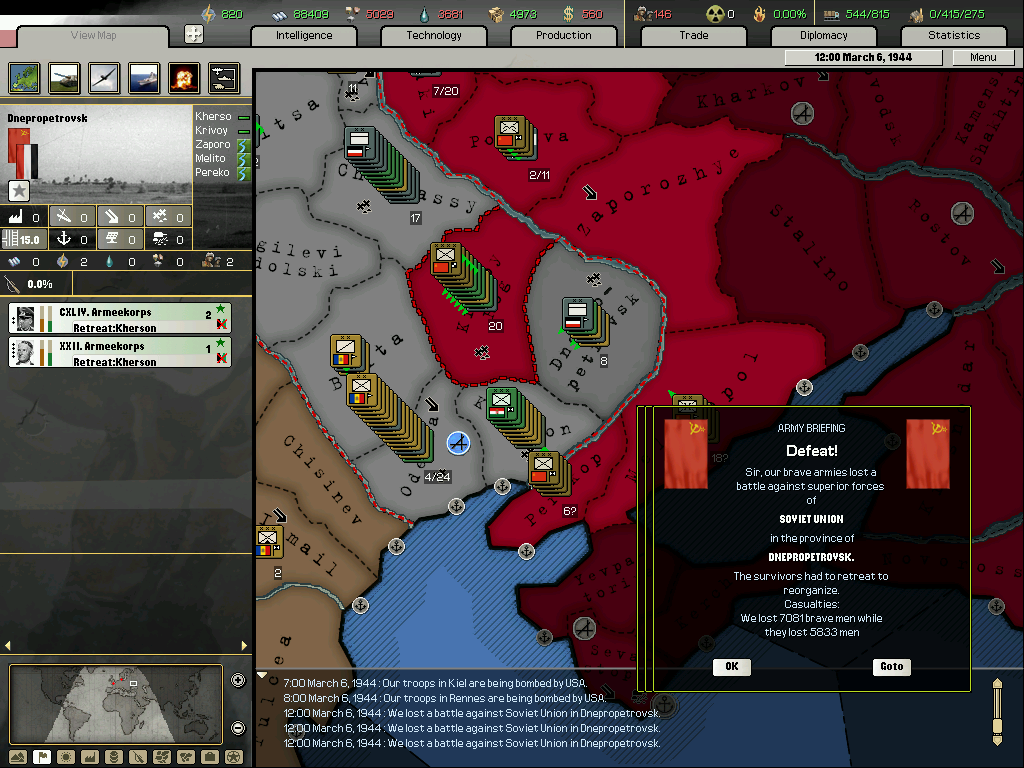

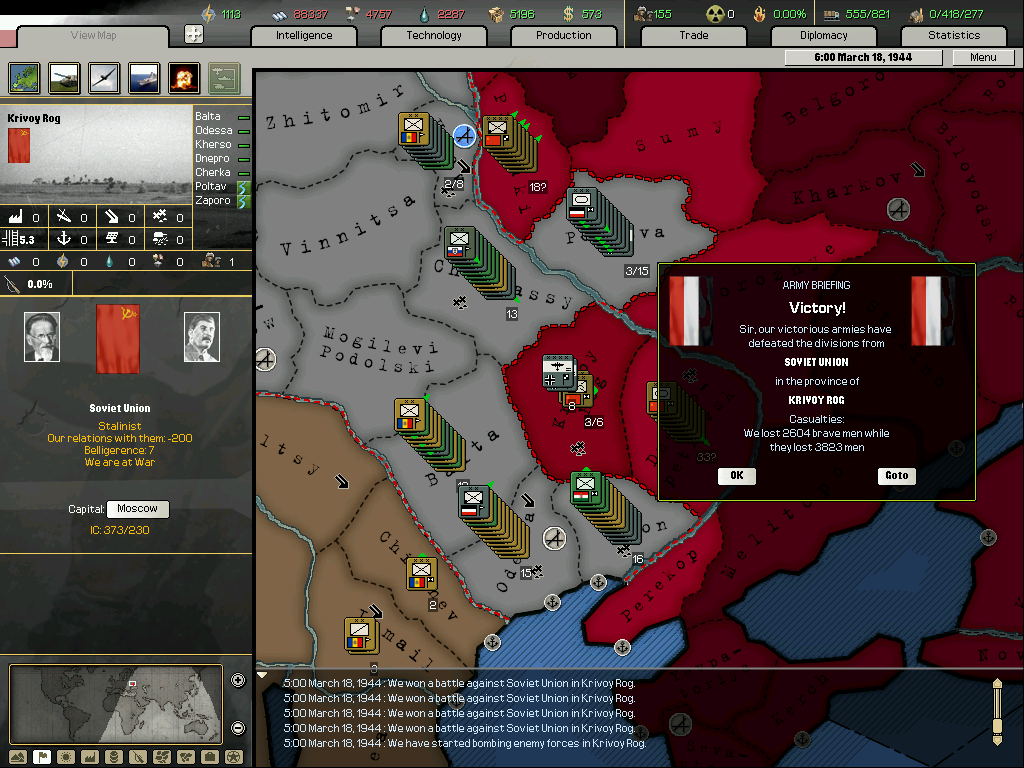
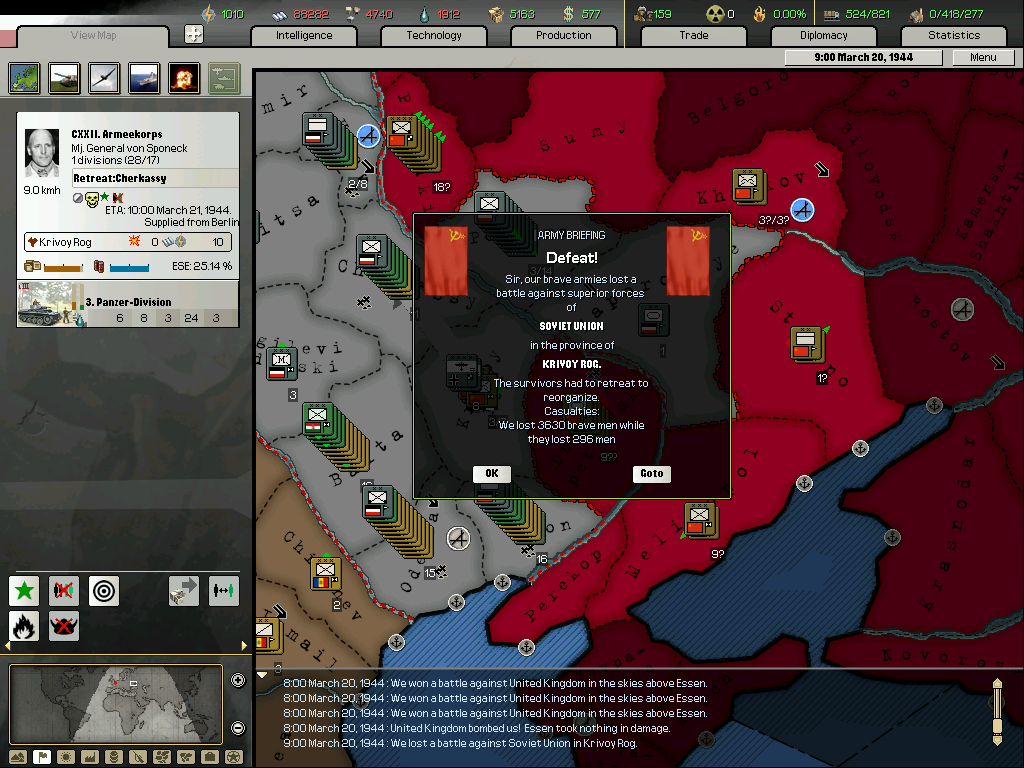


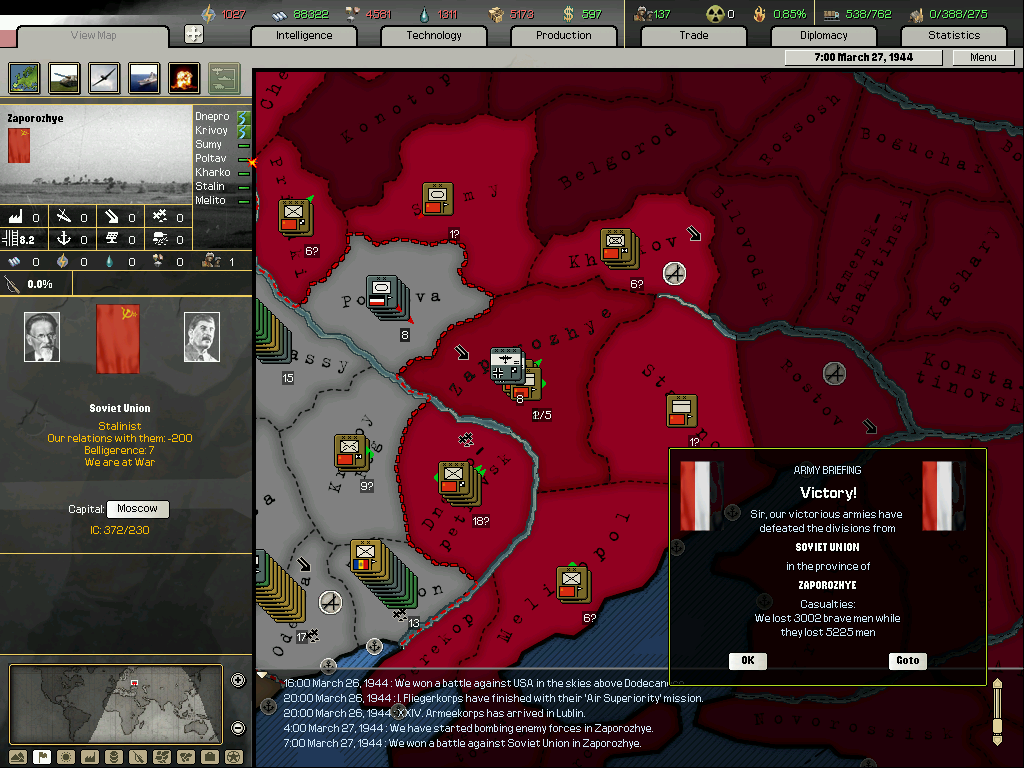
The Red Air Force was clearly not being reinforced, perhaps due to a deliberate Soviet negligence of the military arm. The German leaders were pleased to see it, with the chronically understrength Soviet interceptor wings being destroyed.
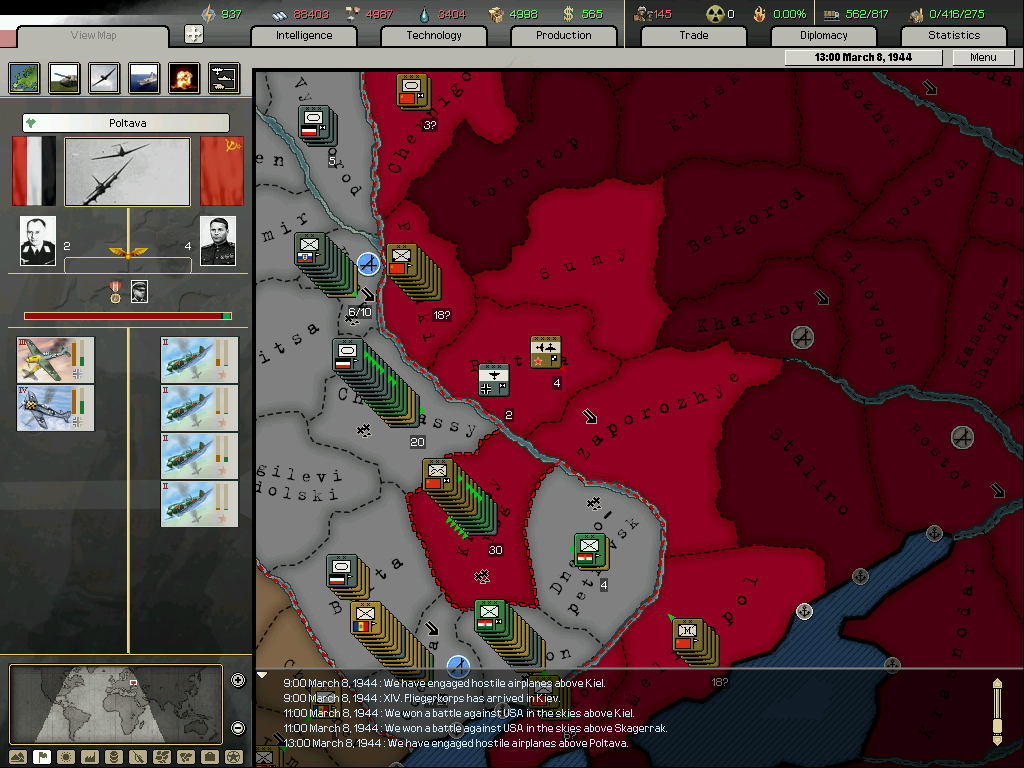
Second Norwegian Campaign
All of Norway was back in German hands after months of dramatic retreats and victories by both sides. The Second Norwegian Campaign officially ended on 7th March 1944.
An attempt by the UK to land in Oslo was defeated thanks to the Kriegsmarine, with it being hoped the German navy will prevent any further invasion of occupied-Norway as there is at least 1 division on every Norwegian coastal province to ensure the British navy cannot launch a surprise invasion.


Another bizarre and hopeless attempt by the UK to paratroop France failed.
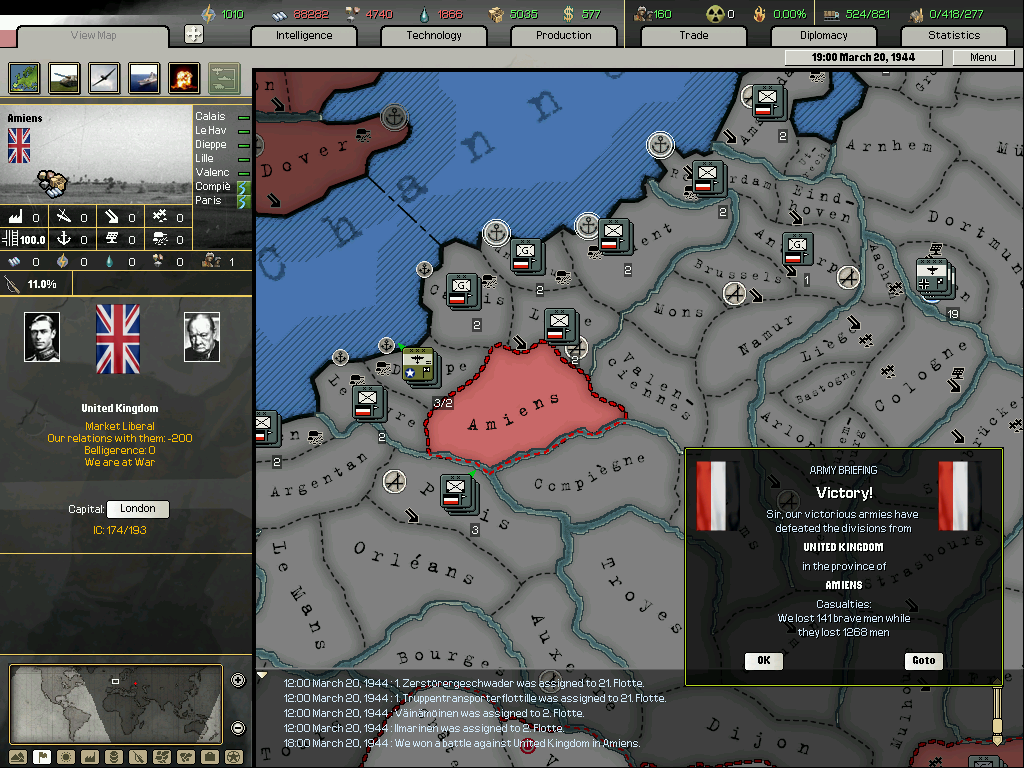
Air war against the Allies
Another unprecedented sight caused concern with the German leadership; American fighter planes over the Rhineland! However this did not dramatically alter the war in the air as the Luftwaffe managed to use its technical, and due to the distance, numerical superiority to ensure US bombers did not significantly dent German industry. In addition, German rocket interceptors started entering combat, with the first two squadrons being produced on 10th March.
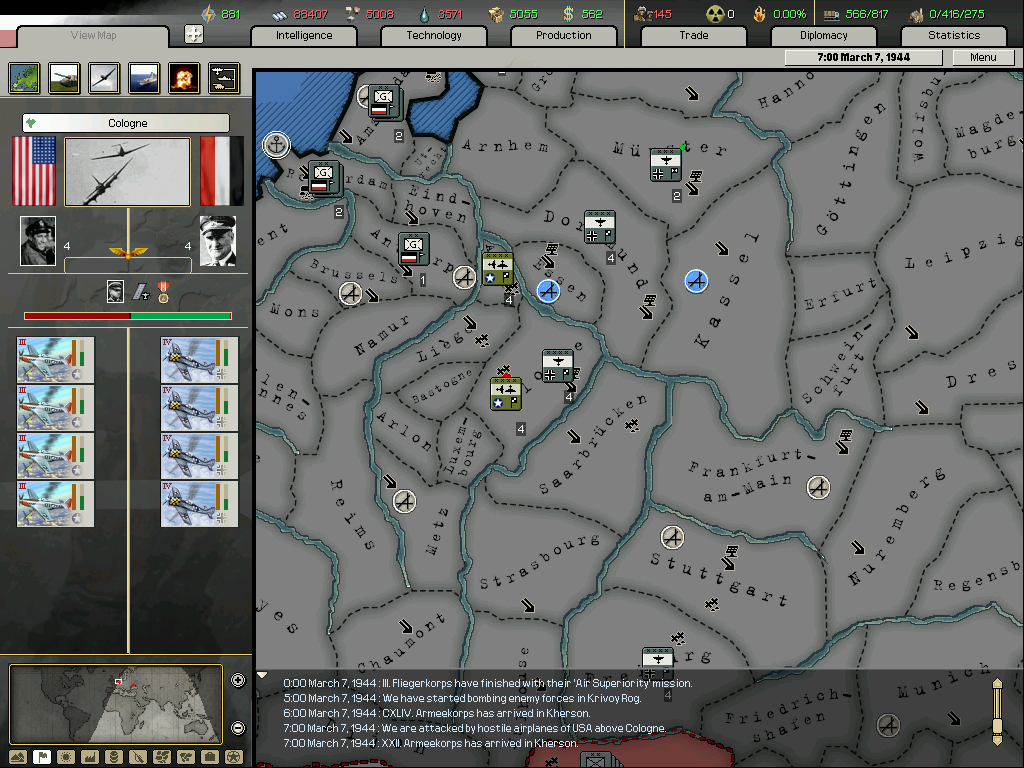
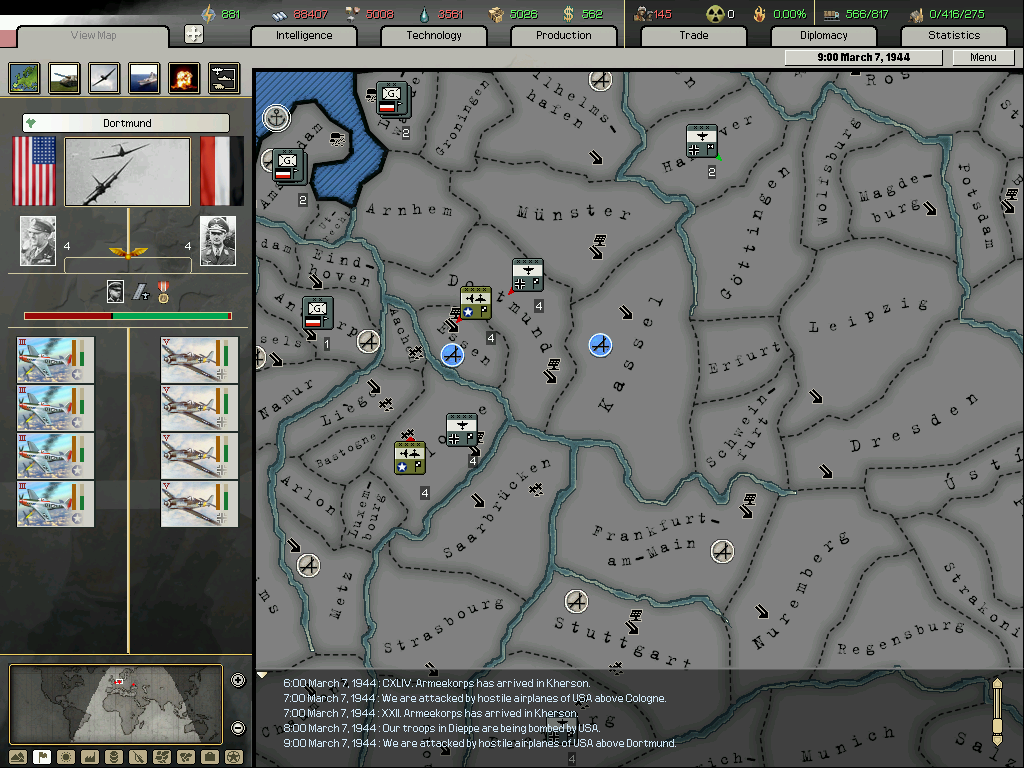
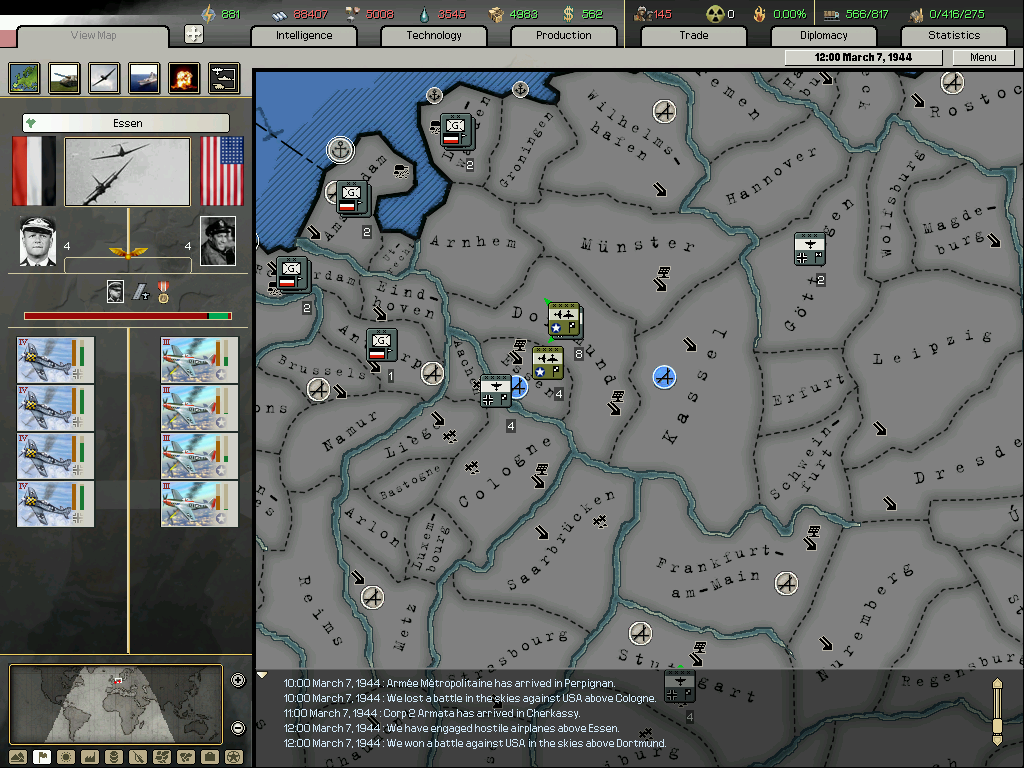

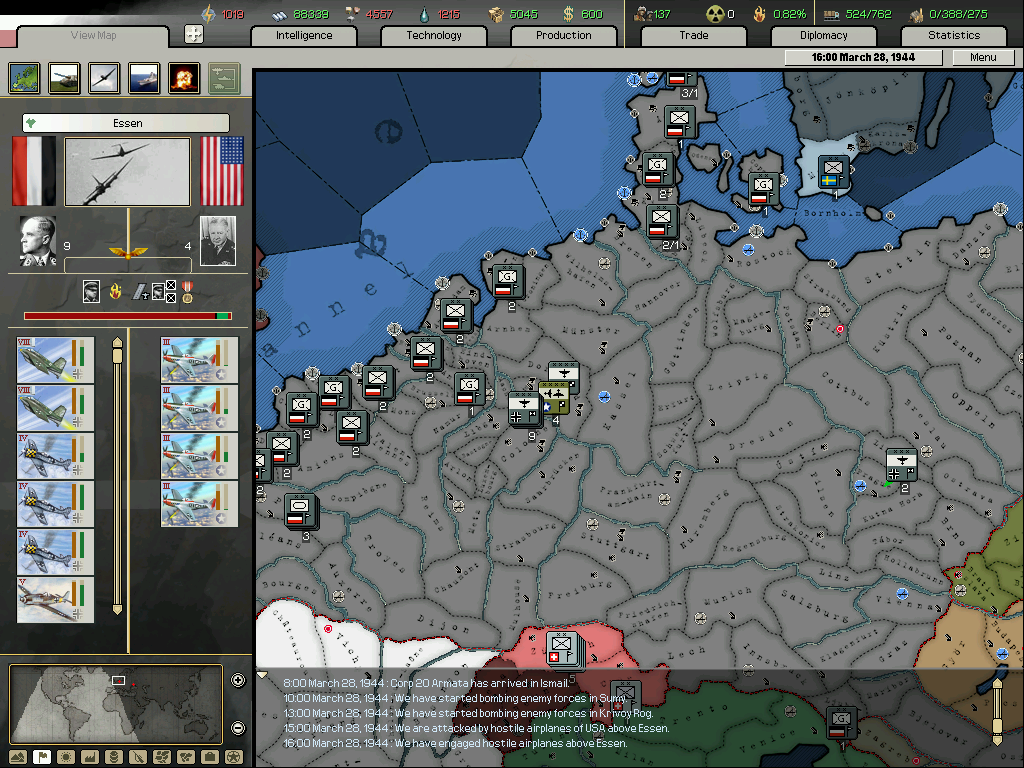
A rare moment occurred when French air units were fighting fellow Frenchmen! The Vichy interceptors also encountered the upgraded US fighters, unfortunately not having the same success as the Germans against them.
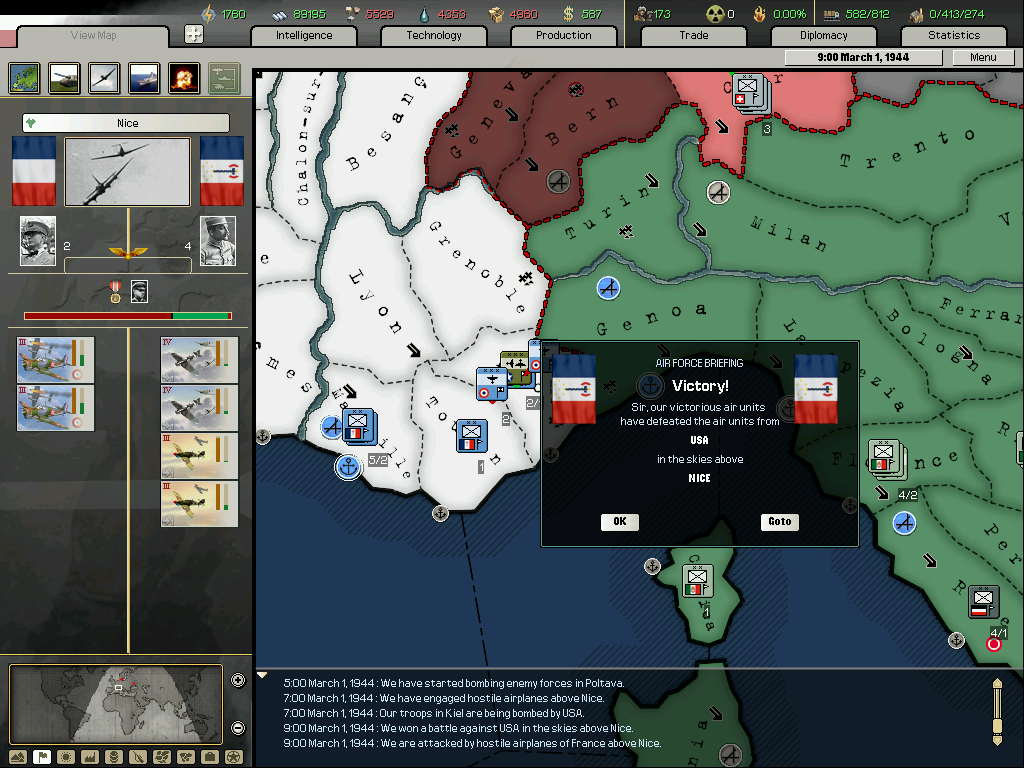
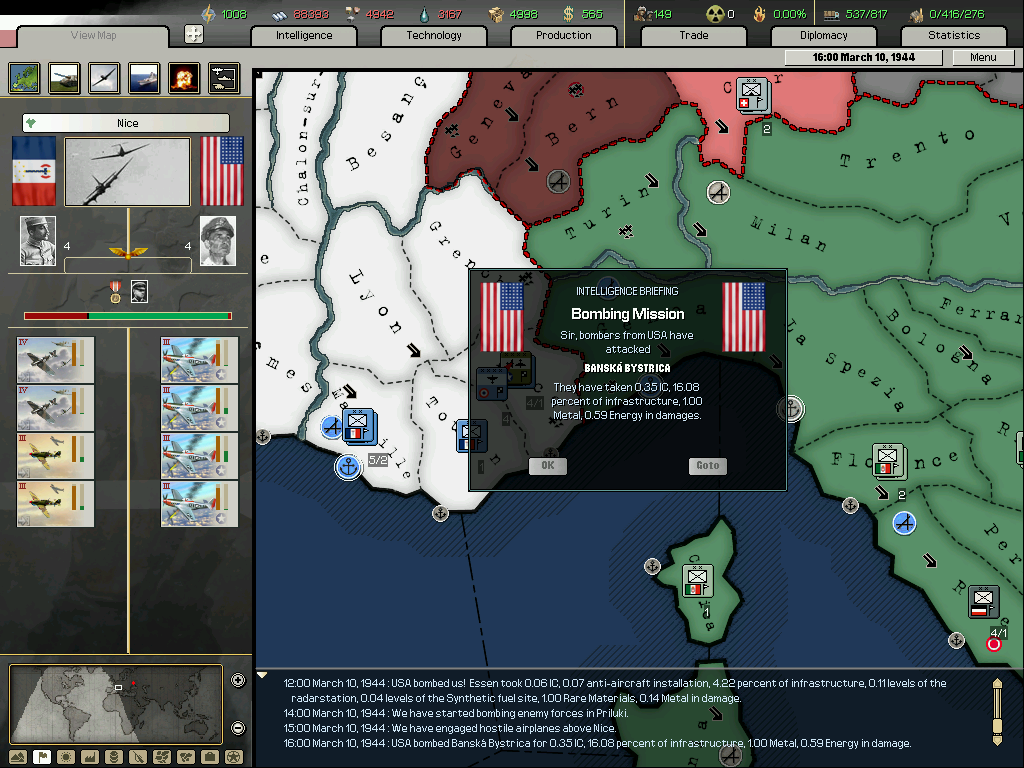
Italy just about managed to repulse US bombers over its territory, with the help of German units.
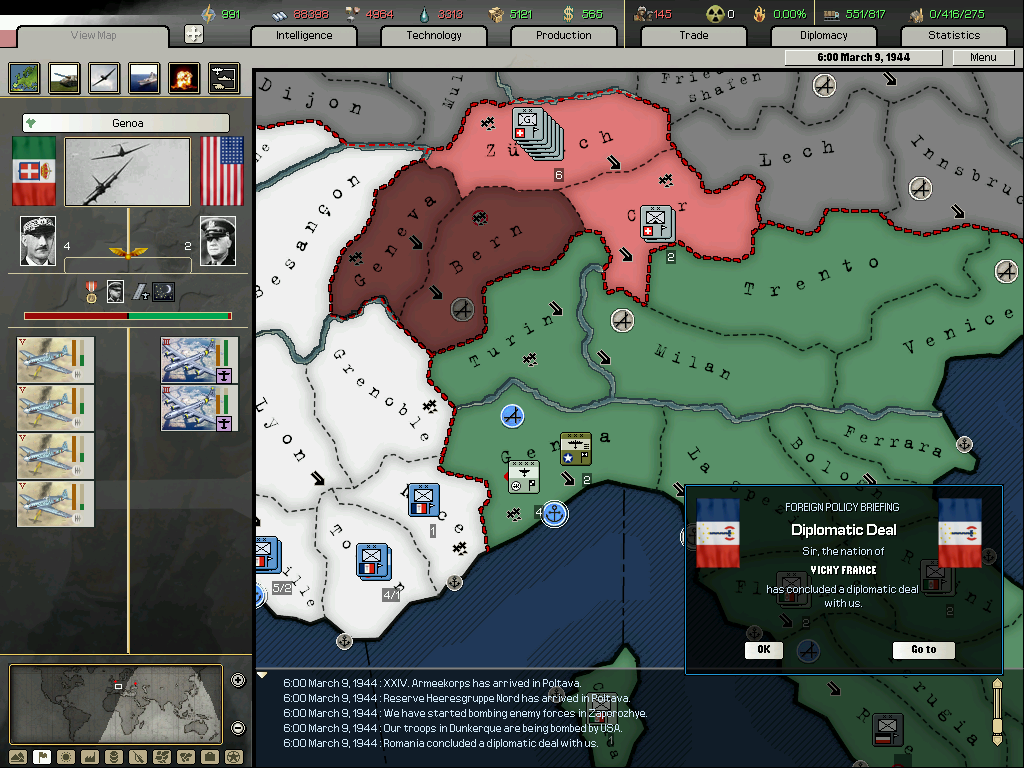
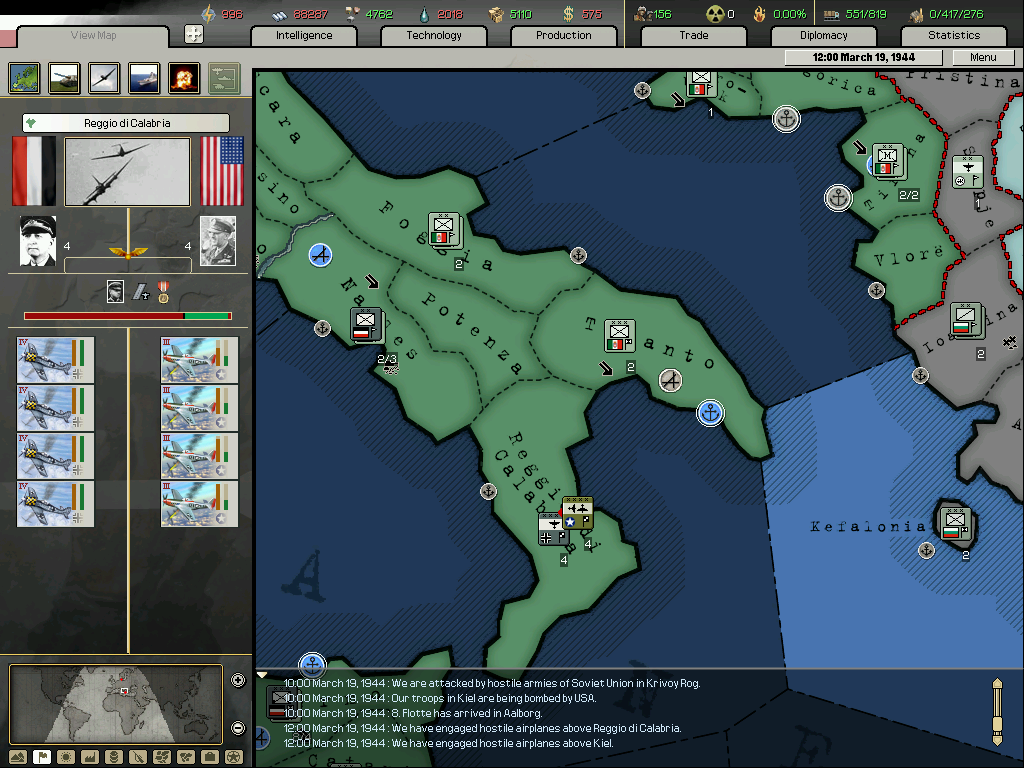
Due to the severity of the resource problem Albert Speer had to be removed from his Minister of Armaments position, along with his extensive industrial reforms in order to reduce the resources needed to fuel German industry. At one point in this month coal stockpiles were as low as 39 units. Walter Darre was his replacement due to his 'bread and butter' approach of maximising supplies and streamlining the production of new units.
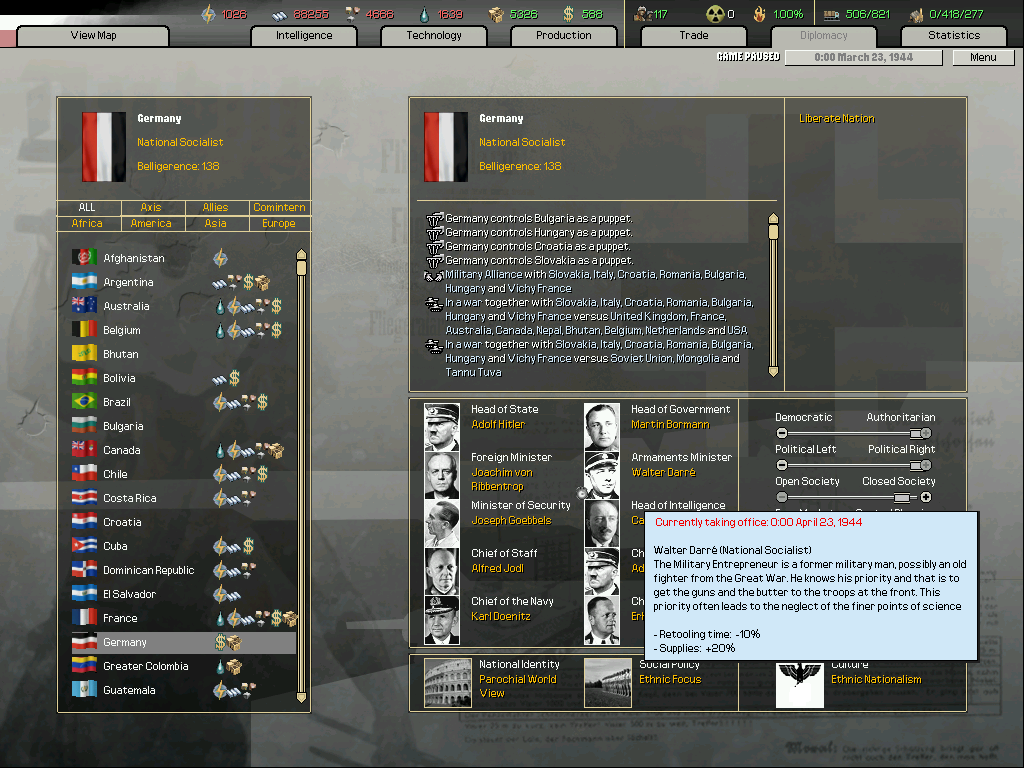
The Kriegsmarine manage to take control of 3 divisions for its own ambitious plan...

Losses charts


Eastern front
The battle for Krivoy Rog that had started last month eventually ended in an Axis defeat. The Dnieper has been crossed with Dnepropetrovsk falling soon after, although this unprecedented situation turned into an opportunity for the Wehrmacht as the Luftwaffe bombers and Heer combined their efforts to through the Red Army in the south into disarray.








The Red Air Force was clearly not being reinforced, perhaps due to a deliberate Soviet negligence of the military arm. The German leaders were pleased to see it, with the chronically understrength Soviet interceptor wings being destroyed.

Second Norwegian Campaign
All of Norway was back in German hands after months of dramatic retreats and victories by both sides. The Second Norwegian Campaign officially ended on 7th March 1944.
An attempt by the UK to land in Oslo was defeated thanks to the Kriegsmarine, with it being hoped the German navy will prevent any further invasion of occupied-Norway as there is at least 1 division on every Norwegian coastal province to ensure the British navy cannot launch a surprise invasion.


Another bizarre and hopeless attempt by the UK to paratroop France failed.

Air war against the Allies
Another unprecedented sight caused concern with the German leadership; American fighter planes over the Rhineland! However this did not dramatically alter the war in the air as the Luftwaffe managed to use its technical, and due to the distance, numerical superiority to ensure US bombers did not significantly dent German industry. In addition, German rocket interceptors started entering combat, with the first two squadrons being produced on 10th March.





A rare moment occurred when French air units were fighting fellow Frenchmen! The Vichy interceptors also encountered the upgraded US fighters, unfortunately not having the same success as the Germans against them.


Italy just about managed to repulse US bombers over its territory, with the help of German units.


Due to the severity of the resource problem Albert Speer had to be removed from his Minister of Armaments position, along with his extensive industrial reforms in order to reduce the resources needed to fuel German industry. At one point in this month coal stockpiles were as low as 39 units. Walter Darre was his replacement due to his 'bread and butter' approach of maximising supplies and streamlining the production of new units.

The Kriegsmarine manage to take control of 3 divisions for its own ambitious plan...

April 1944
Losses chart
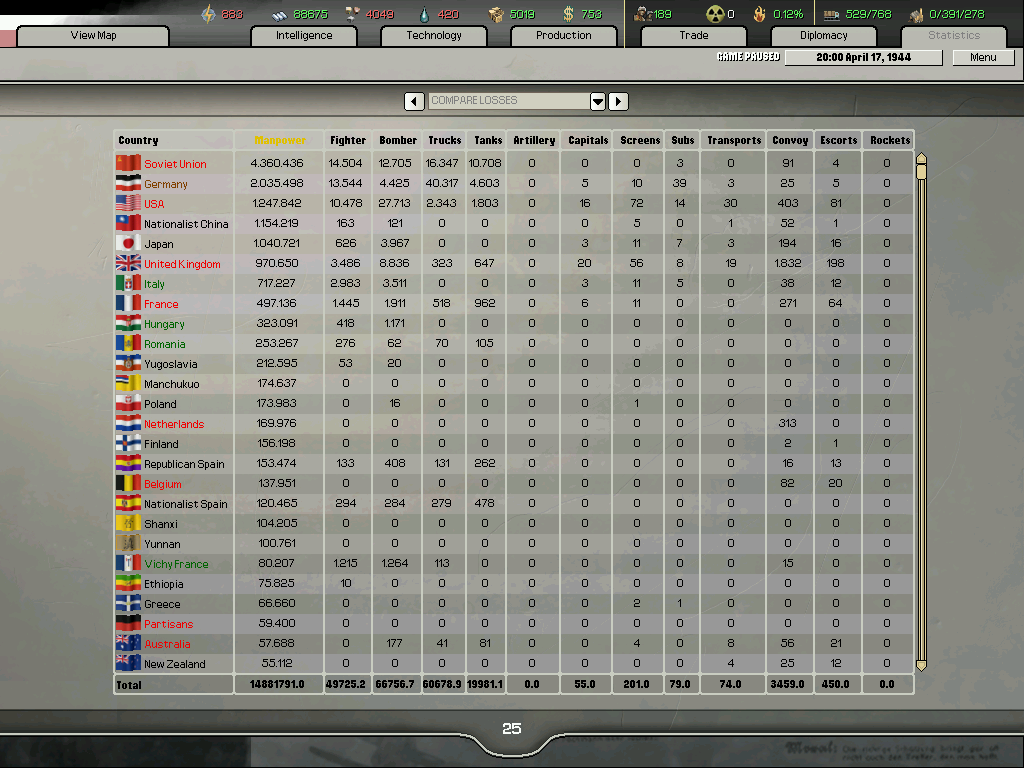
Eastern front
The Heer continued to create dismay and confusion amongst the divisions of the Red army surrounding the Dnieper. Krivoy Rog and Dnepropetrovsk were re-captured, but an opportunity arose to pursue this offensive even further with Poltava, Zaporozhye and Stalino being taken before the month was out. It seemed the Red Army had over-extended itself with its crossing of the Dnieper, with its units chronically lacking supply and a clear lack of reserve units beyond Stalino. The potential of another, perhaps Great, Offensive certainly seemed possible.

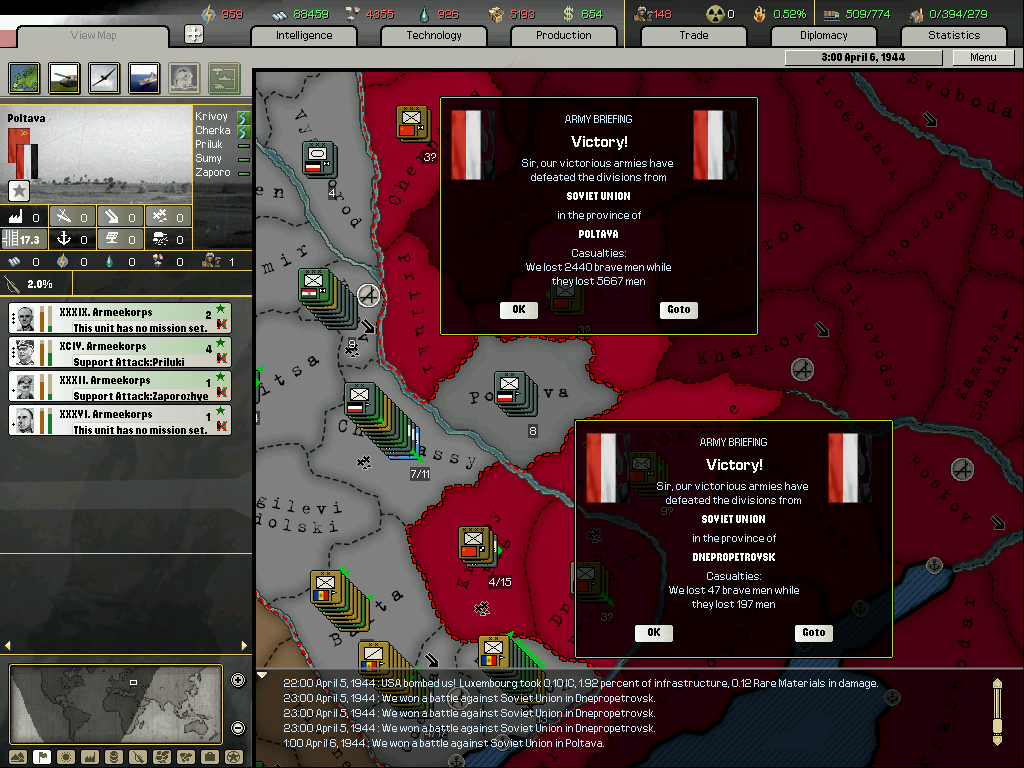
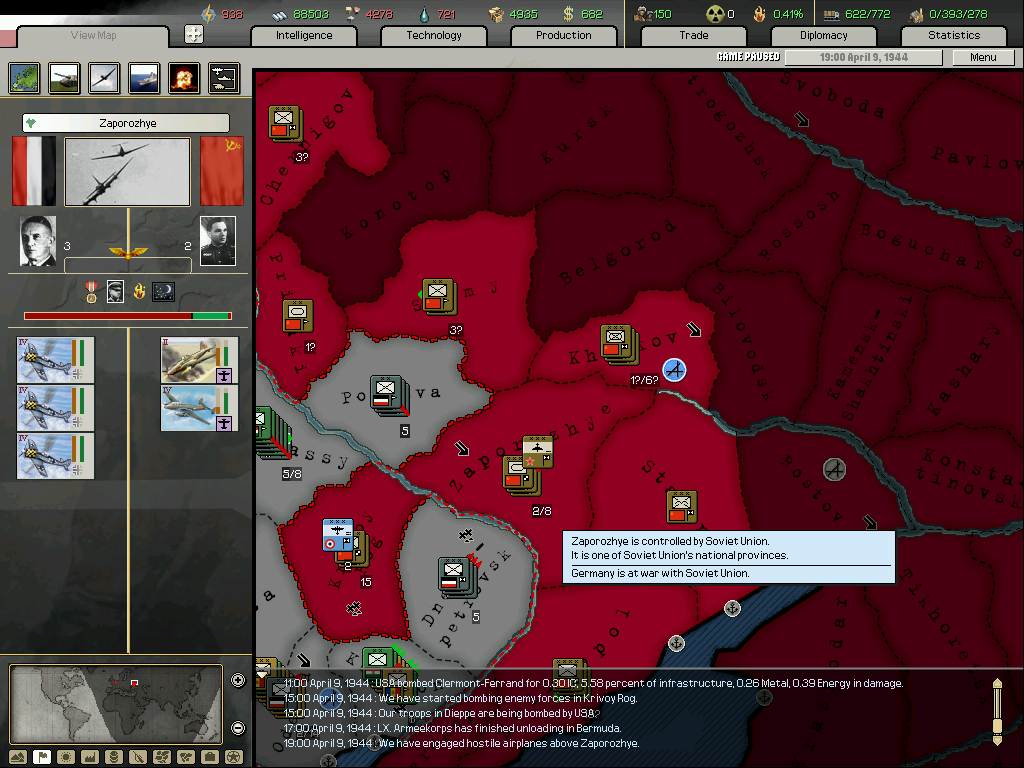
Red Army units in Krivoy Rog were clearly exhausted, with just 5 Axis divisions being able to route 15 Soviet divisions. The Luftwaffe played a significant role in this, and has done throughout this counter-attack.
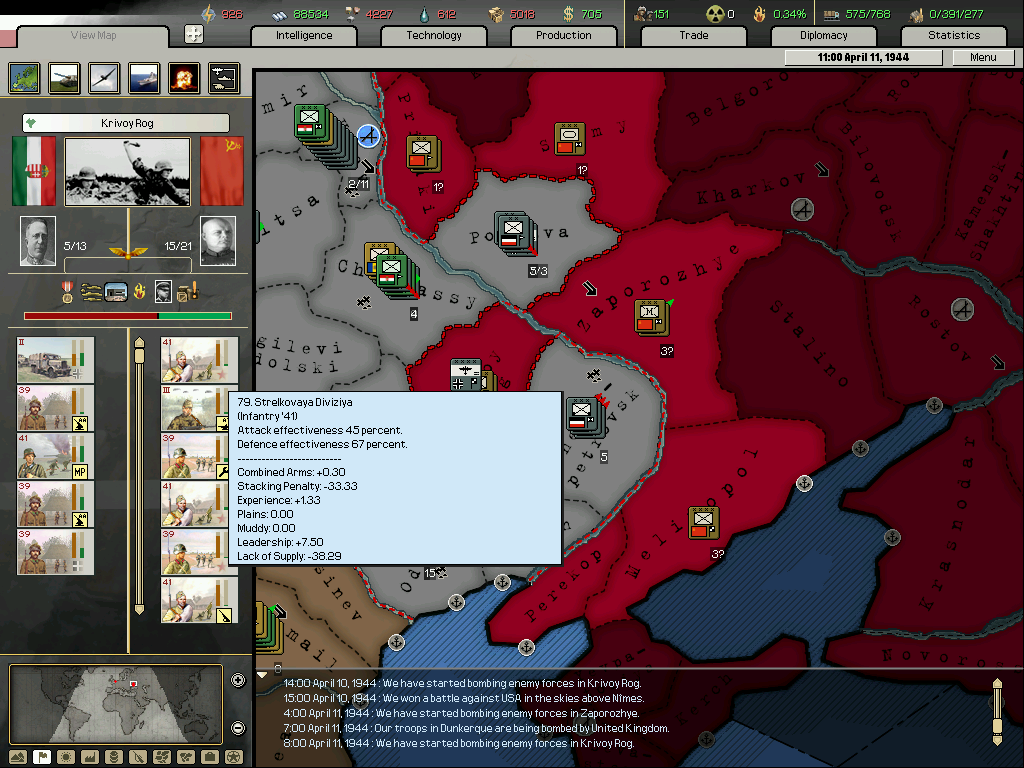
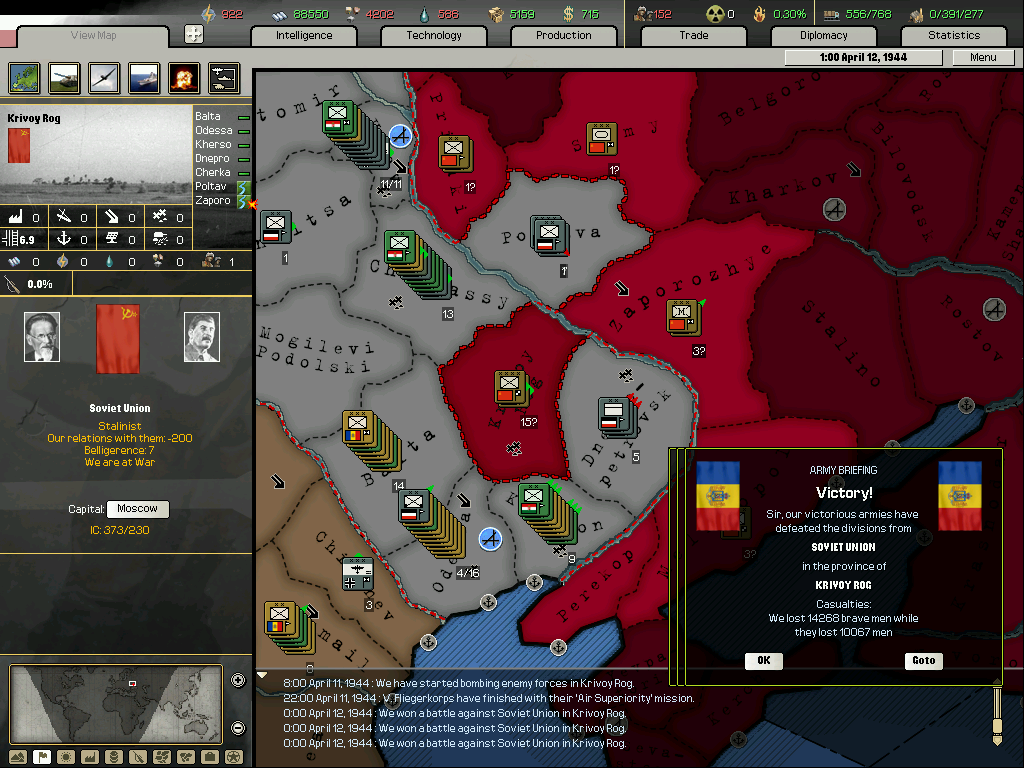

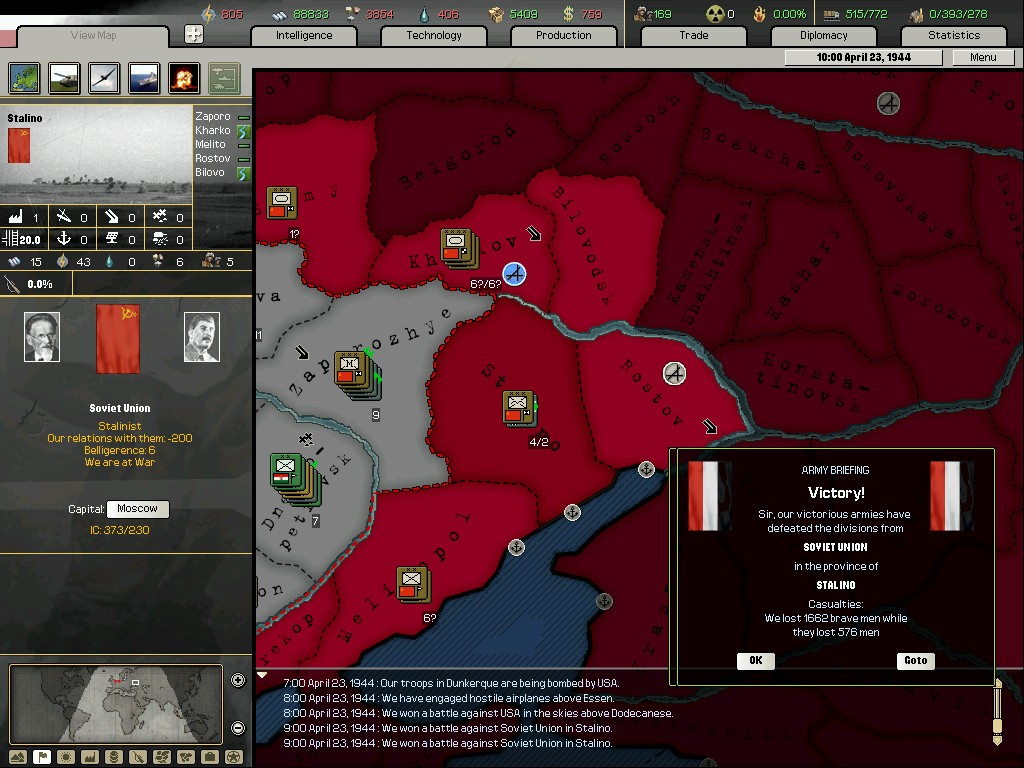
Attacks on Priluki were purely attritional, in order to remove the attrition caused by the hostile front for units in Kiev, but this ultimately failed as the Red Army continued to send units into the territory.
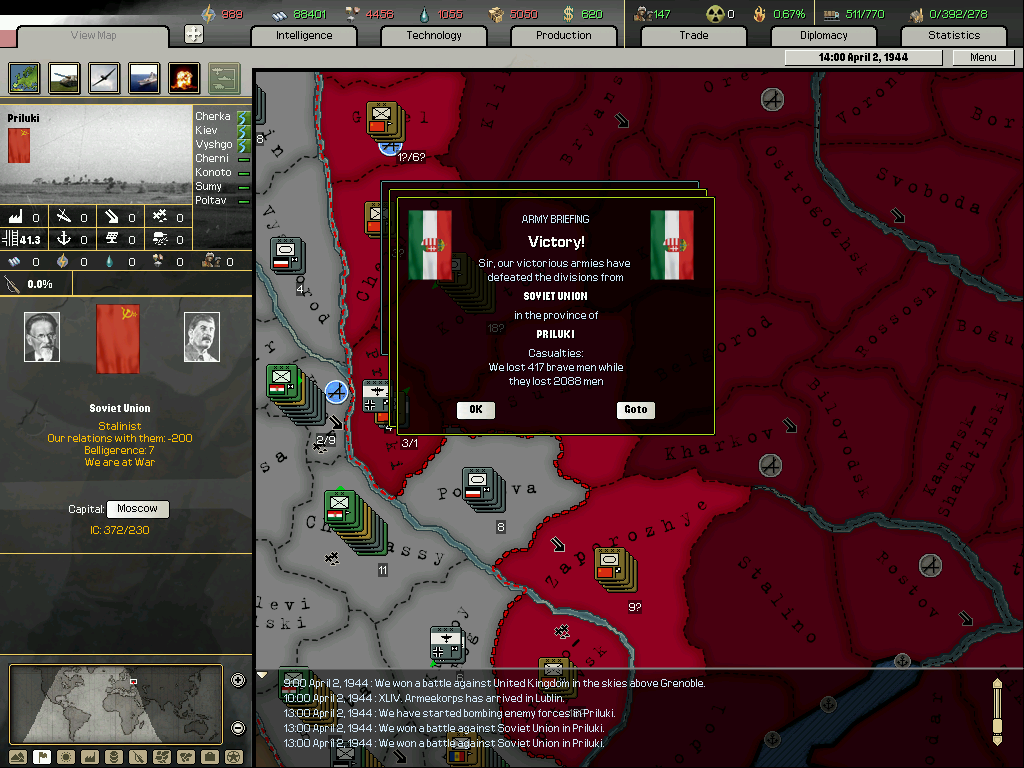
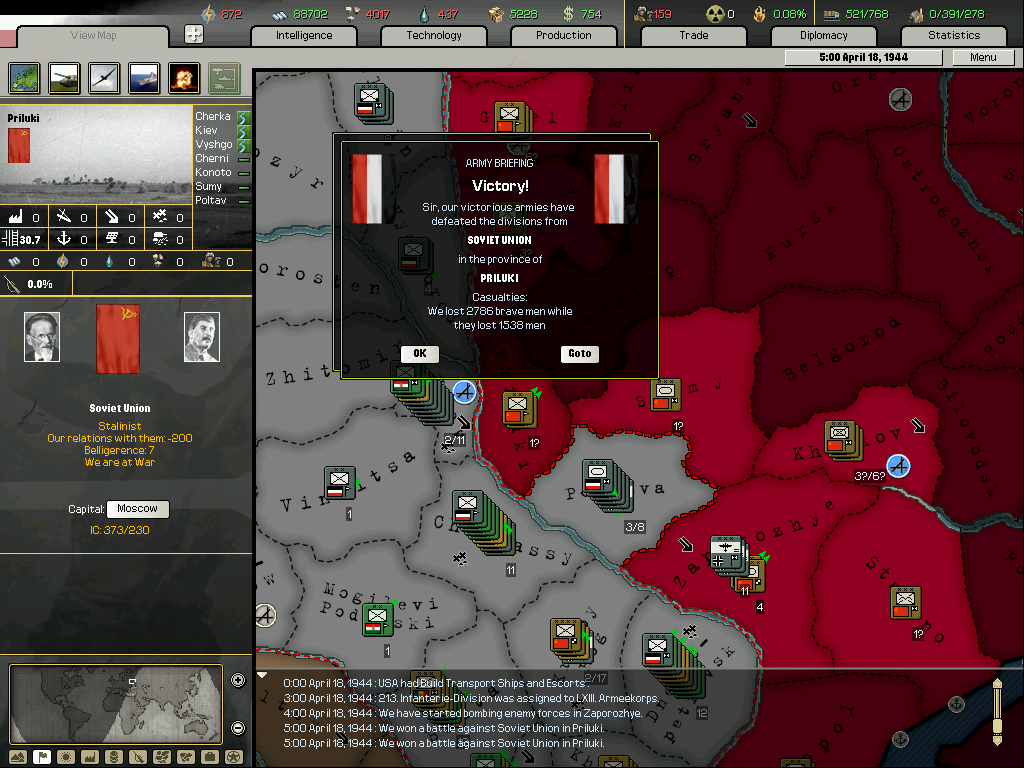
Air war against the Allies
Continued American attempts to gain air superiority over the Rhineland with their new P-51s failed. Although the Luftwaffe was becoming increasingly strained by this new phase in the air war. Its units in Greece faced near disaster. Several air squadrons have been put out of action for at least a few weeks as they require reinforcements. Turbojet Interceptor was researched, further enabling the Luftwaffe to modernise. With it now being able to utilise Rocket and Turbojet Interceptors, it is clearly at the forefront of aviation technology.
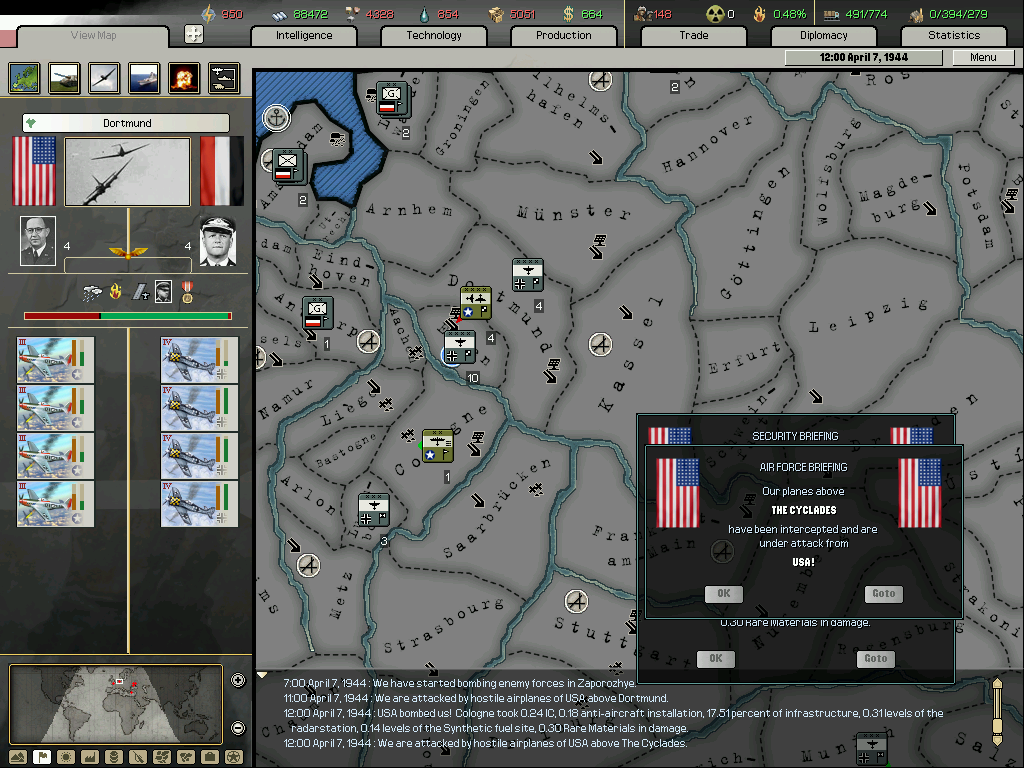
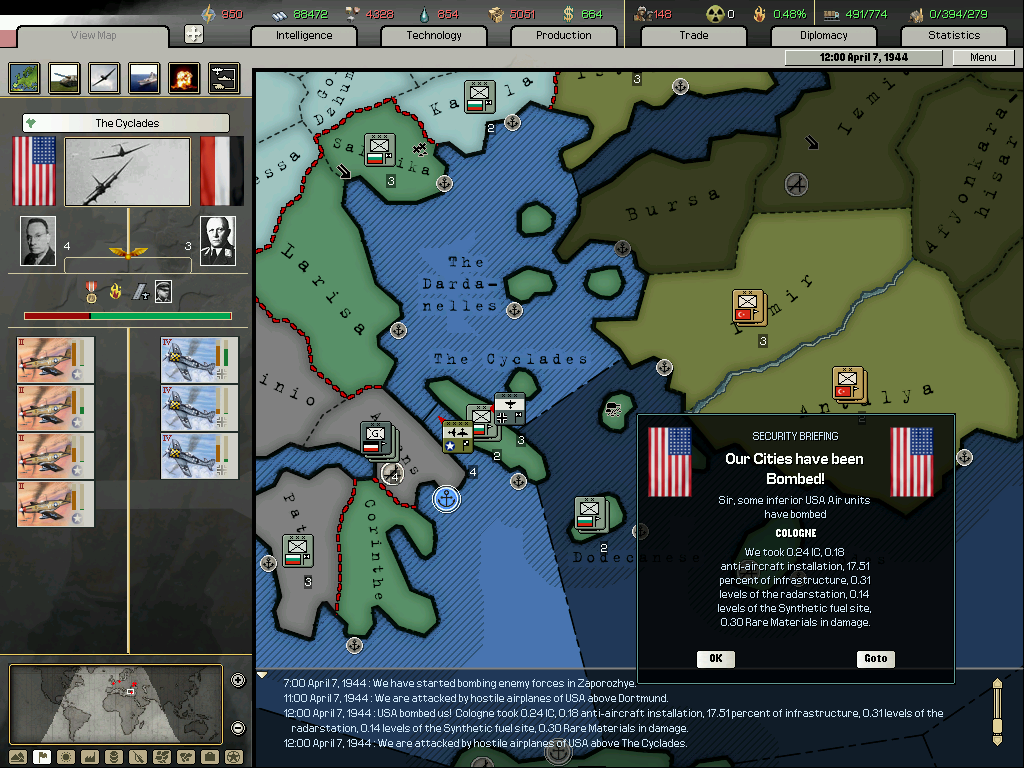
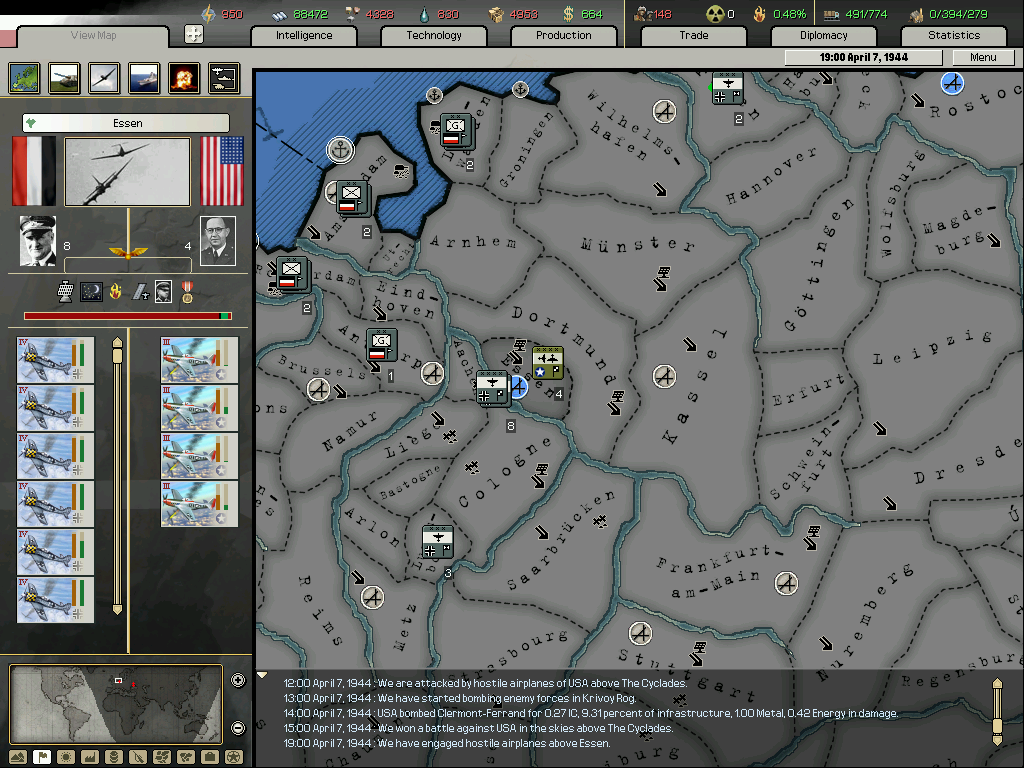

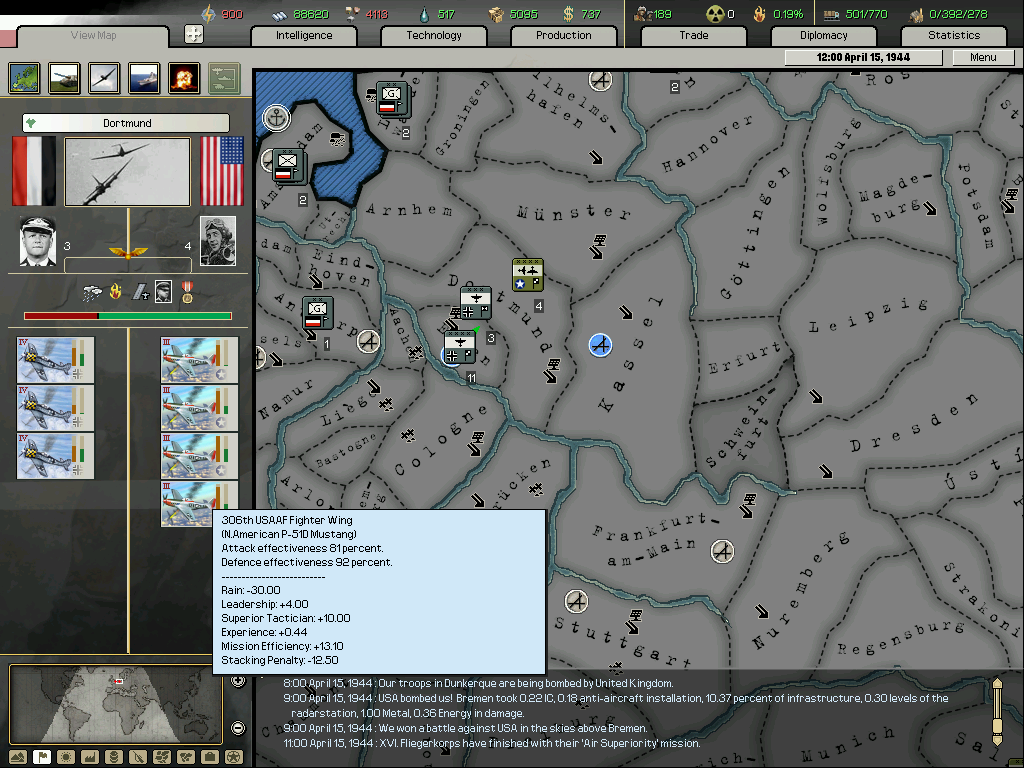
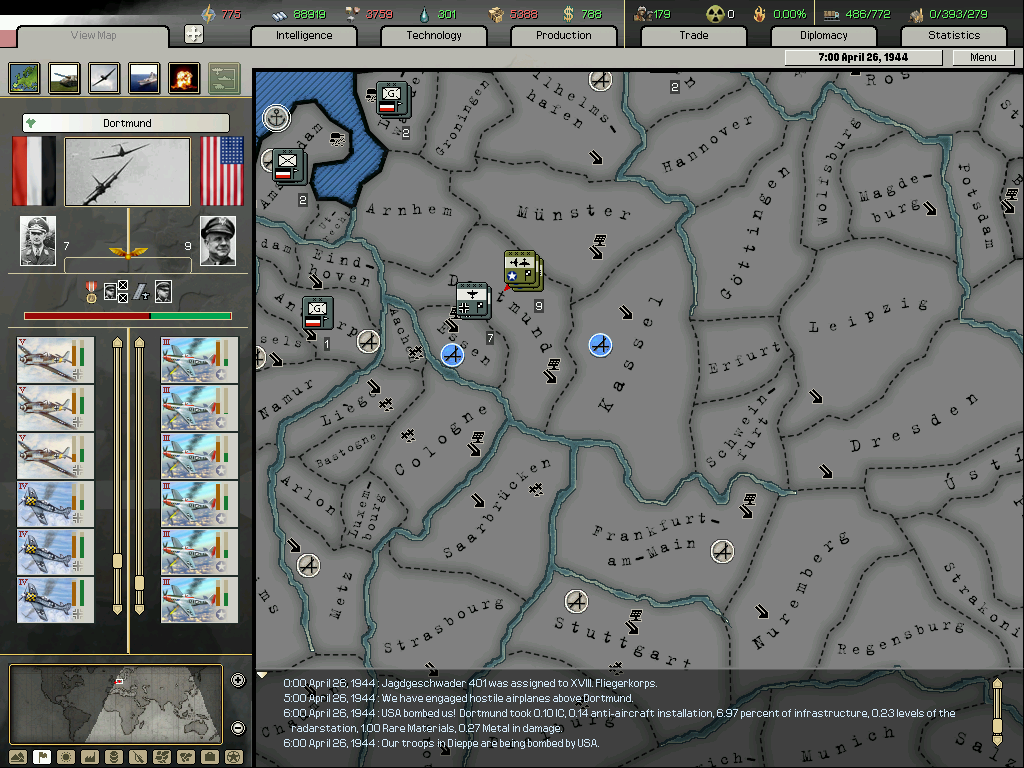
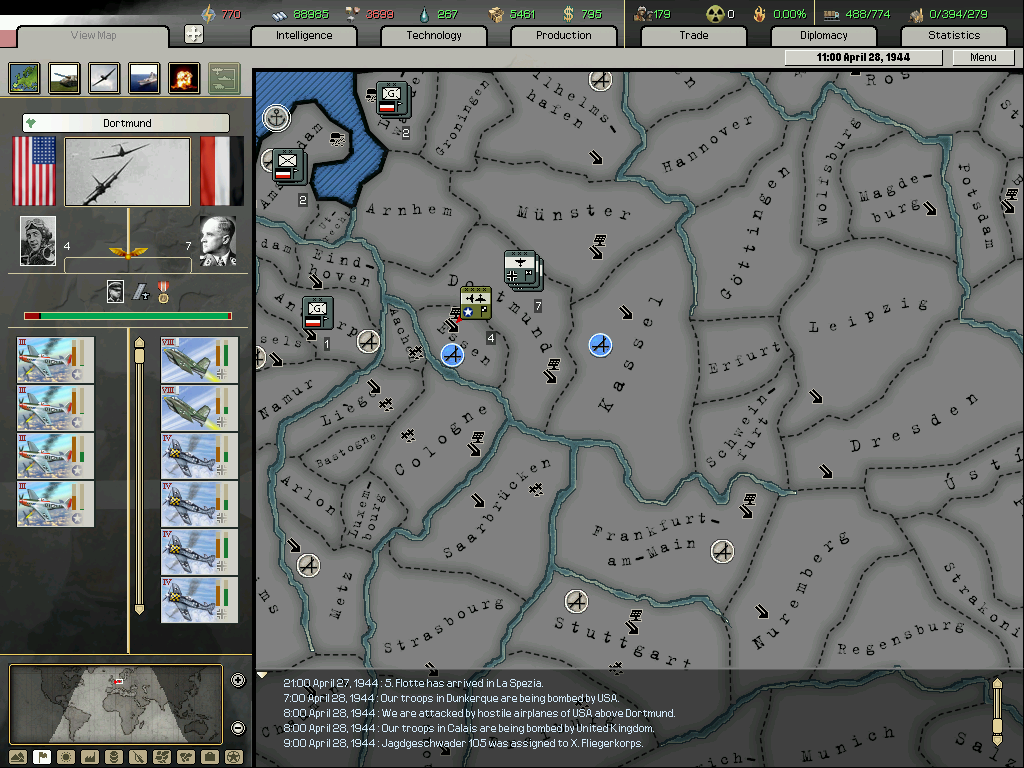
The Italian and Vichy Air Forces also had success against the Allied air forces.


Mediterranean
The US navy showed its sheer strength and technological superiority with its devastating strike on the main naval base in Palermo. Most of the Italian navy was stationed there, but so were several German submarine units. Two of them were unfortunately sunk by the colossal task force of the American navy. 10 more German submarine units have been sent to Italy from France in order to help defend against any Allied invasion force. The Italian army will not be able to hold out against the 70 divisions that were seen resting in Tunis, the Axis will have to depend predominantly on the navy to defeat any Allied amphibious force. The German and Italian leadership can only hope the US carrier force will not be involved in this attack.
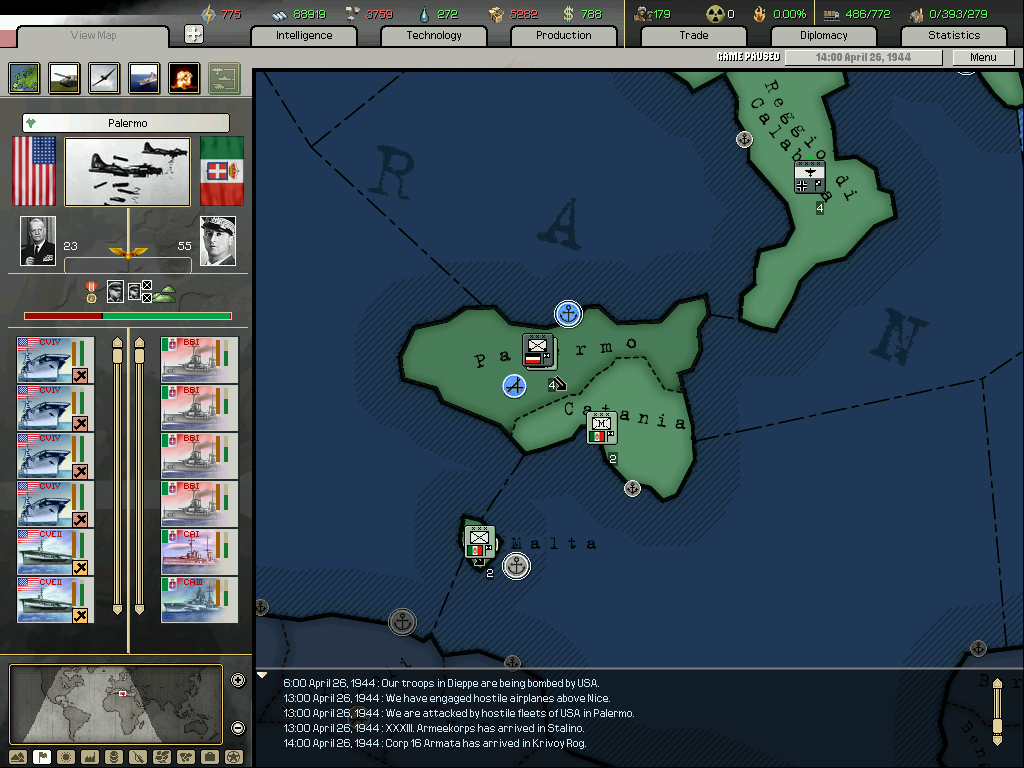
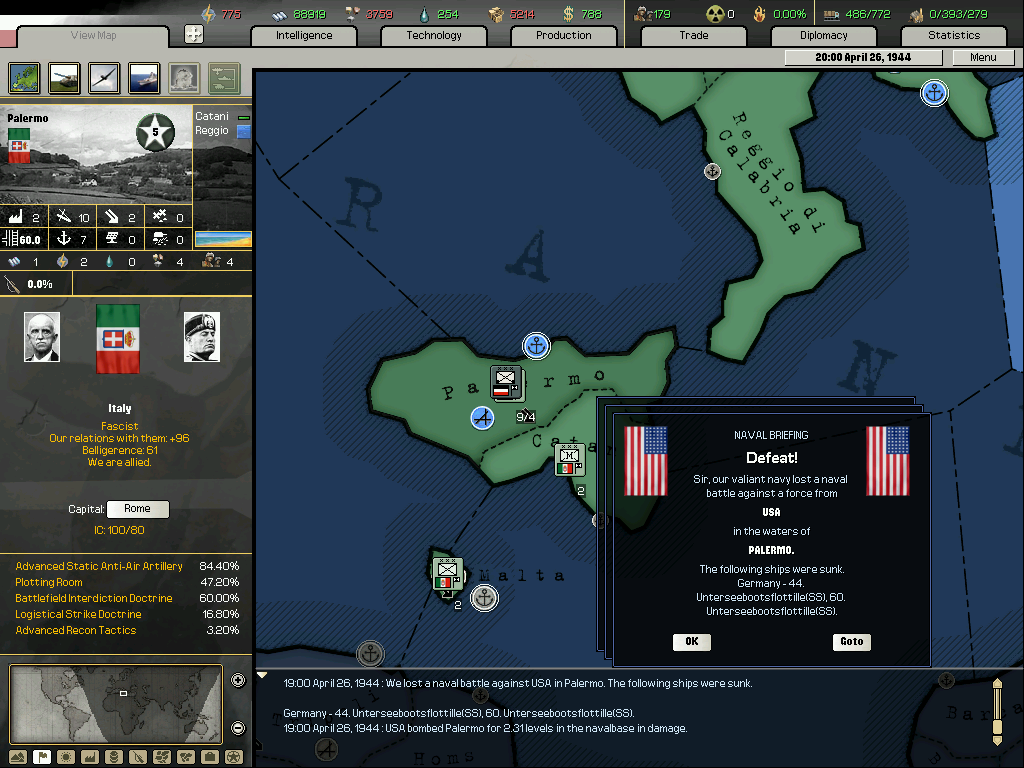
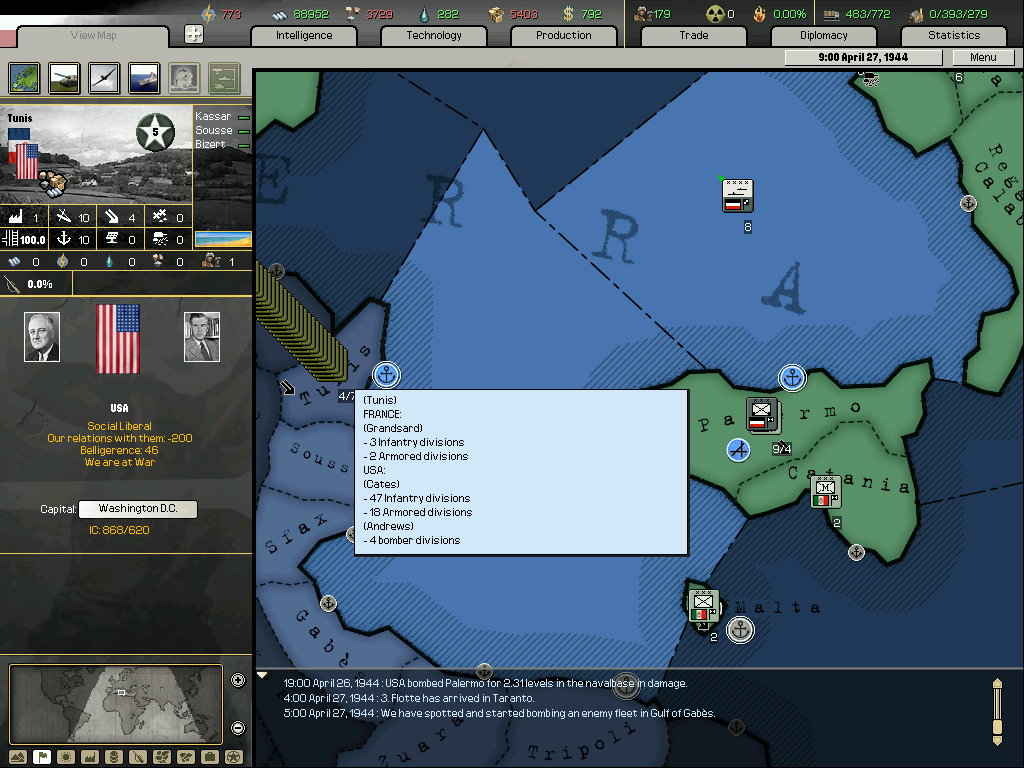
Kriegsmarine's Surprise
This ambitious plan proved too be over-optimistic. It was hoped that by capturing key points of the remaining French territory: Libreville, Cayenne and Dakar, it would be possible to annex the entire French state. Thereby removing de Gaulle and potentially getting Germany a lot of resources. However this could not be done as, assumably, Japan had been holding a key French island in the Pacific but had then lost it by the time German forces arrived in Bermuda. 2 of the 3 infantry divisions were ordered to defend the beaches of German-Denmark, and the third sent to the eastern front. Bermuda was re-captured by British forces on the 29th.

Losses chart

Eastern front
The Heer continued to create dismay and confusion amongst the divisions of the Red army surrounding the Dnieper. Krivoy Rog and Dnepropetrovsk were re-captured, but an opportunity arose to pursue this offensive even further with Poltava, Zaporozhye and Stalino being taken before the month was out. It seemed the Red Army had over-extended itself with its crossing of the Dnieper, with its units chronically lacking supply and a clear lack of reserve units beyond Stalino. The potential of another, perhaps Great, Offensive certainly seemed possible.



Red Army units in Krivoy Rog were clearly exhausted, with just 5 Axis divisions being able to route 15 Soviet divisions. The Luftwaffe played a significant role in this, and has done throughout this counter-attack.




Attacks on Priluki were purely attritional, in order to remove the attrition caused by the hostile front for units in Kiev, but this ultimately failed as the Red Army continued to send units into the territory.


Air war against the Allies
Continued American attempts to gain air superiority over the Rhineland with their new P-51s failed. Although the Luftwaffe was becoming increasingly strained by this new phase in the air war. Its units in Greece faced near disaster. Several air squadrons have been put out of action for at least a few weeks as they require reinforcements. Turbojet Interceptor was researched, further enabling the Luftwaffe to modernise. With it now being able to utilise Rocket and Turbojet Interceptors, it is clearly at the forefront of aviation technology.







The Italian and Vichy Air Forces also had success against the Allied air forces.


Mediterranean
The US navy showed its sheer strength and technological superiority with its devastating strike on the main naval base in Palermo. Most of the Italian navy was stationed there, but so were several German submarine units. Two of them were unfortunately sunk by the colossal task force of the American navy. 10 more German submarine units have been sent to Italy from France in order to help defend against any Allied invasion force. The Italian army will not be able to hold out against the 70 divisions that were seen resting in Tunis, the Axis will have to depend predominantly on the navy to defeat any Allied amphibious force. The German and Italian leadership can only hope the US carrier force will not be involved in this attack.



Kriegsmarine's Surprise
This ambitious plan proved too be over-optimistic. It was hoped that by capturing key points of the remaining French territory: Libreville, Cayenne and Dakar, it would be possible to annex the entire French state. Thereby removing de Gaulle and potentially getting Germany a lot of resources. However this could not be done as, assumably, Japan had been holding a key French island in the Pacific but had then lost it by the time German forces arrived in Bermuda. 2 of the 3 infantry divisions were ordered to defend the beaches of German-Denmark, and the third sent to the eastern front. Bermuda was re-captured by British forces on the 29th.

Last edited:
May 1944
Losses charts
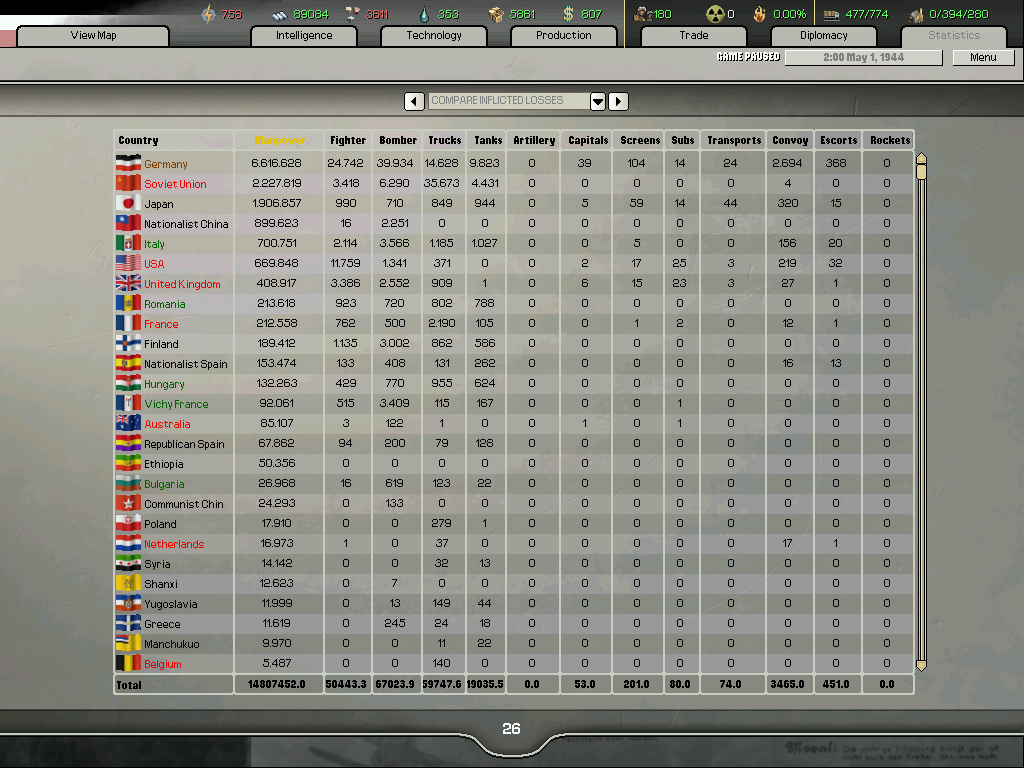
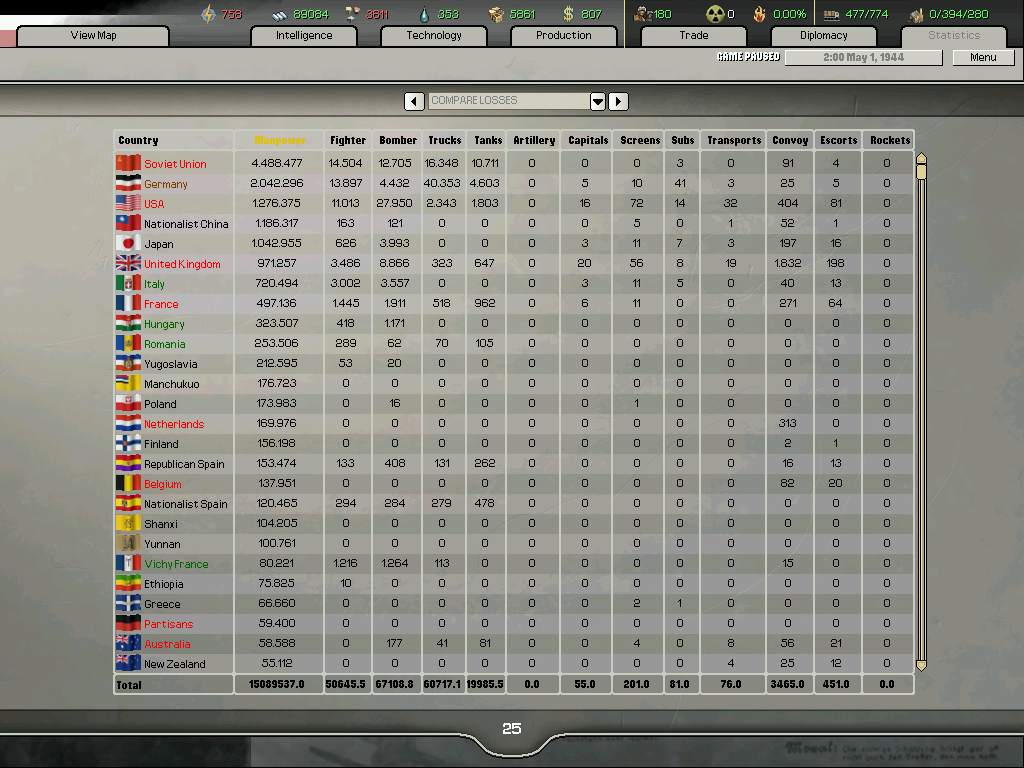
Eastern front
The German army continued its advance. The advance seemed at a logger-head at Zaporozhye, with repeated attacks and counter-attacks on both sides.
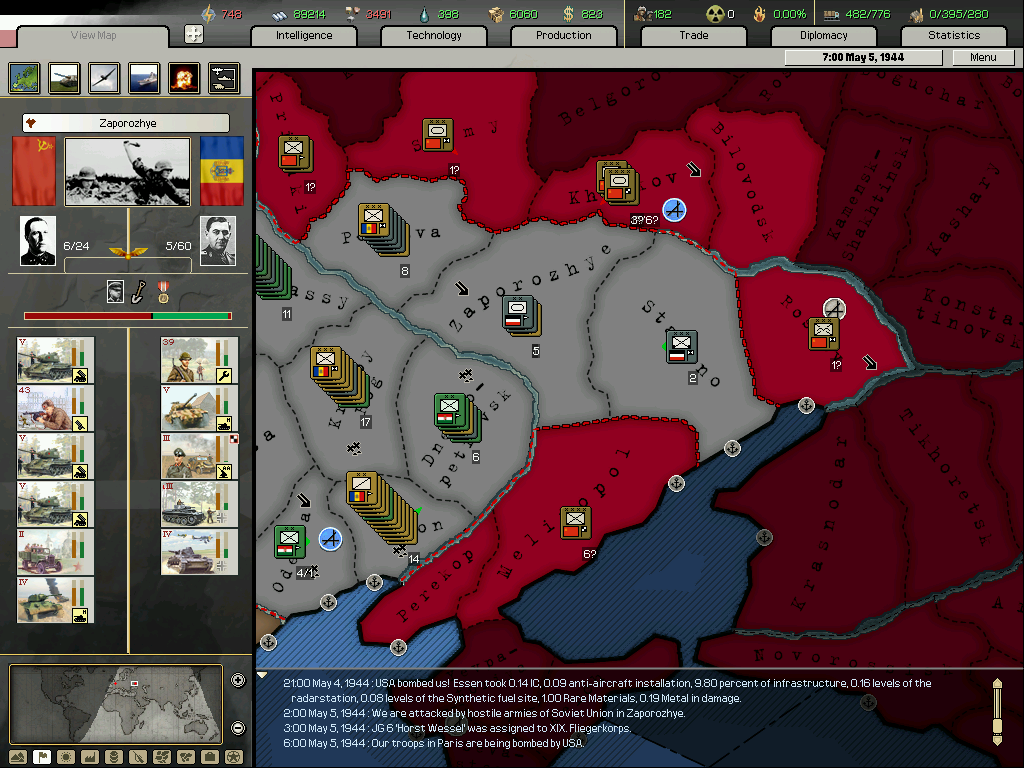
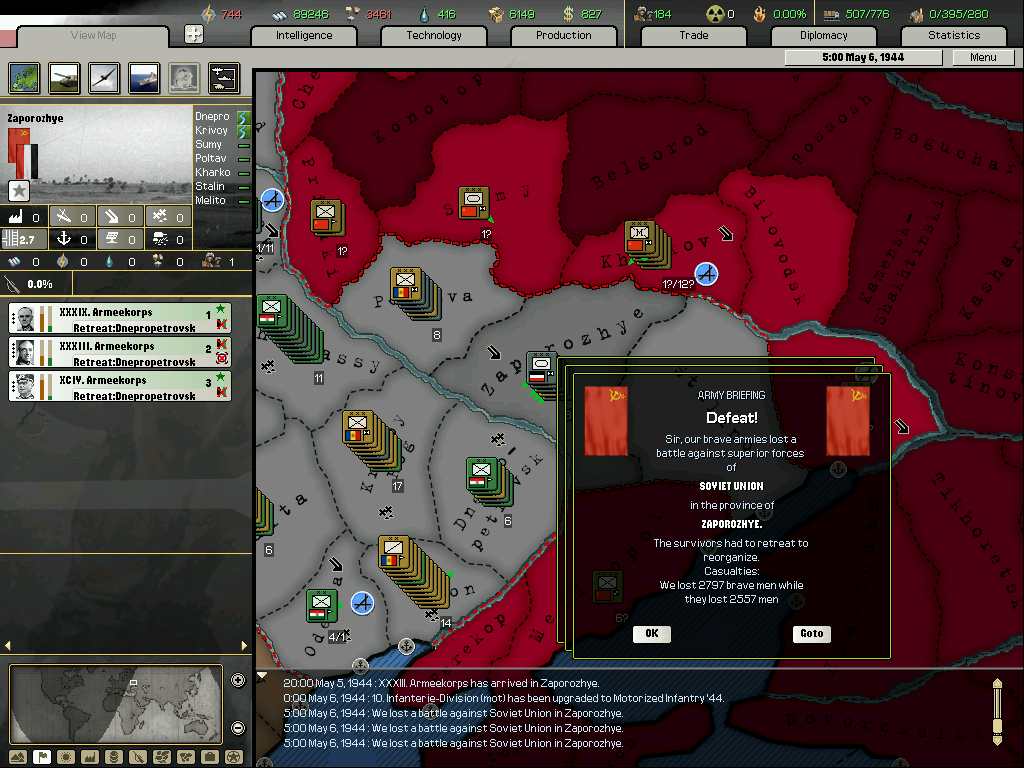
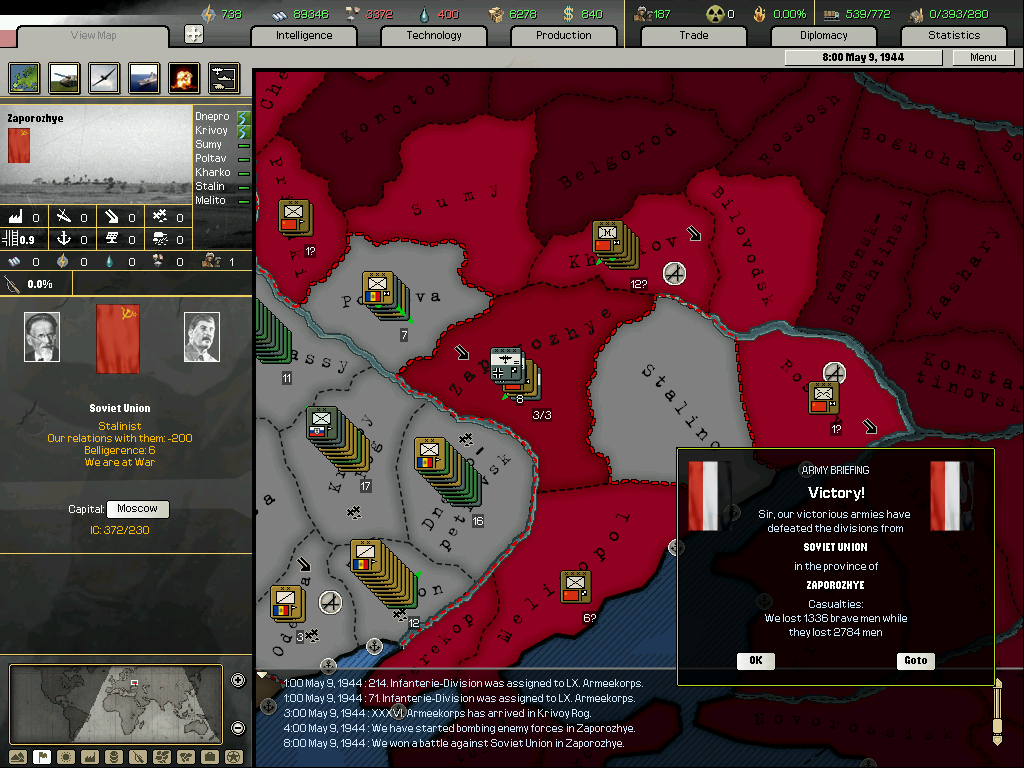
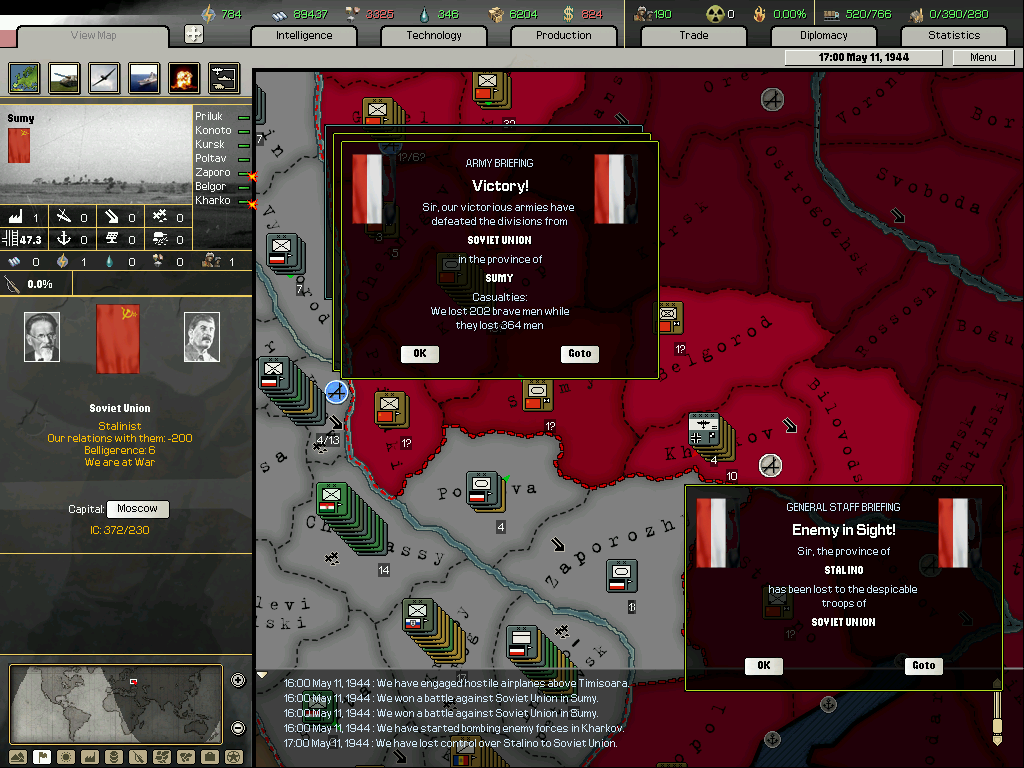
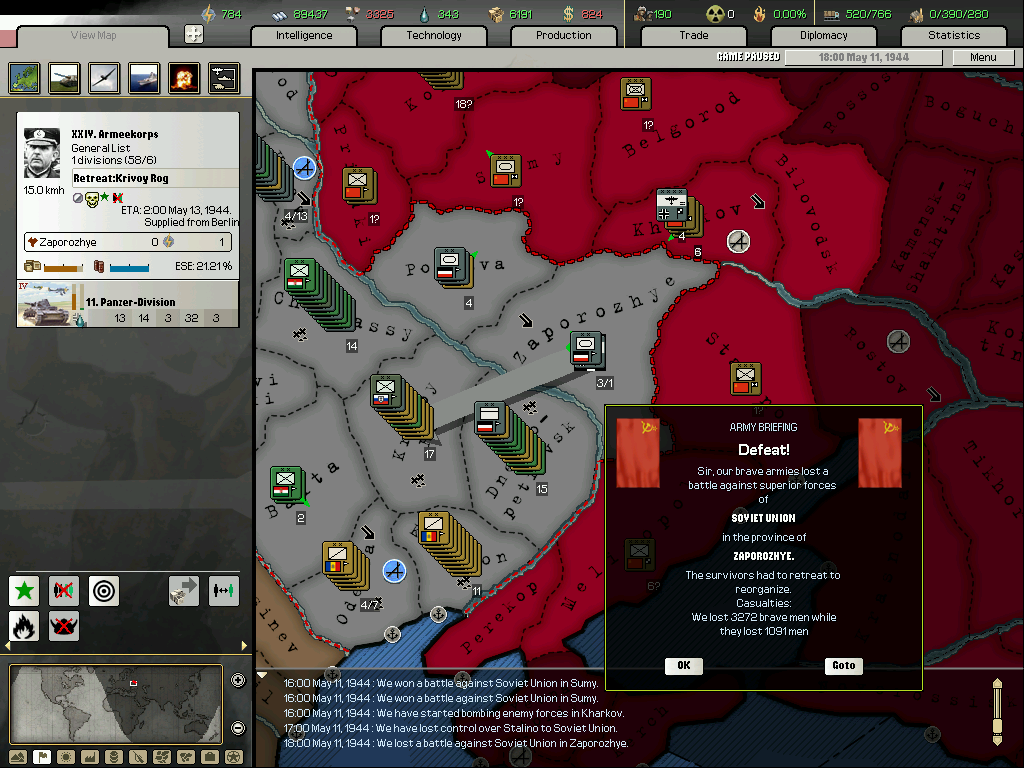
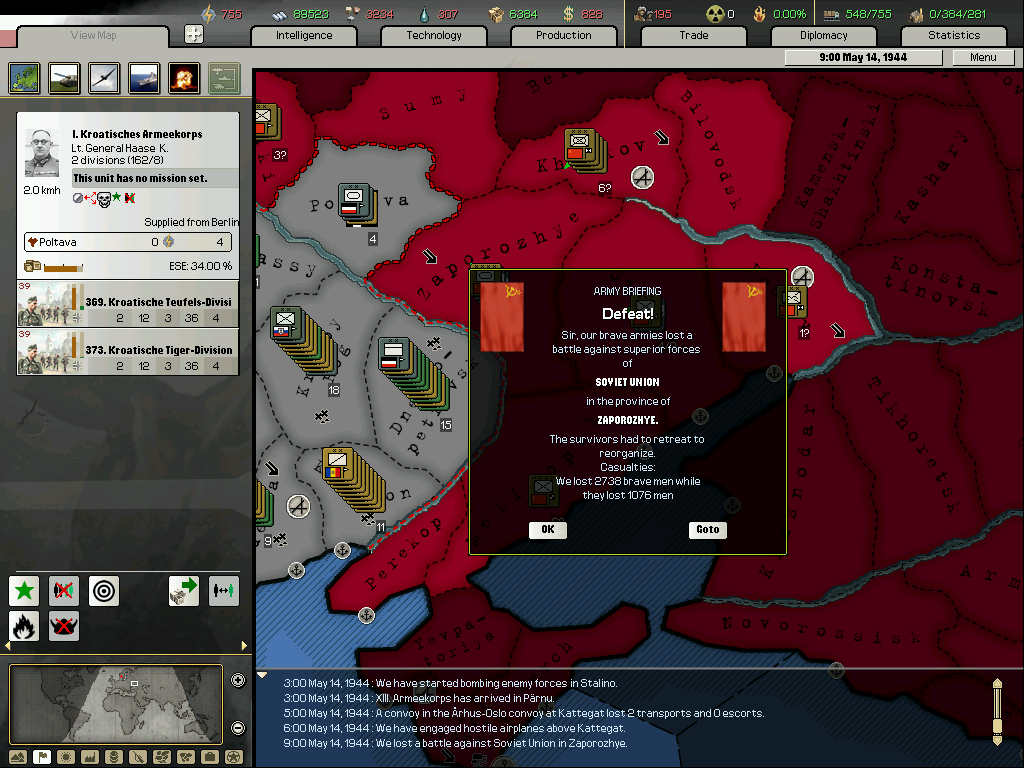
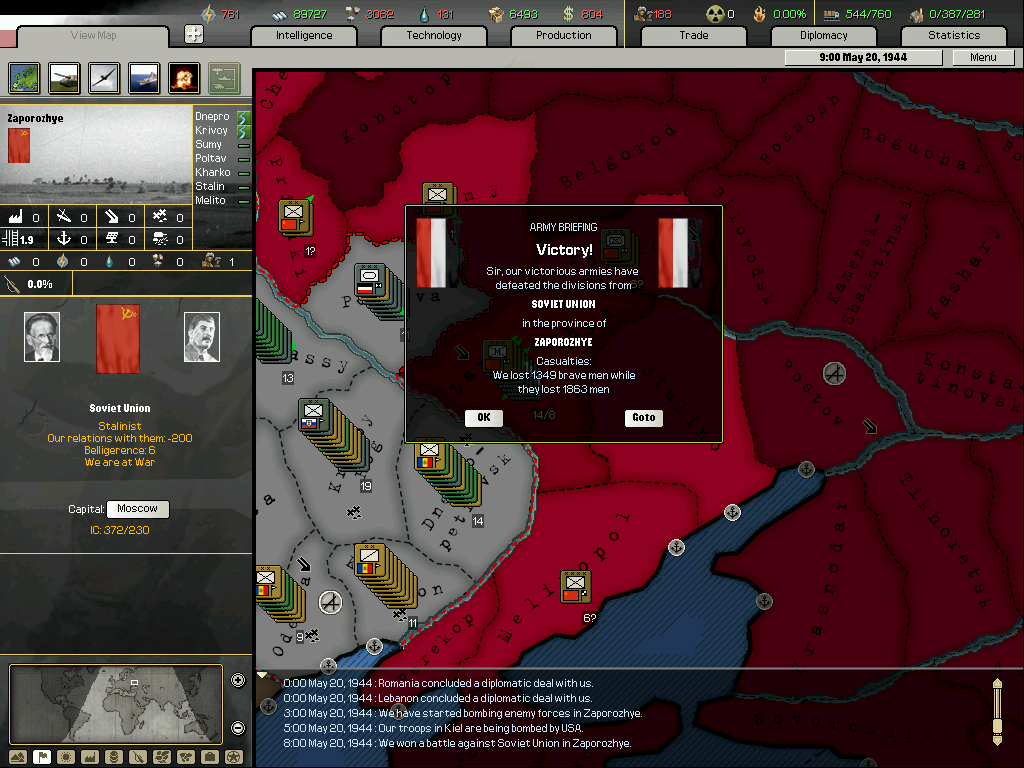
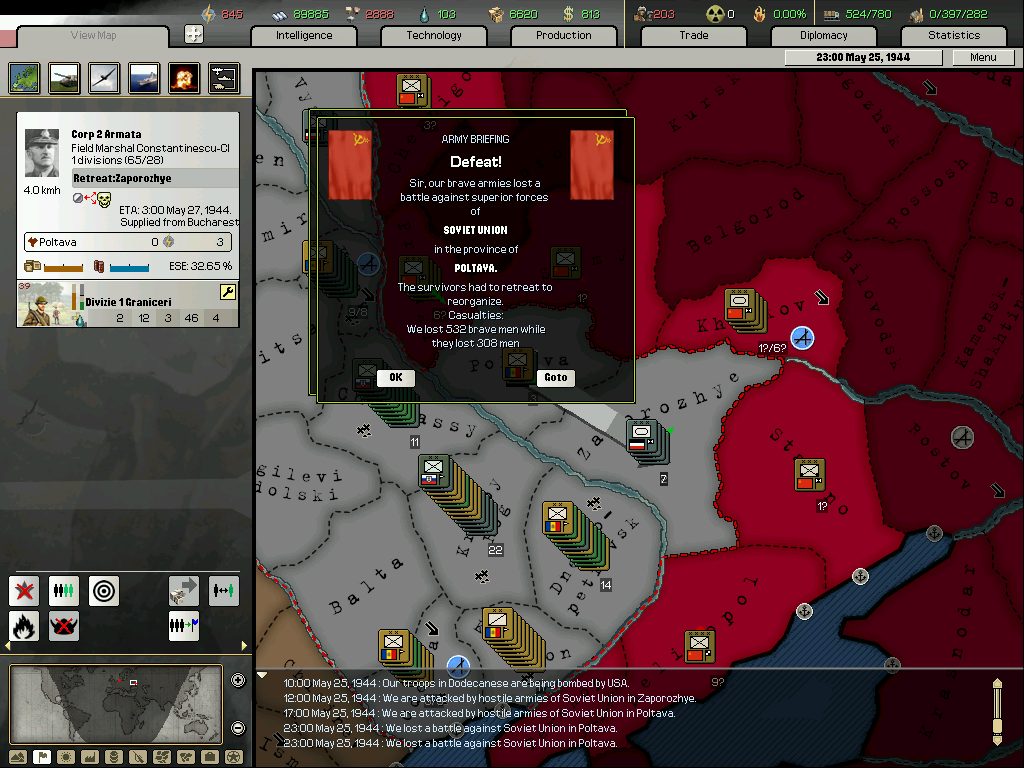
However, the last two battles for Zaporozhye of the month conclusively decided Germany would remain in control of the territory. The Heer will now be able to continue its advance in the south.
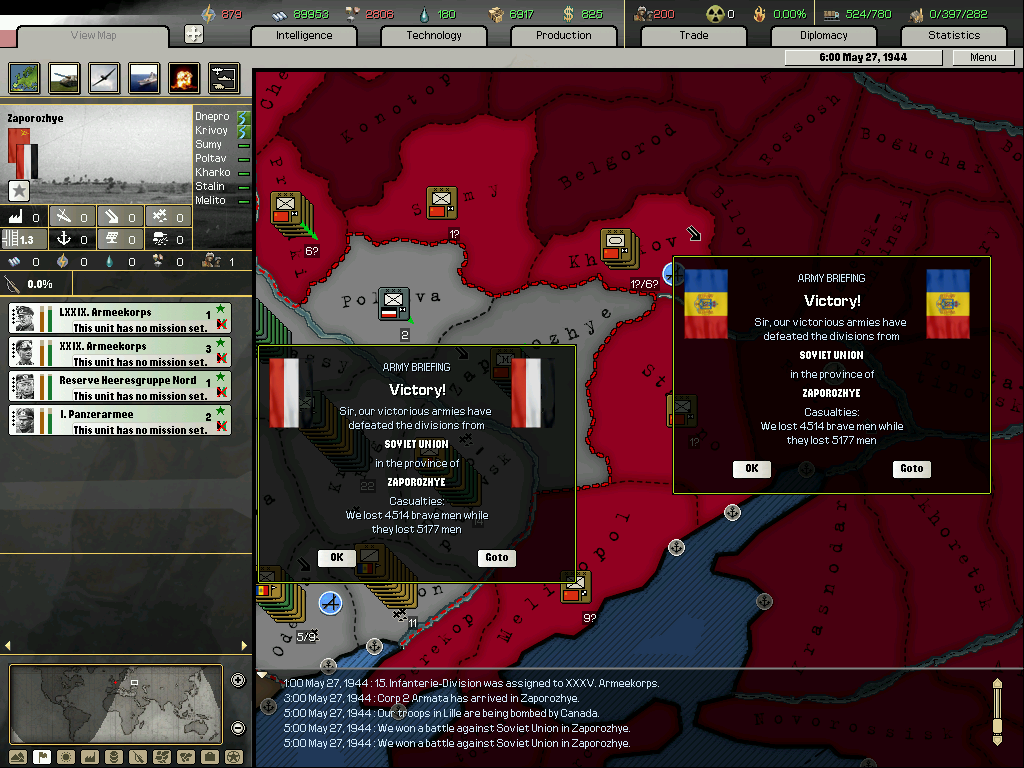
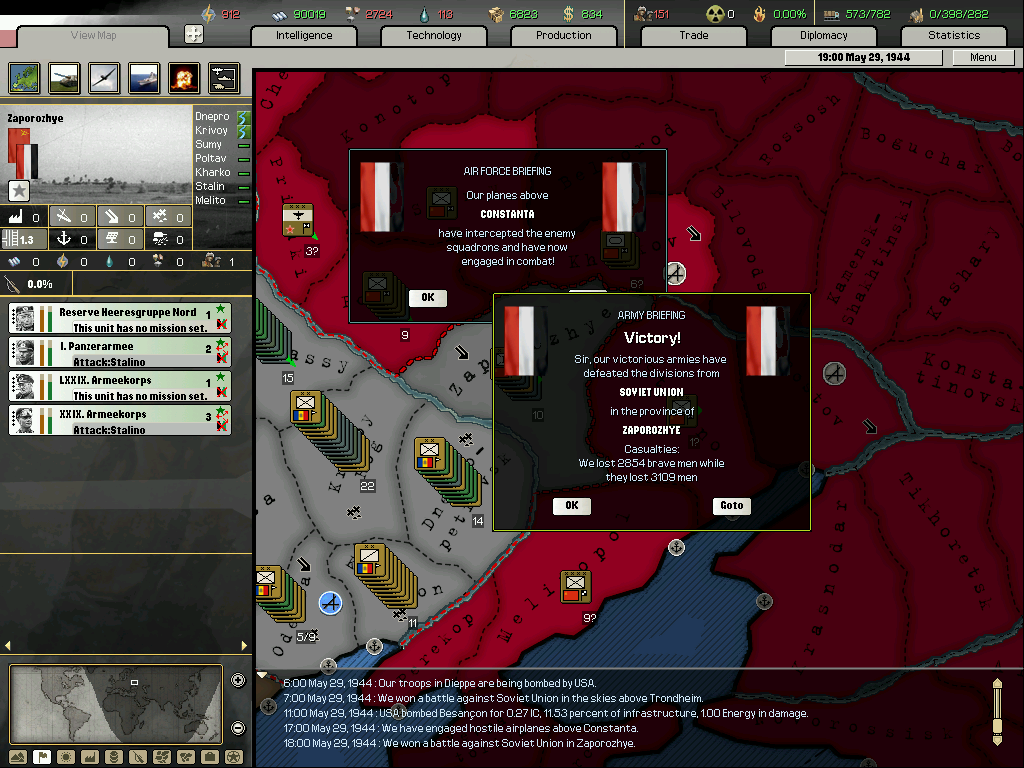
The Red Air Force has clearly not recovered in the slightest since the Luftwaffe arrived on the scene over a year ago, it seems that the Red Air Force is facing near total destruction. German and Vichy bombers have begun bombing Soviet airfields to speed up this annihilation. The Axis bombers also continued to provide a big help with the German offensive.
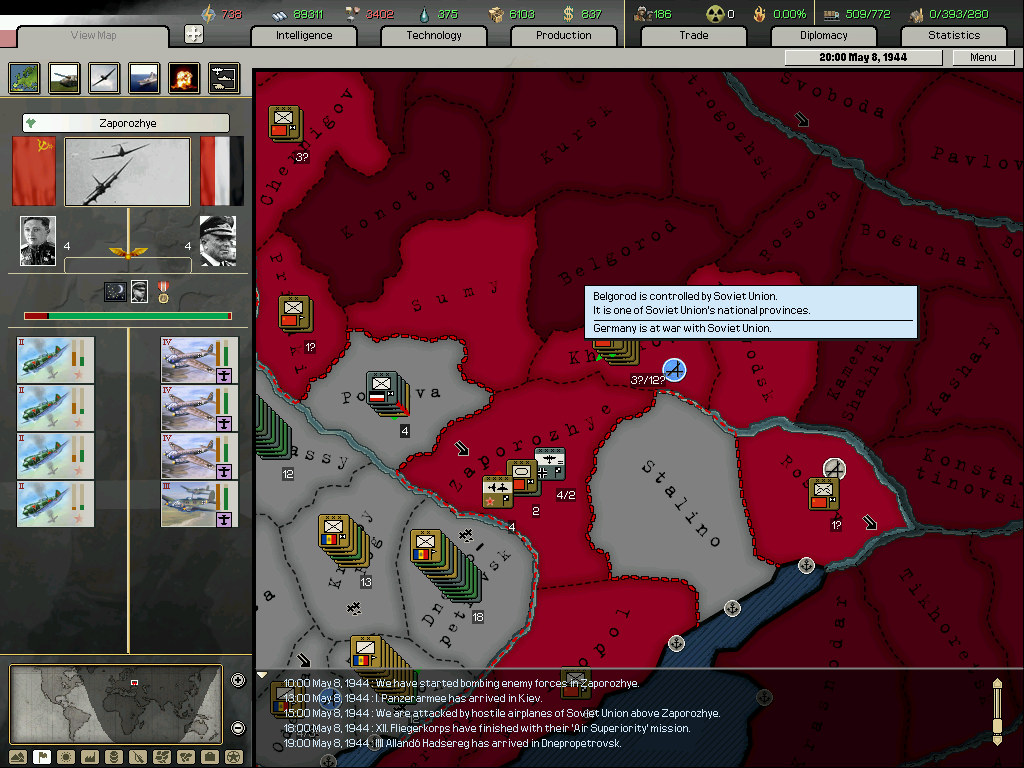
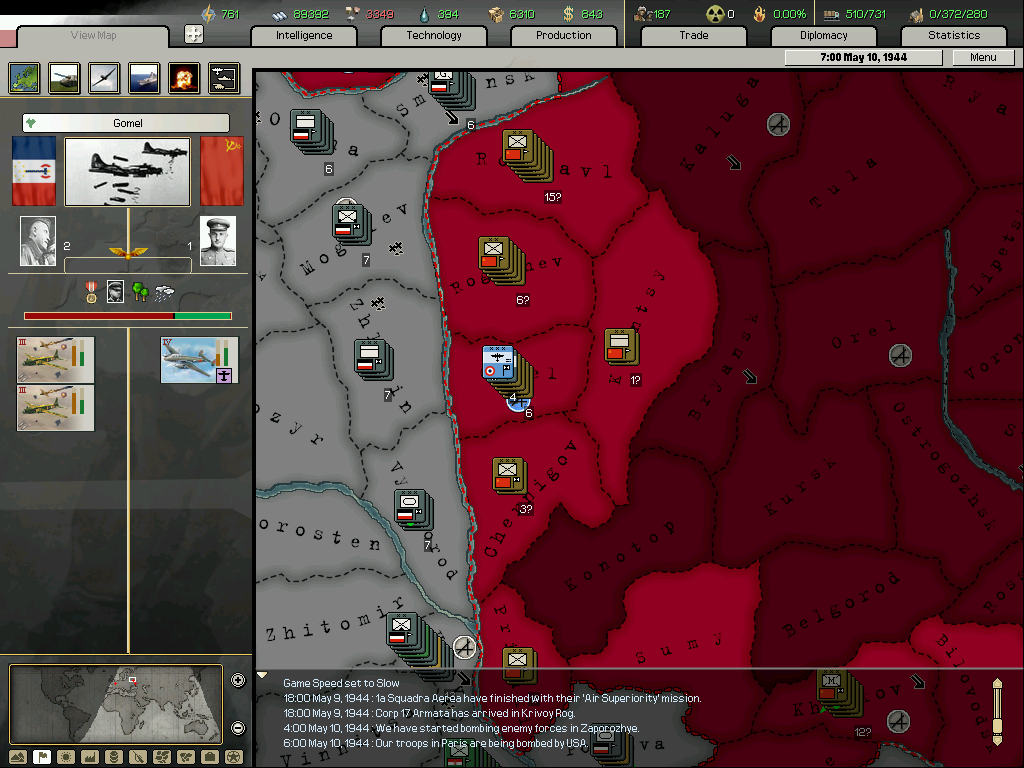
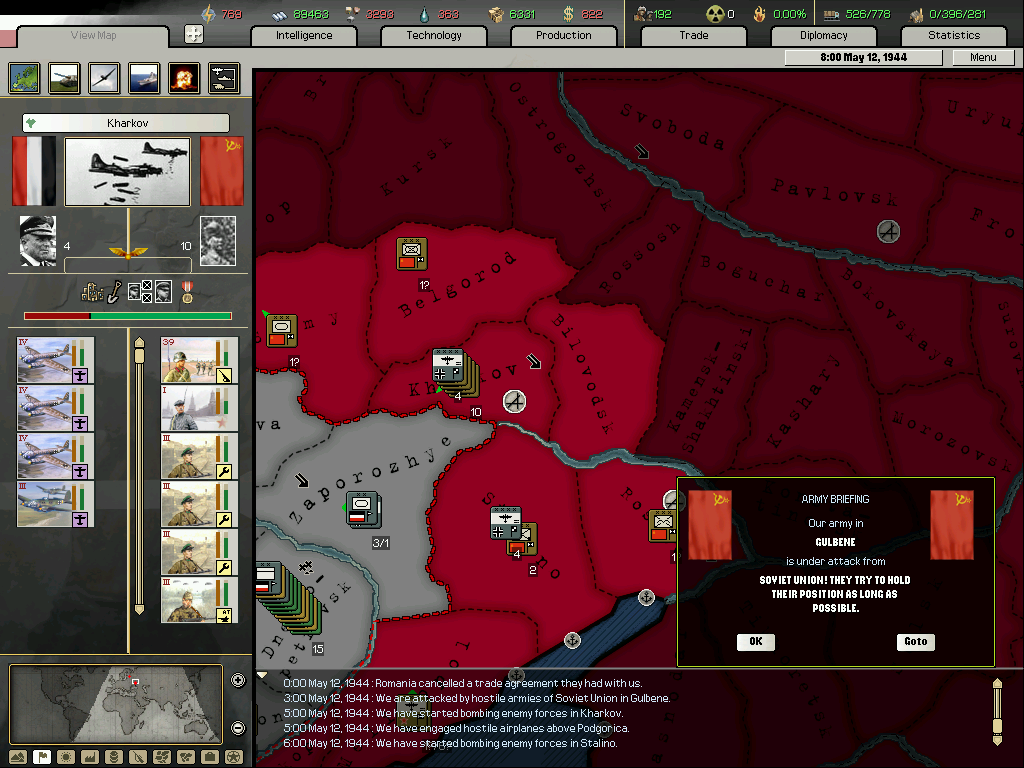
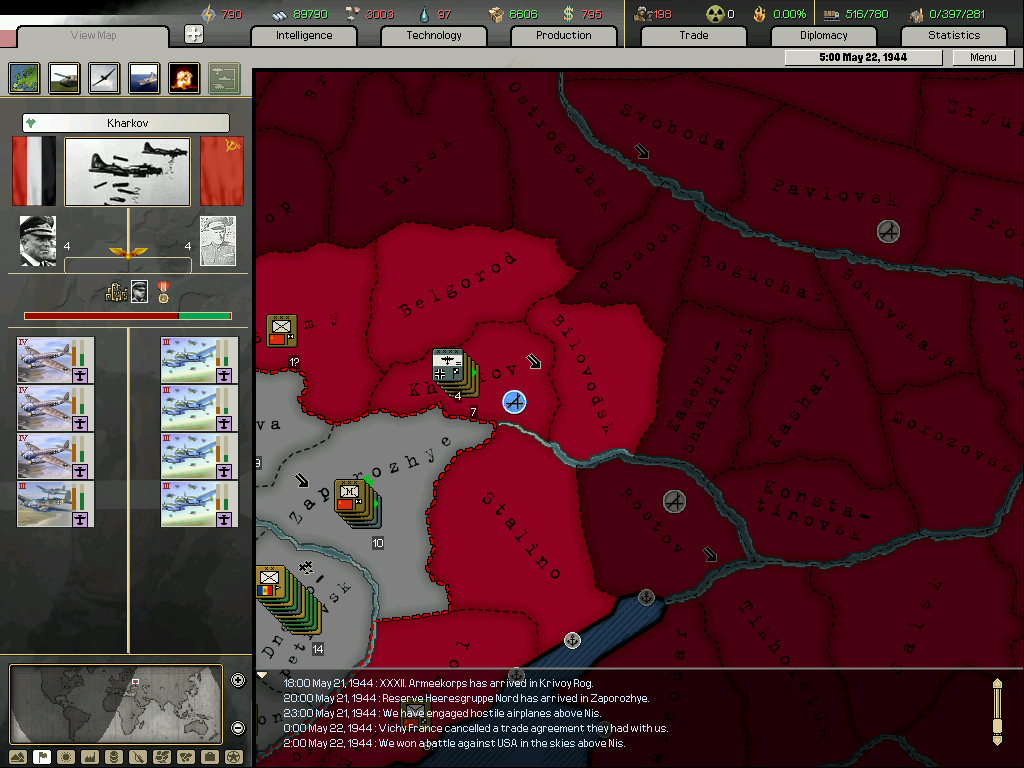
A Soviet bomber squadron was surprisingly seen bombing German forces in Norway, perhaps in the vein hope the Allies would attack the region. This never happened and the Luftwaffe promptly sent units to deal with the threat.
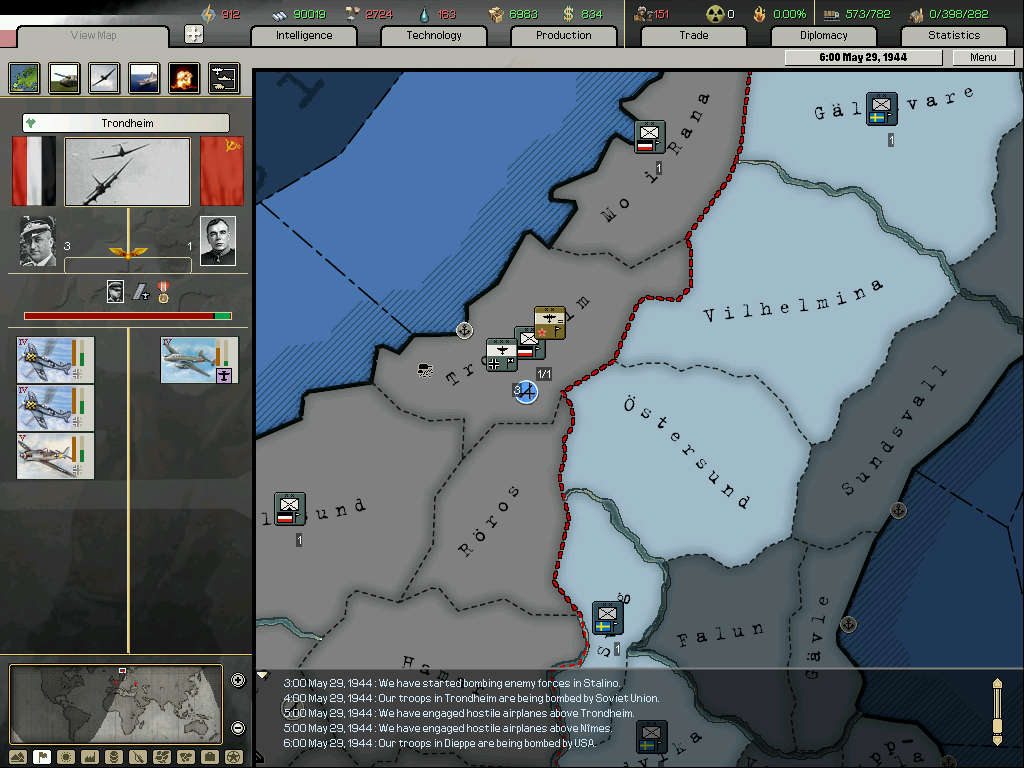
The only strategic defeat this month at the hands of the Soviets was in the north. Gulbene, and all of Estonia, was under-defended in the first place. Once one part of the front fell, the Heer had to retreat all units in the region to Riga to avoid any unnecessary loss of life.
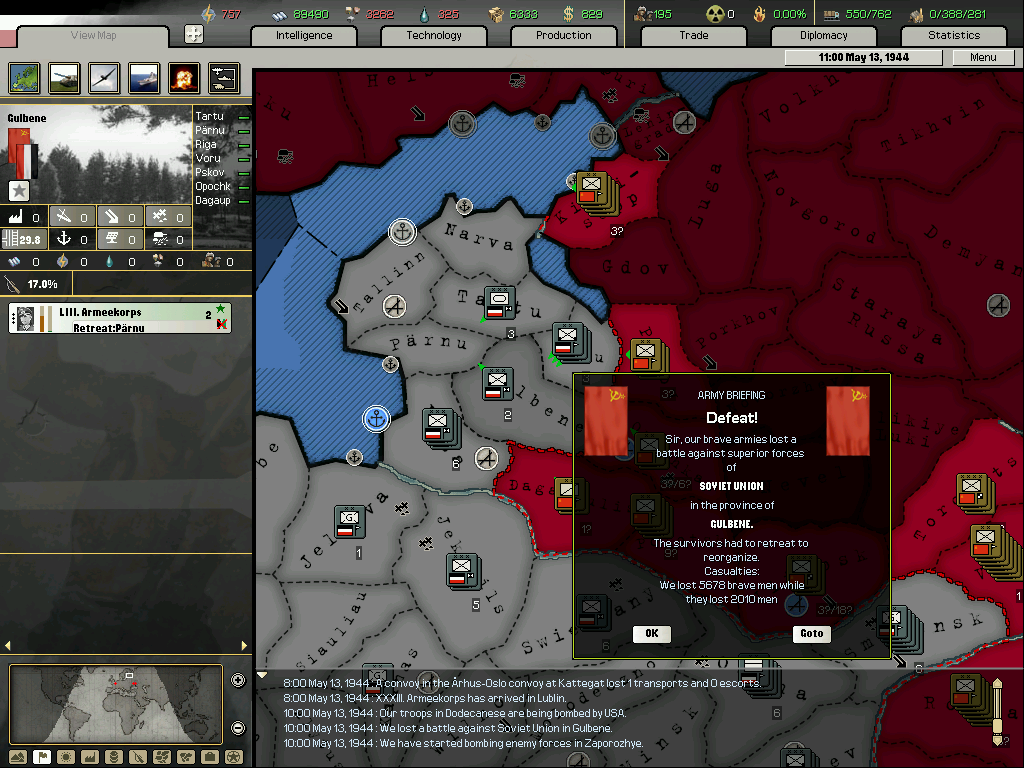
Air war against the Allies
The German Air Force continued to fight off the Allied Air Forces with relative success.
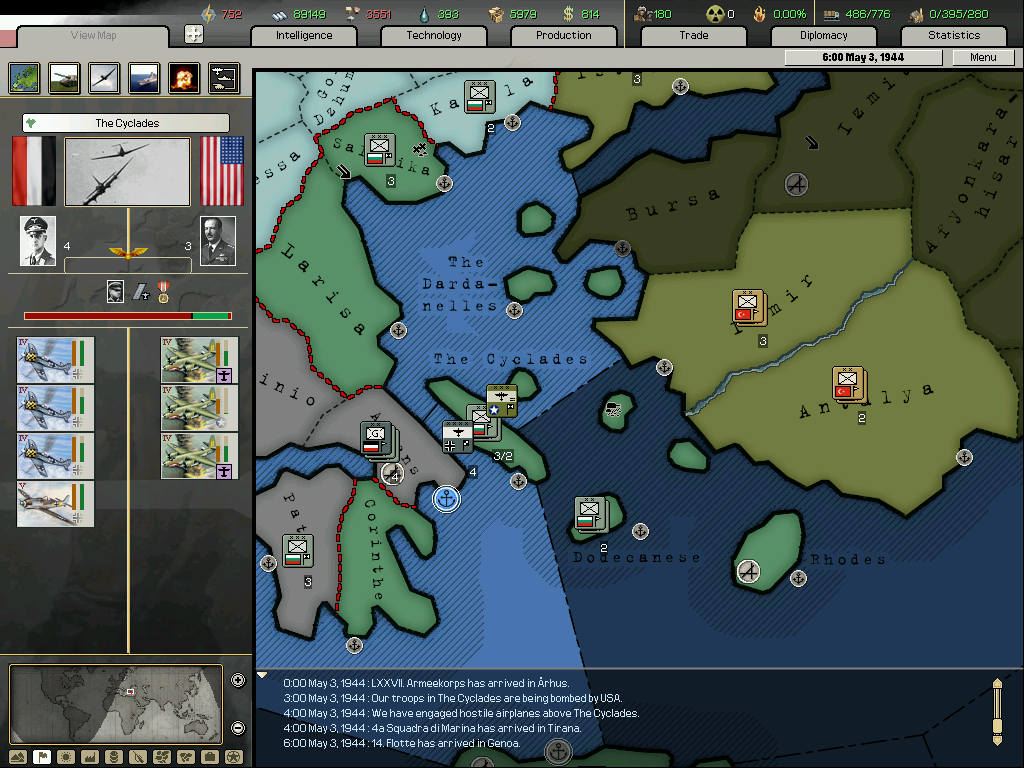
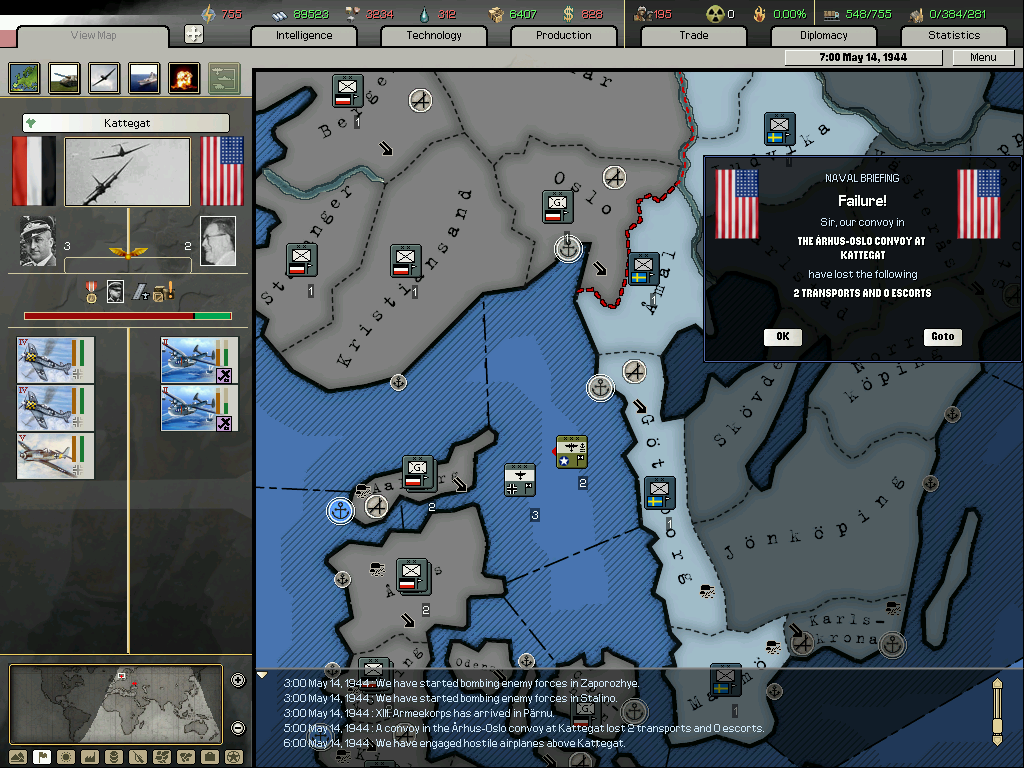
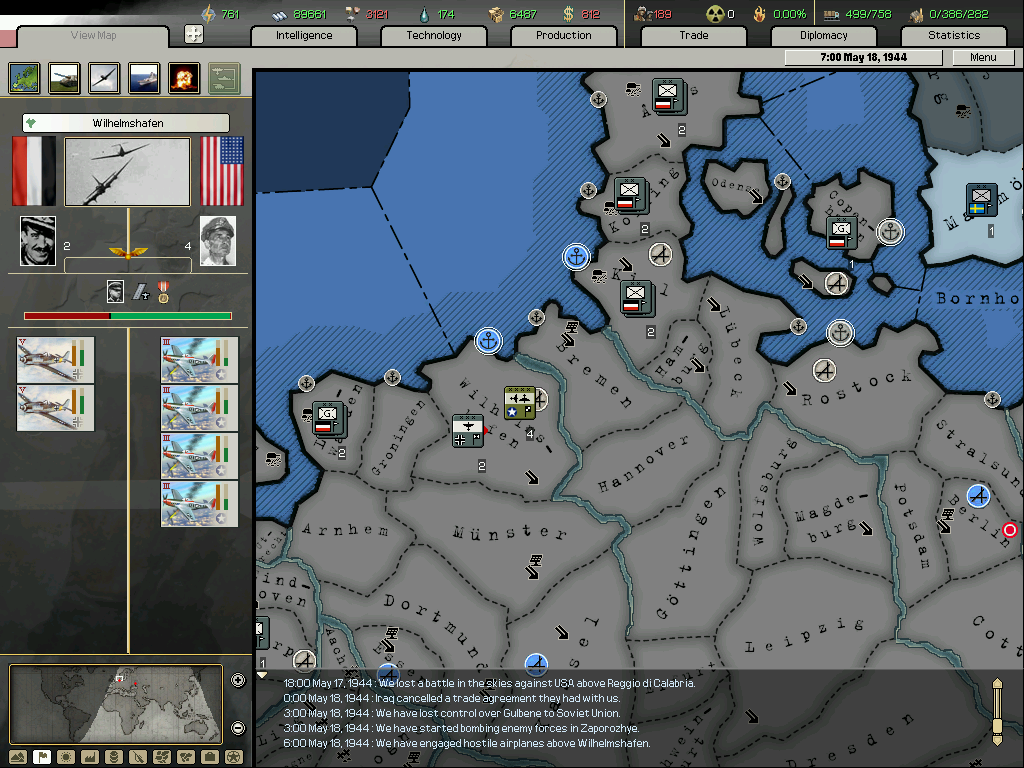
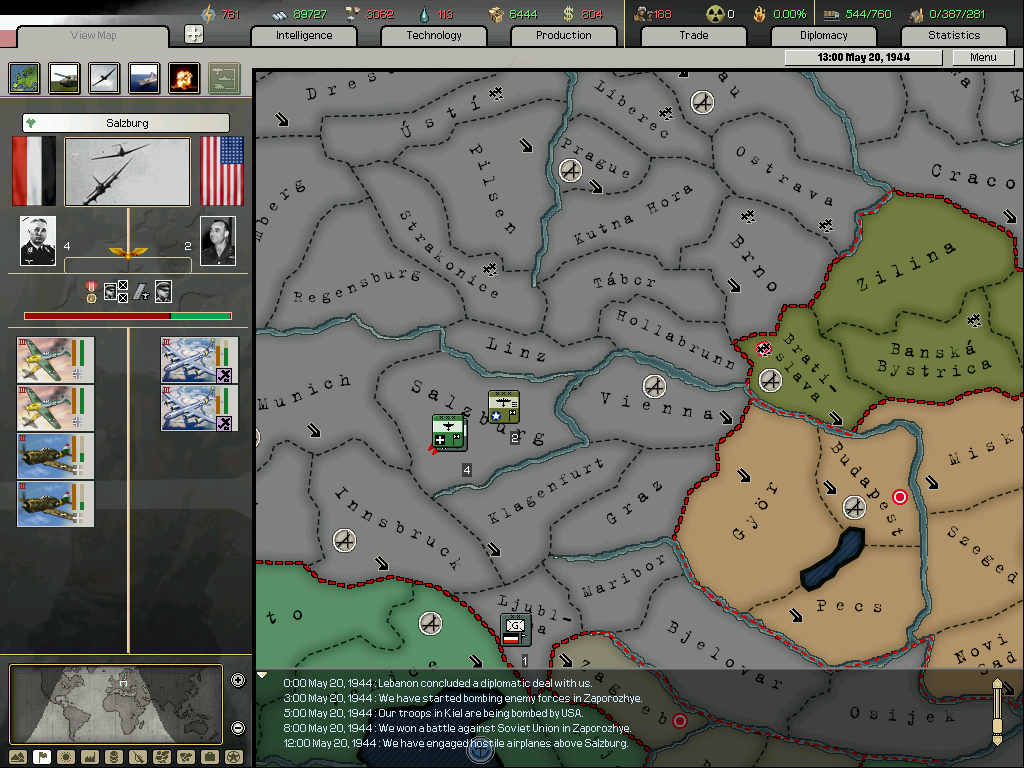
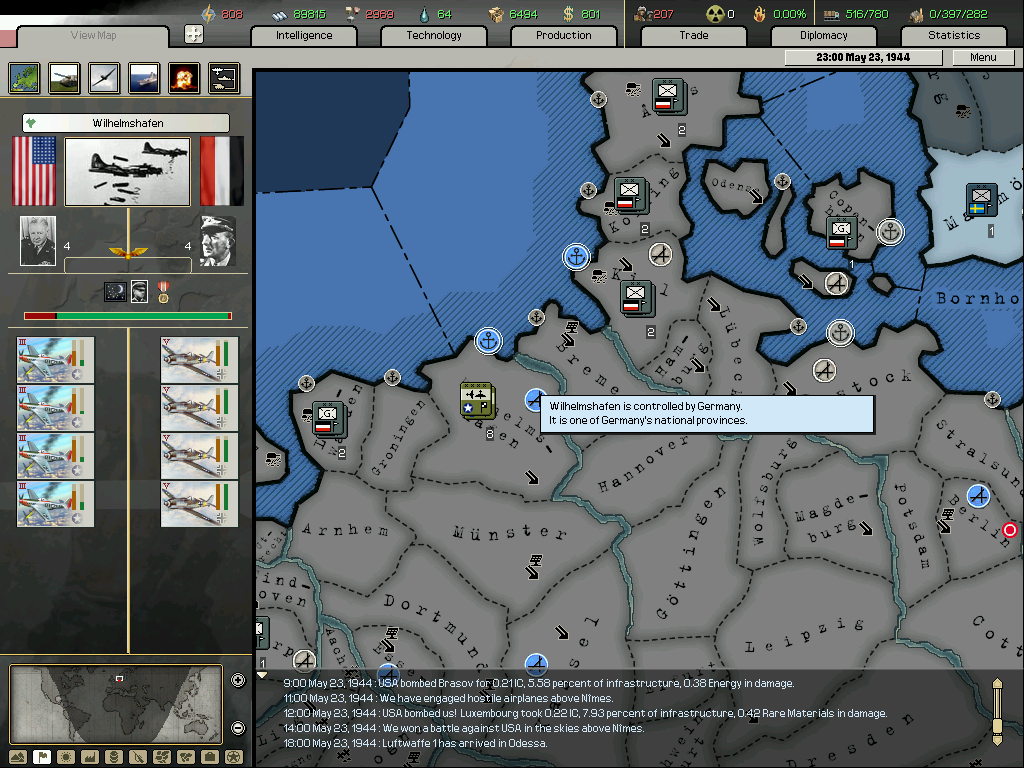
The Romanian Air Force also repulsed American bombers.
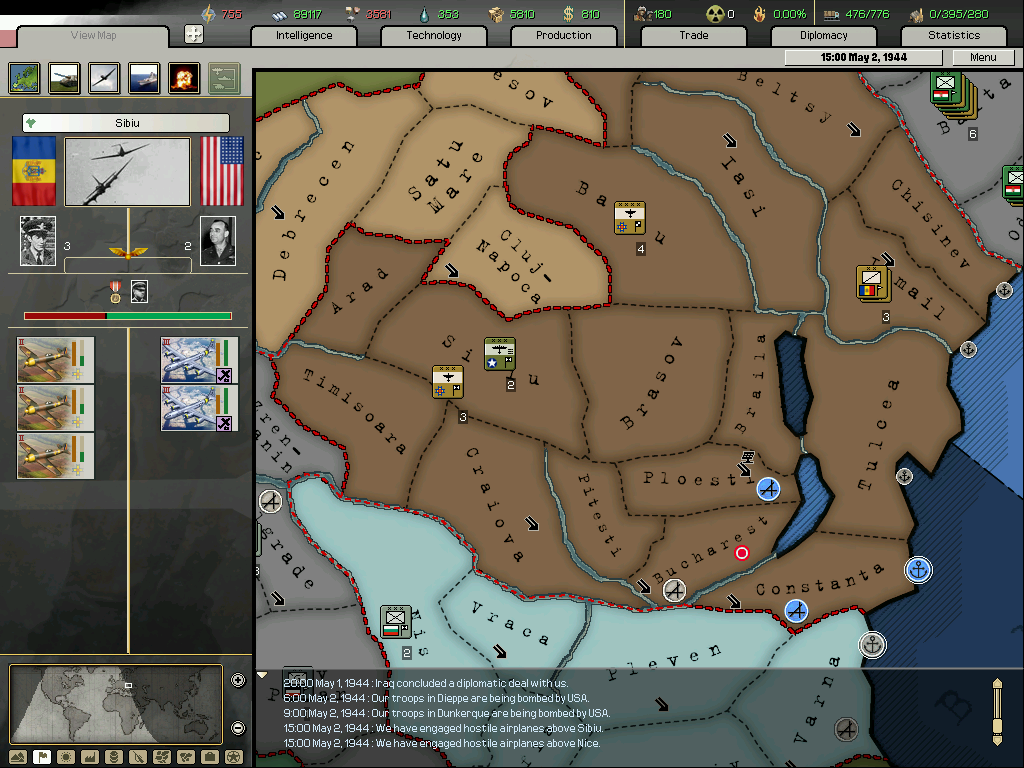
The modern Italian Air Force struggled to fend off American planes in its defence of its homeland and Vichy's.
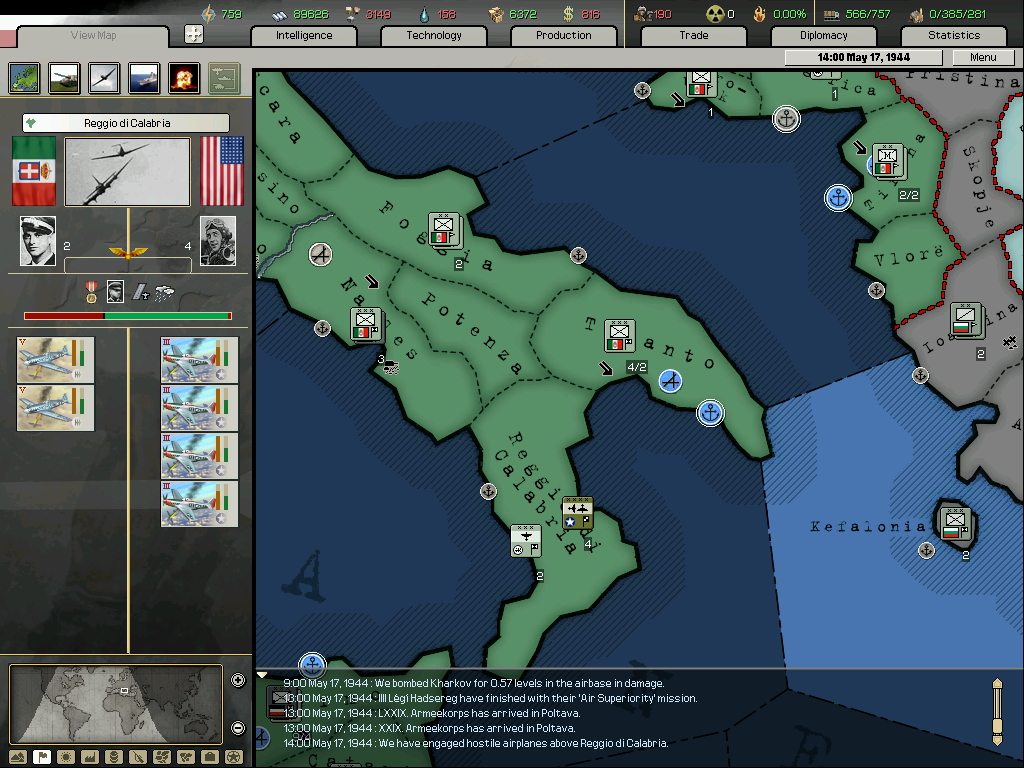
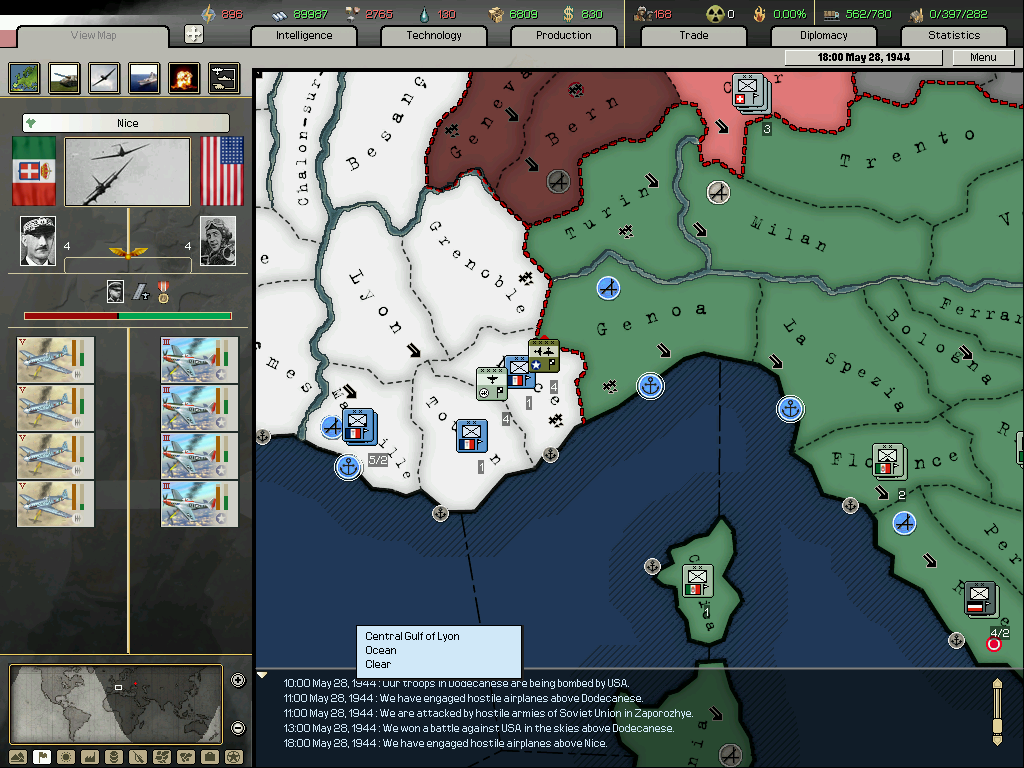
Other events
The US seemed ever closer to developing nuclear weapons, with America's continued efforts with its Manhattan project being public news.
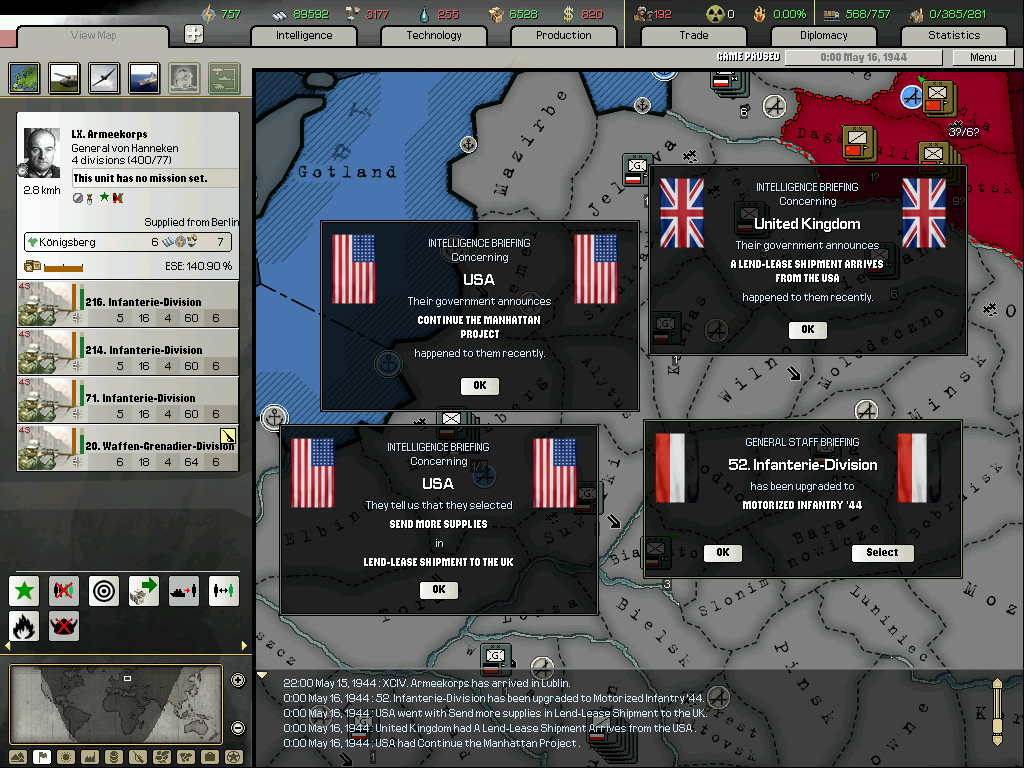
Nationalist China annexed its puppet state Xibei San Ma, showing Japan's advance in the northern part of China. However Japan had lost all of Korea to Australian forces, with it being unknown if US forces had been encircled in the north-western part of Manchkukuo or had retreated to Australian-occupied Korea. American forces had certainly been defeated in Hainan, with Japan eventually re-capturing the coastal province.
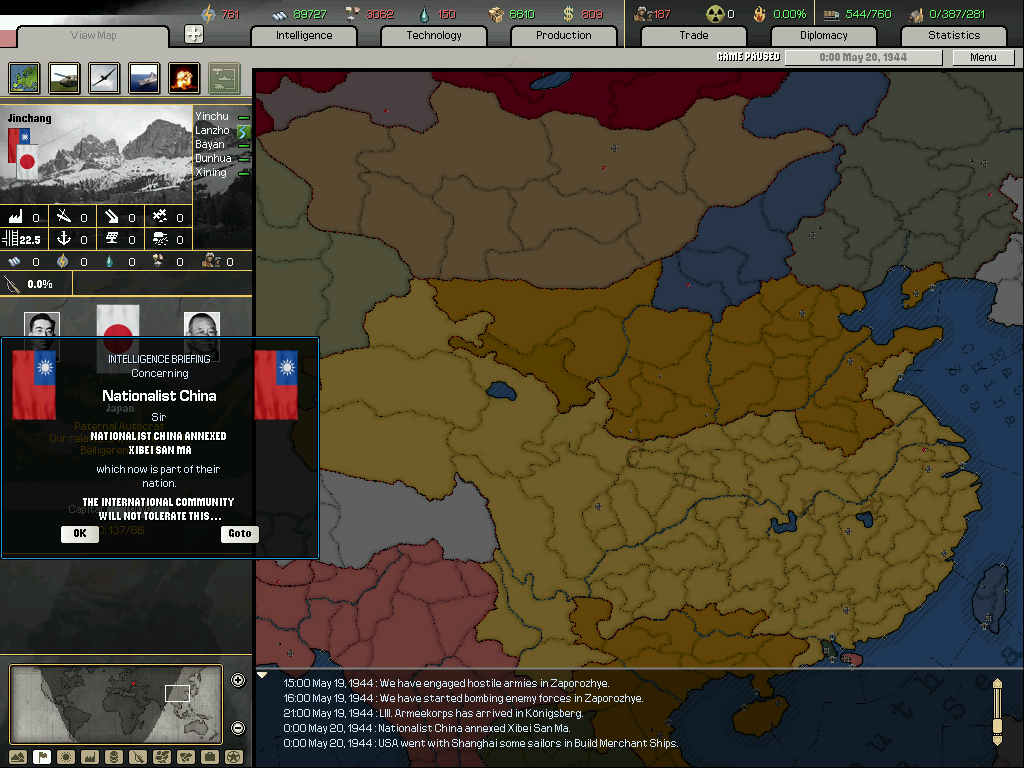
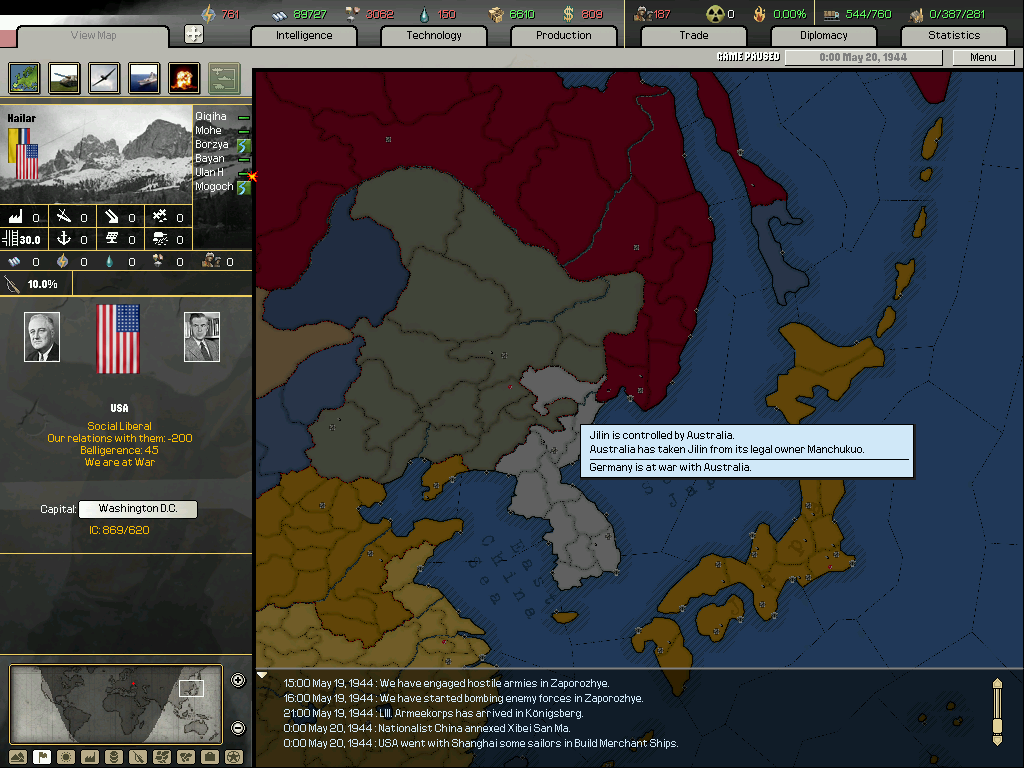
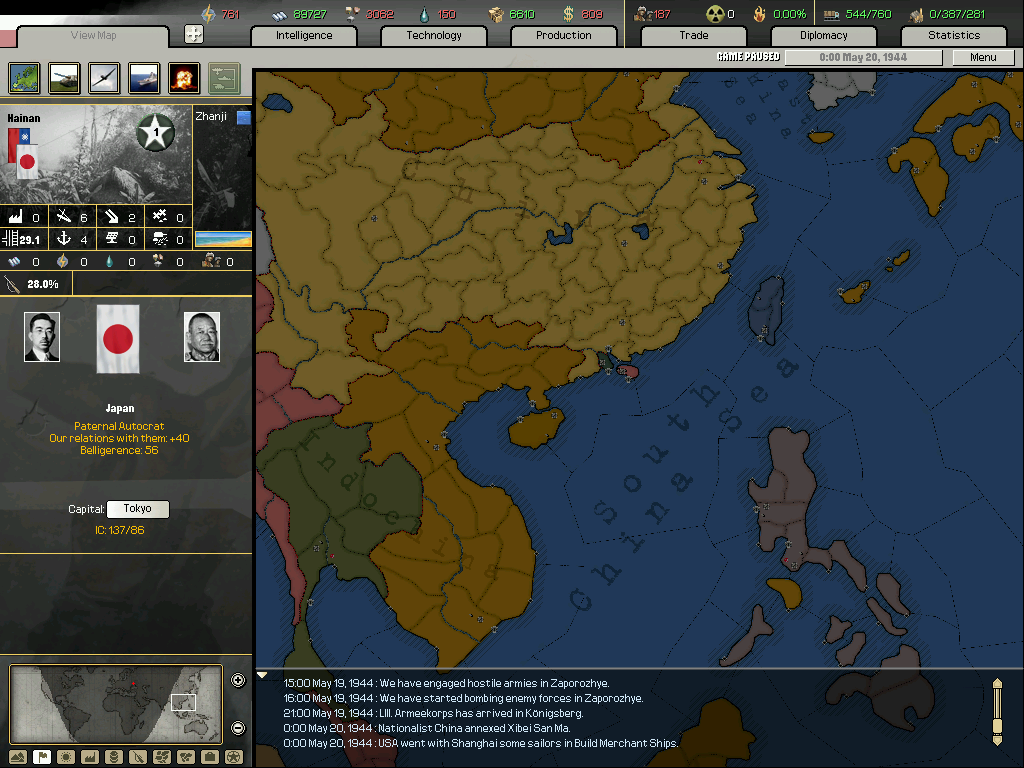
Losses charts


Eastern front
The German army continued its advance. The advance seemed at a logger-head at Zaporozhye, with repeated attacks and counter-attacks on both sides.








However, the last two battles for Zaporozhye of the month conclusively decided Germany would remain in control of the territory. The Heer will now be able to continue its advance in the south.


The Red Air Force has clearly not recovered in the slightest since the Luftwaffe arrived on the scene over a year ago, it seems that the Red Air Force is facing near total destruction. German and Vichy bombers have begun bombing Soviet airfields to speed up this annihilation. The Axis bombers also continued to provide a big help with the German offensive.




A Soviet bomber squadron was surprisingly seen bombing German forces in Norway, perhaps in the vein hope the Allies would attack the region. This never happened and the Luftwaffe promptly sent units to deal with the threat.

The only strategic defeat this month at the hands of the Soviets was in the north. Gulbene, and all of Estonia, was under-defended in the first place. Once one part of the front fell, the Heer had to retreat all units in the region to Riga to avoid any unnecessary loss of life.

Air war against the Allies
The German Air Force continued to fight off the Allied Air Forces with relative success.





The Romanian Air Force also repulsed American bombers.

The modern Italian Air Force struggled to fend off American planes in its defence of its homeland and Vichy's.


Other events
The US seemed ever closer to developing nuclear weapons, with America's continued efforts with its Manhattan project being public news.

Nationalist China annexed its puppet state Xibei San Ma, showing Japan's advance in the northern part of China. However Japan had lost all of Korea to Australian forces, with it being unknown if US forces had been encircled in the north-western part of Manchkukuo or had retreated to Australian-occupied Korea. American forces had certainly been defeated in Hainan, with Japan eventually re-capturing the coastal province.



June 1944
Eastern front
The offensive in the south is continued, with Rostov being encircled. While this only destroyed 2 Soviet divisions, there is a clear lack of reserve units in the area as the Heer is able to storm ahead to Baku. This has caused exhalation amongst the German leadership as Germany's oil reserve is becoming worryingly depleted. It is hoped the capture of Baku will resolve Germany's oil demands.
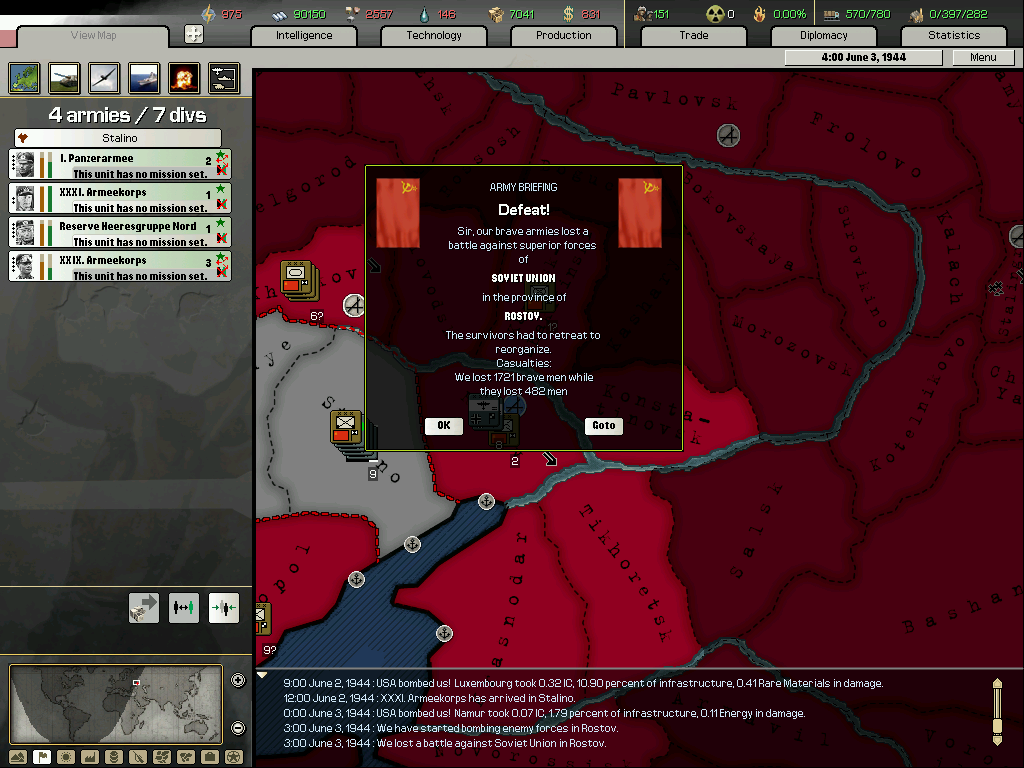

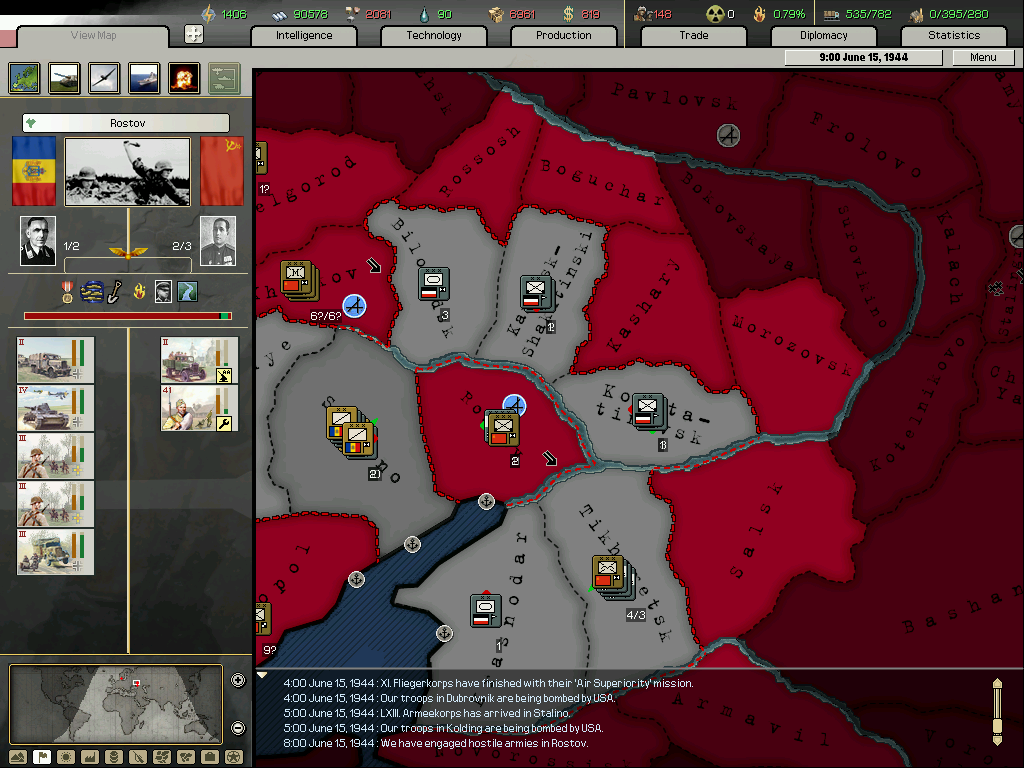
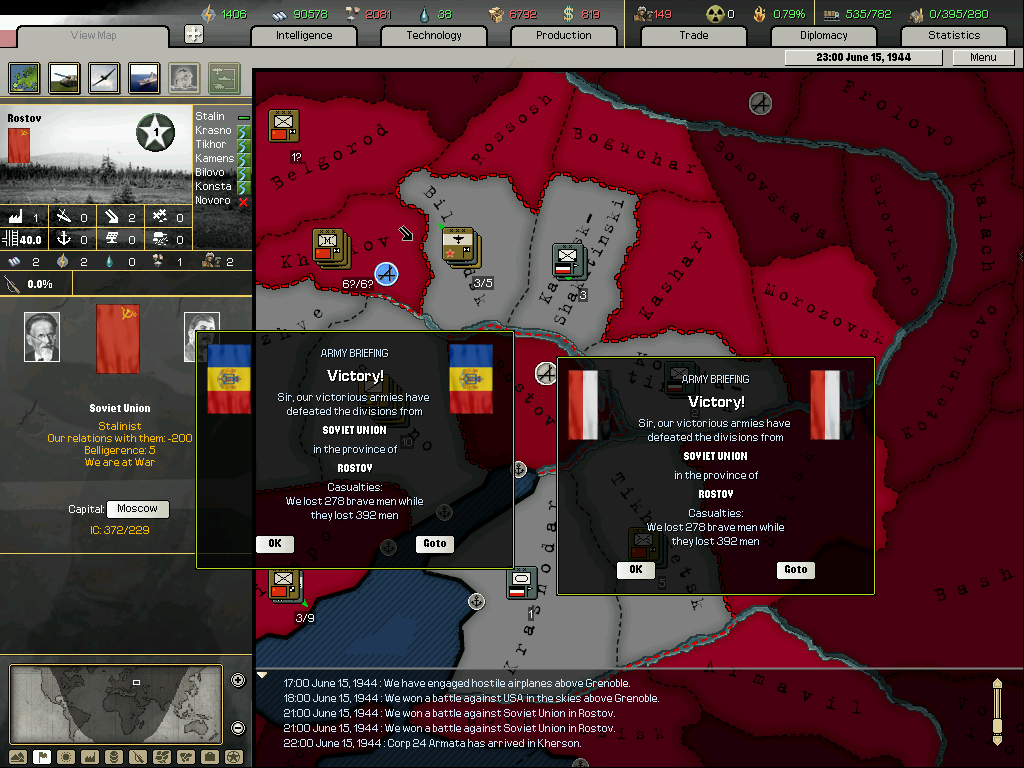
Once the two Soviet units in Rostov were destroyed, the German and Romanian armies could continue their advance towards the oil rich region of the Caucasus. The German armoured and motorised forces led the way, with several divisions from the northern and central parts of the front being sent south to help this advance and to ensure the territories can be held. Rommel was disgruntled with the order to remain in Rostov to ensure German flanks are secure, but he was certainly kept busy by counter-attacks from the Red Army.
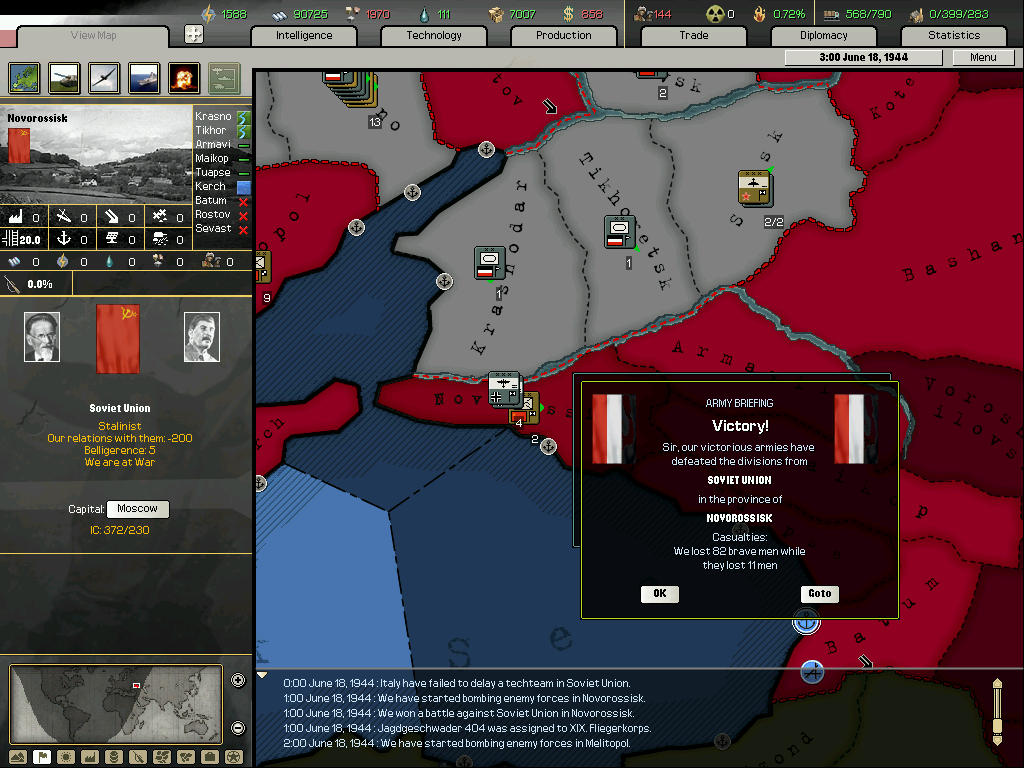
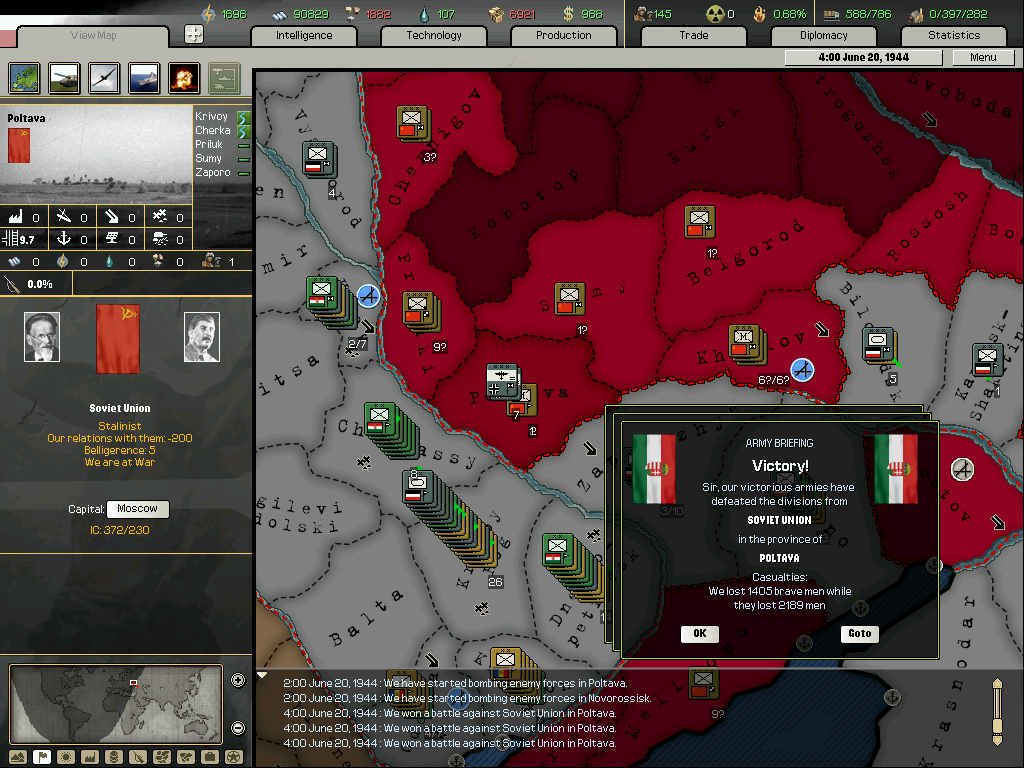

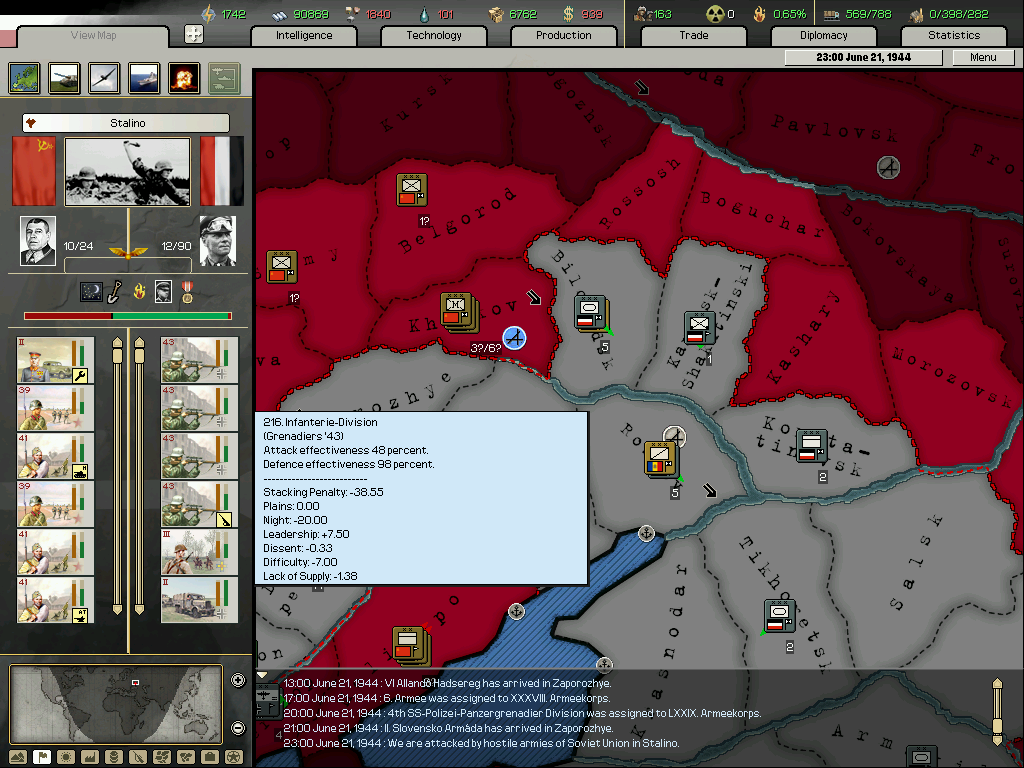
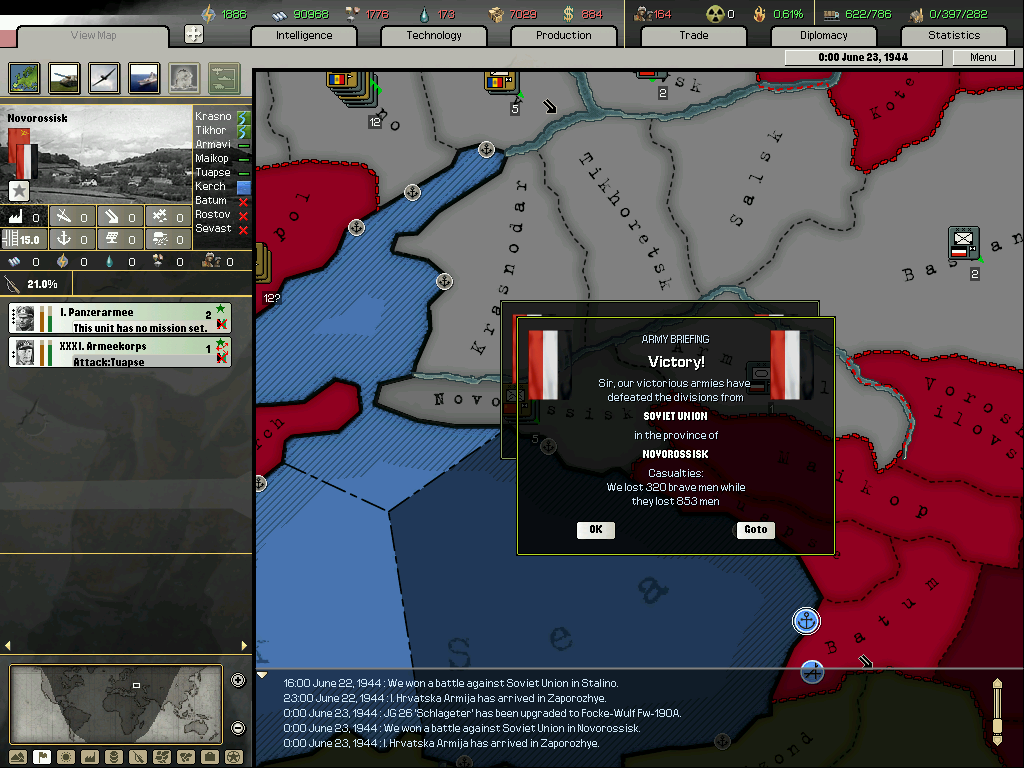
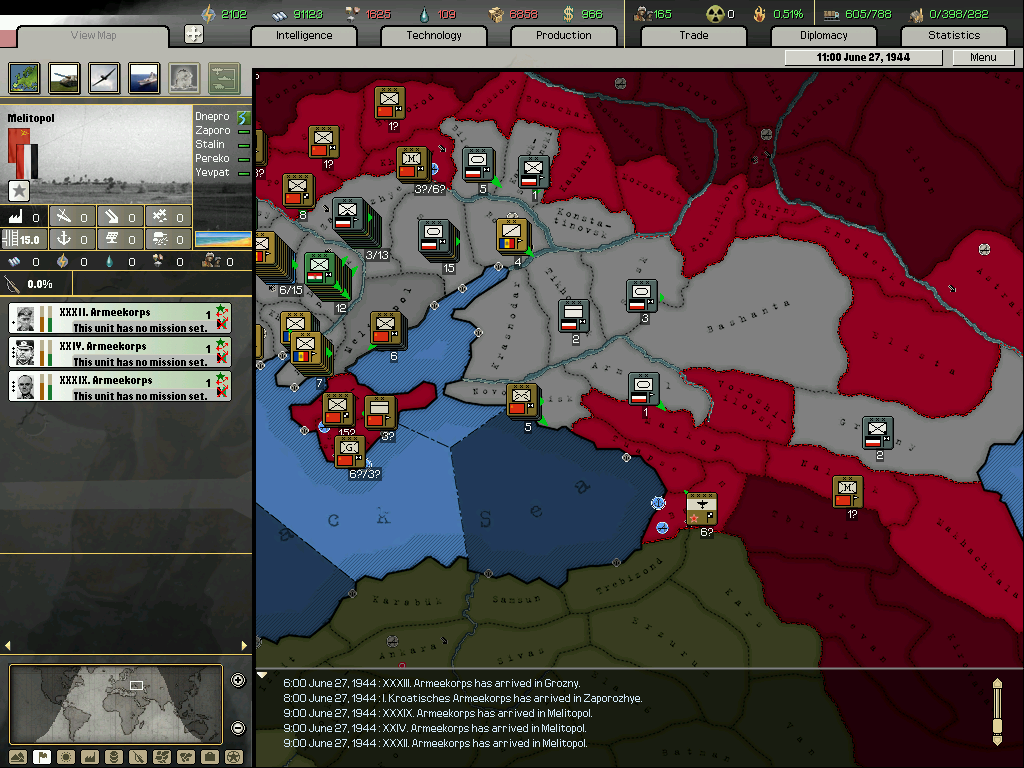
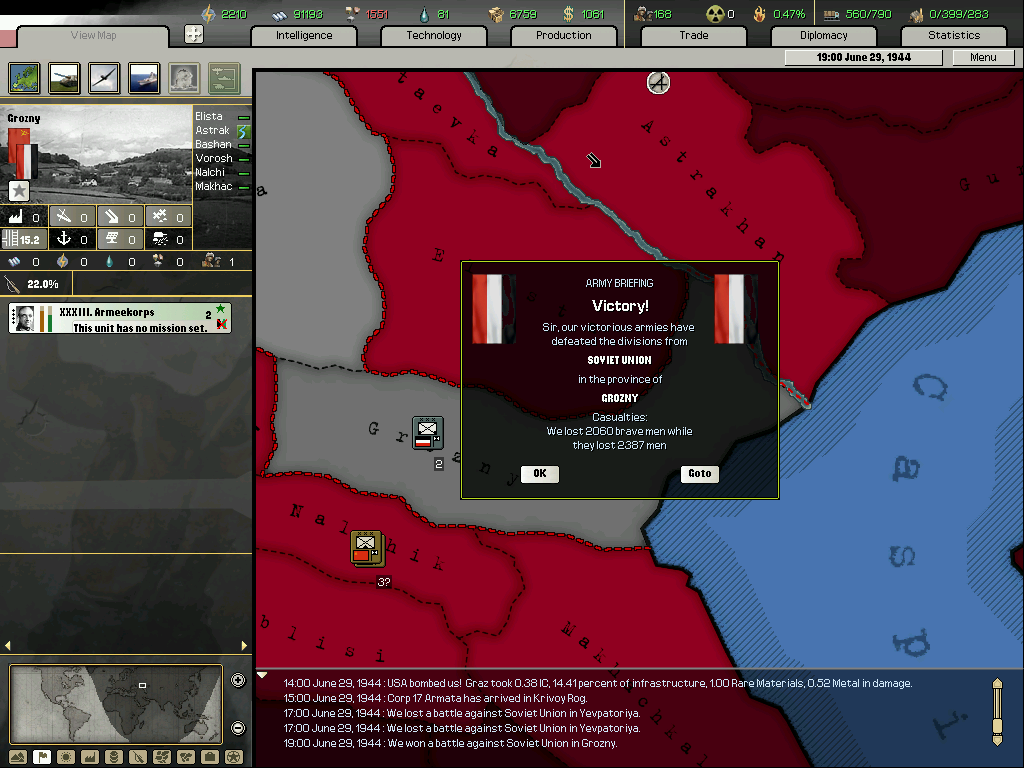
It is now hoped that the Crimea will now fall to Germany, with armoured units estimated to arrive in Batum at 1pm on 1st July. Which will completely cut off Soviet troops in the Crimea from supplies. A quick siege is hoped, the Luftwaffe will ensure the Red Air Force cannot air supply these units as was the case in Leningrad.
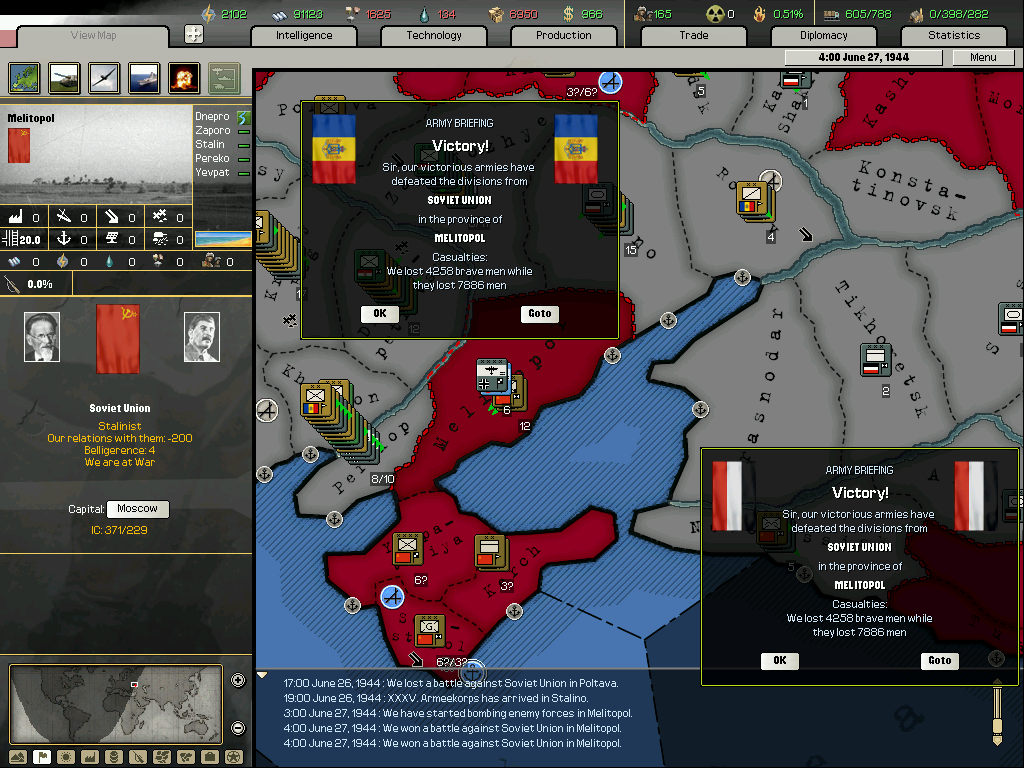
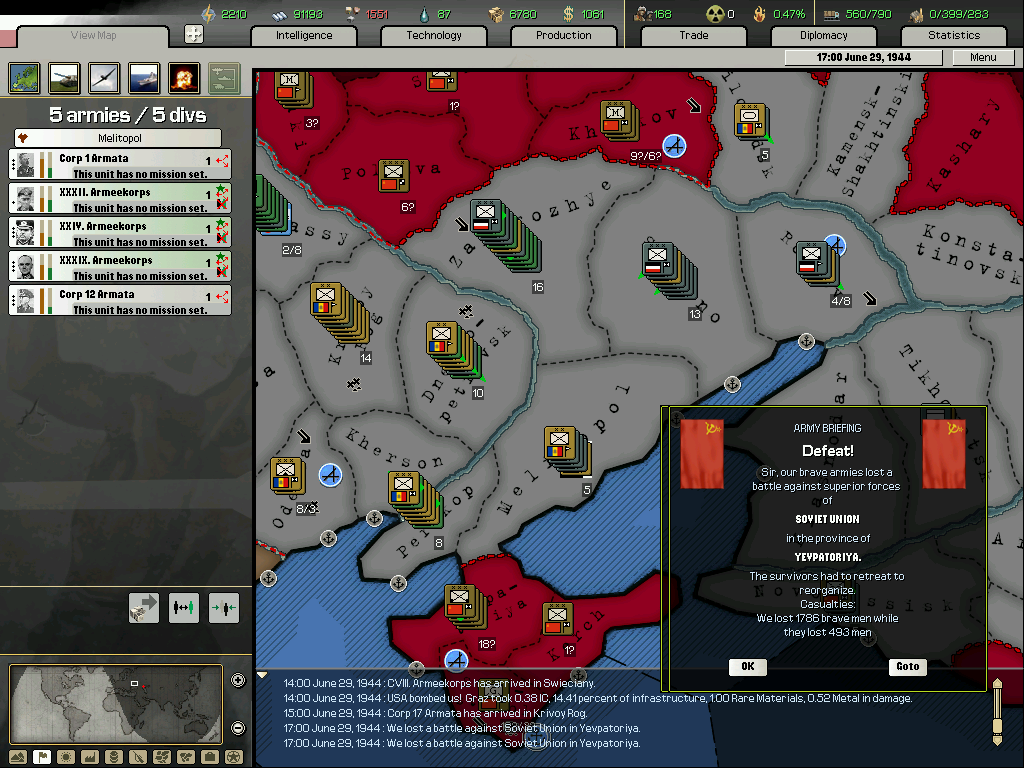
The German Air Force has remained on the offensive against the continually depleted and understrength Red Air Force.
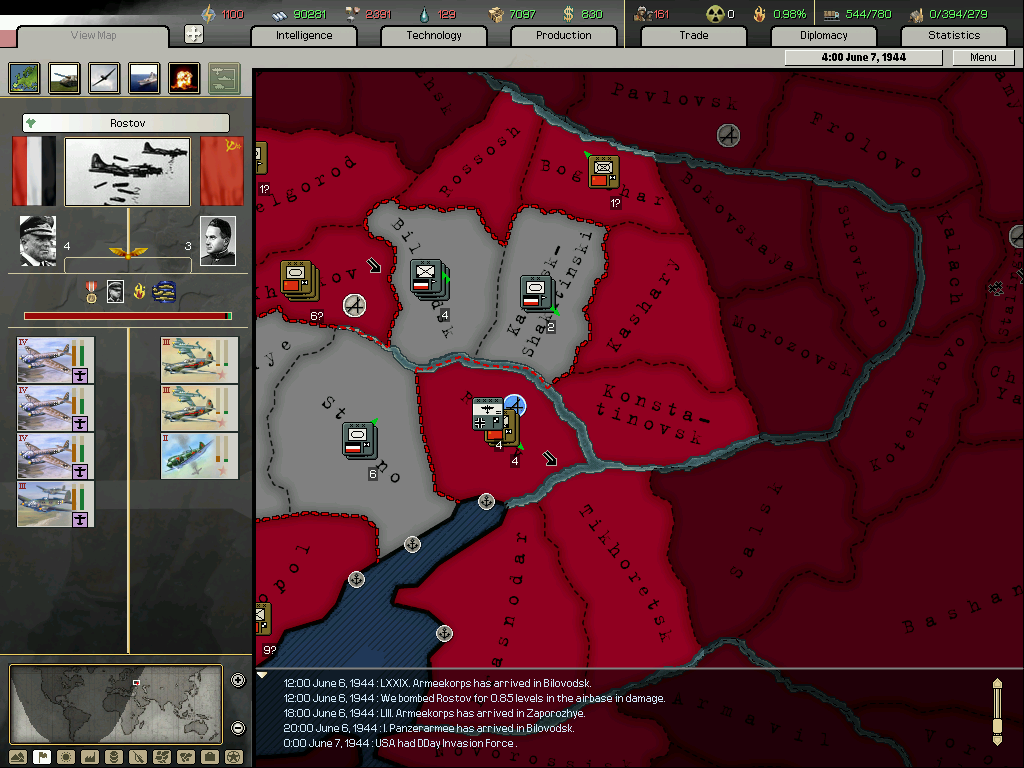

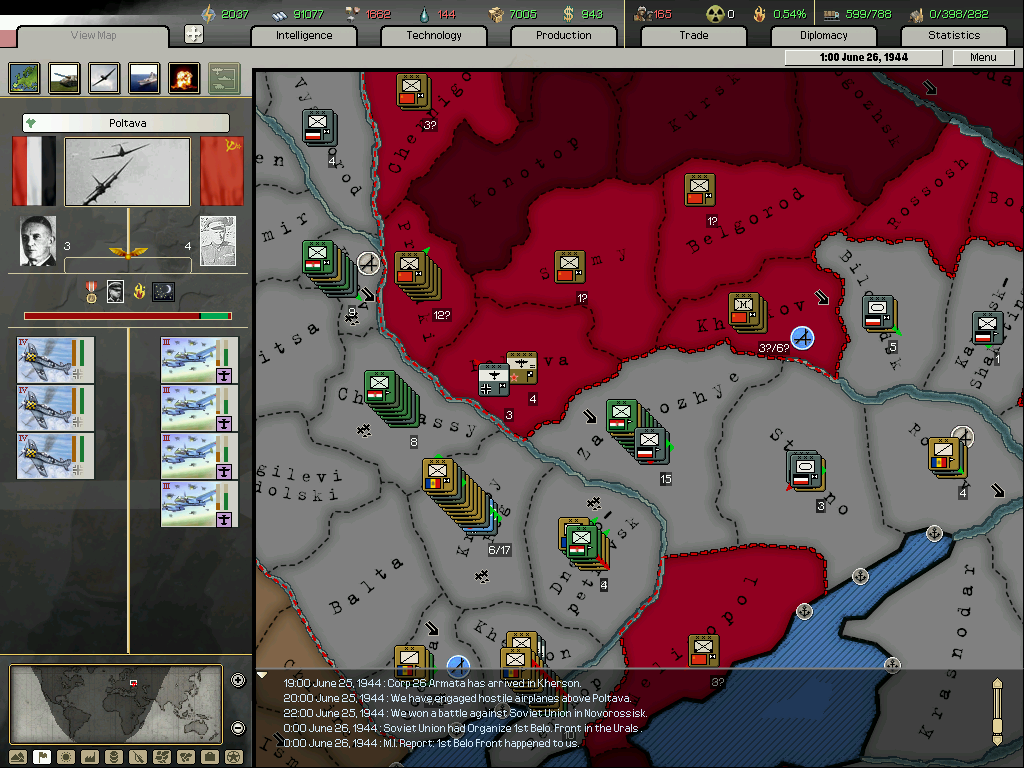

Air war against the Allies
The US Air Force launched strong offensives against German air units in Wilhelmshafen and Essen, with the Luftwaffe being upto this challenge. However 1 German interceptor unit was completely destroyed, with the remaining 2 wings being re-based to Berlin in order to be reinforced. Somehow there were several air battles over Wilhelmshafen at the same time, perhaps due to the fast speed of the air planes responding in different parts of the territory.
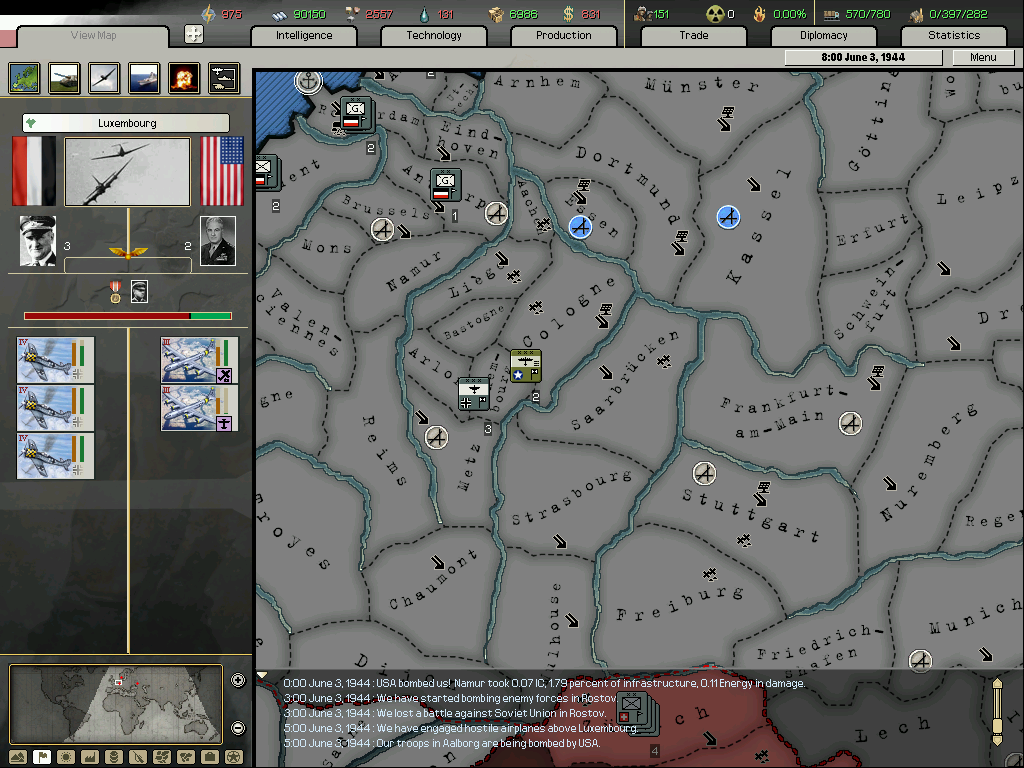
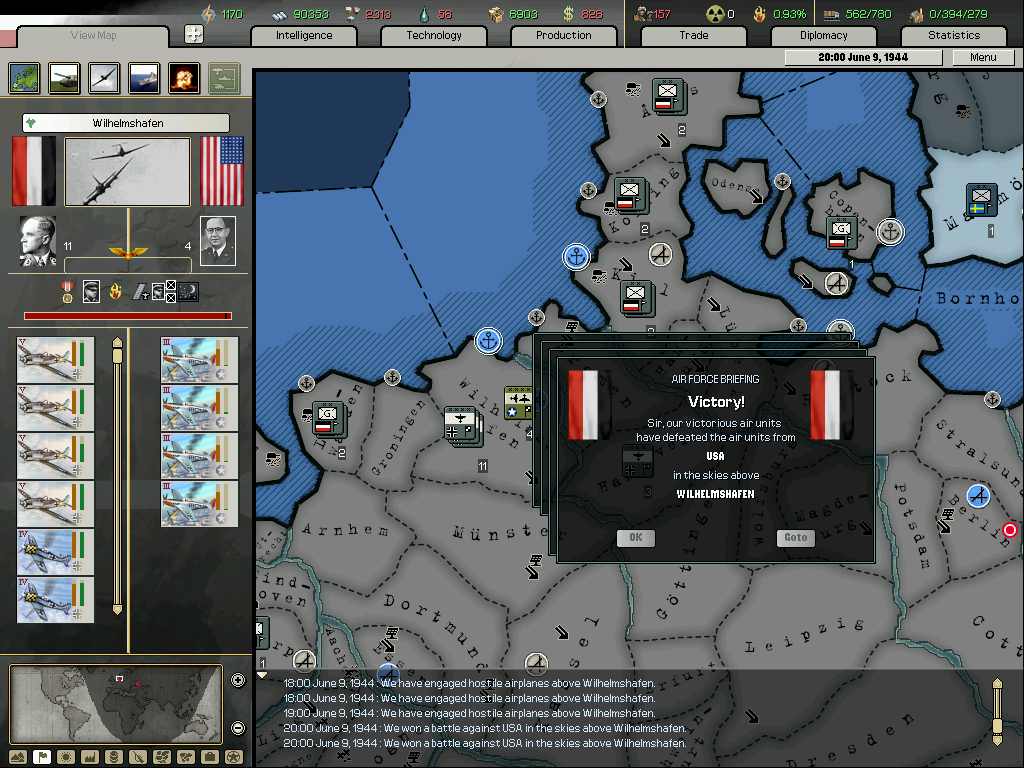
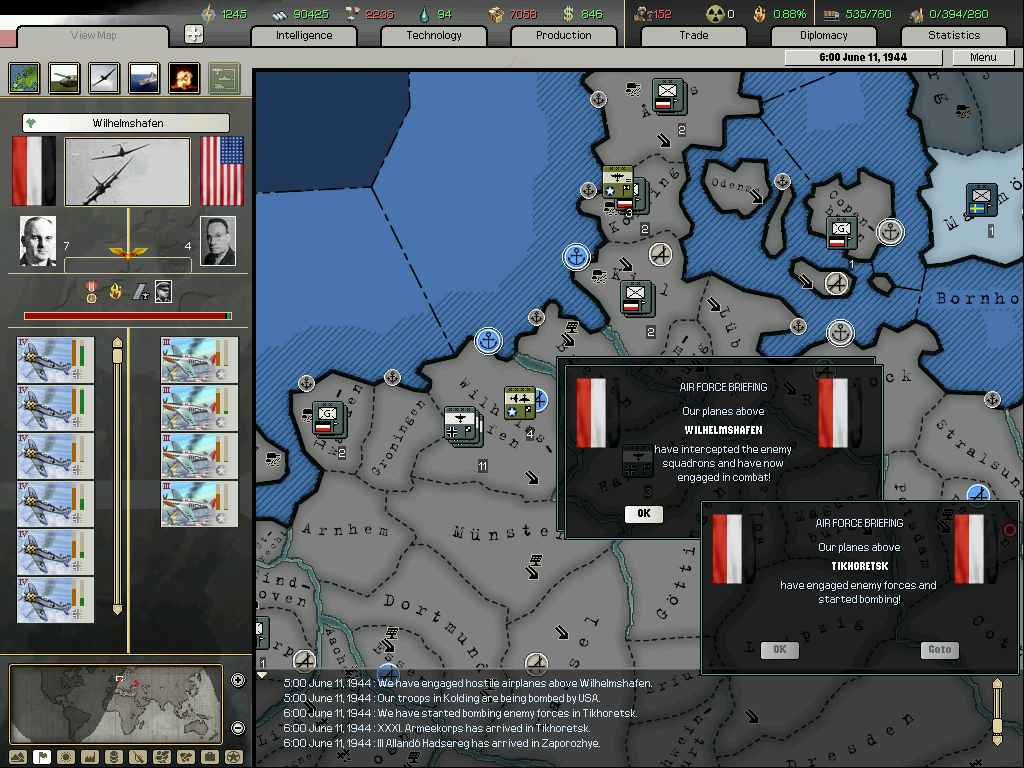

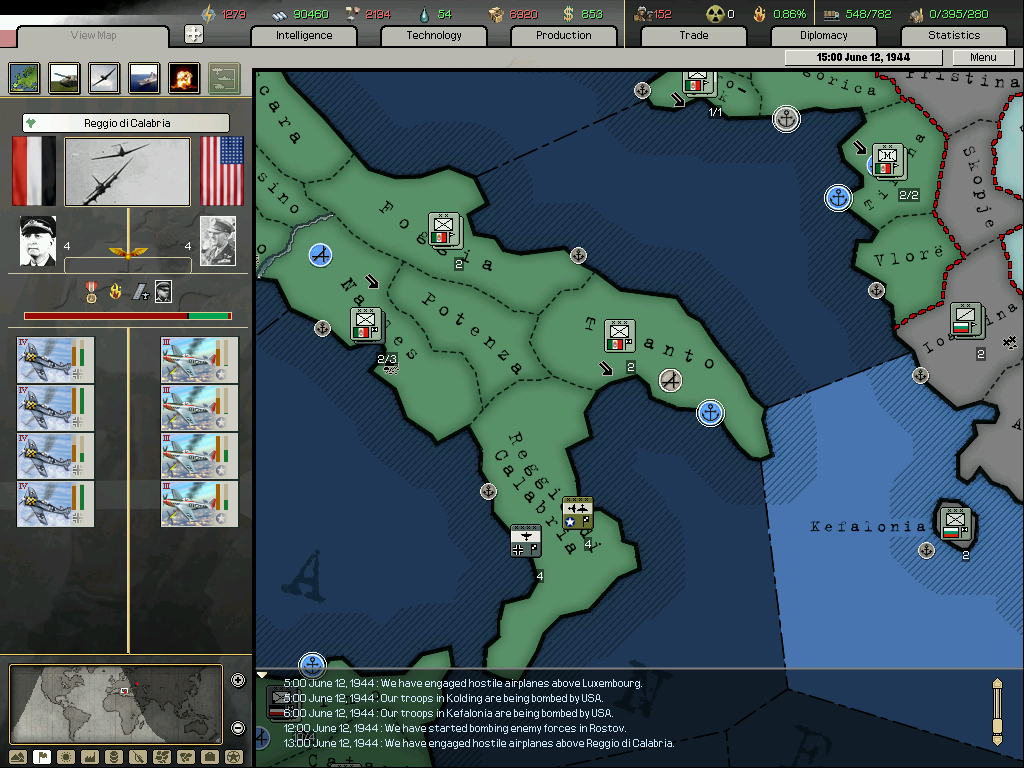

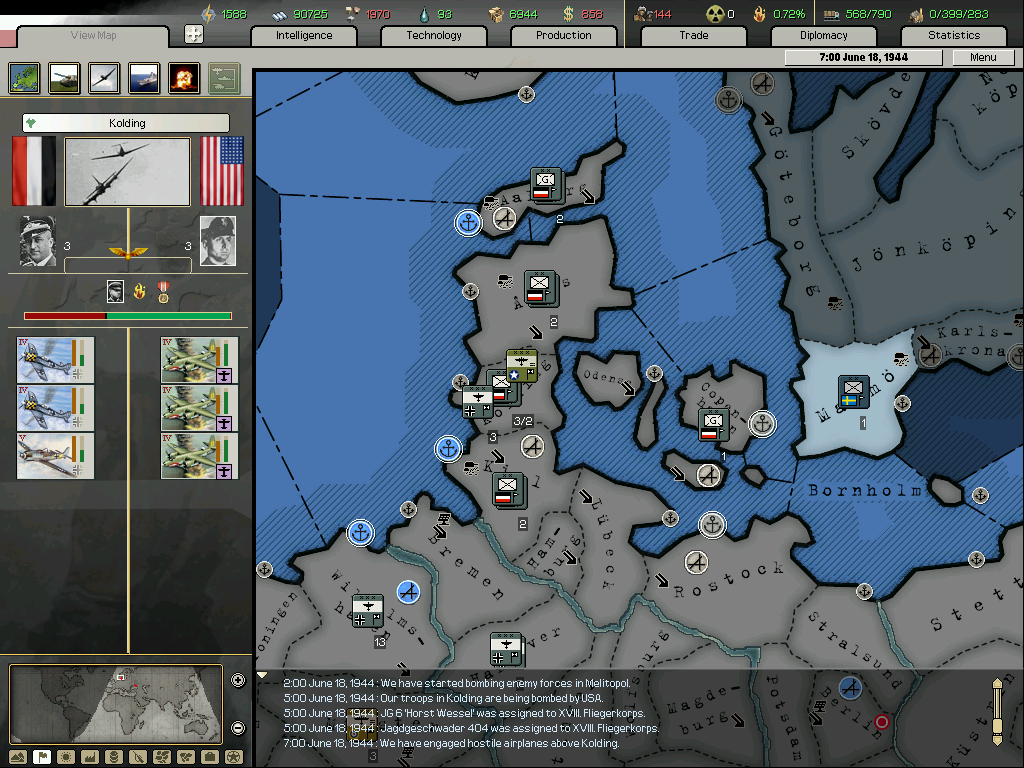

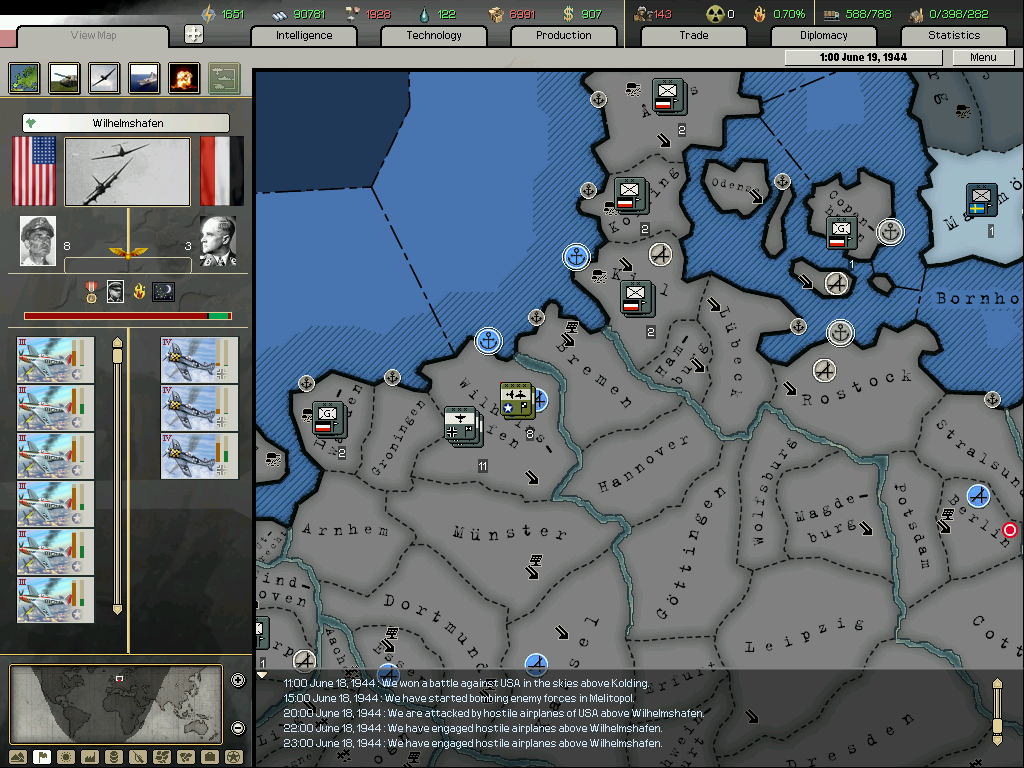
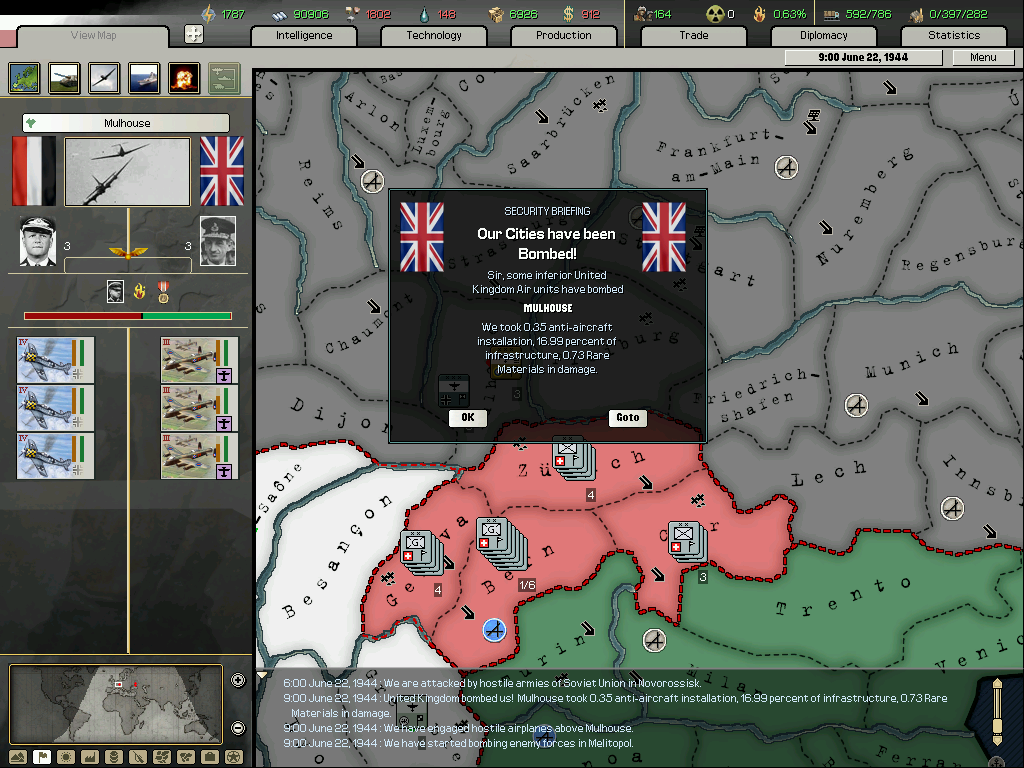


Other events
The British Empire continued it's plans for this so-called 'D-Day', but no amphibious attempts have been taken by any of the Allies either against German-France, Vichy-France, Italy or in the Balklands. Even the under-defended Ligurian islands, Crete and Malta have not been attacked.
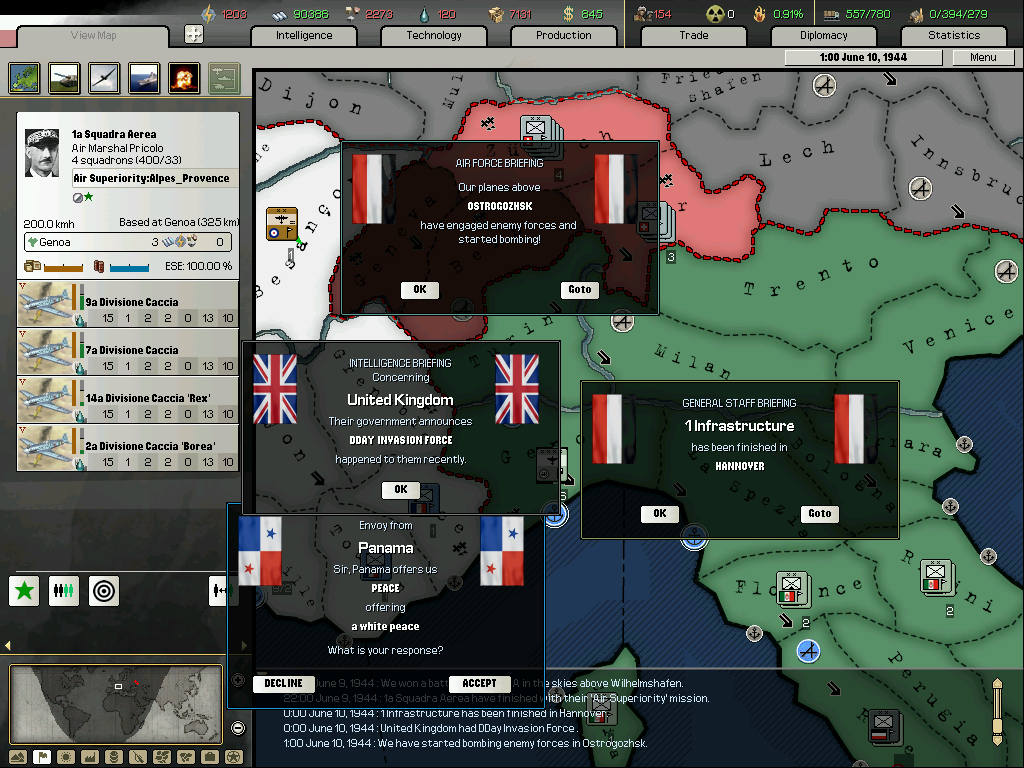
With the completion of the research on the flying rocket the German leadership immediately order the production of V-1 rockets in retaliation against the western Allies for their relentless strategic bombing campaign. There are also plans to use them against the Soviet Union; potentially against Leningrad, Stalingrad and Moscow if the situation permits it. The first batch will be available on 17th September 1944.
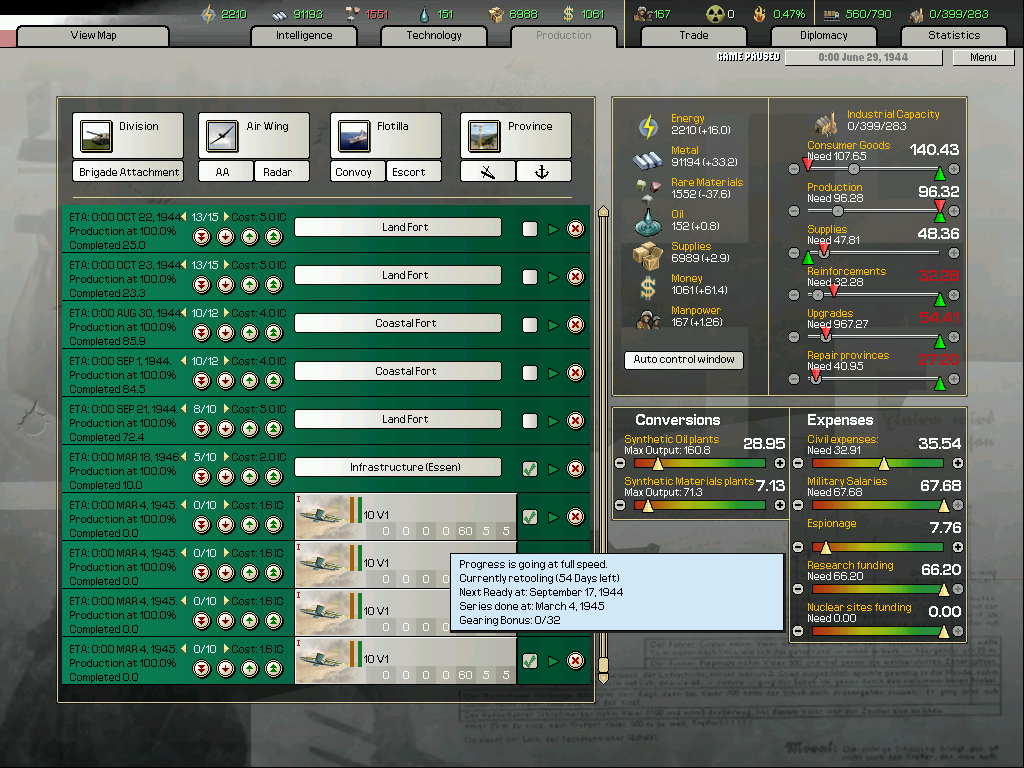
Eastern front
The offensive in the south is continued, with Rostov being encircled. While this only destroyed 2 Soviet divisions, there is a clear lack of reserve units in the area as the Heer is able to storm ahead to Baku. This has caused exhalation amongst the German leadership as Germany's oil reserve is becoming worryingly depleted. It is hoped the capture of Baku will resolve Germany's oil demands.




Once the two Soviet units in Rostov were destroyed, the German and Romanian armies could continue their advance towards the oil rich region of the Caucasus. The German armoured and motorised forces led the way, with several divisions from the northern and central parts of the front being sent south to help this advance and to ensure the territories can be held. Rommel was disgruntled with the order to remain in Rostov to ensure German flanks are secure, but he was certainly kept busy by counter-attacks from the Red Army.







It is now hoped that the Crimea will now fall to Germany, with armoured units estimated to arrive in Batum at 1pm on 1st July. Which will completely cut off Soviet troops in the Crimea from supplies. A quick siege is hoped, the Luftwaffe will ensure the Red Air Force cannot air supply these units as was the case in Leningrad.


The German Air Force has remained on the offensive against the continually depleted and understrength Red Air Force.




Air war against the Allies
The US Air Force launched strong offensives against German air units in Wilhelmshafen and Essen, with the Luftwaffe being upto this challenge. However 1 German interceptor unit was completely destroyed, with the remaining 2 wings being re-based to Berlin in order to be reinforced. Somehow there were several air battles over Wilhelmshafen at the same time, perhaps due to the fast speed of the air planes responding in different parts of the territory.












Other events
The British Empire continued it's plans for this so-called 'D-Day', but no amphibious attempts have been taken by any of the Allies either against German-France, Vichy-France, Italy or in the Balklands. Even the under-defended Ligurian islands, Crete and Malta have not been attacked.

With the completion of the research on the flying rocket the German leadership immediately order the production of V-1 rockets in retaliation against the western Allies for their relentless strategic bombing campaign. There are also plans to use them against the Soviet Union; potentially against Leningrad, Stalingrad and Moscow if the situation permits it. The first batch will be available on 17th September 1944.

Will Germany be really able to seize (and keep a connection to) the Caucasus oil fields? Only time will tell...
For the time being, however, could you please show a screen or two of some of your armored/motorized units to let us see how much oil are they still carrying along? I guess their tanks must be already depleted by now, right...?
What about rares, also? How are you going to deal with the crisis which is likely to hit your factories in a matter of weeks?
For the time being, however, could you please show a screen or two of some of your armored/motorized units to let us see how much oil are they still carrying along? I guess their tanks must be already depleted by now, right...?
What about rares, also? How are you going to deal with the crisis which is likely to hit your factories in a matter of weeks?
The D-day invasion force event for Britain ... what is that?
Whatever it is it can't be good
Go Germany! Hope you can find some oil on your way into Soviet territory
Whatever it is it can't be good
Go Germany! Hope you can find some oil on your way into Soviet territory
The D-day invasion force event for Britain ... what is that?
The event gives the English AI two destroyers, two troop transport ships, and two marine divisions in Portsmouth.
@Barvinok, Titan 79, Marshall18: regarding the oil crisis, update to come 
@Titan79: about the rares, update to come (Germany's allies will prove very helpful). And about the units oil and supplies, I'm sorry to say that none of my units ran out of supplies or oil.
@Marshall18: I'm am slightly worried about an upcoming D-Day either in France, Italy, or even Denmark and the Balkans. But I'm also concerned there haven't been any attempts to invade so far, not that I'm complaining!
@Gringoesteban: interesting, maybe the UK will attempt another invasion of Norway! Also, did you make any event for the fall of Vichy? I assumed it would've collapsed when Casablanca/all of North Africa was lost.
@Titan79: about the rares, update to come (Germany's allies will prove very helpful). And about the units oil and supplies, I'm sorry to say that none of my units ran out of supplies or oil.
@Marshall18: I'm am slightly worried about an upcoming D-Day either in France, Italy, or even Denmark and the Balkans. But I'm also concerned there haven't been any attempts to invade so far, not that I'm complaining!
@Gringoesteban: interesting, maybe the UK will attempt another invasion of Norway! Also, did you make any event for the fall of Vichy? I assumed it would've collapsed when Casablanca/all of North Africa was lost.
July 1944
Losses Charts
The Japanese navy has been doing surprisingly well, sinking nearly 50 troops transports! Maybe this explains why neither the US or UK have tried an amphibious invasion in France or Italy.
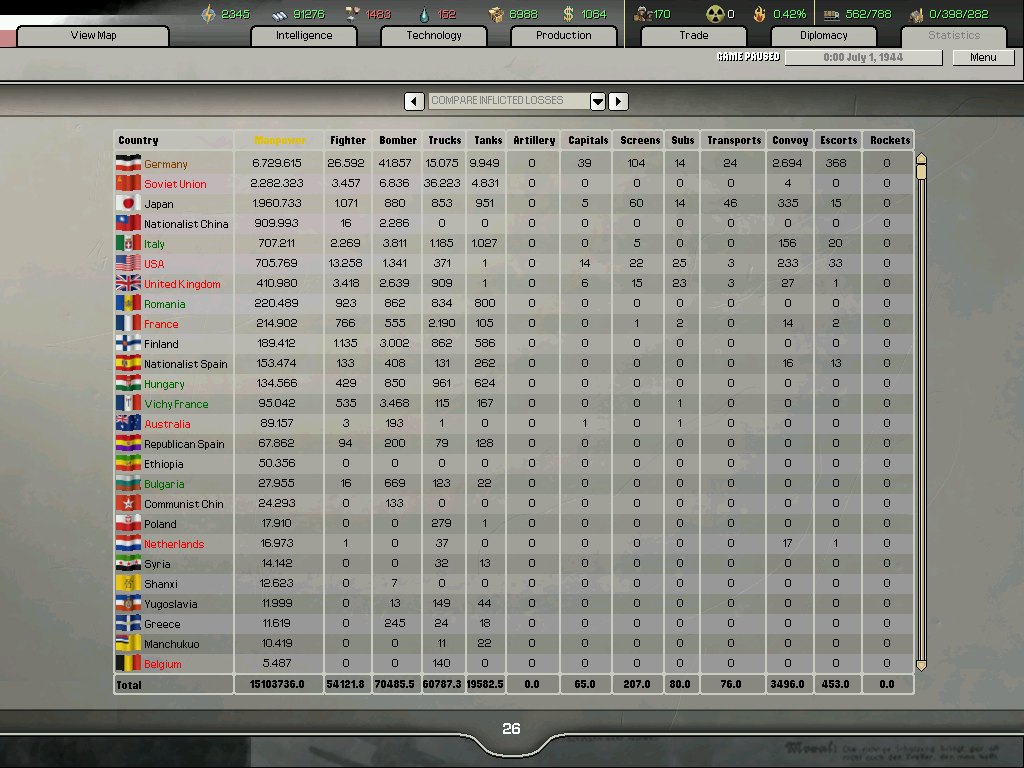

Eastern front
With the fall of Batum on the 1st, Soviet units in the Crimea were cut off from all supplies and the siege had begun. German and Romanian units pushed forward to capture the two provinces bordering Sevastopol, then sending several units from there to the Caucasus to help set up a viable defence in the mountains. The oil-rich Maikop and Grozny were held, with German engineers trying to rebuild the oil fields as fast as possible. Several Red Army divisions were sent to Kerch in hopeless attempts to hold the province, all of which failed. The Luftwaffe played a pivotal role throughout, with its bombers being able to decide when and where to attack due to the air superiority, if not air supremacy, it now has in the area.
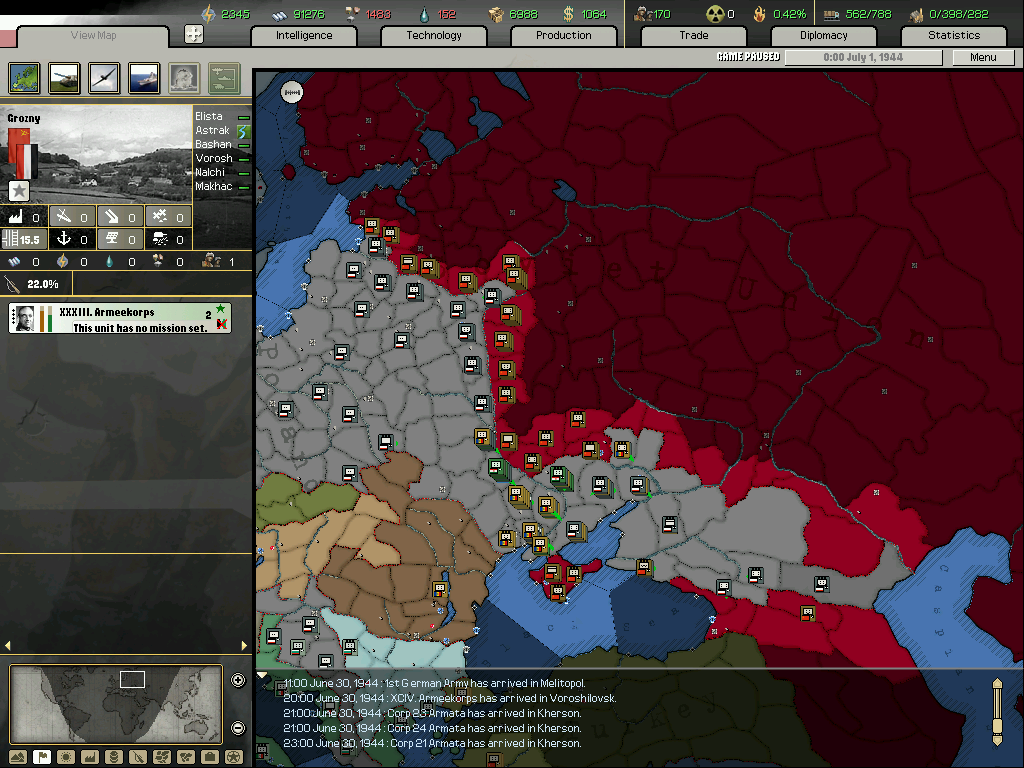
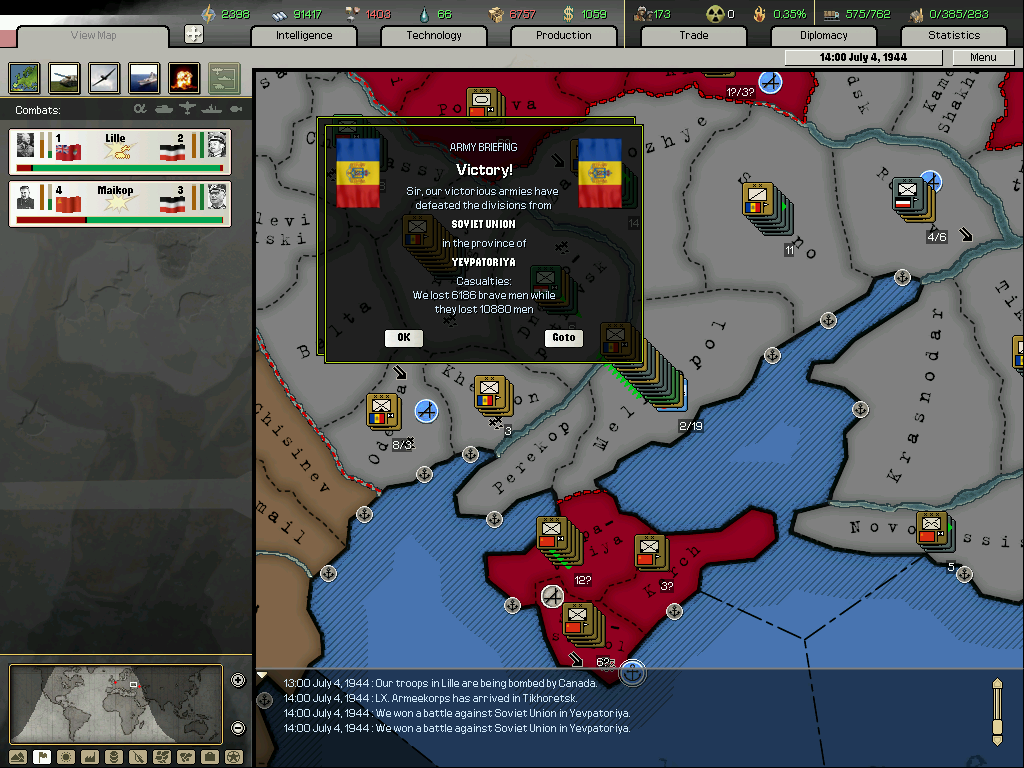

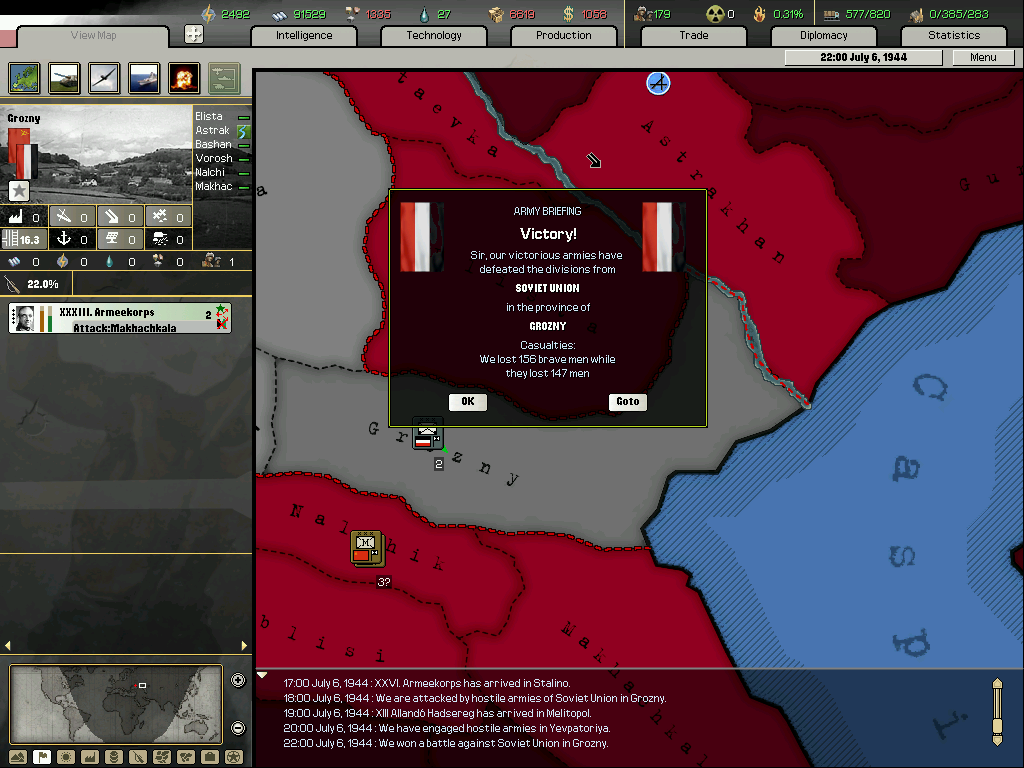
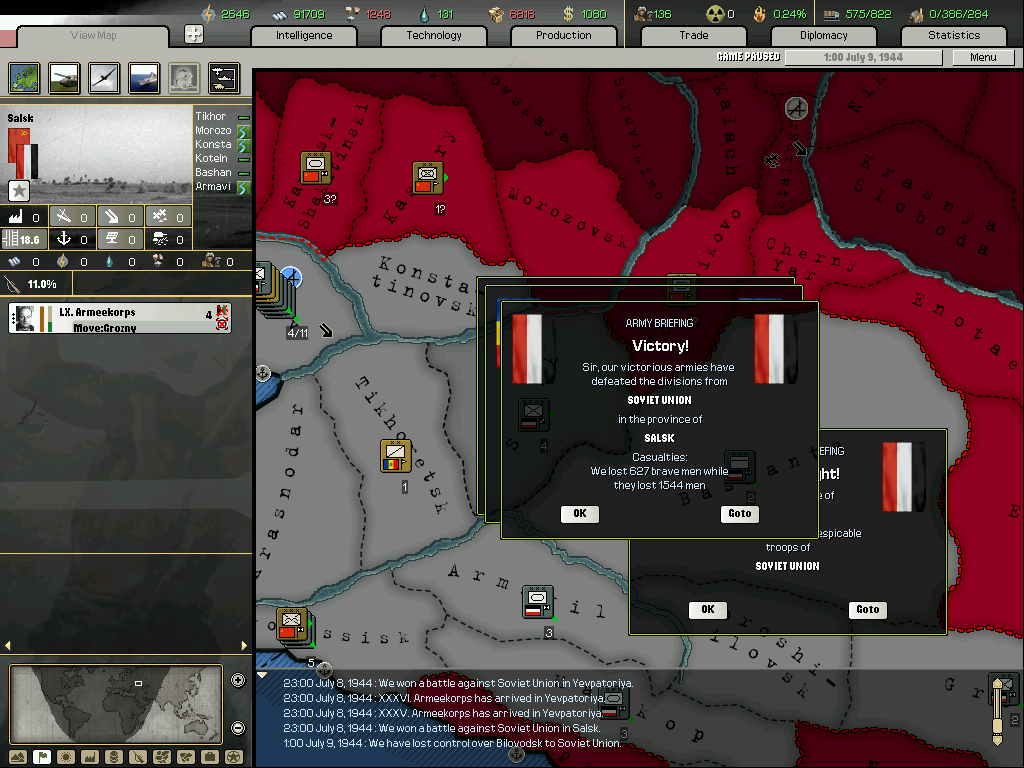
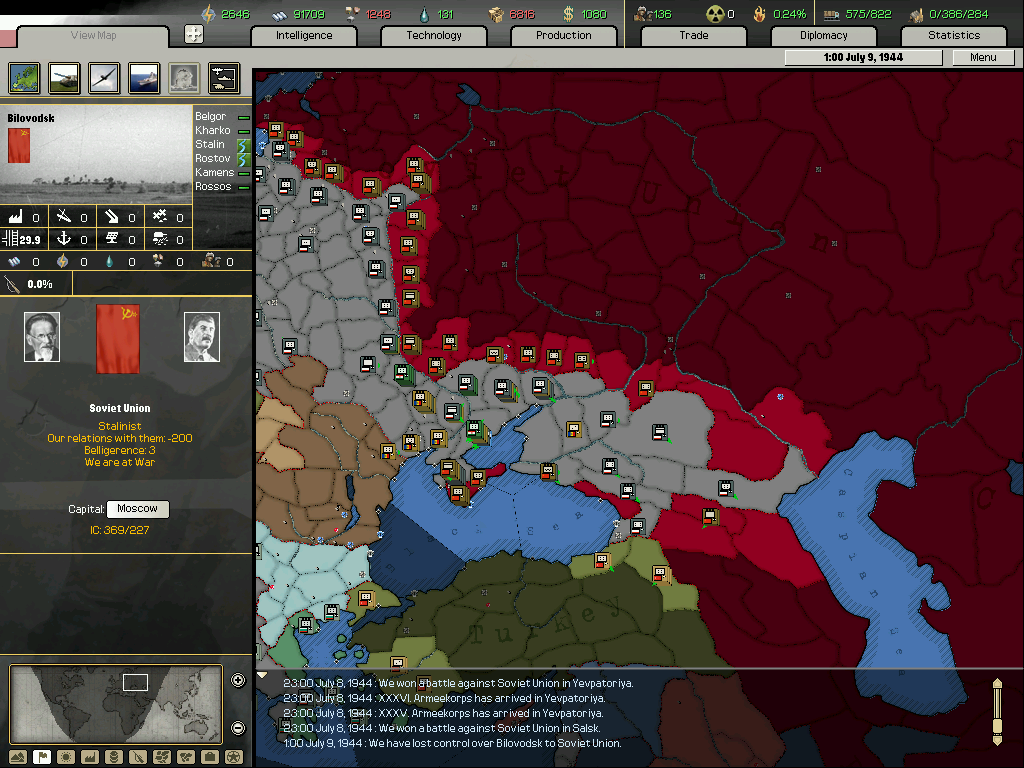
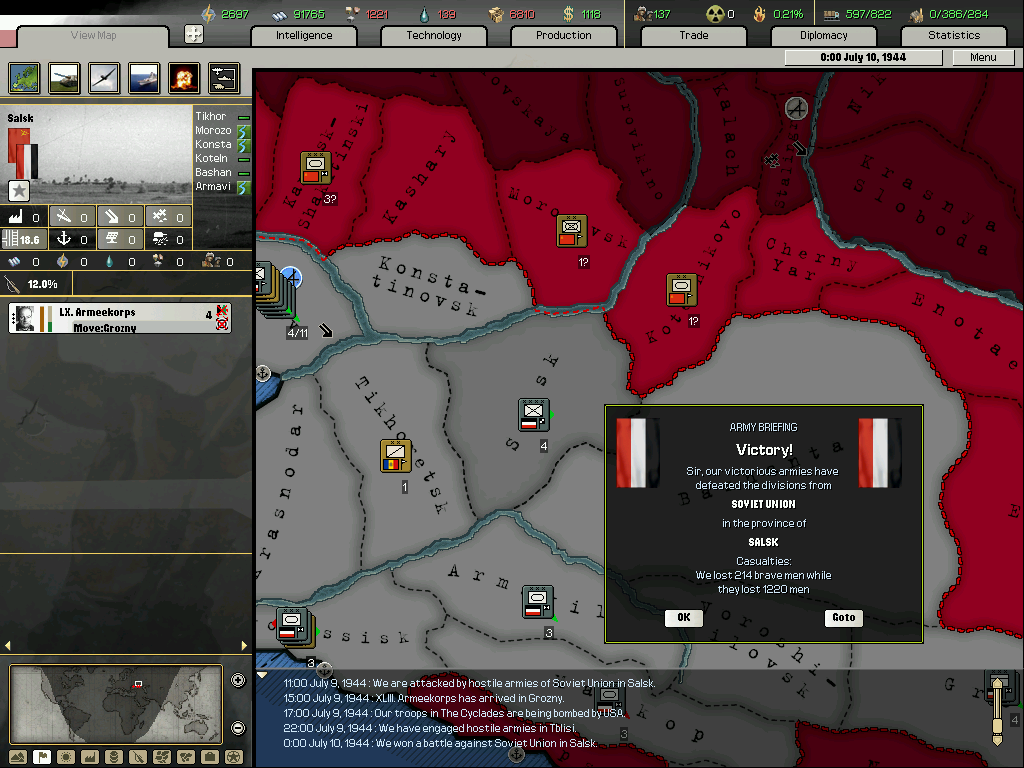
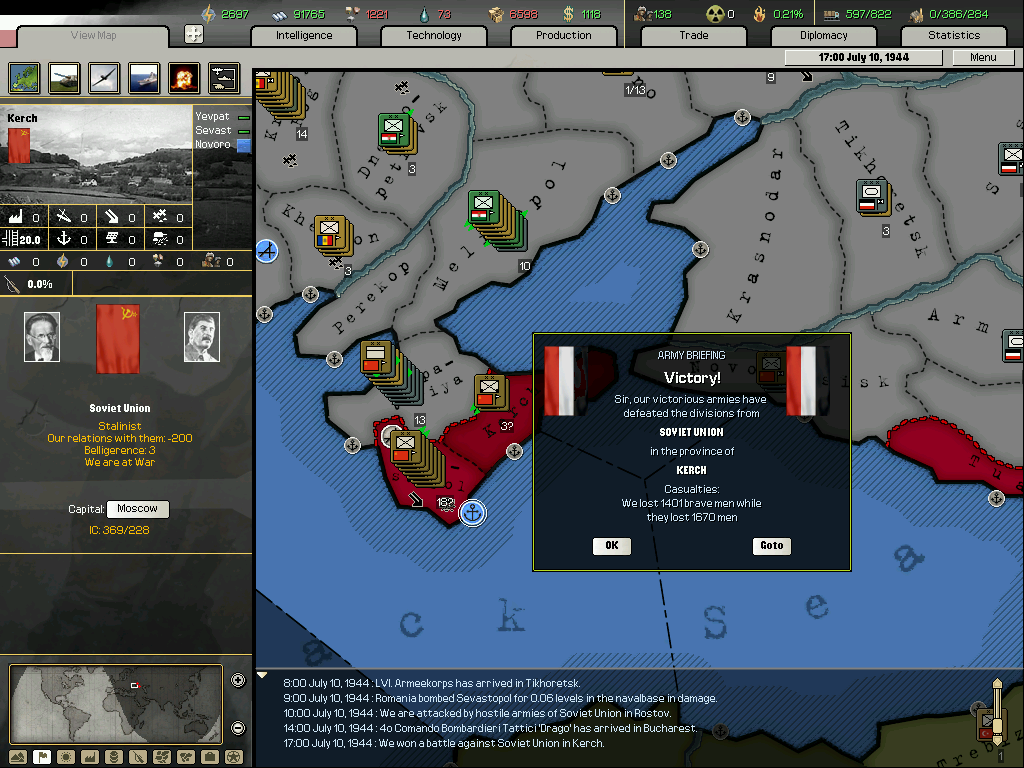
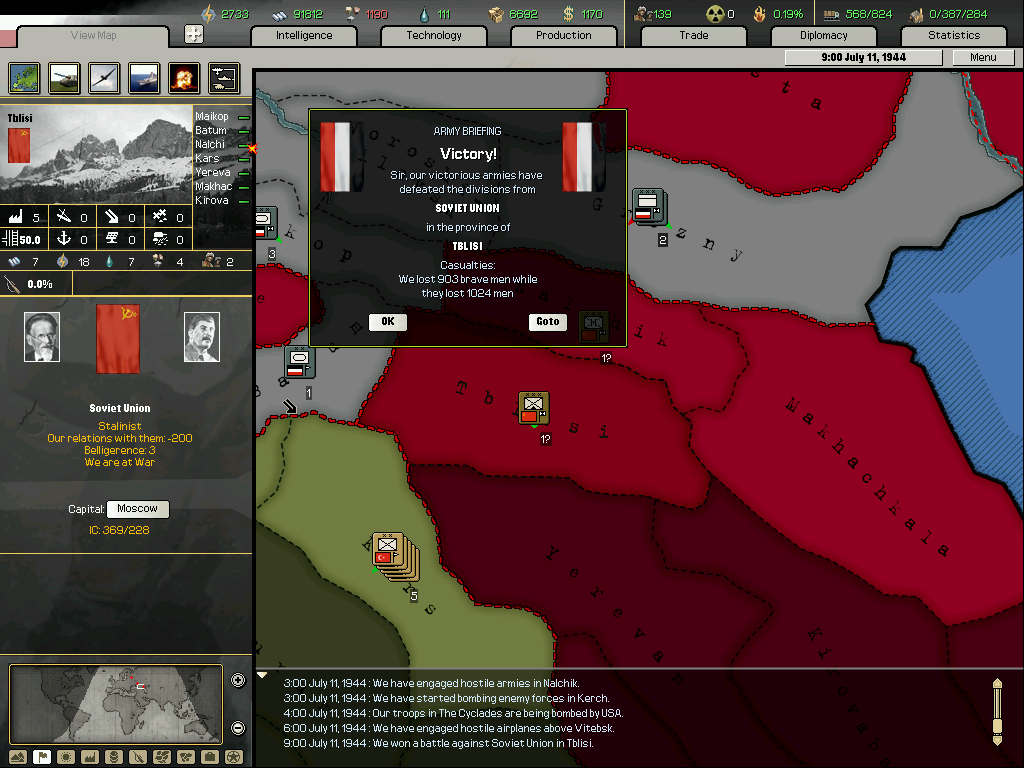

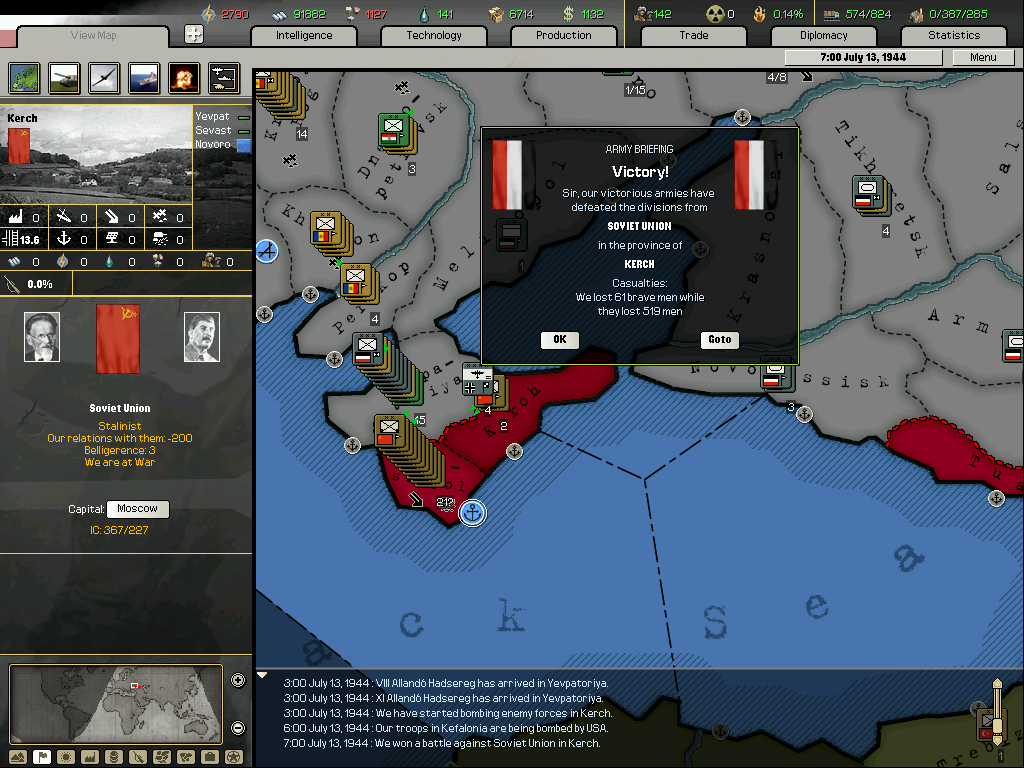
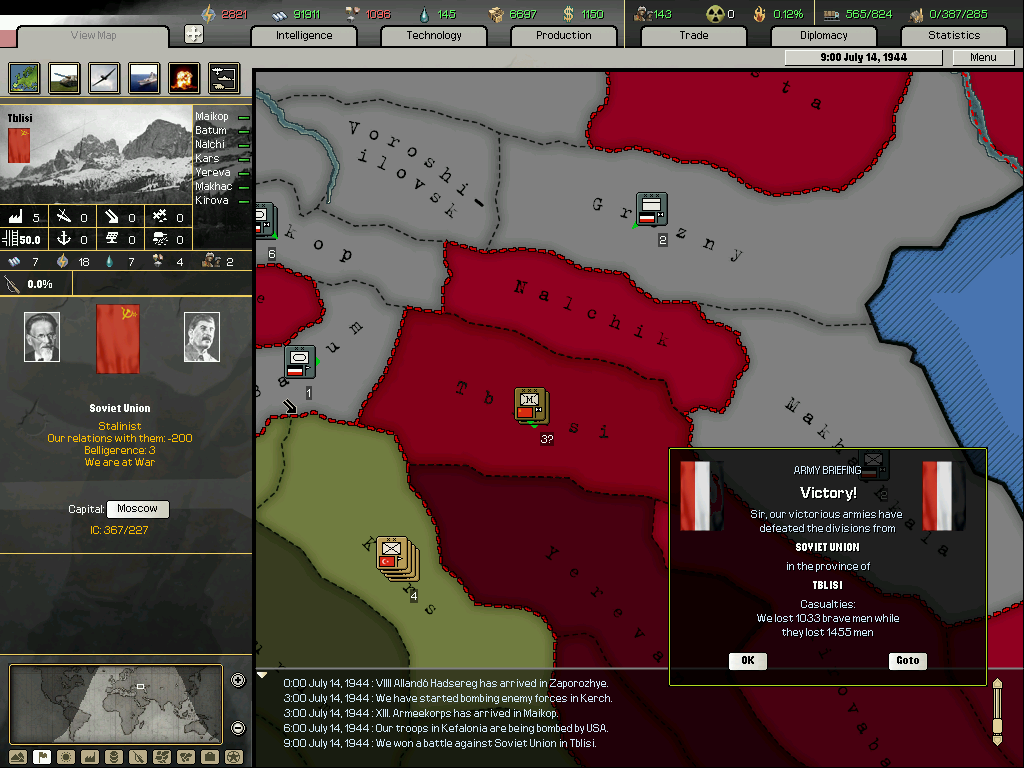
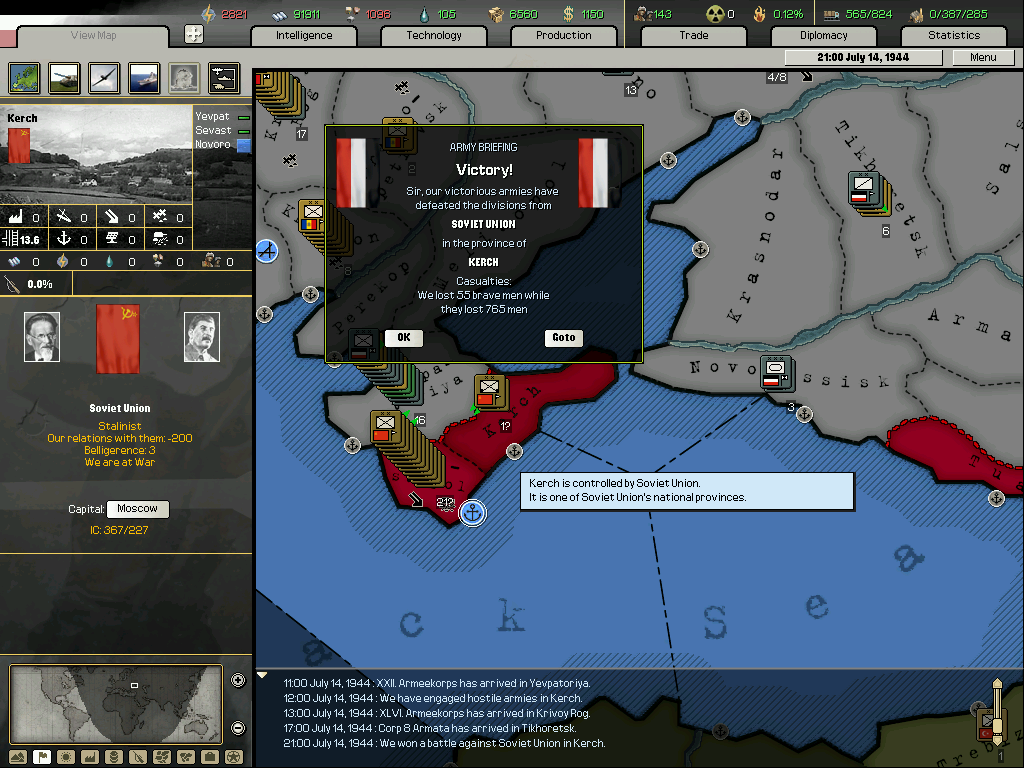
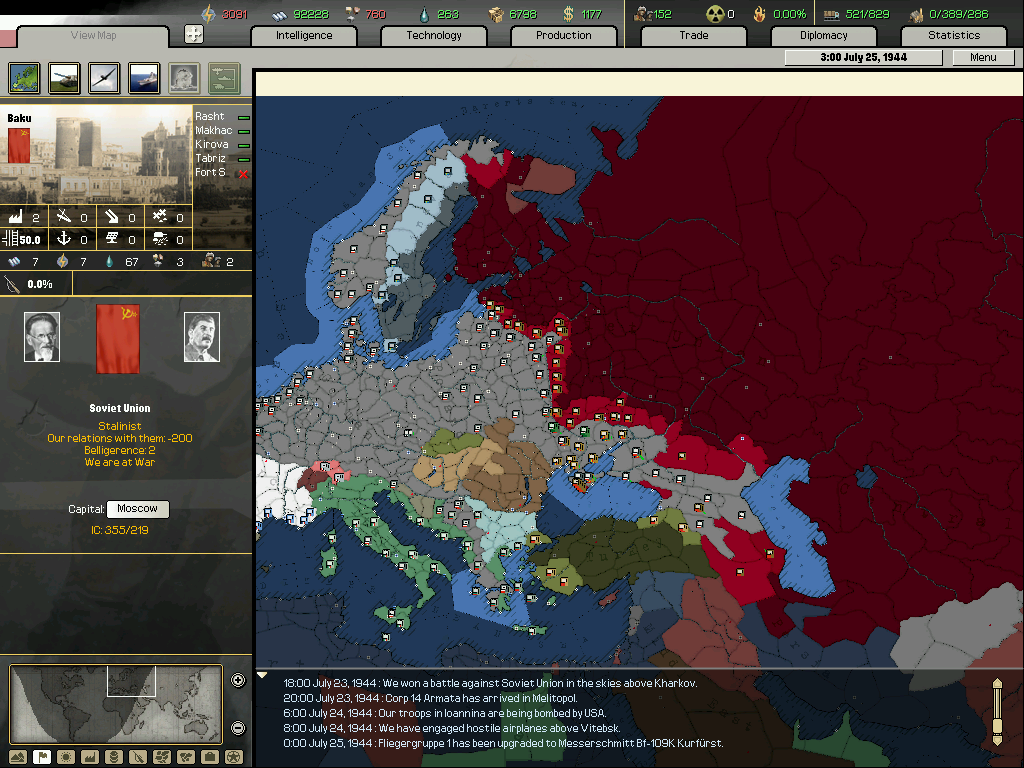
The Luftwaffe continued to destroy the Red Air Force.
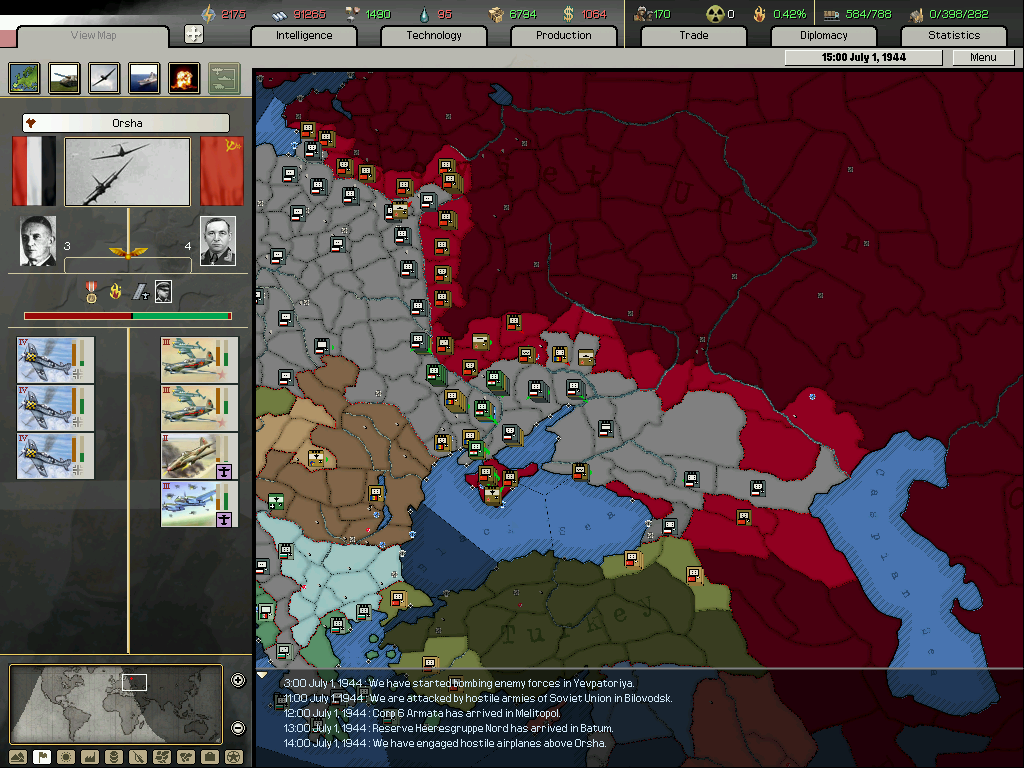
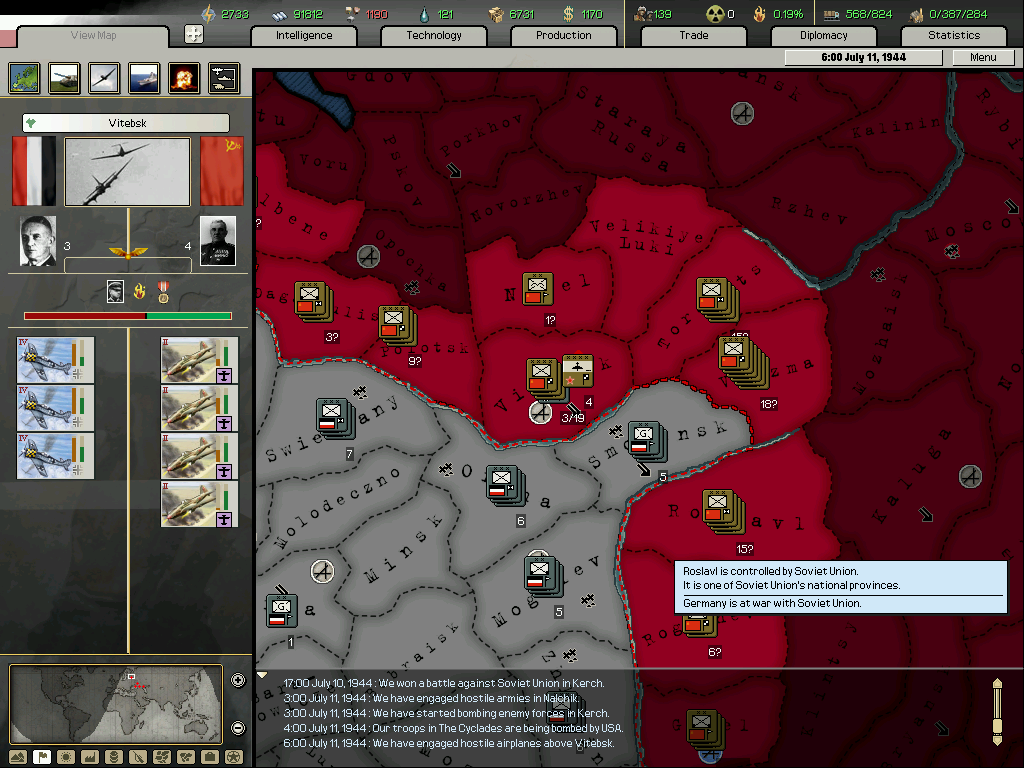
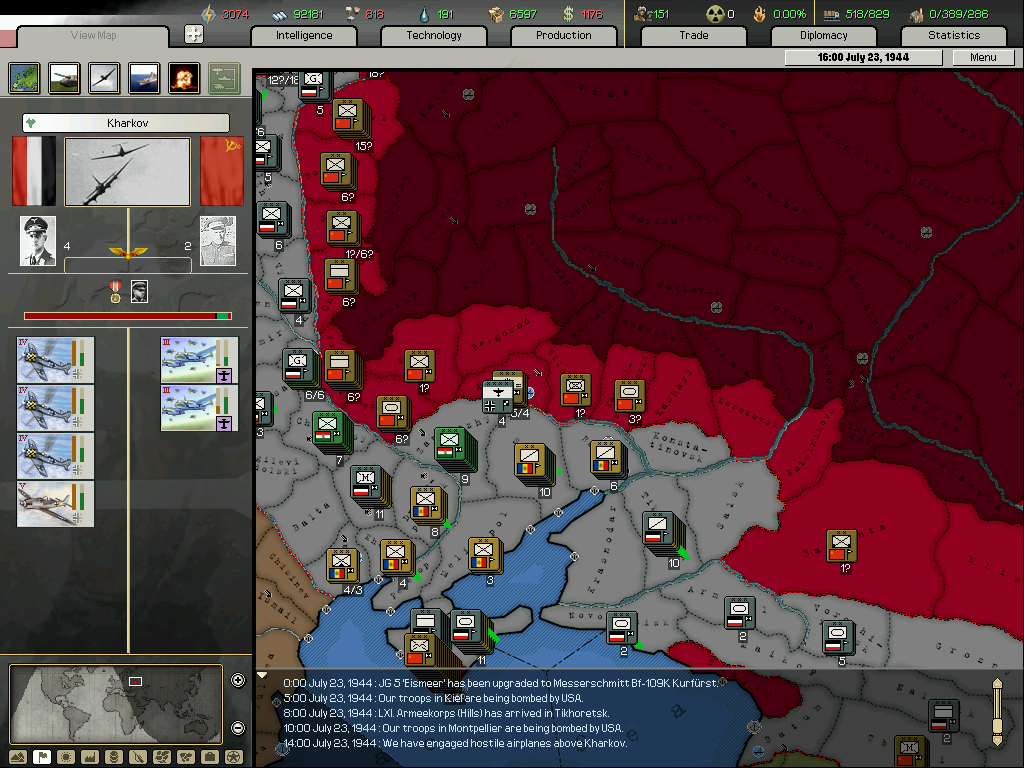
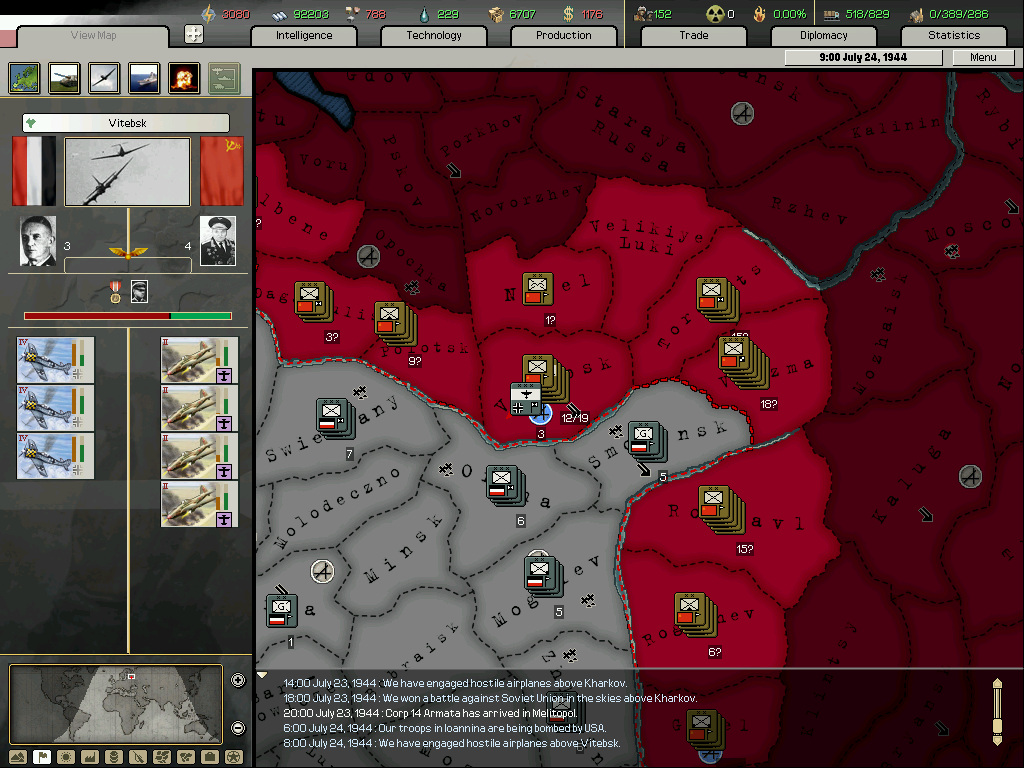
Air war against the Allies
The German Air Force also continued to defeat the US and UK Air Forces, with repeated American attempts failing to bomb the airfields in Wilhelmshafen.
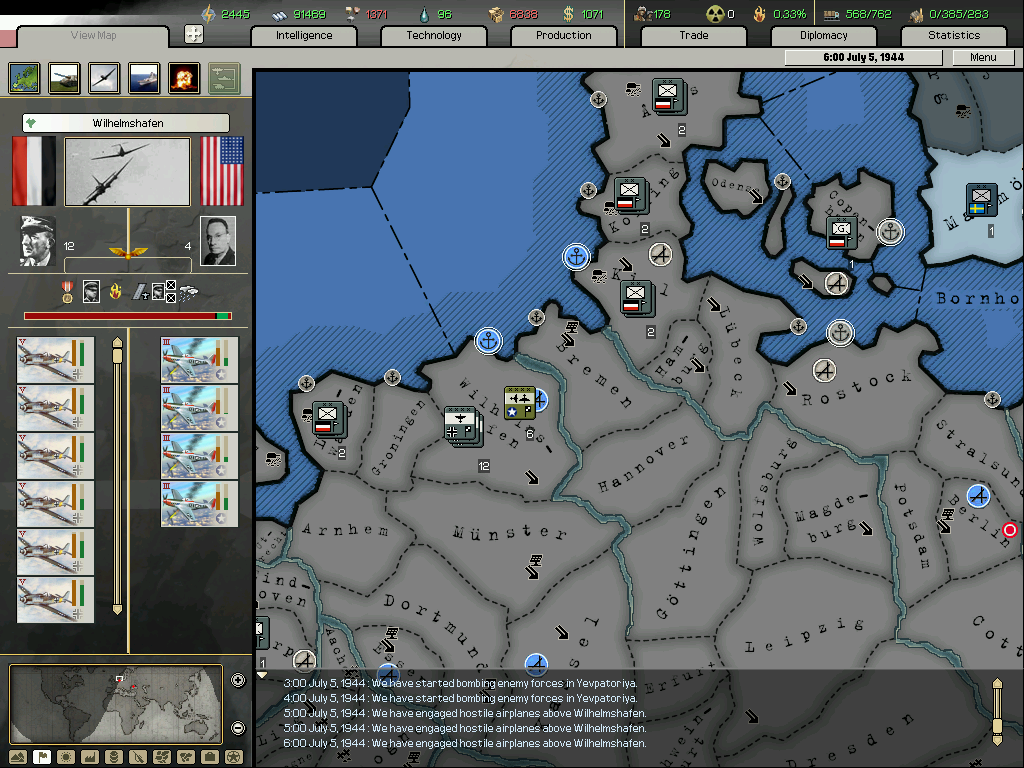
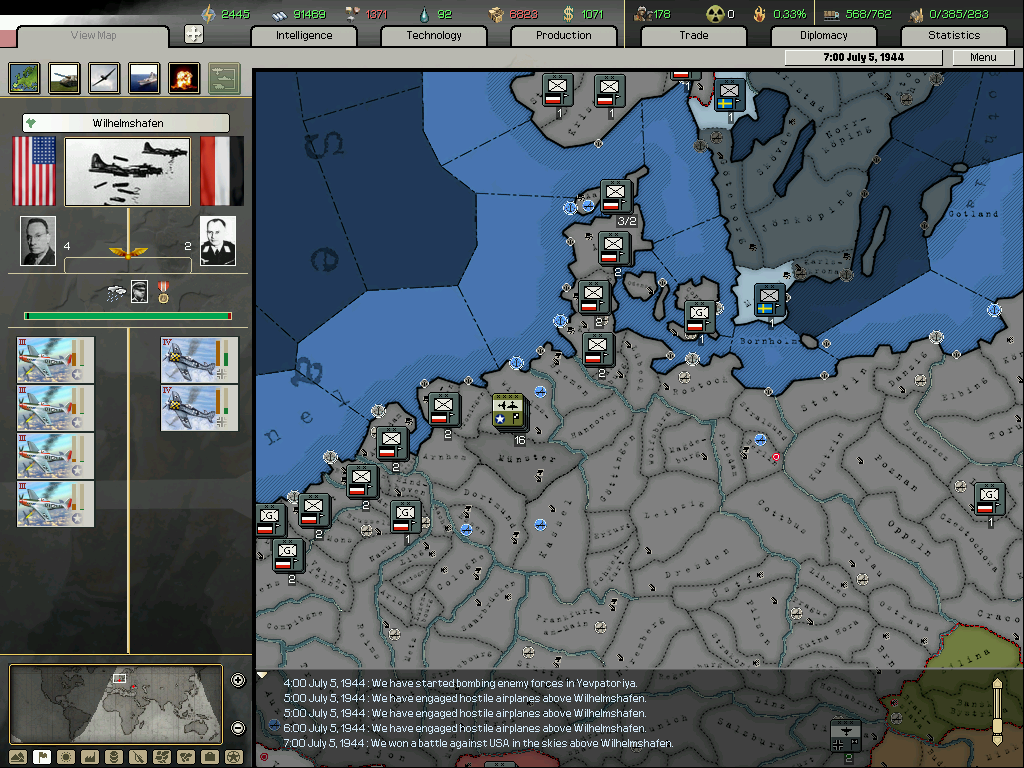
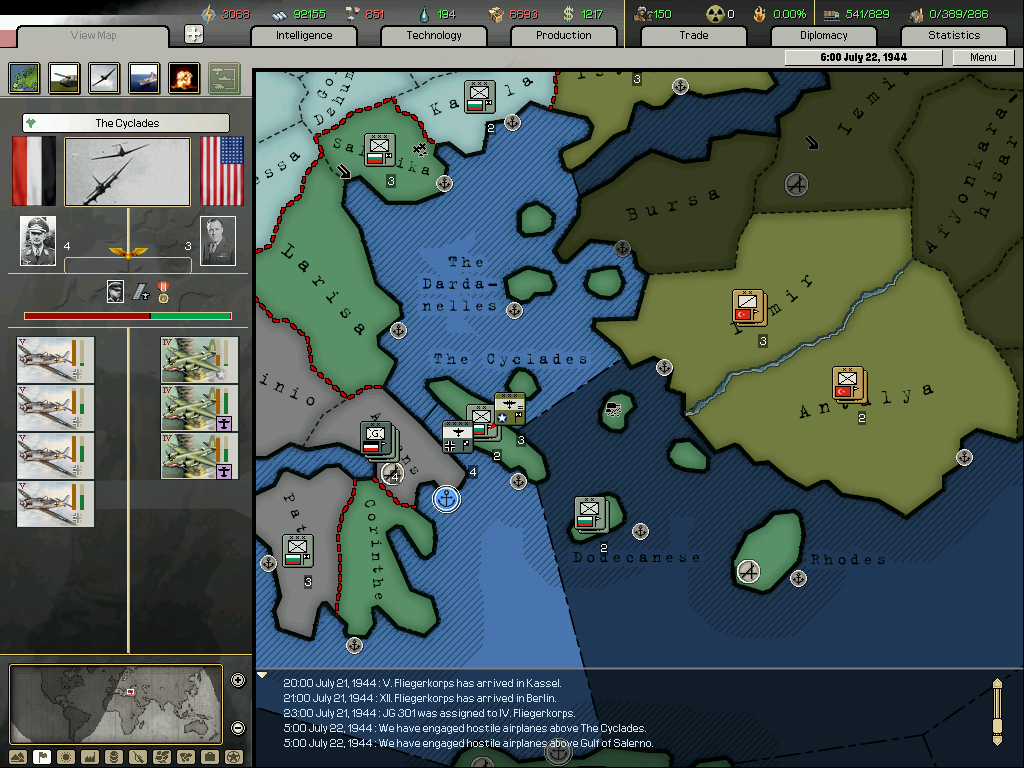
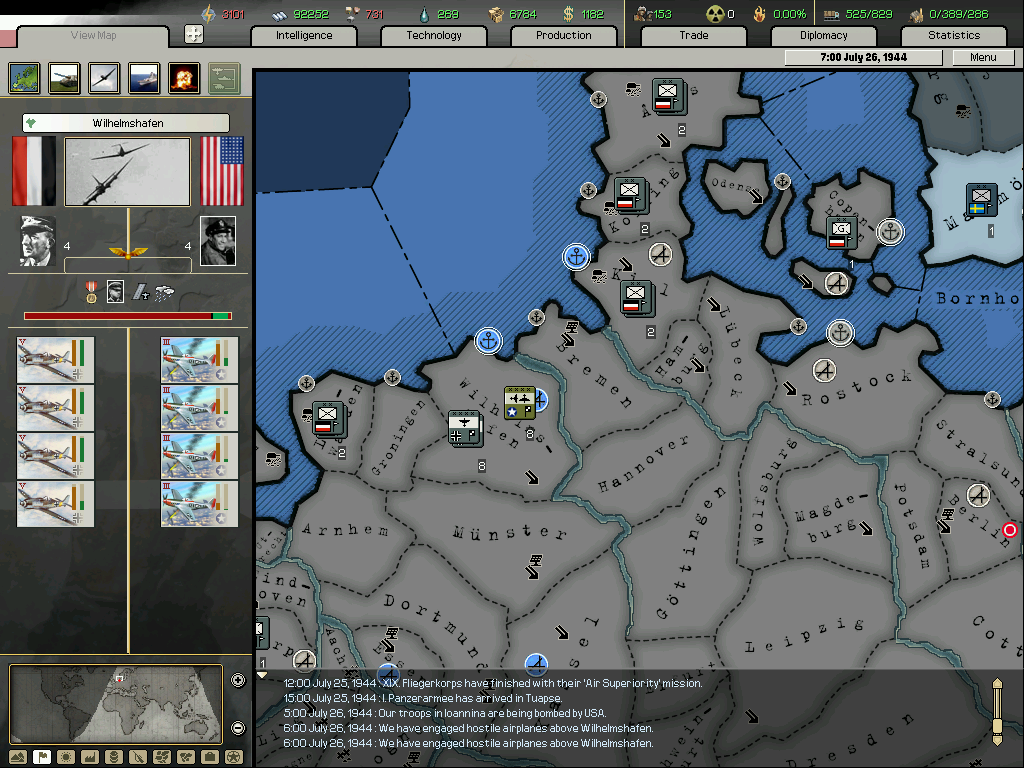
The Italian and Vichy Air Forces also repulsed American attempts to bomb their industries.
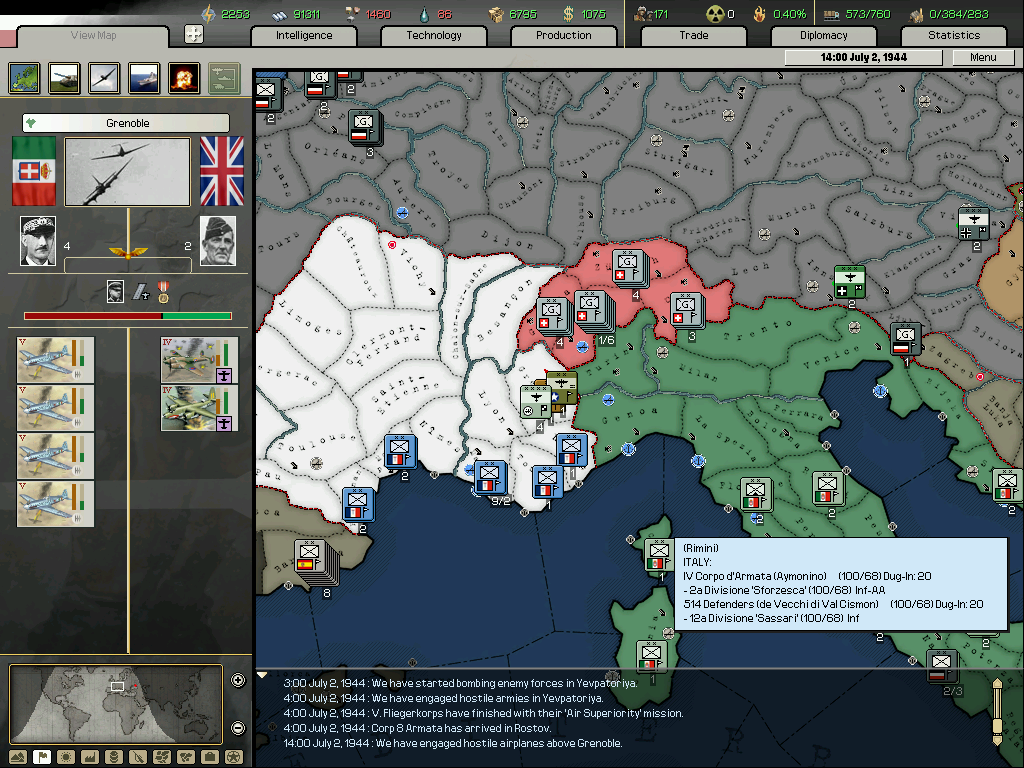
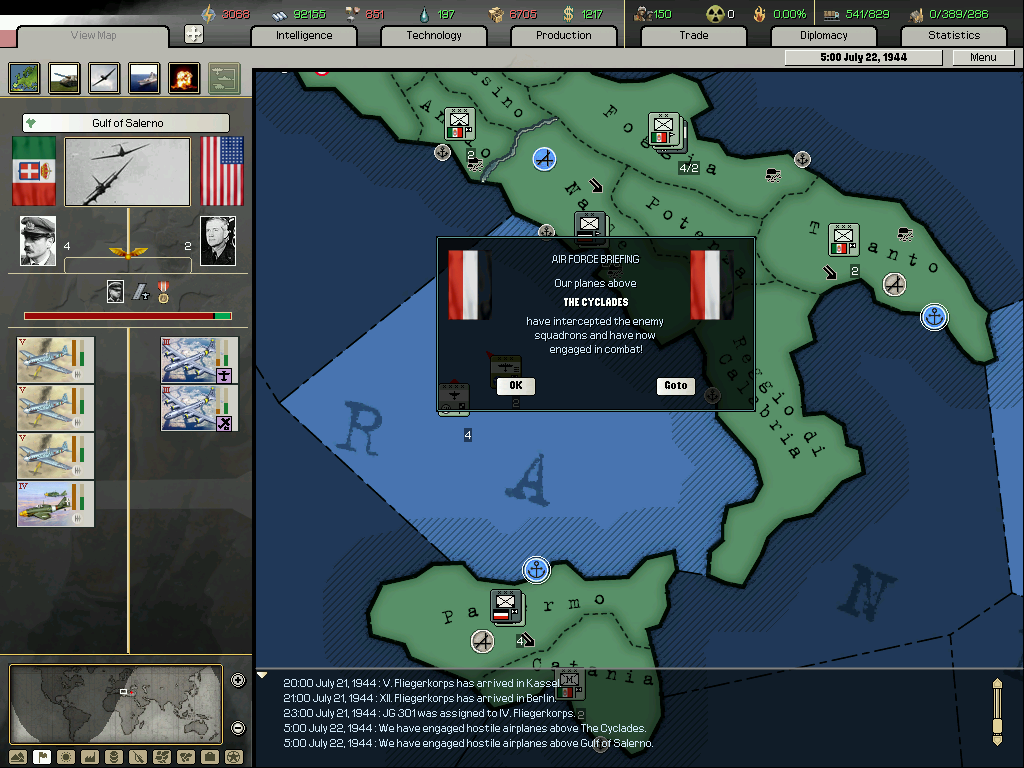
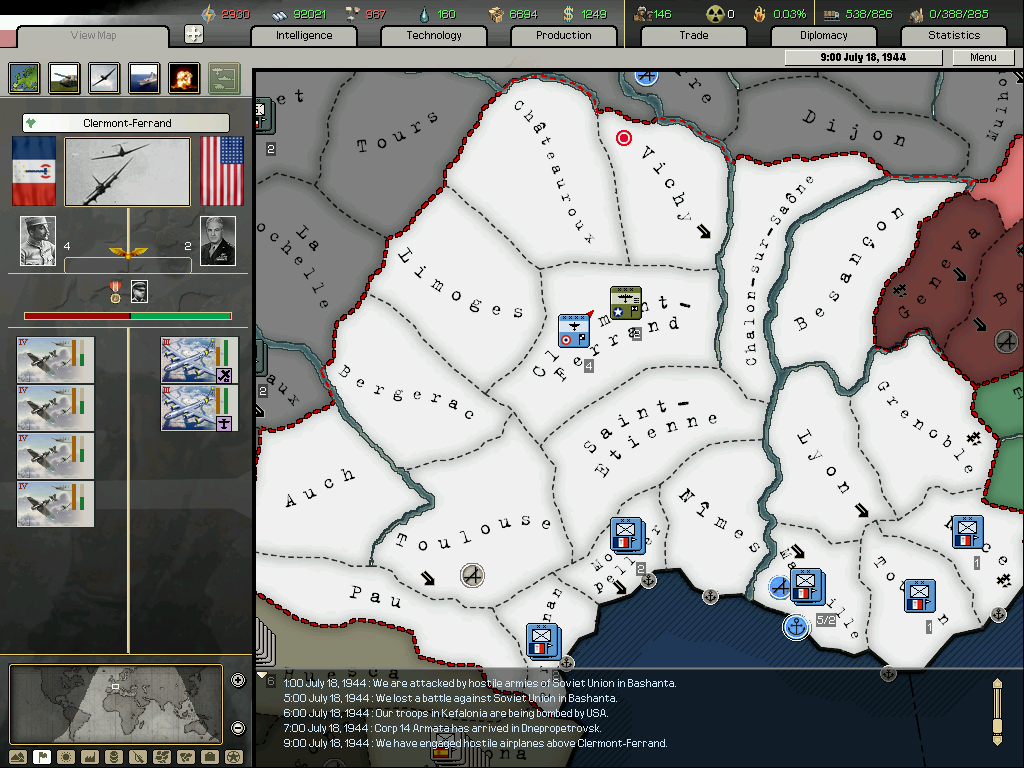
Other events
The German government decided to move one step away from central planning and one step towards a free market. This was to reduce the resource demand of German industry, and also to help speed up the upgrading time of units in order to ensure German technical superiority. Advanced Logistics was researched, further strengthening the German military's logistical system which has so far never been strained over its capacity for an extended period of time. Due to the strength of Germany's Atlantik wall German produced coastal fortifications have been placed in Italian and occupied-Greek beaches.
Losses Charts
The Japanese navy has been doing surprisingly well, sinking nearly 50 troops transports! Maybe this explains why neither the US or UK have tried an amphibious invasion in France or Italy.


Eastern front
With the fall of Batum on the 1st, Soviet units in the Crimea were cut off from all supplies and the siege had begun. German and Romanian units pushed forward to capture the two provinces bordering Sevastopol, then sending several units from there to the Caucasus to help set up a viable defence in the mountains. The oil-rich Maikop and Grozny were held, with German engineers trying to rebuild the oil fields as fast as possible. Several Red Army divisions were sent to Kerch in hopeless attempts to hold the province, all of which failed. The Luftwaffe played a pivotal role throughout, with its bombers being able to decide when and where to attack due to the air superiority, if not air supremacy, it now has in the area.














The Luftwaffe continued to destroy the Red Air Force.




Air war against the Allies
The German Air Force also continued to defeat the US and UK Air Forces, with repeated American attempts failing to bomb the airfields in Wilhelmshafen.




The Italian and Vichy Air Forces also repulsed American attempts to bomb their industries.



Other events
The German government decided to move one step away from central planning and one step towards a free market. This was to reduce the resource demand of German industry, and also to help speed up the upgrading time of units in order to ensure German technical superiority. Advanced Logistics was researched, further strengthening the German military's logistical system which has so far never been strained over its capacity for an extended period of time. Due to the strength of Germany's Atlantik wall German produced coastal fortifications have been placed in Italian and occupied-Greek beaches.
August 1944
Losses Charts
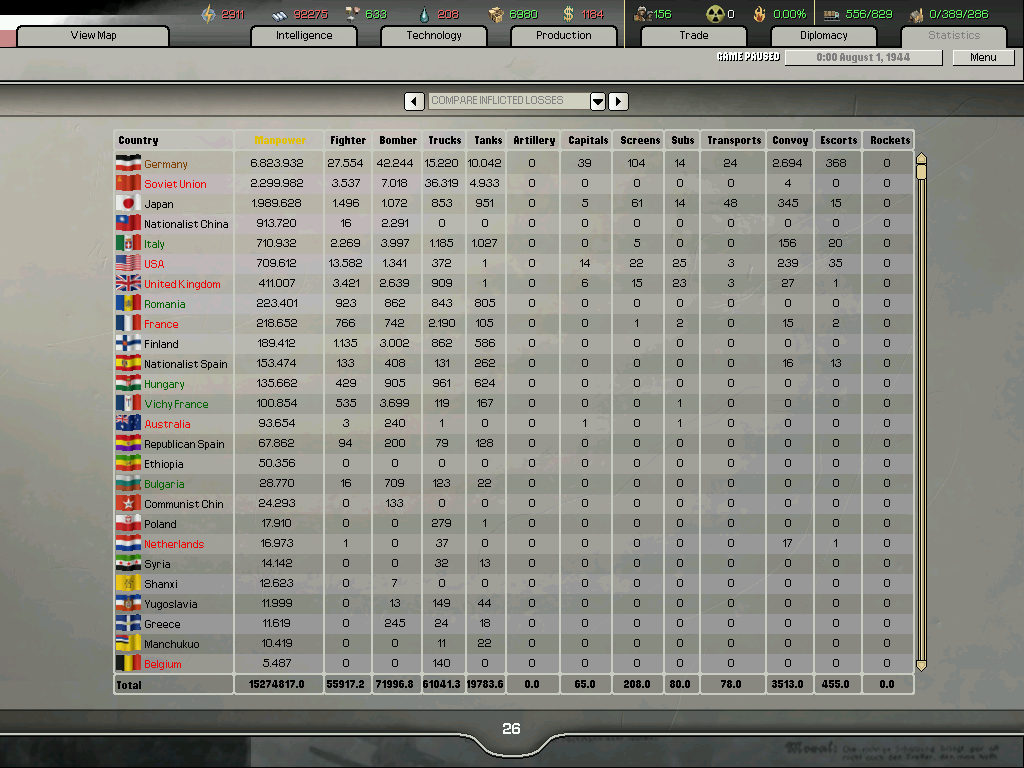
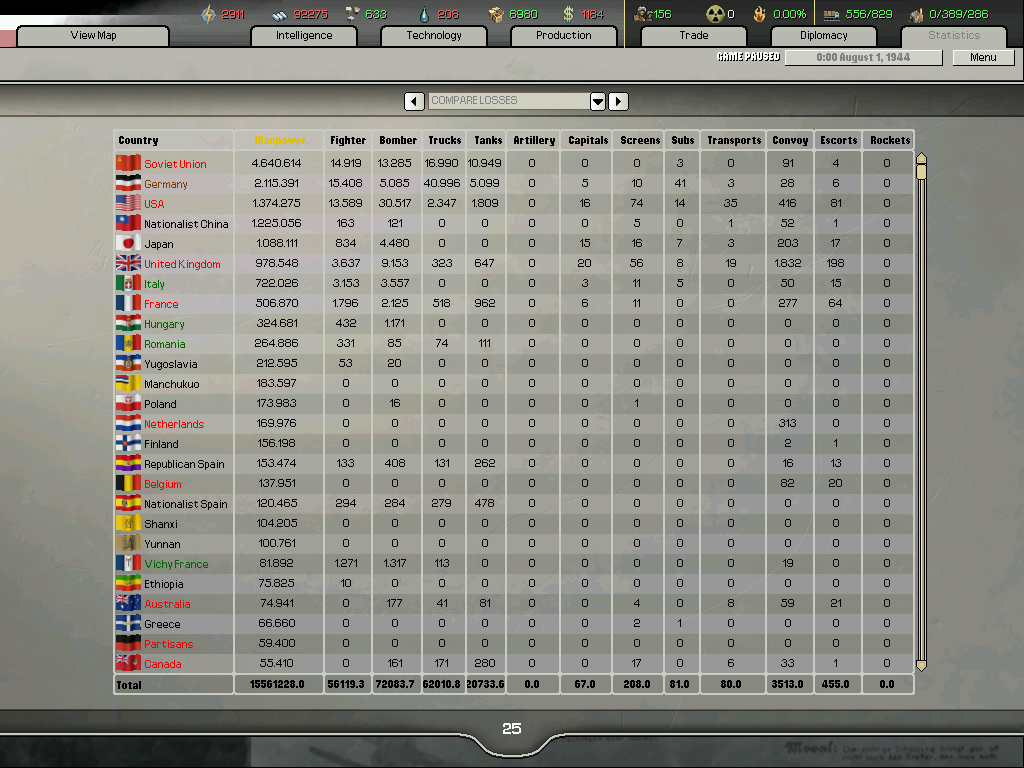
Eastern front
The advance southwards continues with great success, with Baku being captured on the 15th by troops led by Falkenhorst. With German forces being worryingly close to capturing territory bordering American-Persia, the orders went out that German units should not attack, or at least capture, anymore territory beyond the Caucasus. The capture of Baku came at immediate great reward as 2,500 barrels of oil were found in the city.
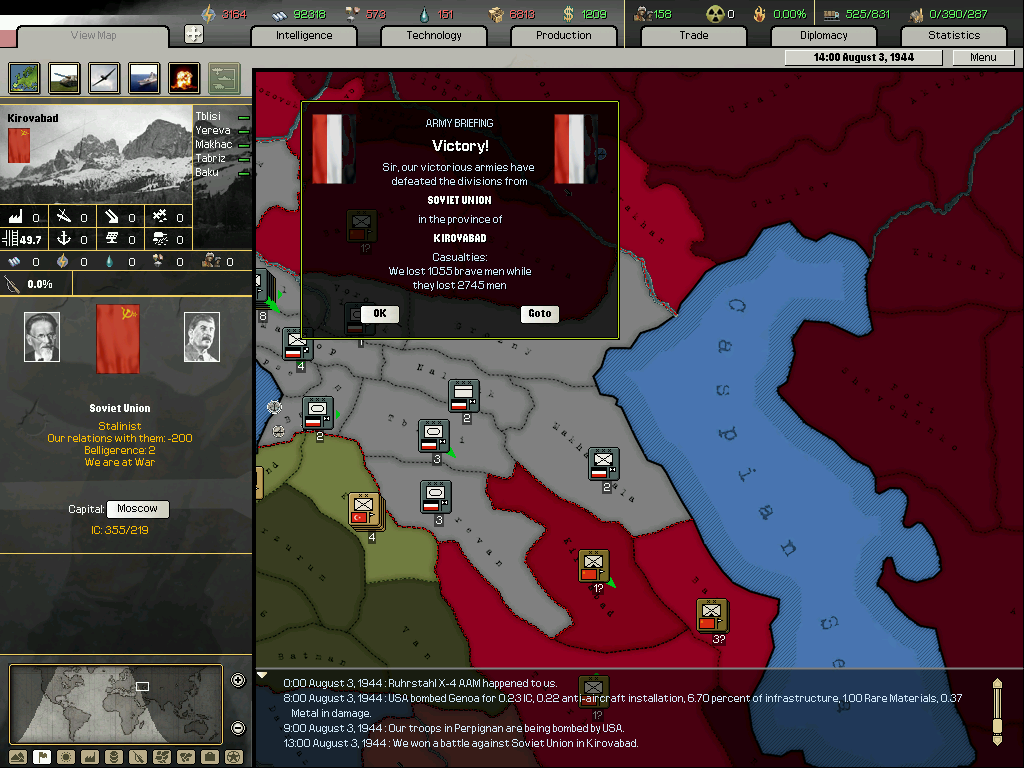
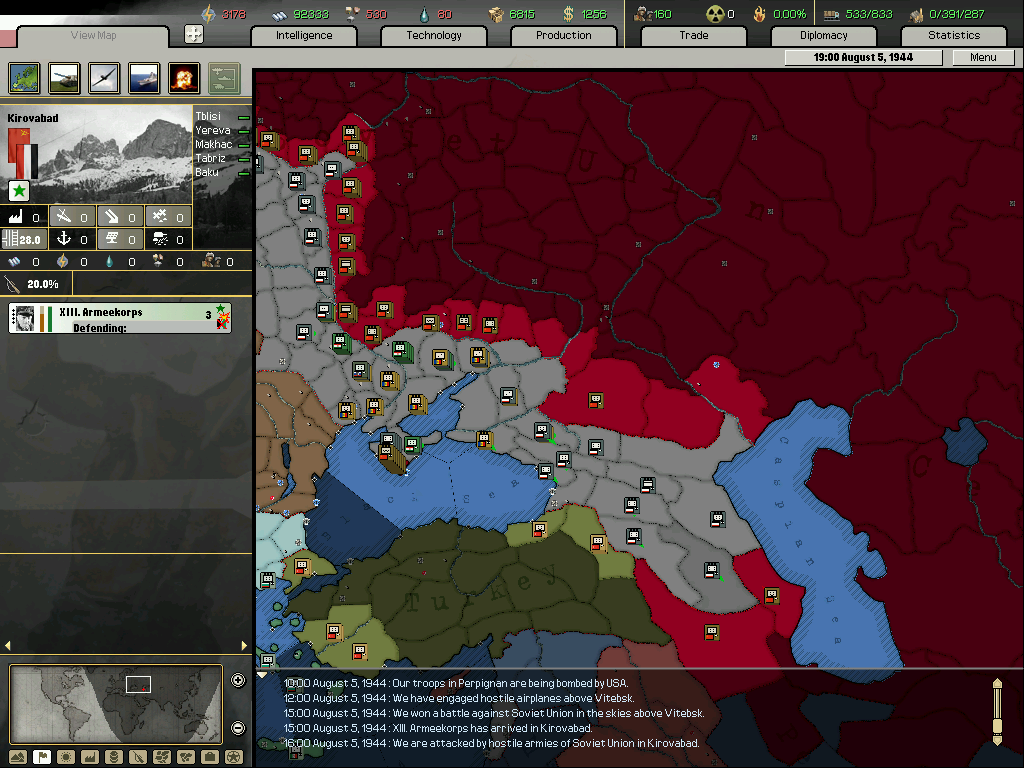

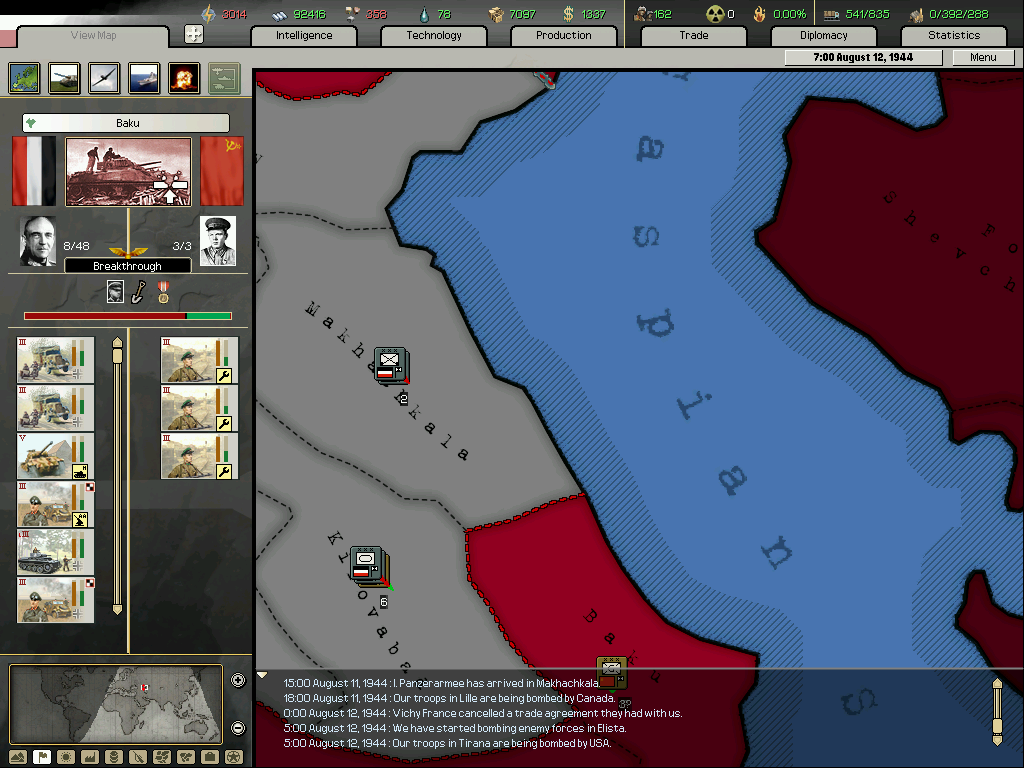
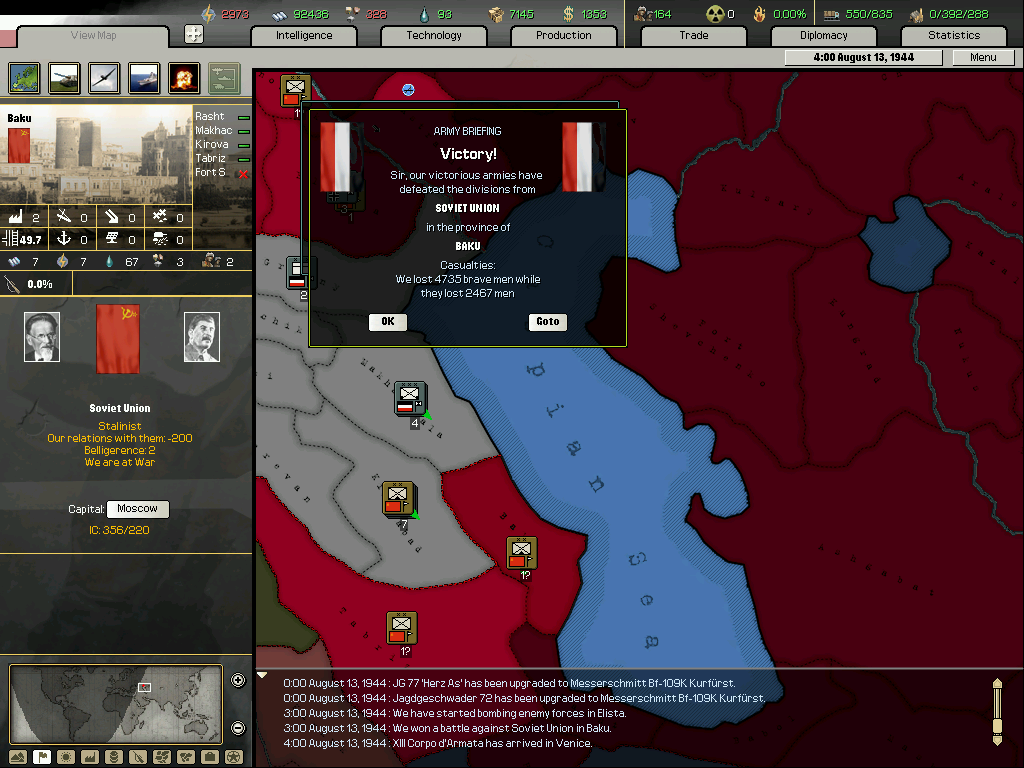

The capture of Tabriz was called off in order to avoid bordering American-occupied Persia.
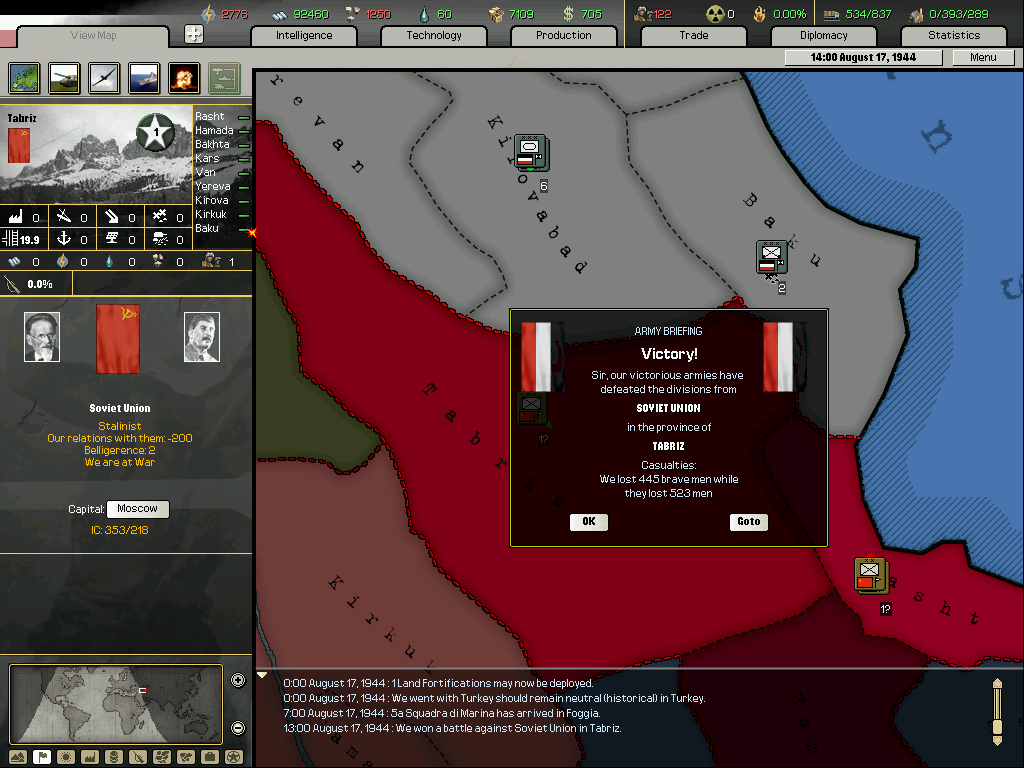
Soviet attempts to re-capture Baku fail as German efforts to defend the areas are substantial, and long term. Three major land fortifications were immediately placed in Baku. German engineers have already been sent to improve the infrastructure of the oil-rich territory.

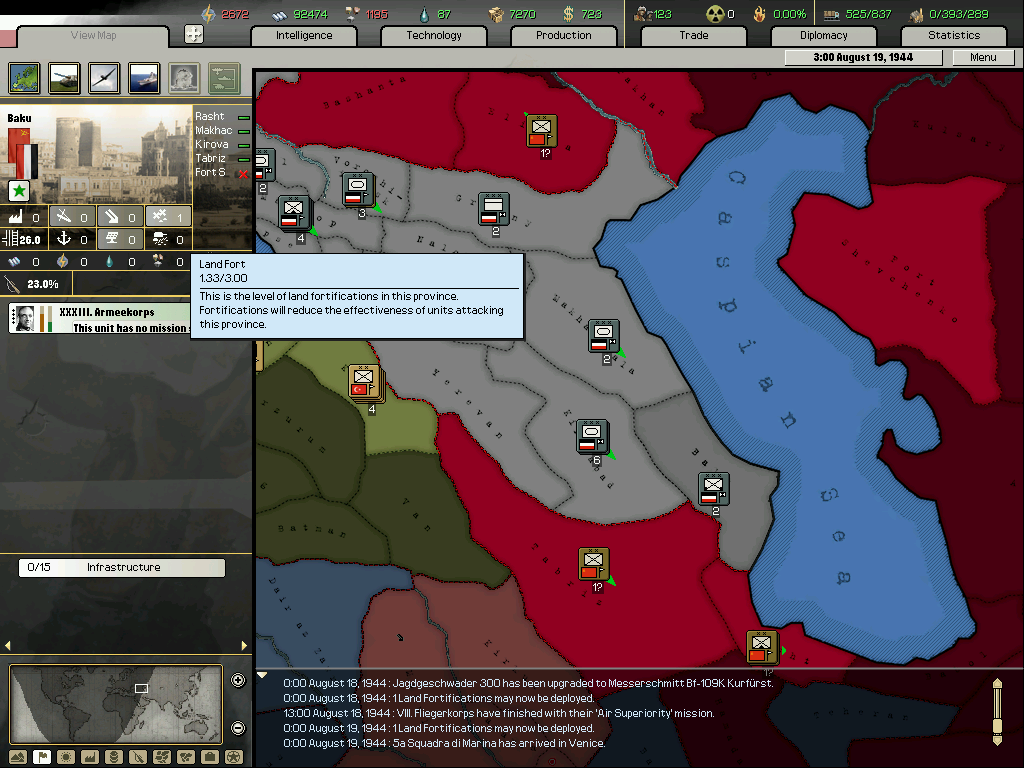

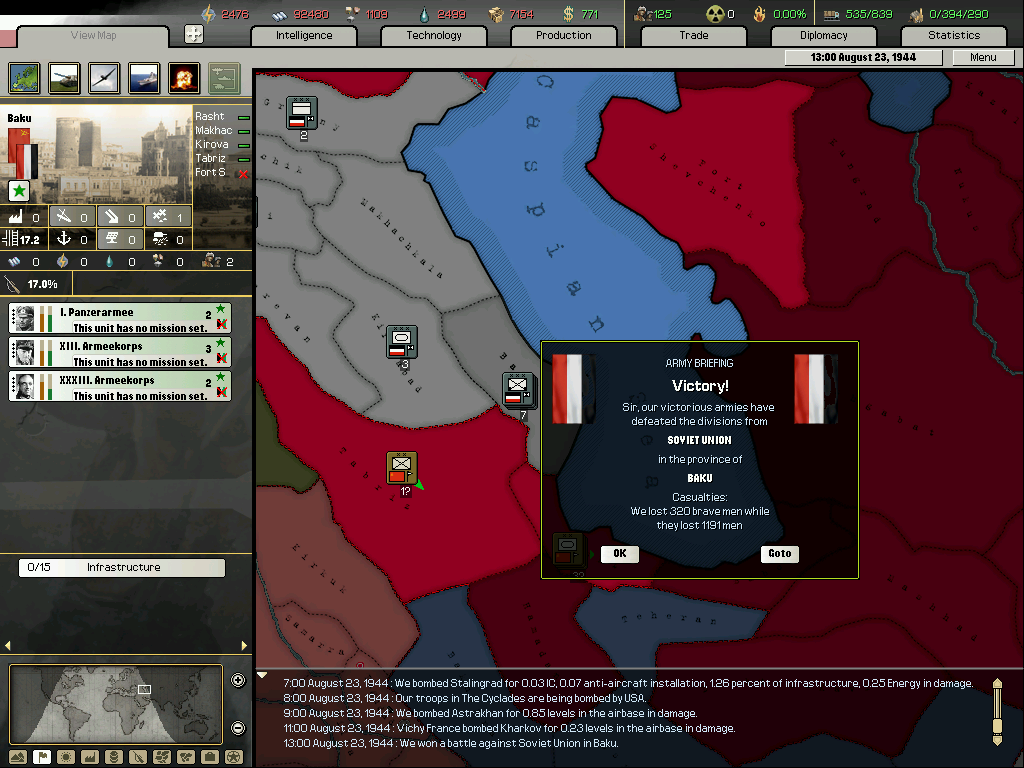
Now the German leadership turns its focus northwards, with the area around Stalingrad looking welcomingly undefended.
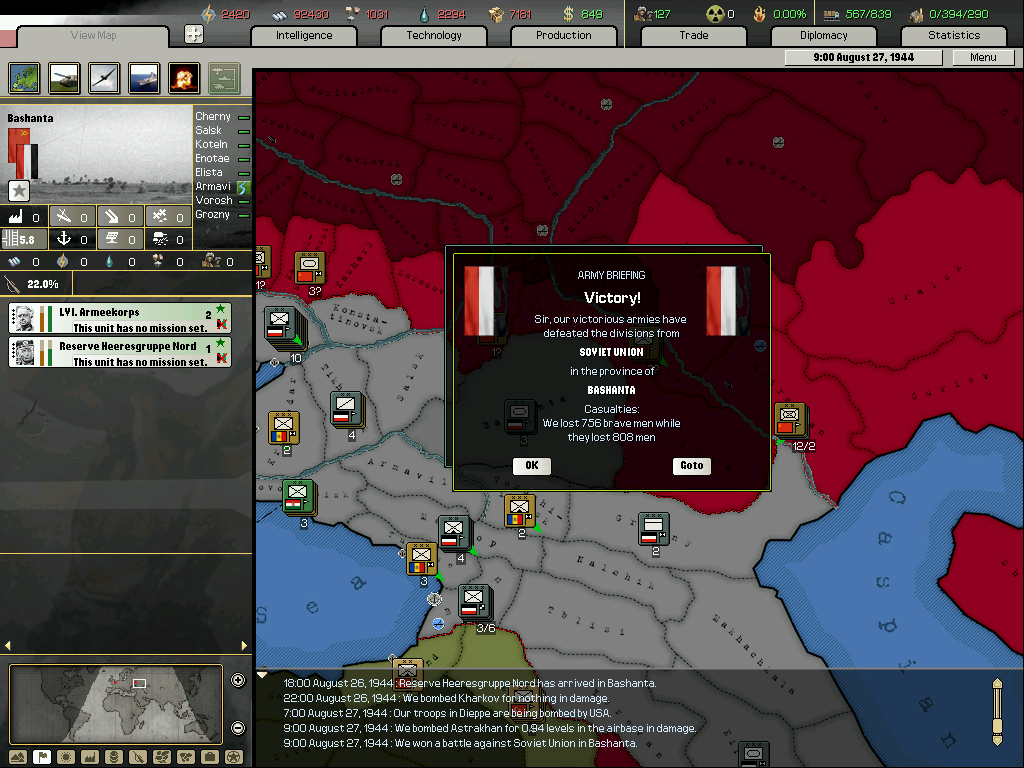
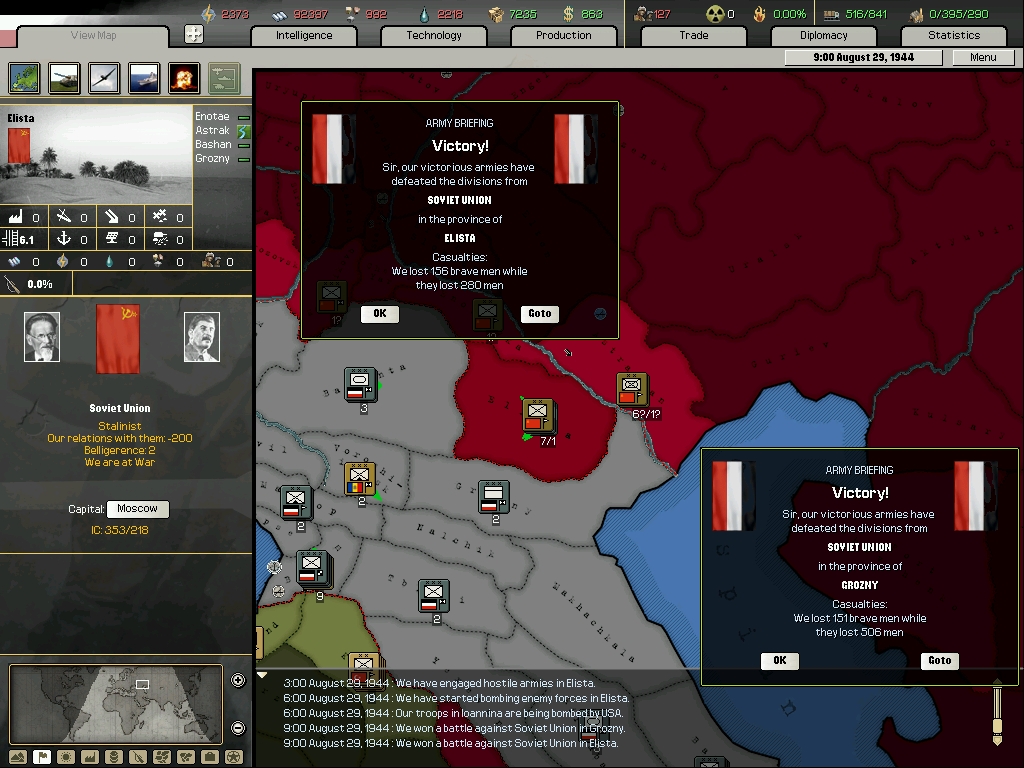
German intelligence suggests the Red Army has lost over 100 divisions since February 1943, as the Abwehr had estimated the Red Army consisted of 356 infantry divisions and 17 armoured divisions at that time. Or perhaps the appointment of Carl von Schubert as Head of Intelligence, which happened several months ago, meant this estimate was made more accurate as Schubert specialises in military intelligence.
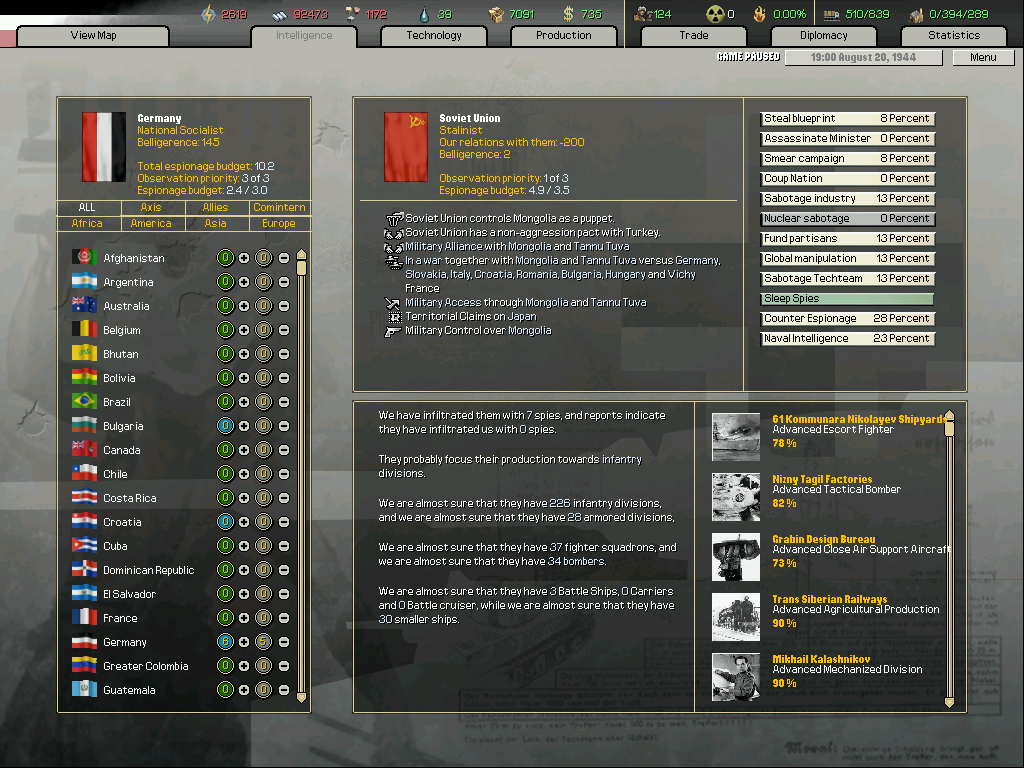
The siege of Sevastopol has been working. It is only a matter of time until the coastal fortress will fall.

The Red Air Force is now ever closer to its imminent demise.
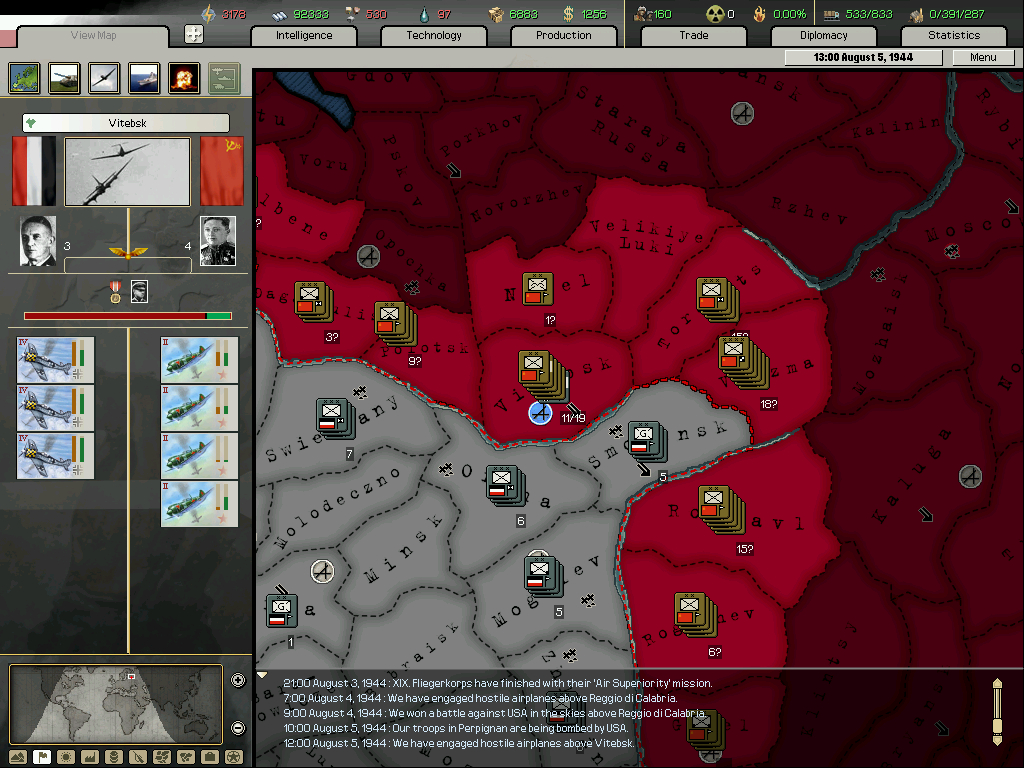
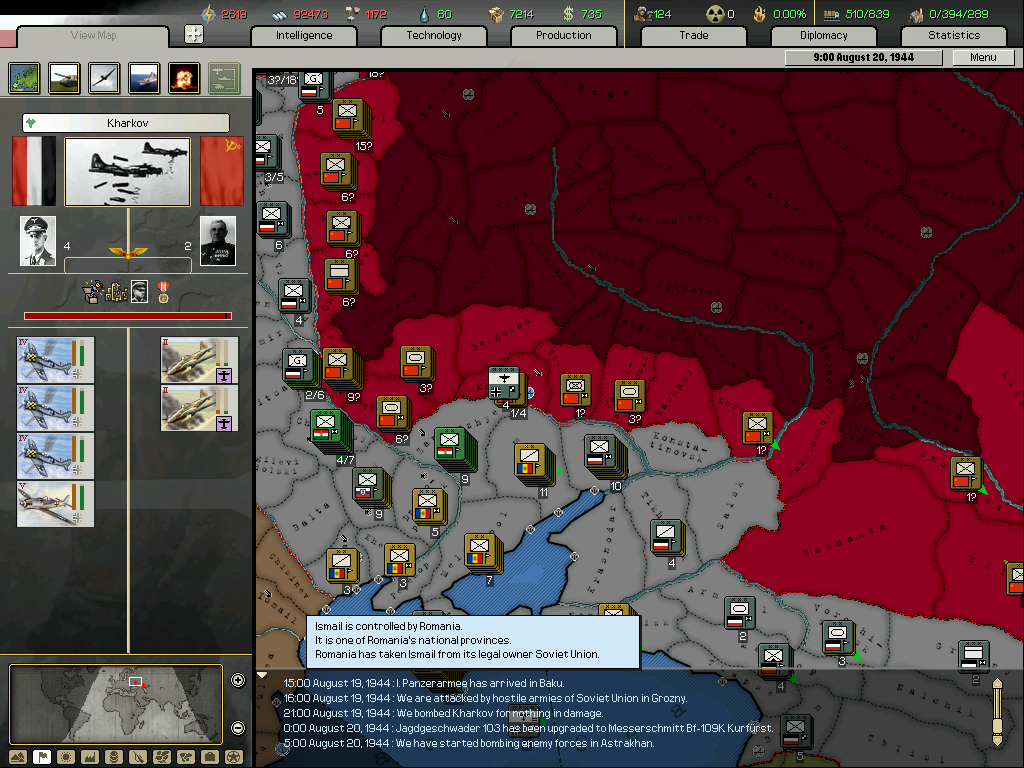

Air war against the Allies
Repeated attempts by the USAAF to gain an inch of air superiority over Germany failed.
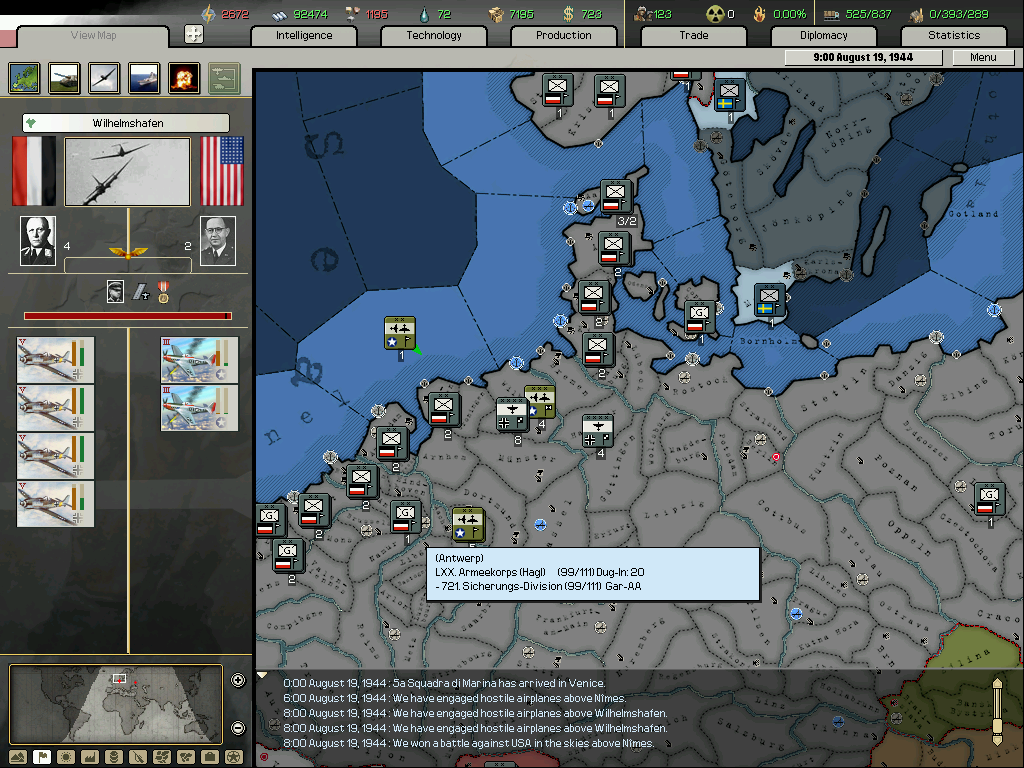
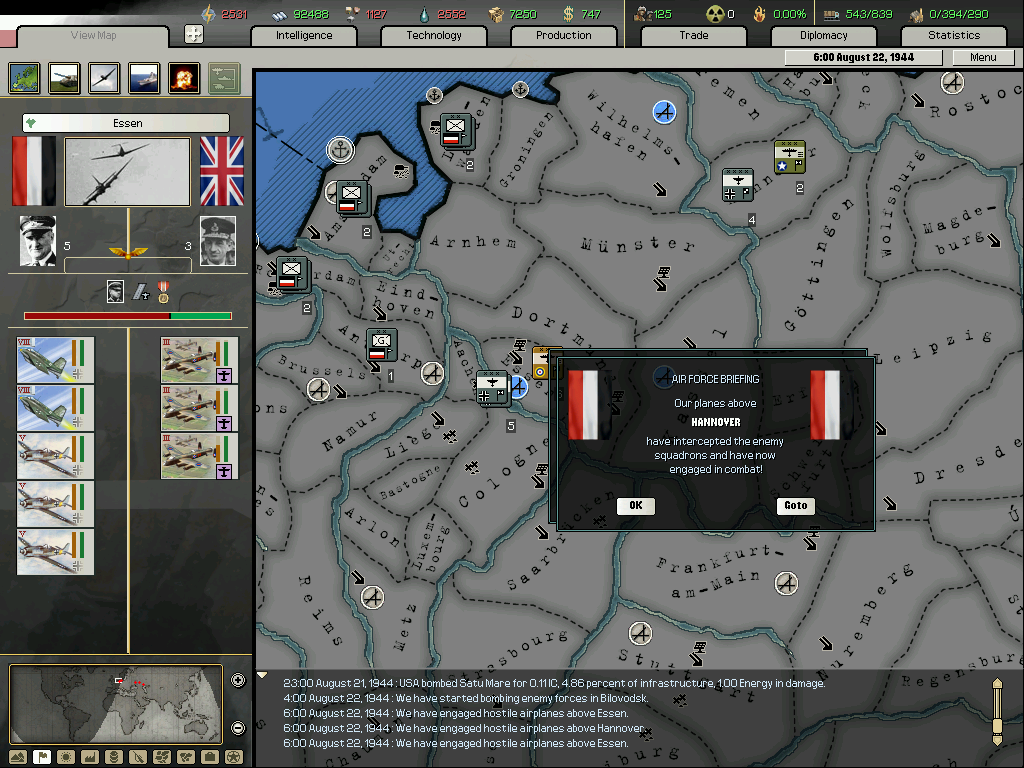
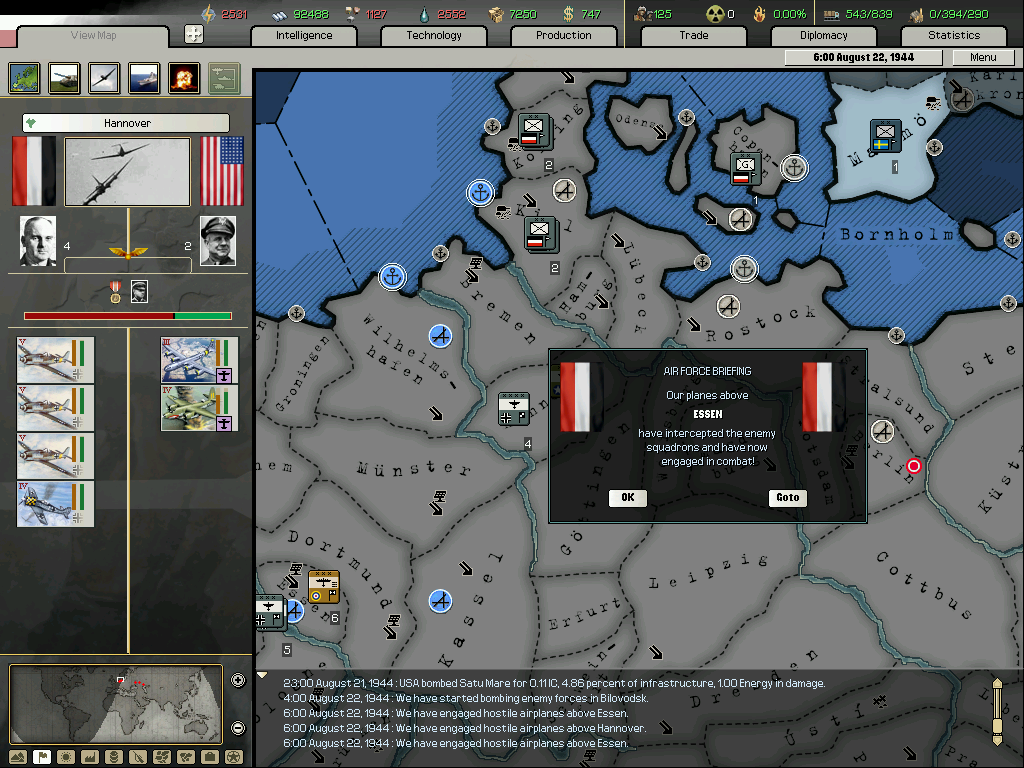
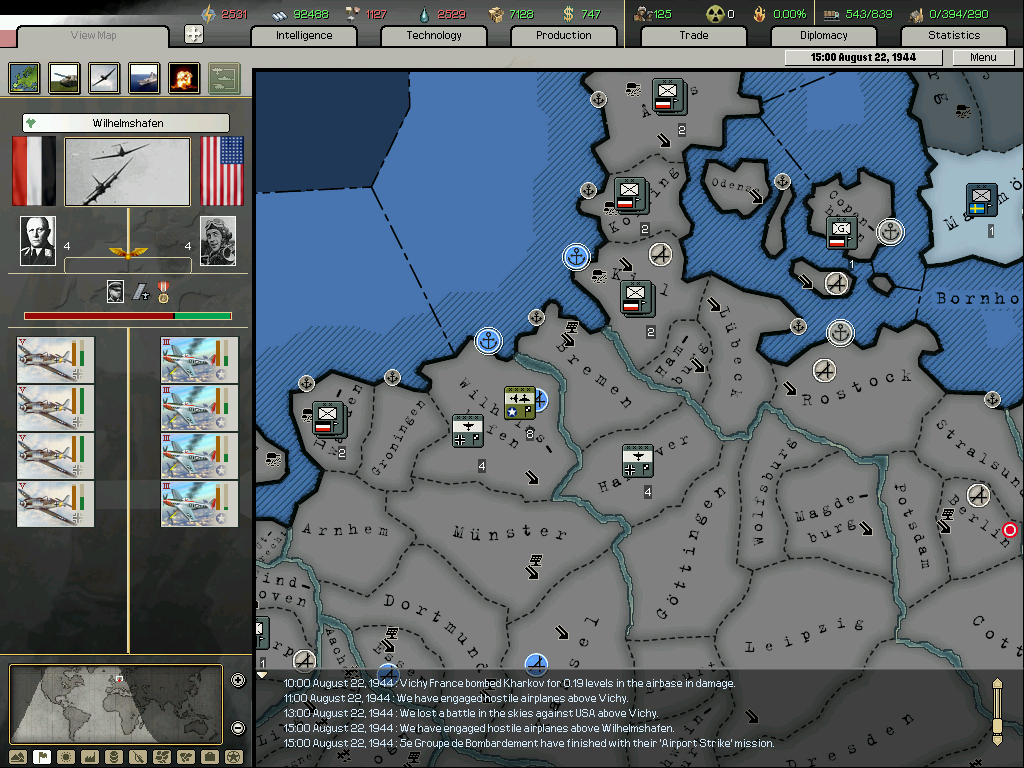
Both the Italian and German Air Forces successfully defended Italian air space.

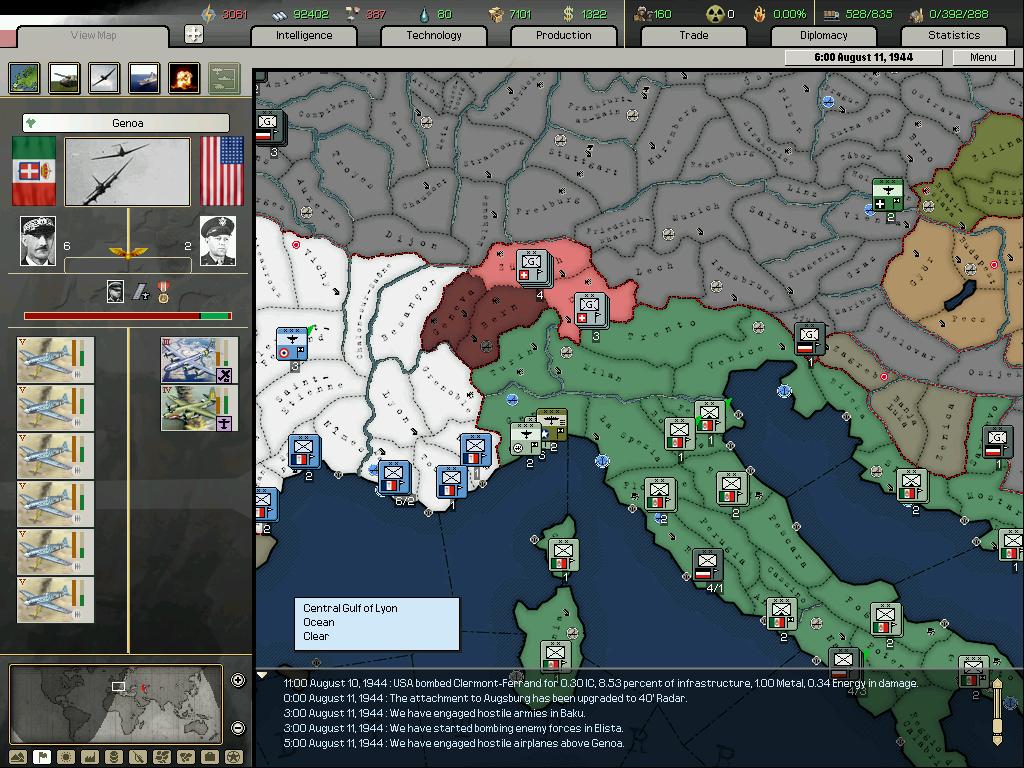
The Vichy interceptor units experienced victories when up against the American Air Force in the south, but embarrassingly could not successfully defend against US fighters flying over its capital.

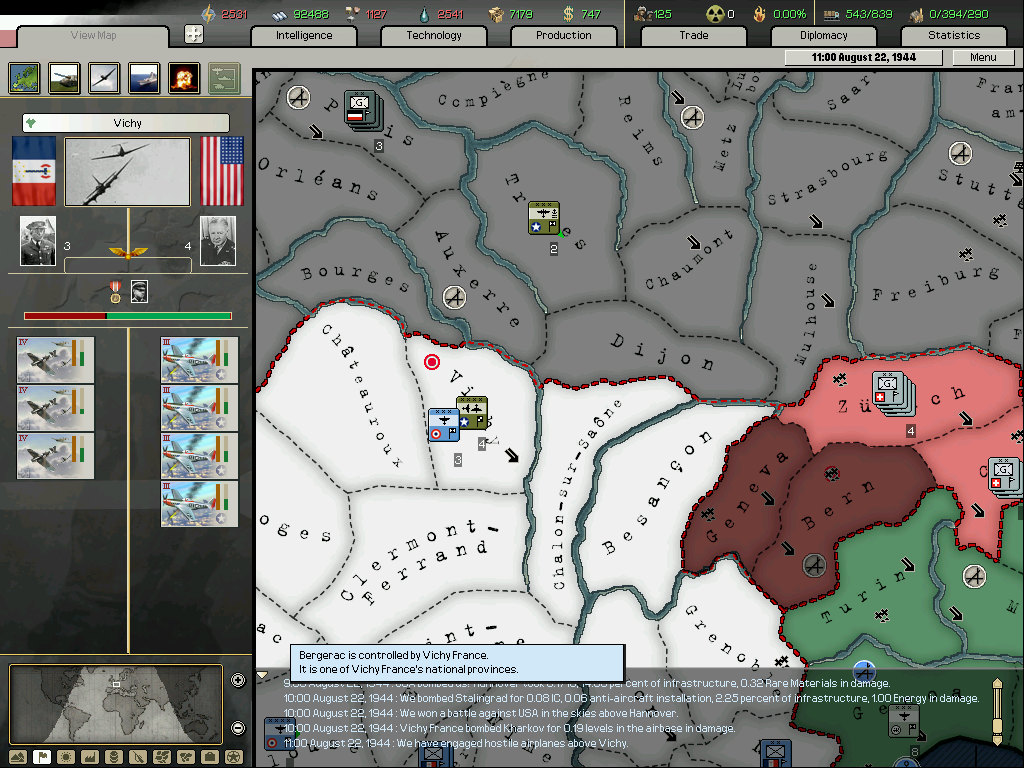
The Romanian and Hungarian Air Forces had continued success defending their own lands from the American menace.
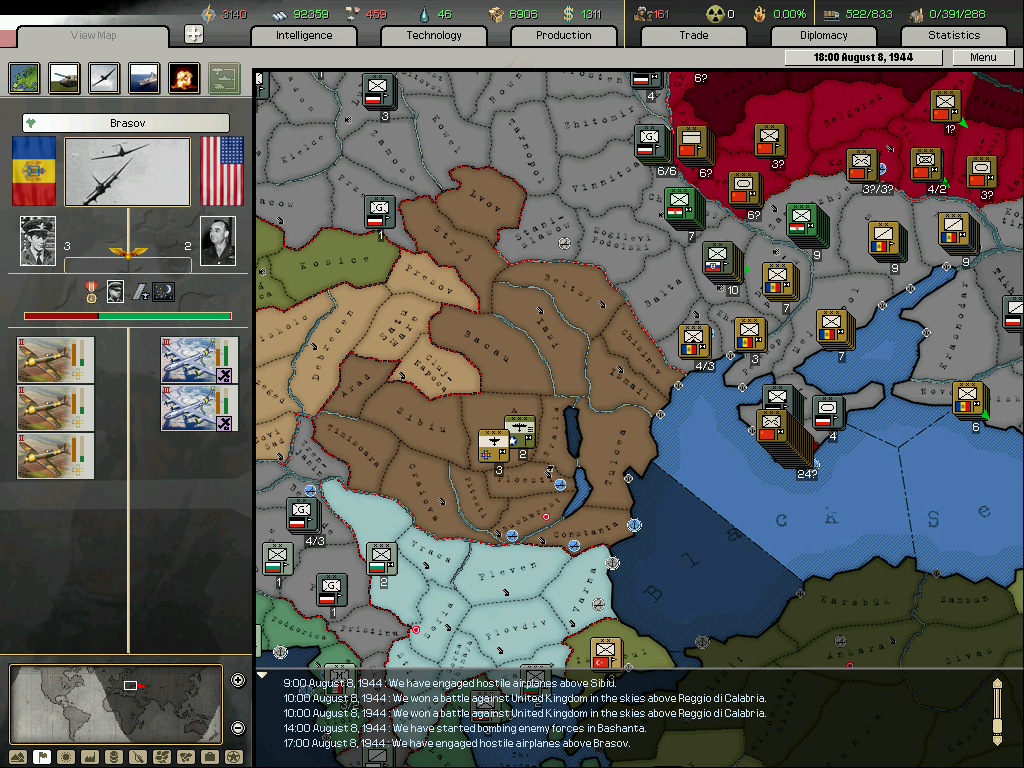

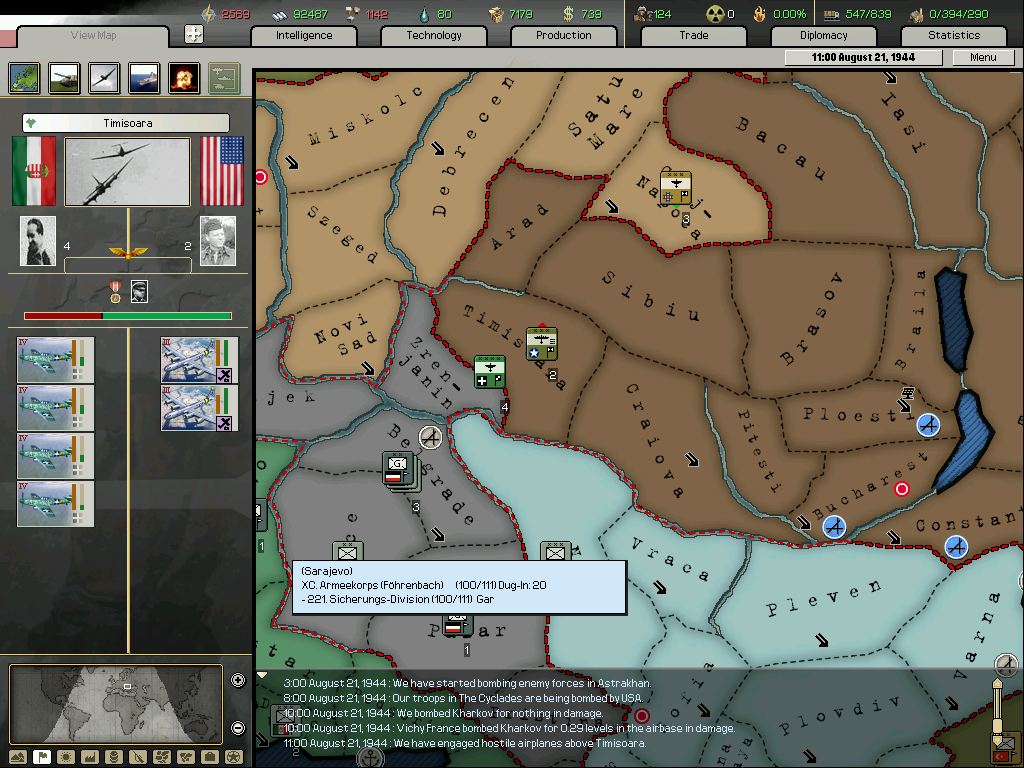
Other events
The German leadership was surprised to find out that Italy had rare materials reserves totalling at least 10,000. It therefore started to buy in bulks of 1,000 rares for $700 from the Italian government in order to alleviate its chronic lack of resources.
Losses Charts


Eastern front
The advance southwards continues with great success, with Baku being captured on the 15th by troops led by Falkenhorst. With German forces being worryingly close to capturing territory bordering American-Persia, the orders went out that German units should not attack, or at least capture, anymore territory beyond the Caucasus. The capture of Baku came at immediate great reward as 2,500 barrels of oil were found in the city.






The capture of Tabriz was called off in order to avoid bordering American-occupied Persia.

Soviet attempts to re-capture Baku fail as German efforts to defend the areas are substantial, and long term. Three major land fortifications were immediately placed in Baku. German engineers have already been sent to improve the infrastructure of the oil-rich territory.




Now the German leadership turns its focus northwards, with the area around Stalingrad looking welcomingly undefended.


German intelligence suggests the Red Army has lost over 100 divisions since February 1943, as the Abwehr had estimated the Red Army consisted of 356 infantry divisions and 17 armoured divisions at that time. Or perhaps the appointment of Carl von Schubert as Head of Intelligence, which happened several months ago, meant this estimate was made more accurate as Schubert specialises in military intelligence.

The siege of Sevastopol has been working. It is only a matter of time until the coastal fortress will fall.

The Red Air Force is now ever closer to its imminent demise.



Air war against the Allies
Repeated attempts by the USAAF to gain an inch of air superiority over Germany failed.




Both the Italian and German Air Forces successfully defended Italian air space.


The Vichy interceptor units experienced victories when up against the American Air Force in the south, but embarrassingly could not successfully defend against US fighters flying over its capital.


The Romanian and Hungarian Air Forces had continued success defending their own lands from the American menace.



Other events
The German leadership was surprised to find out that Italy had rare materials reserves totalling at least 10,000. It therefore started to buy in bulks of 1,000 rares for $700 from the Italian government in order to alleviate its chronic lack of resources.
Last edited:

